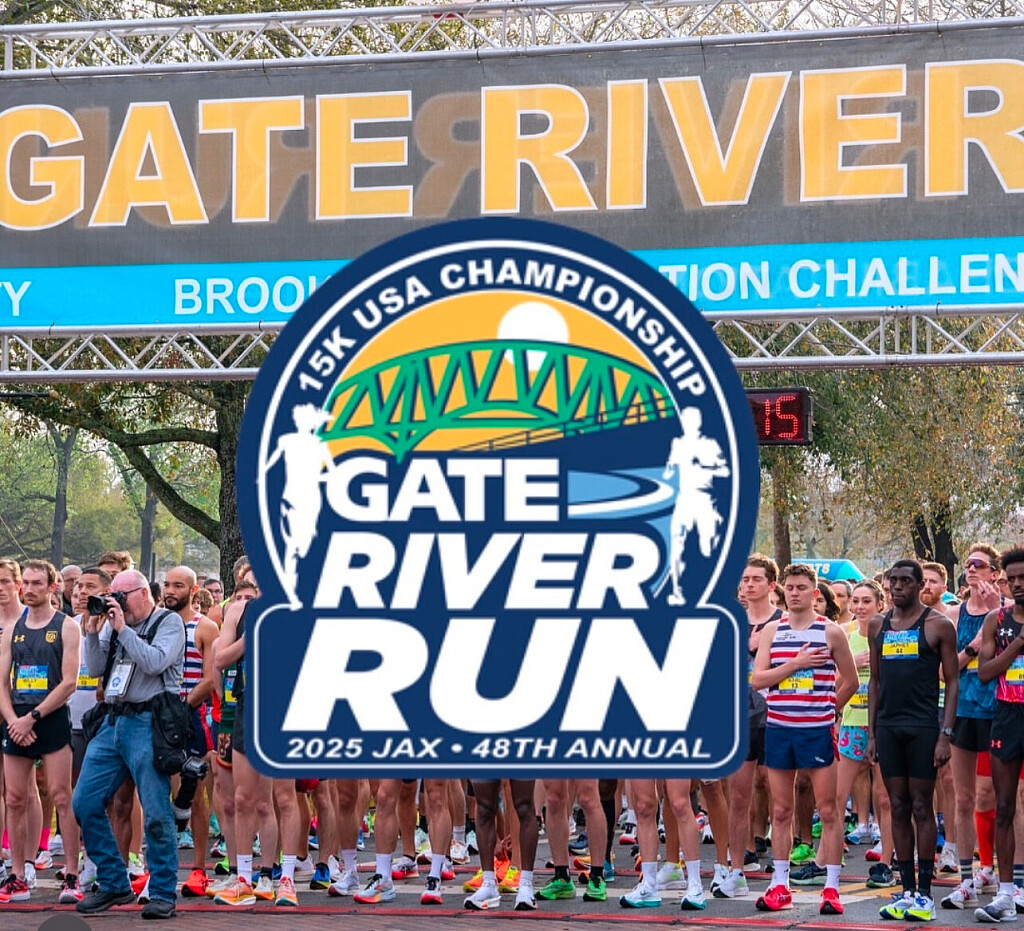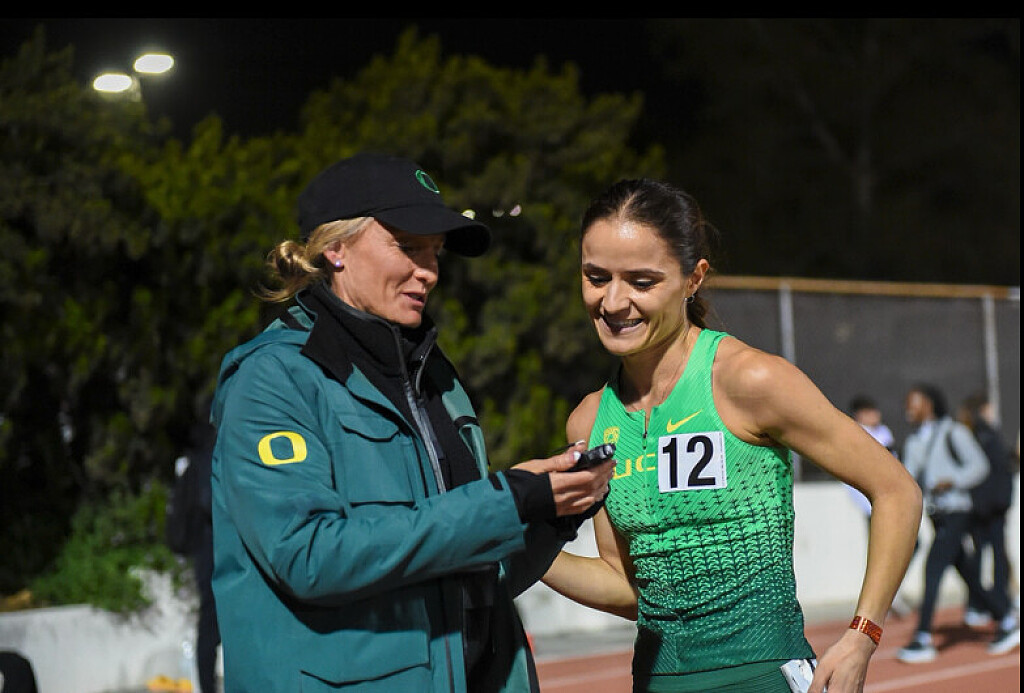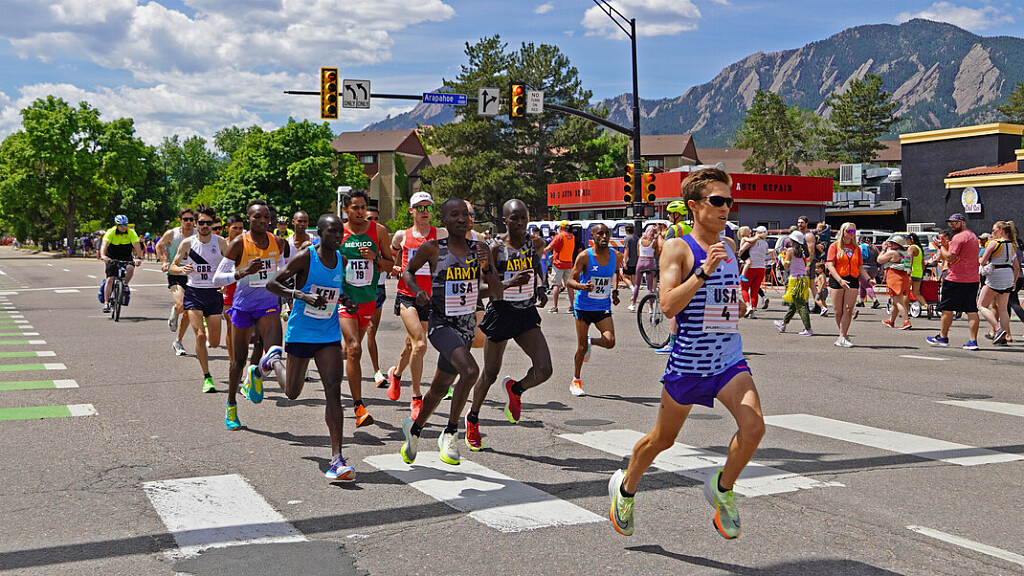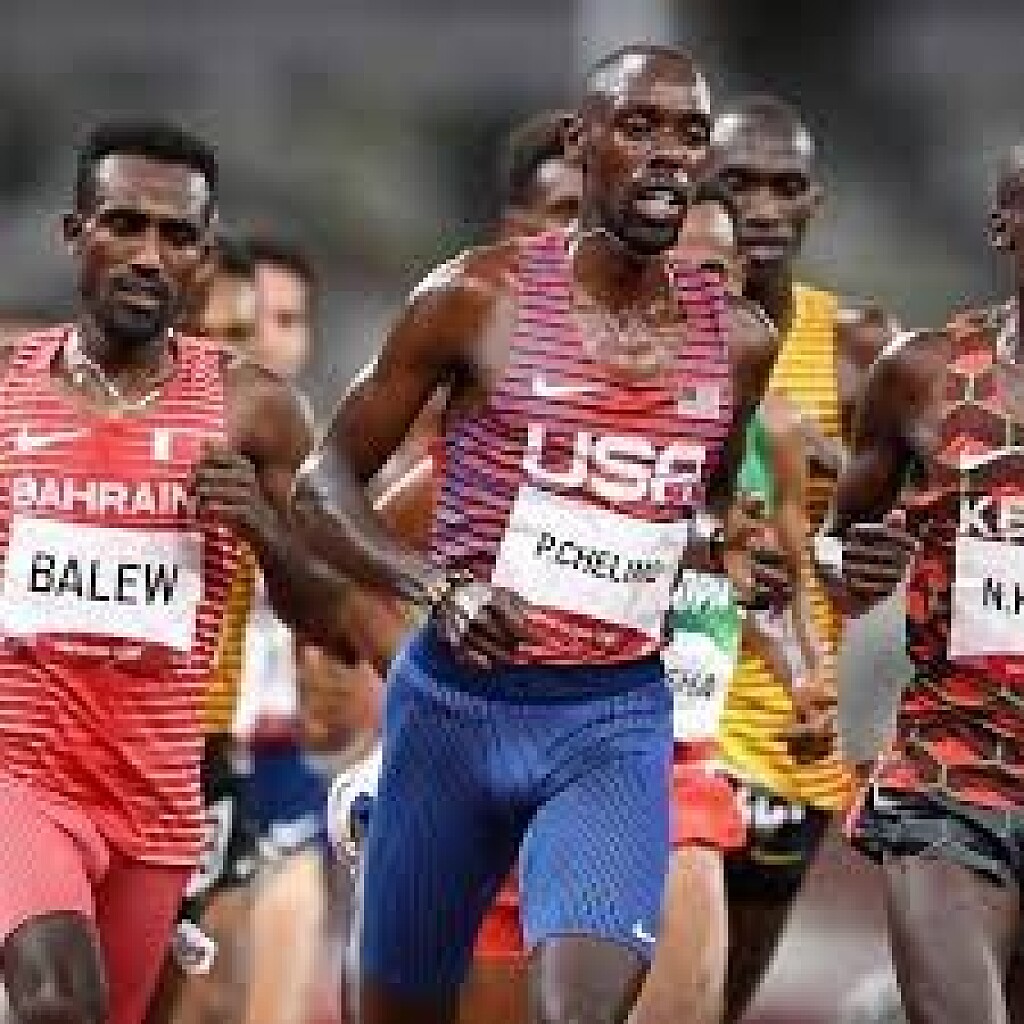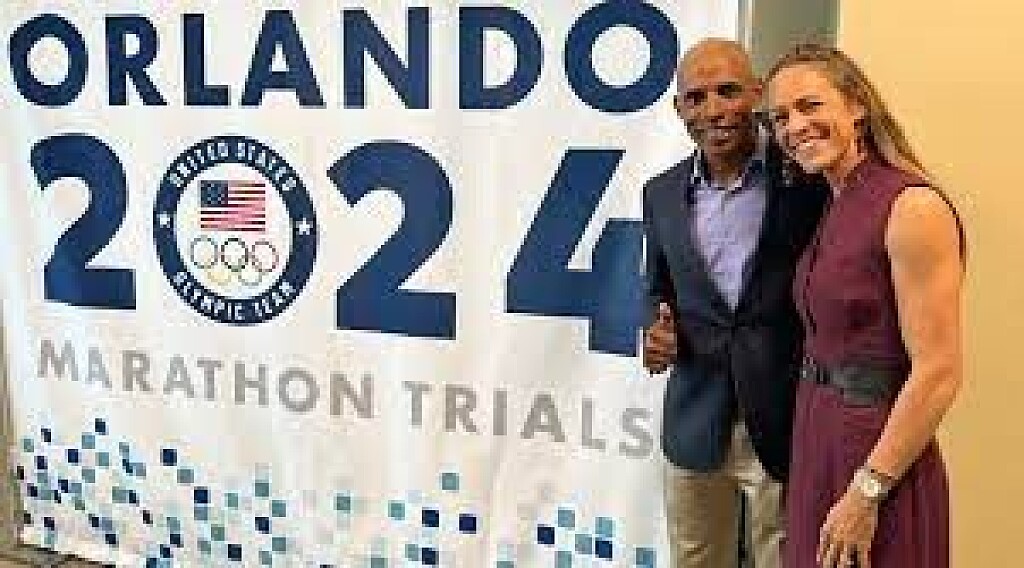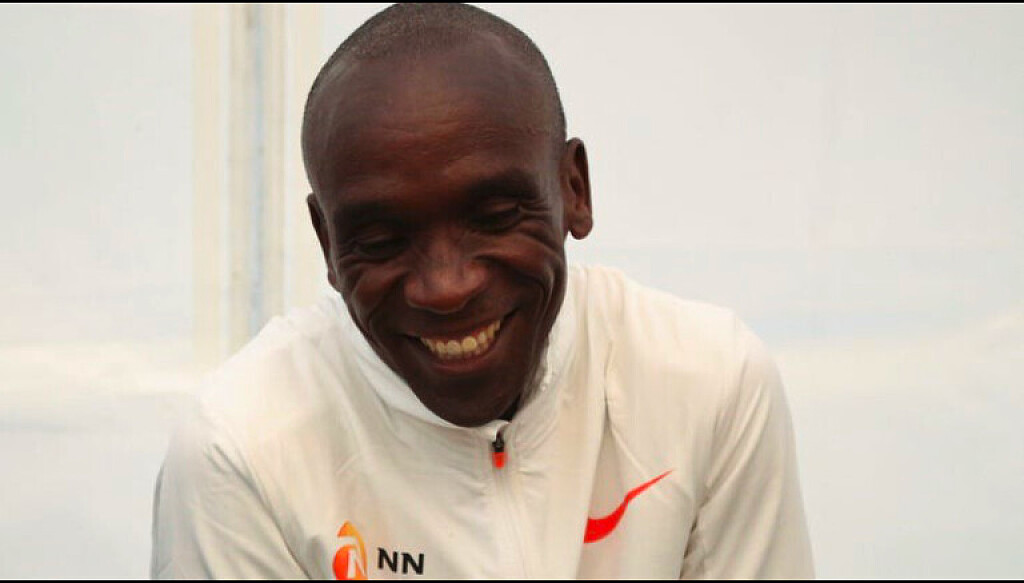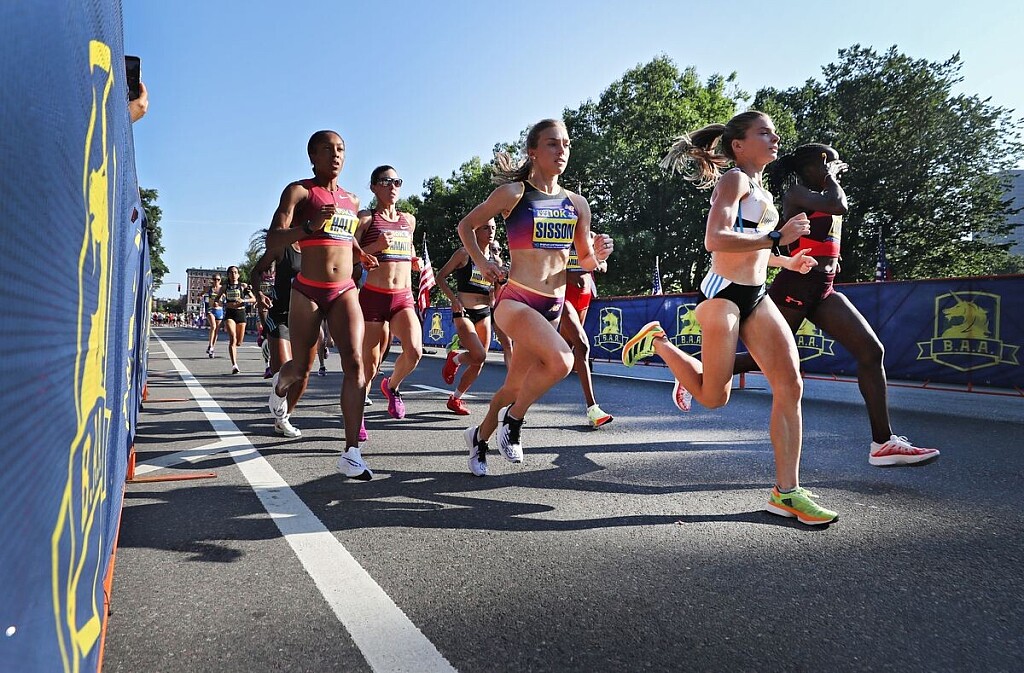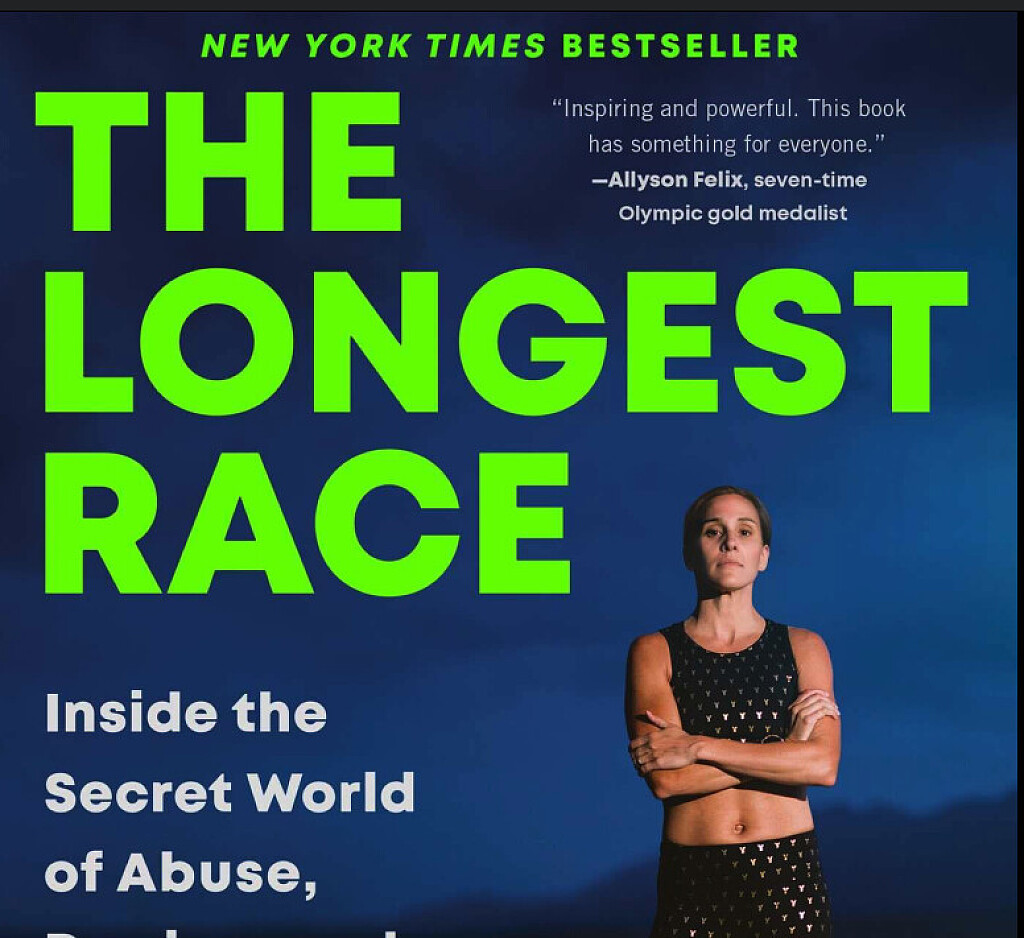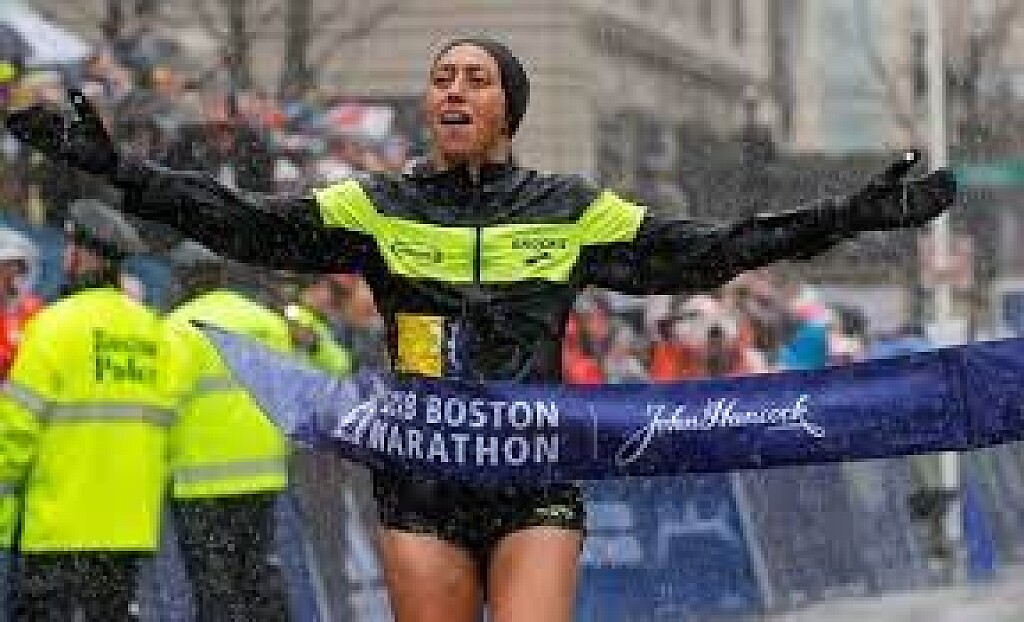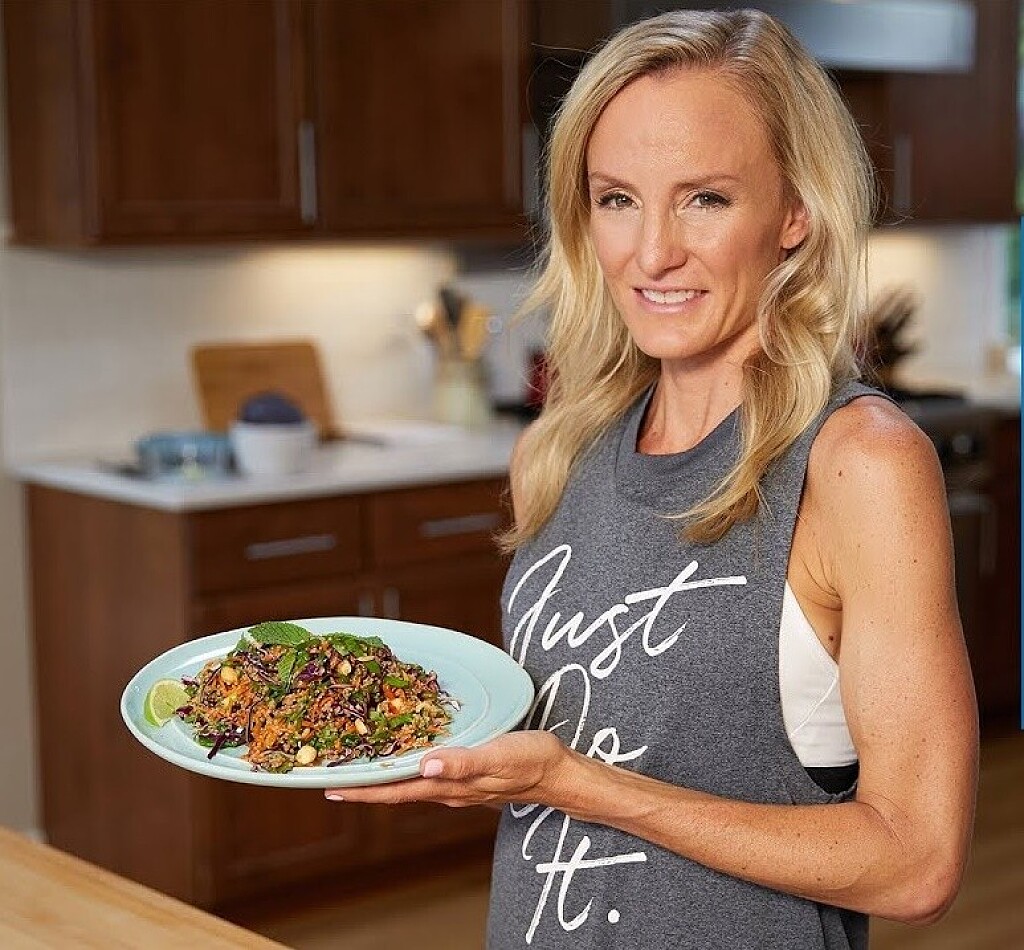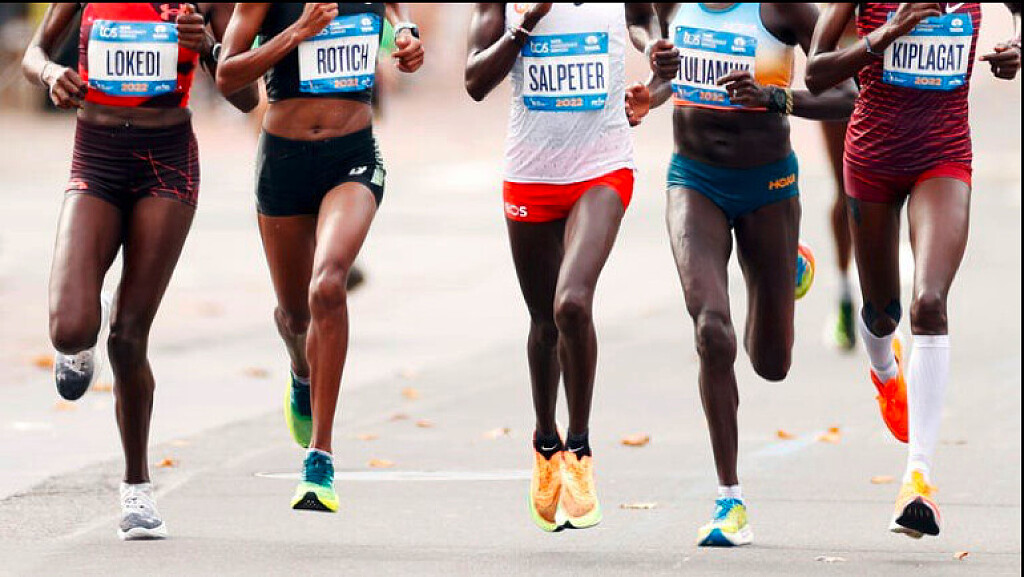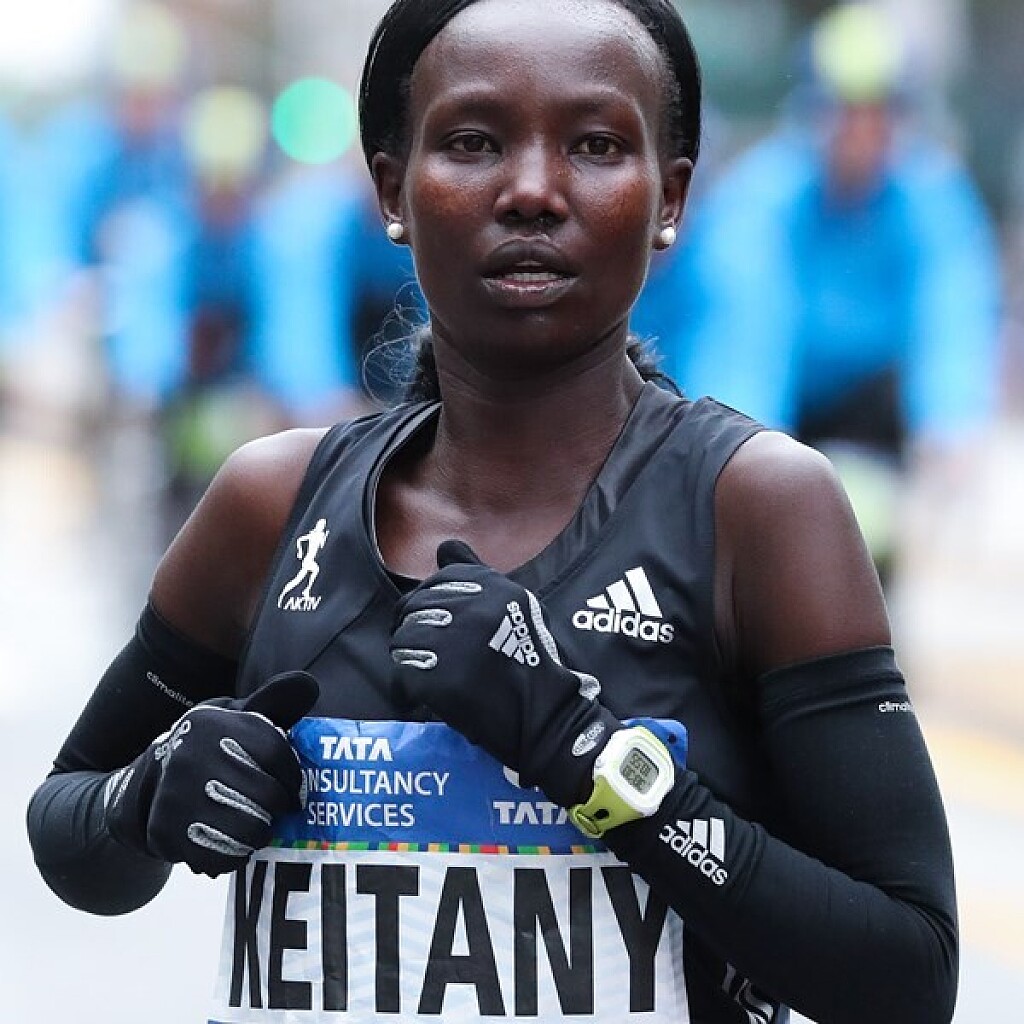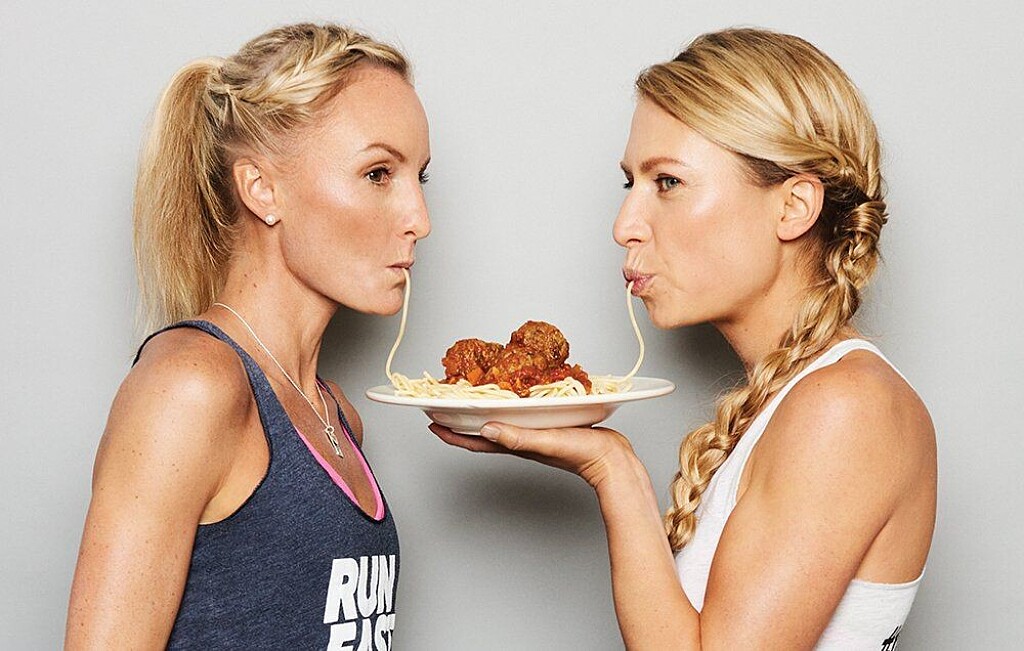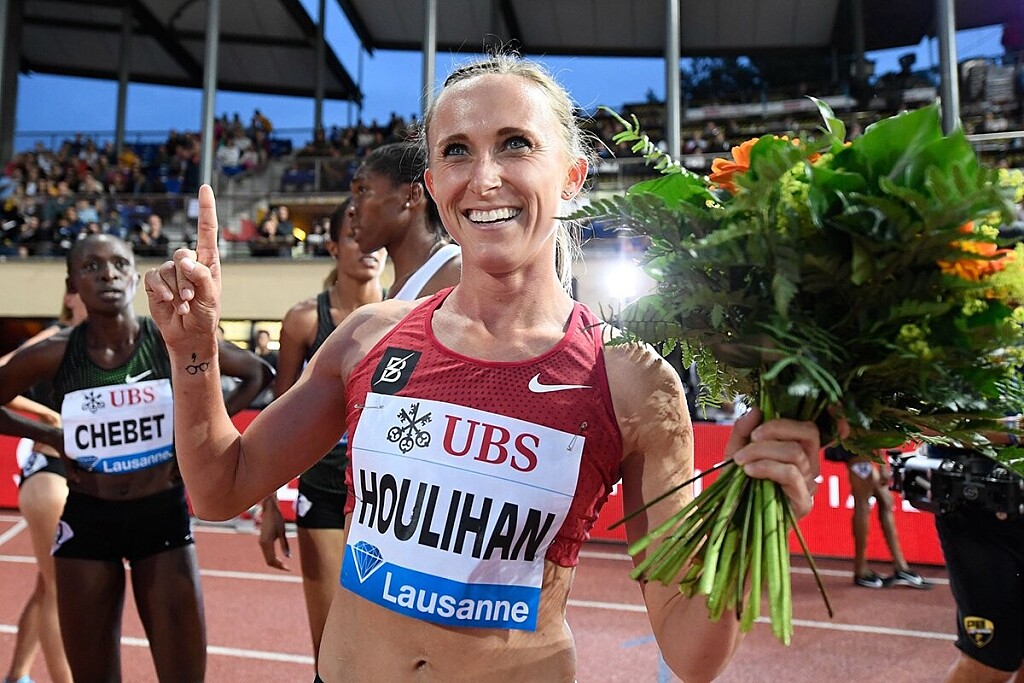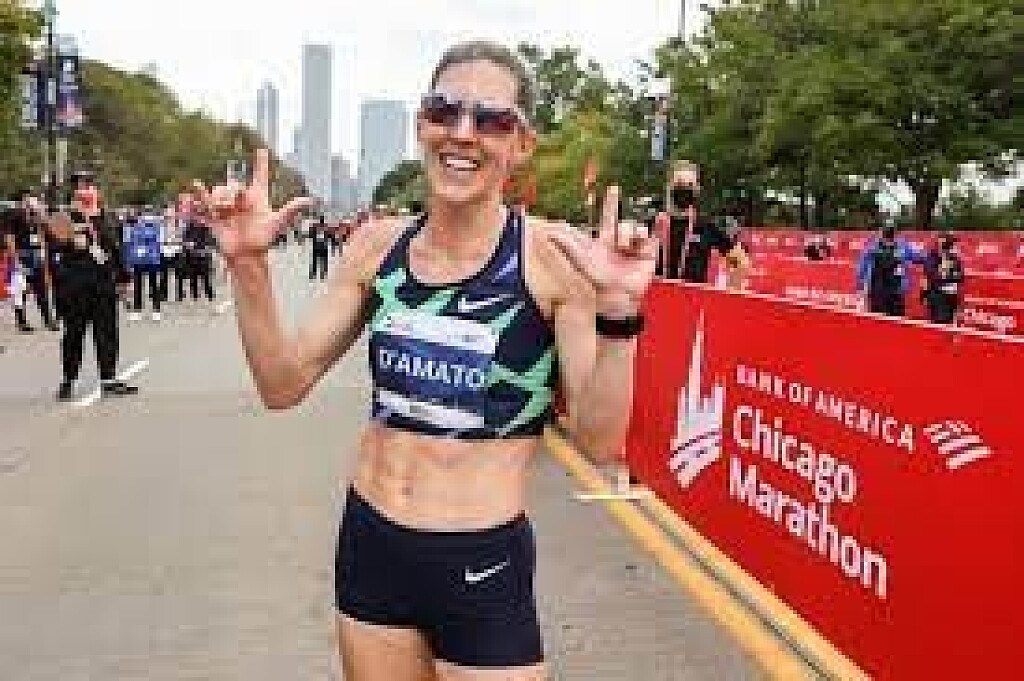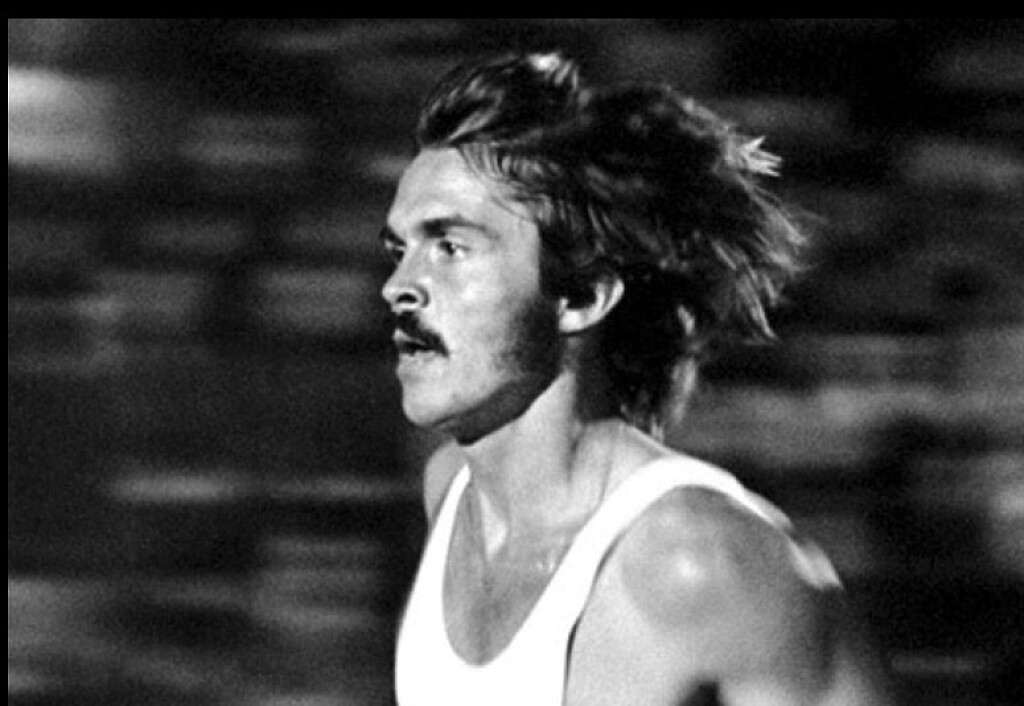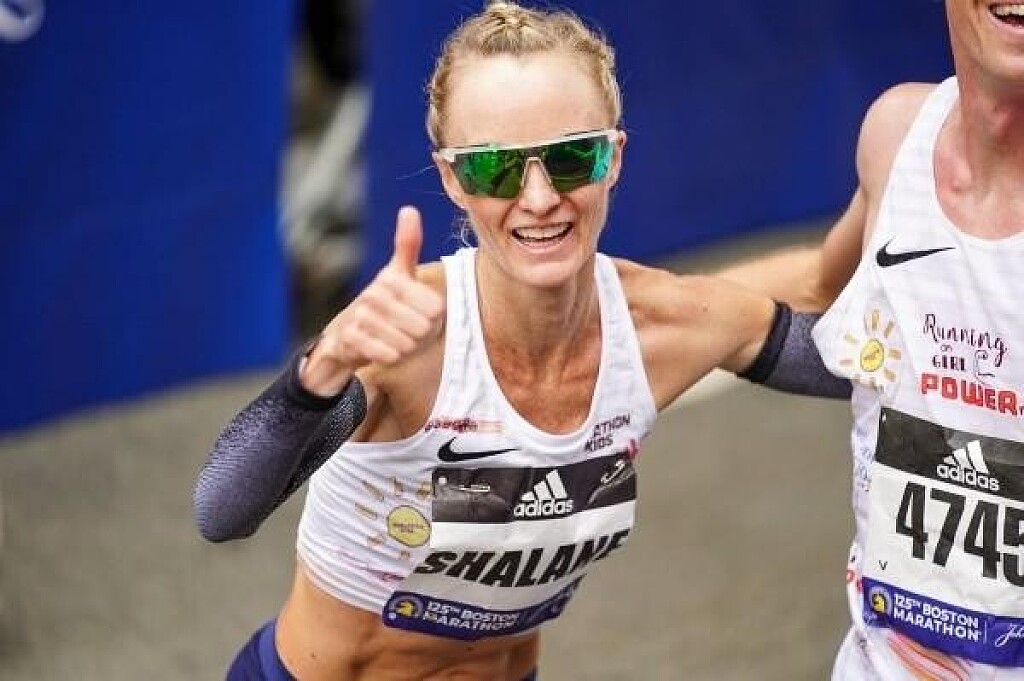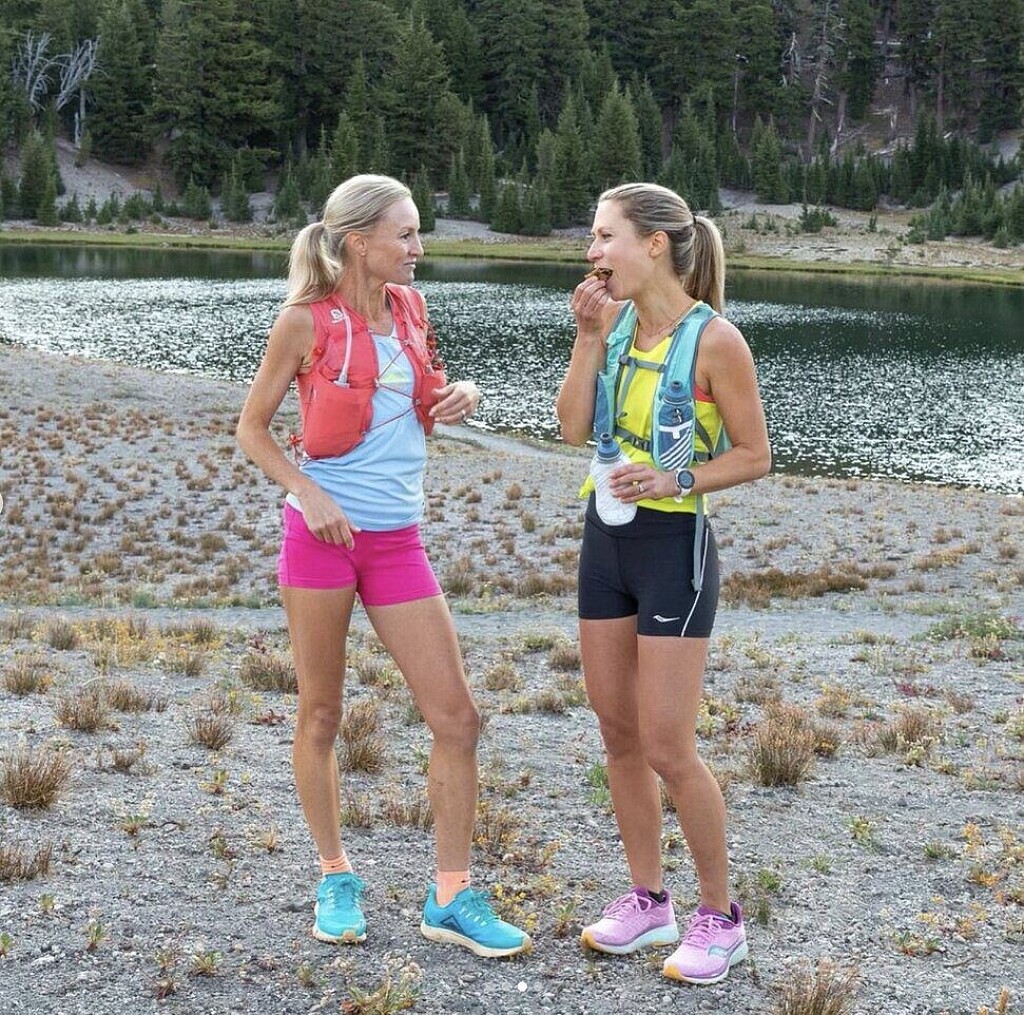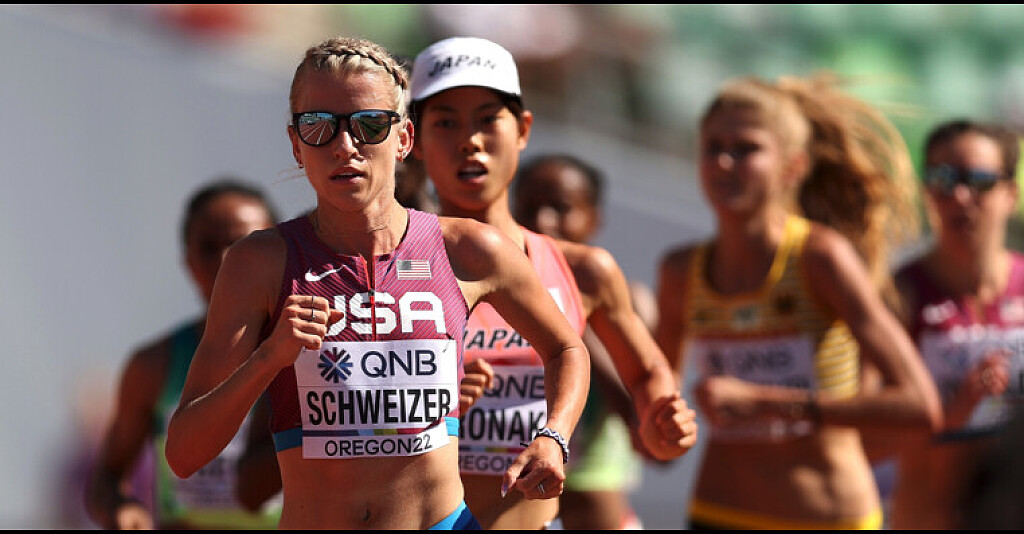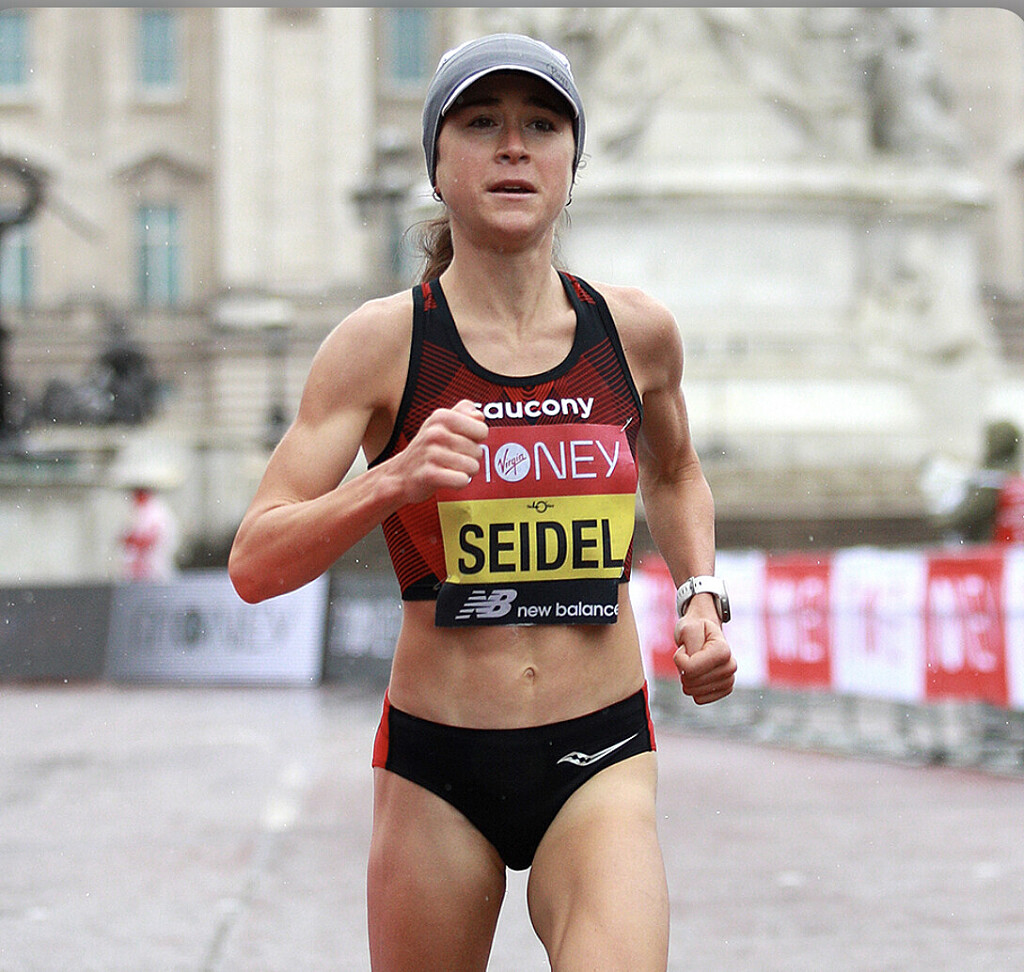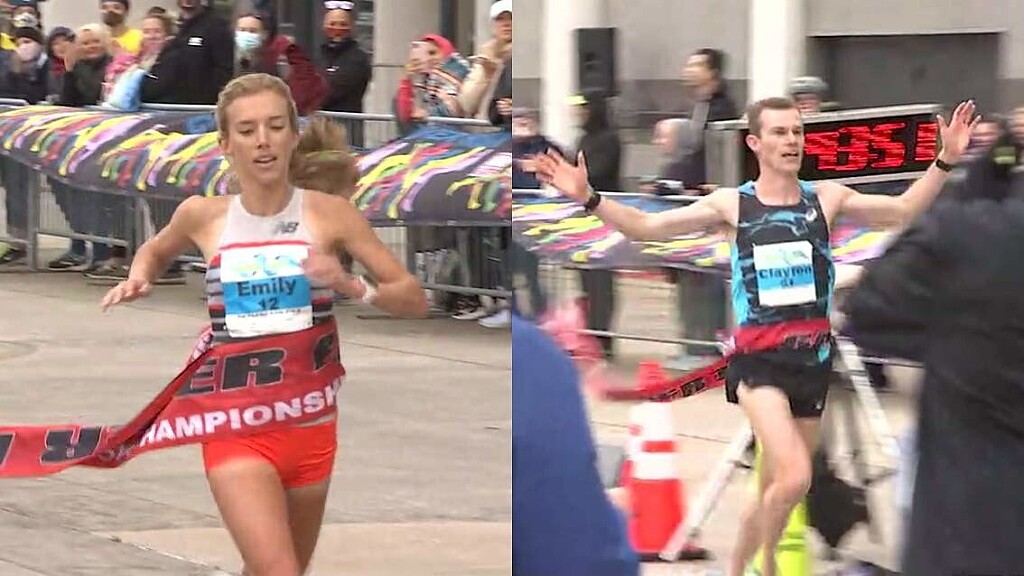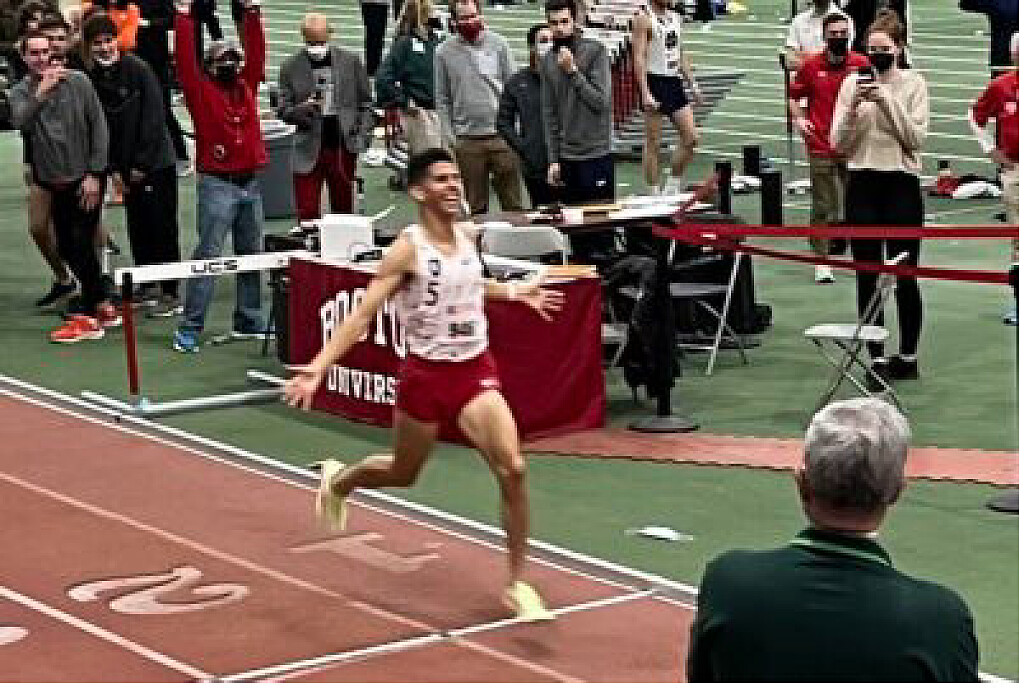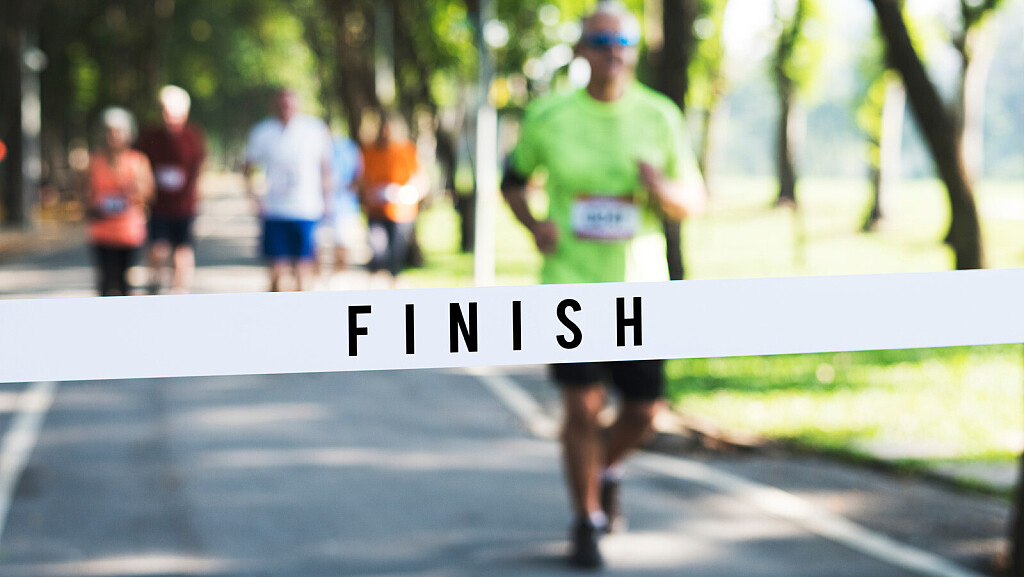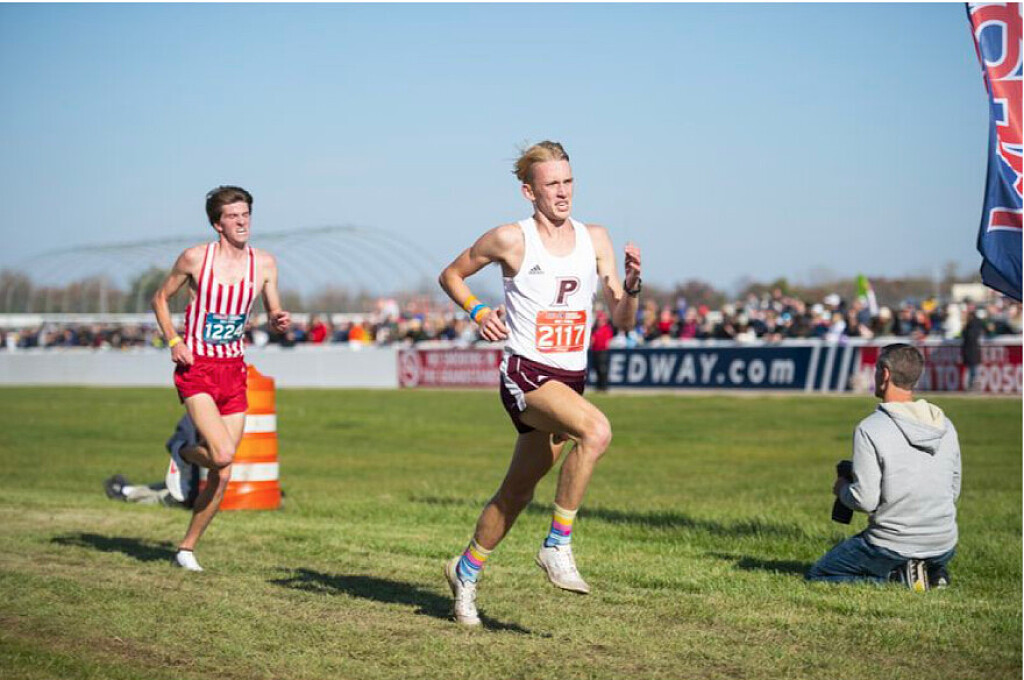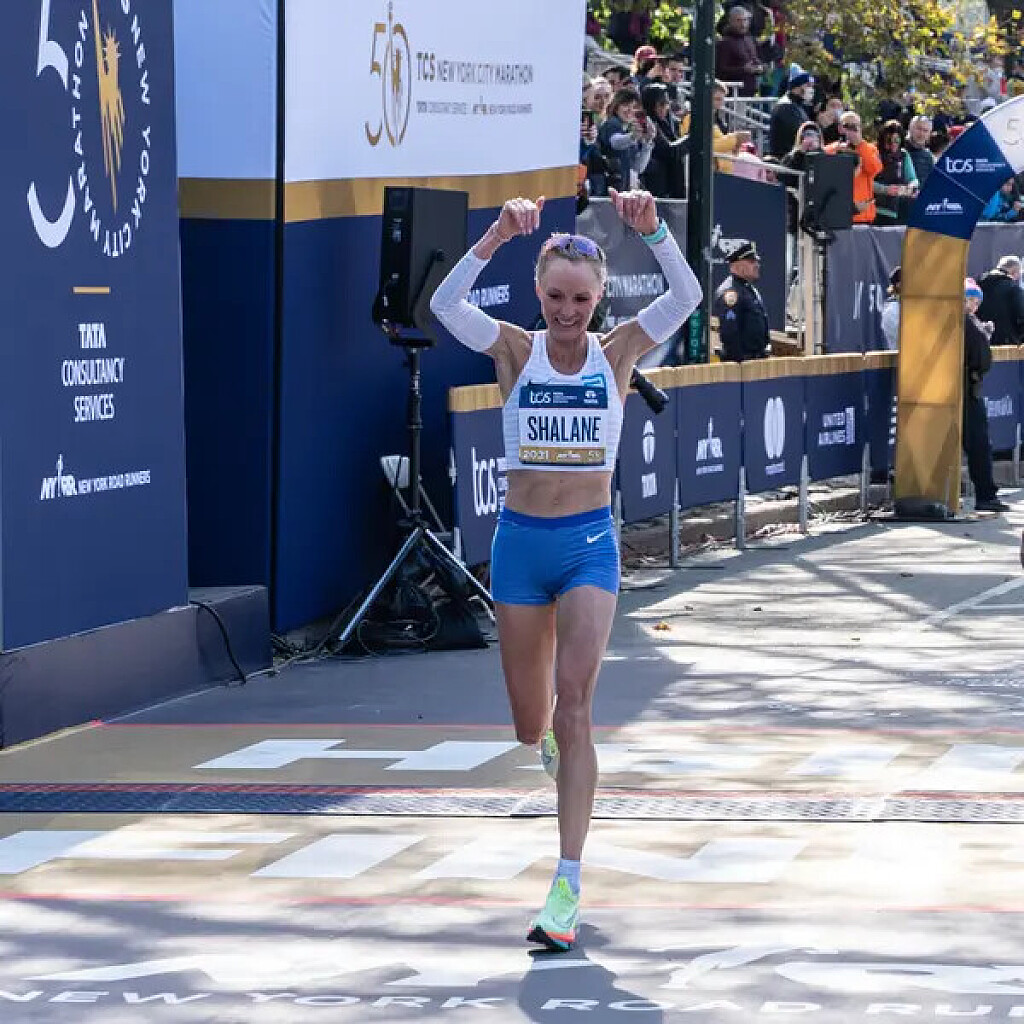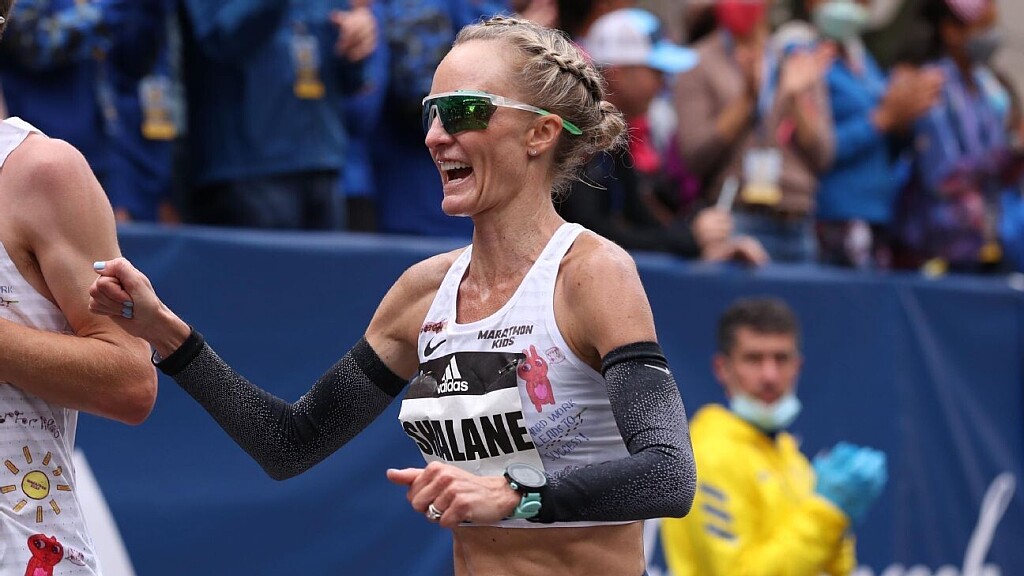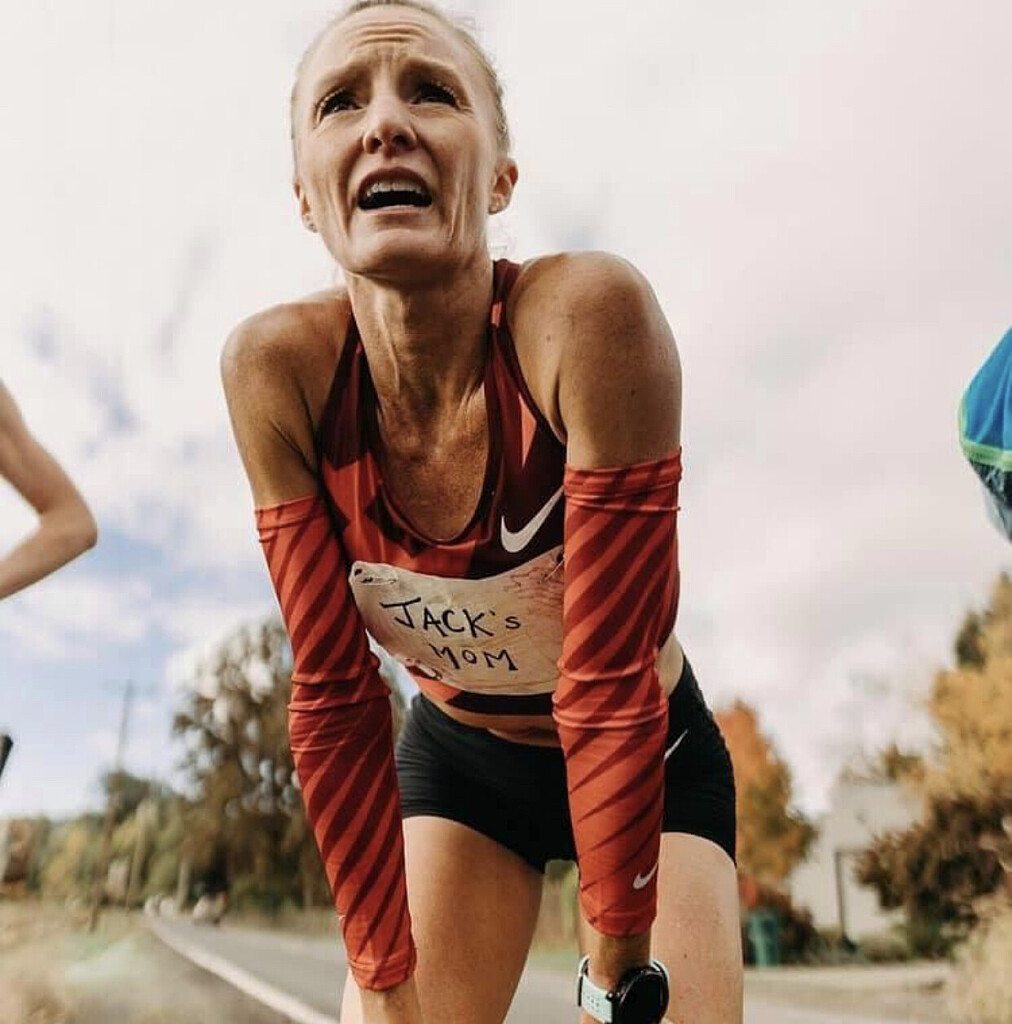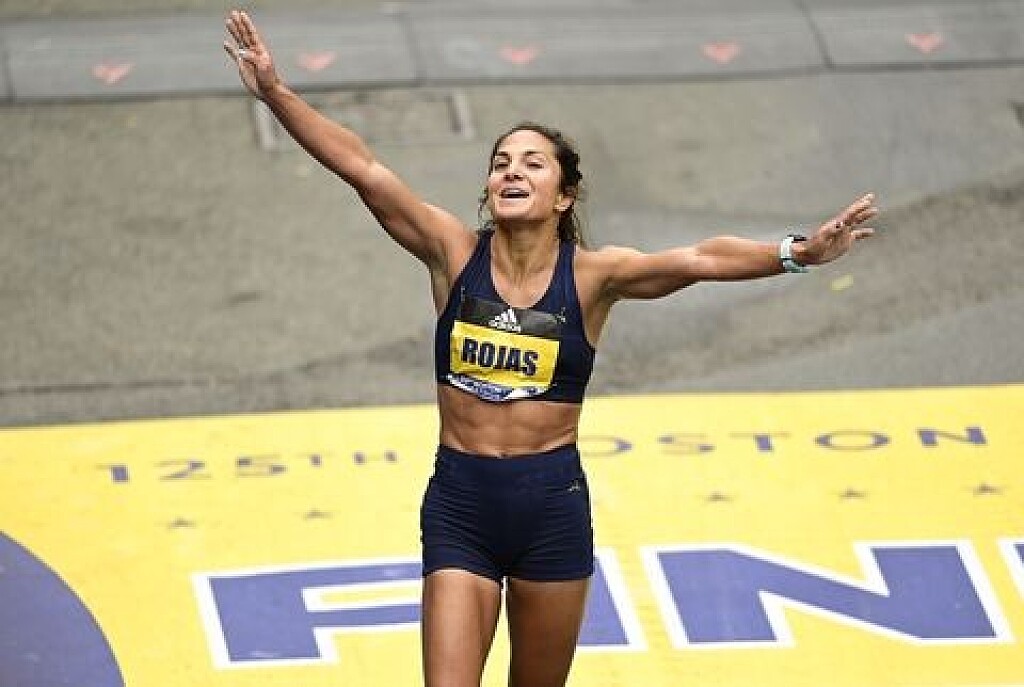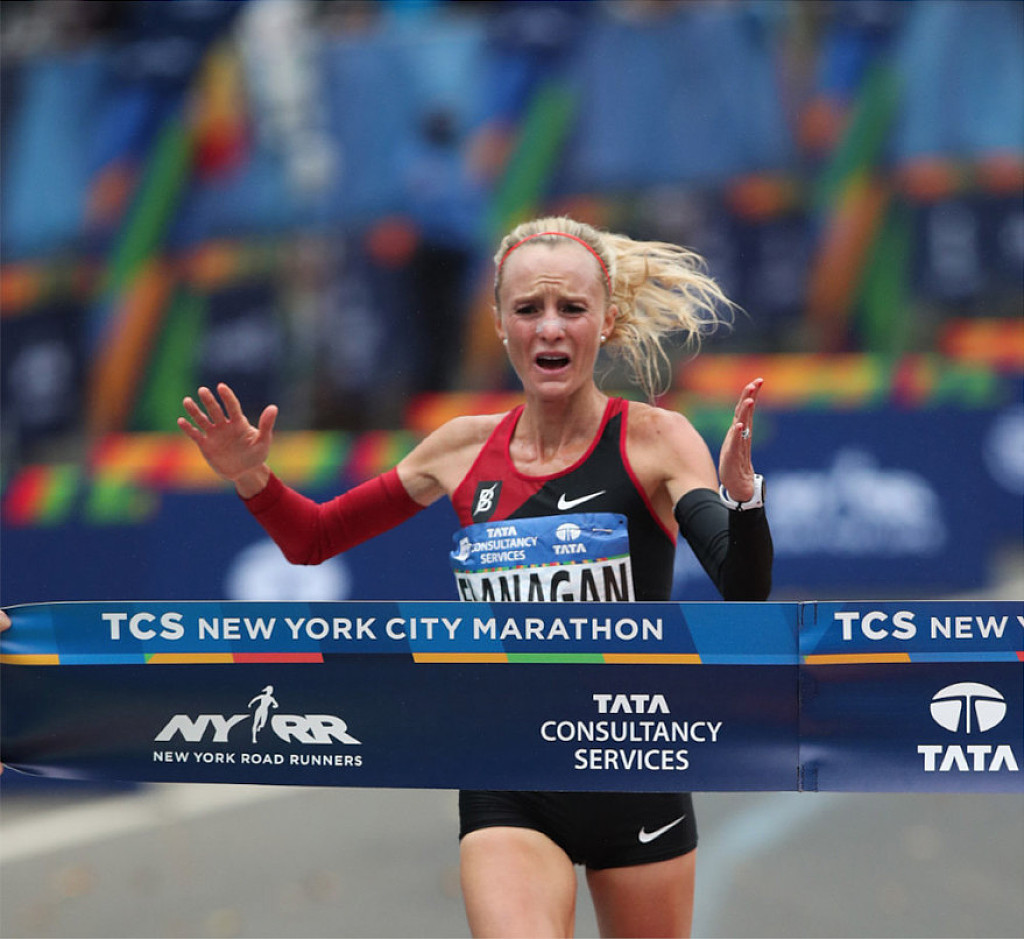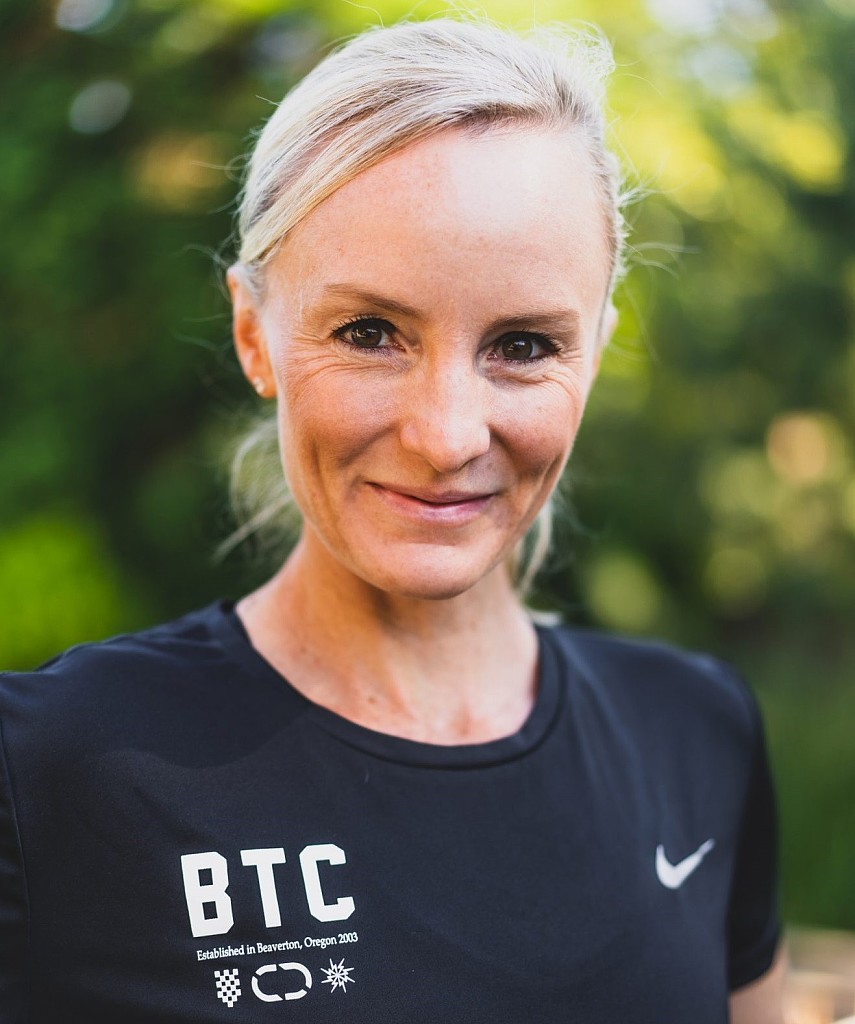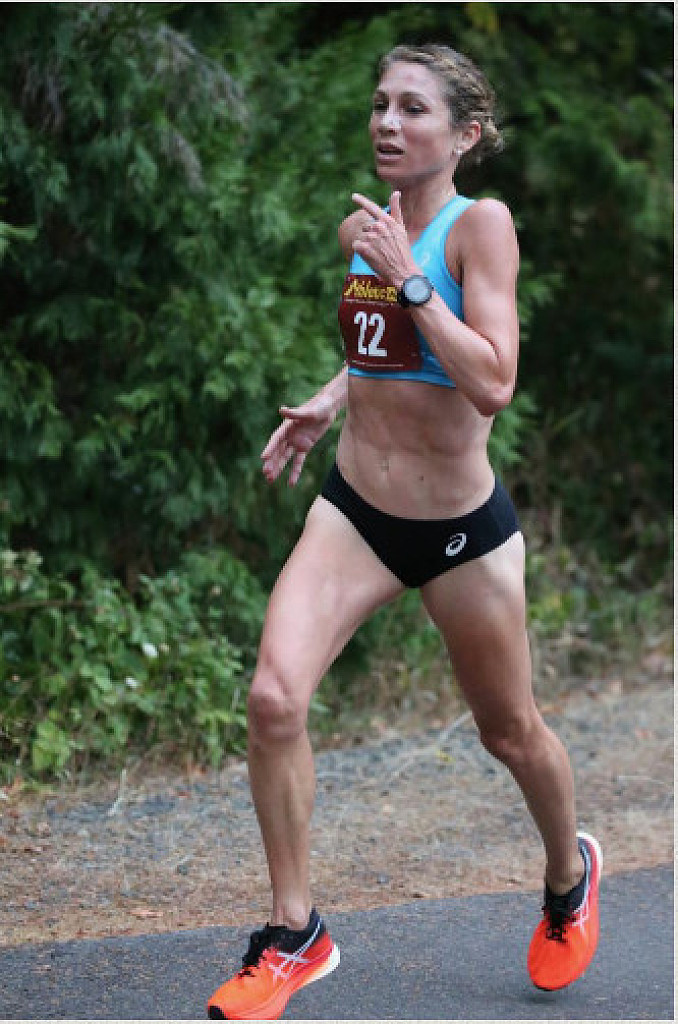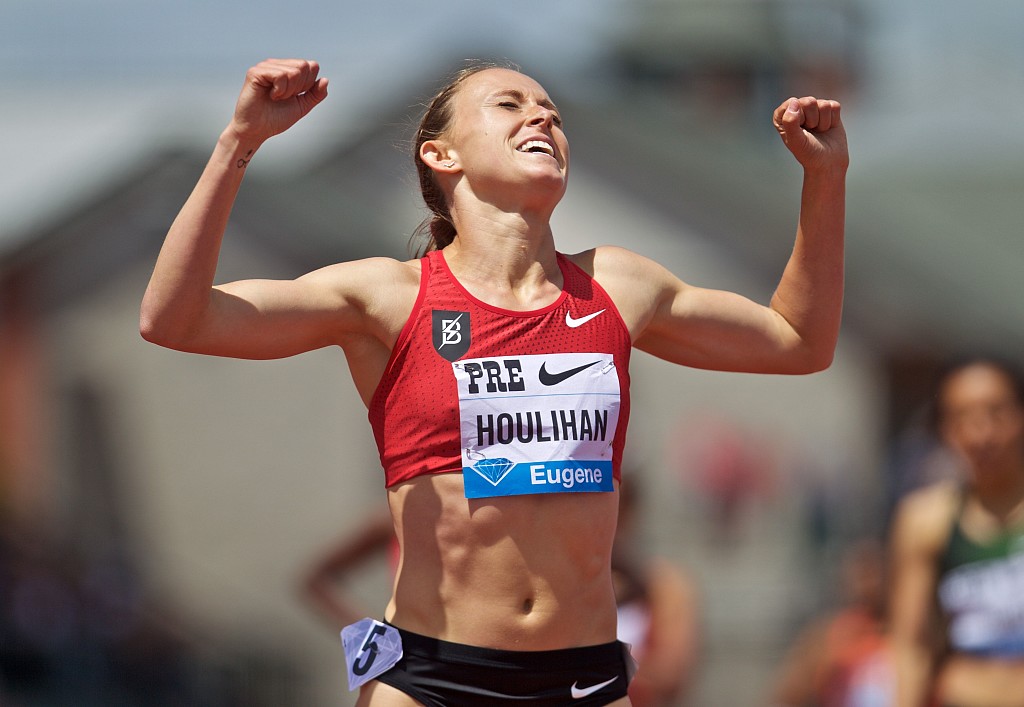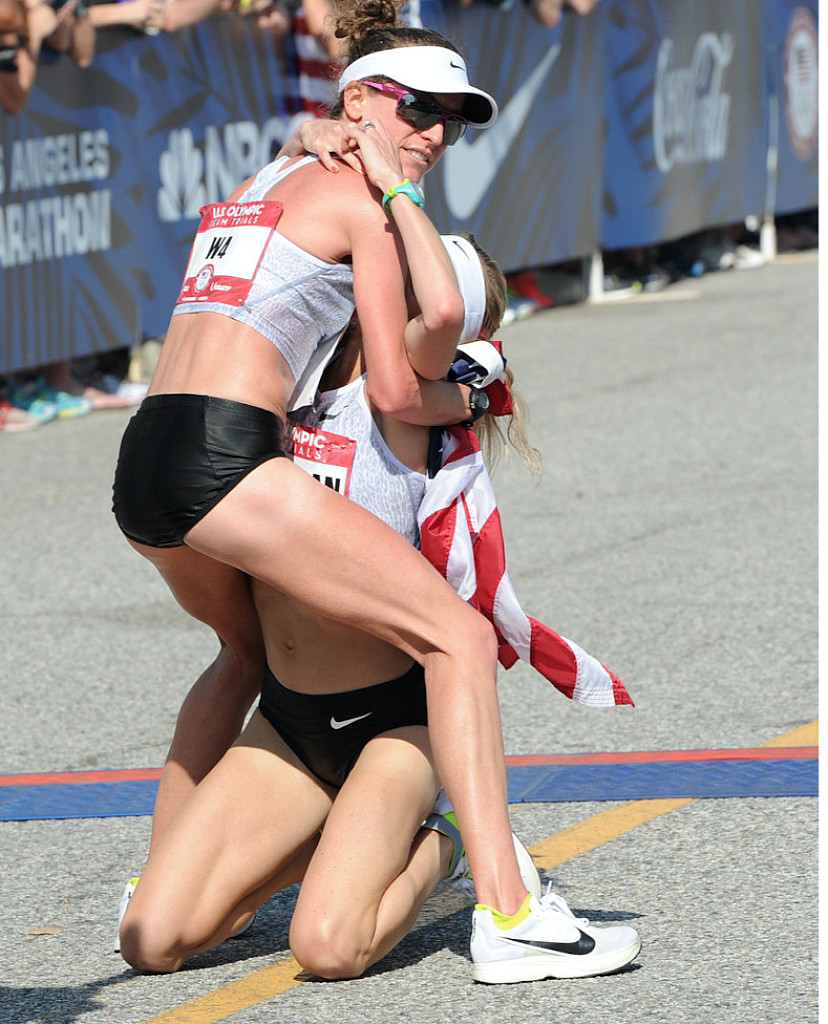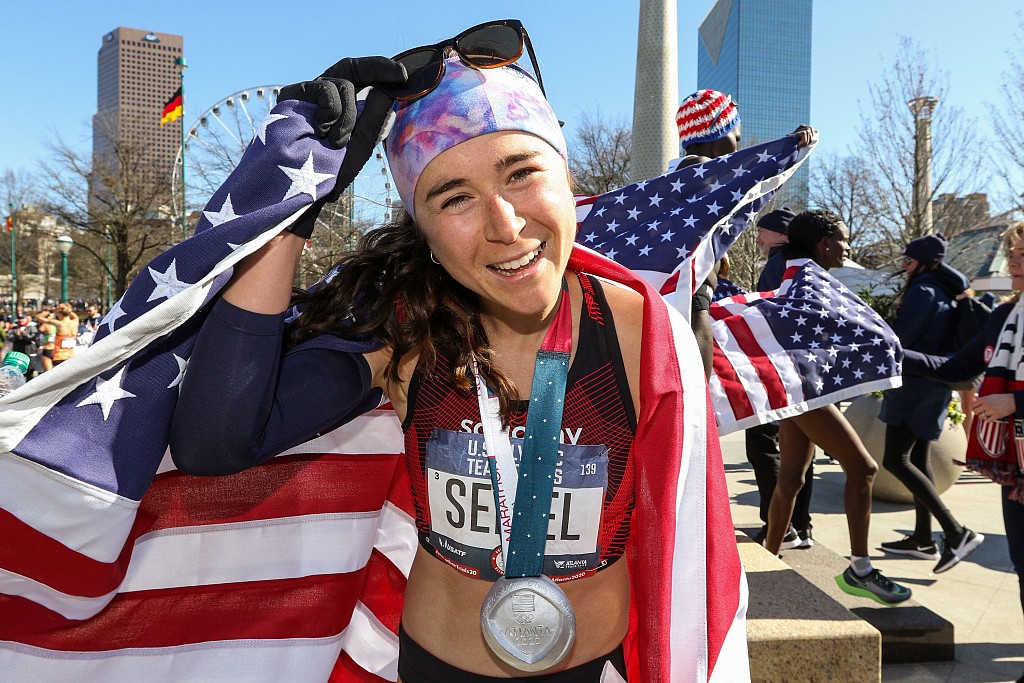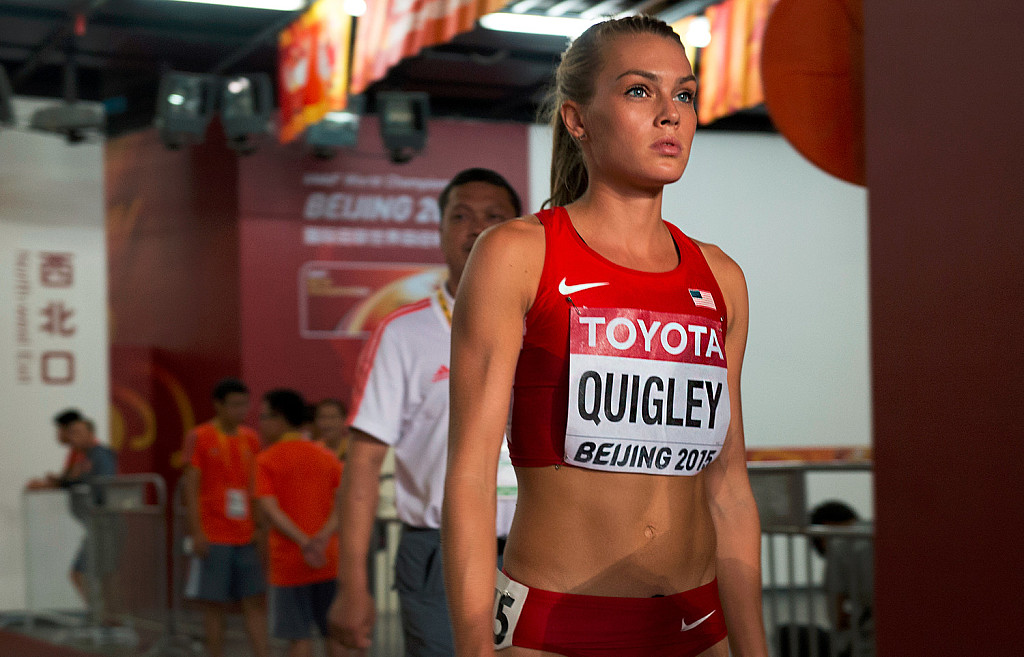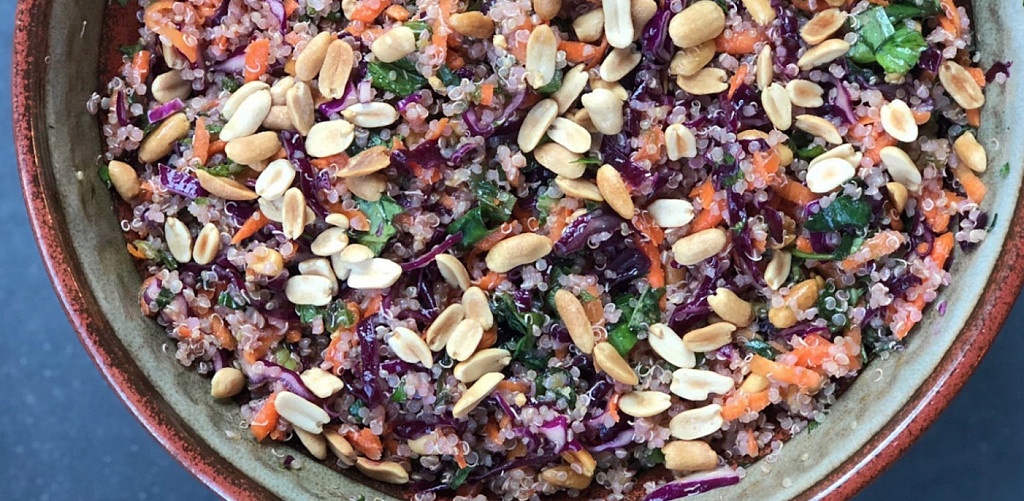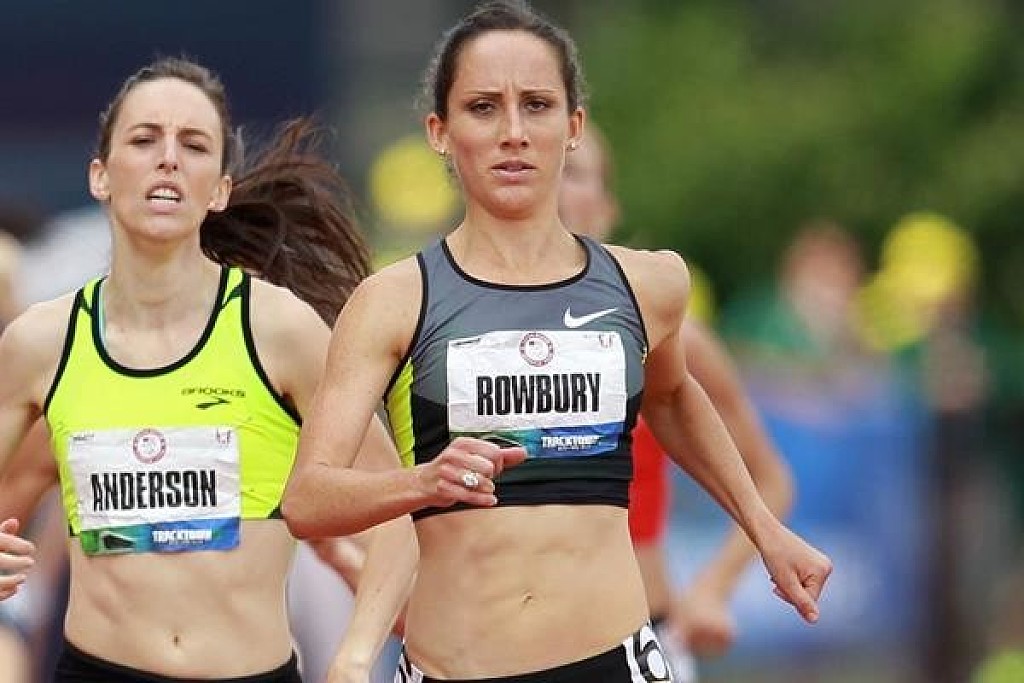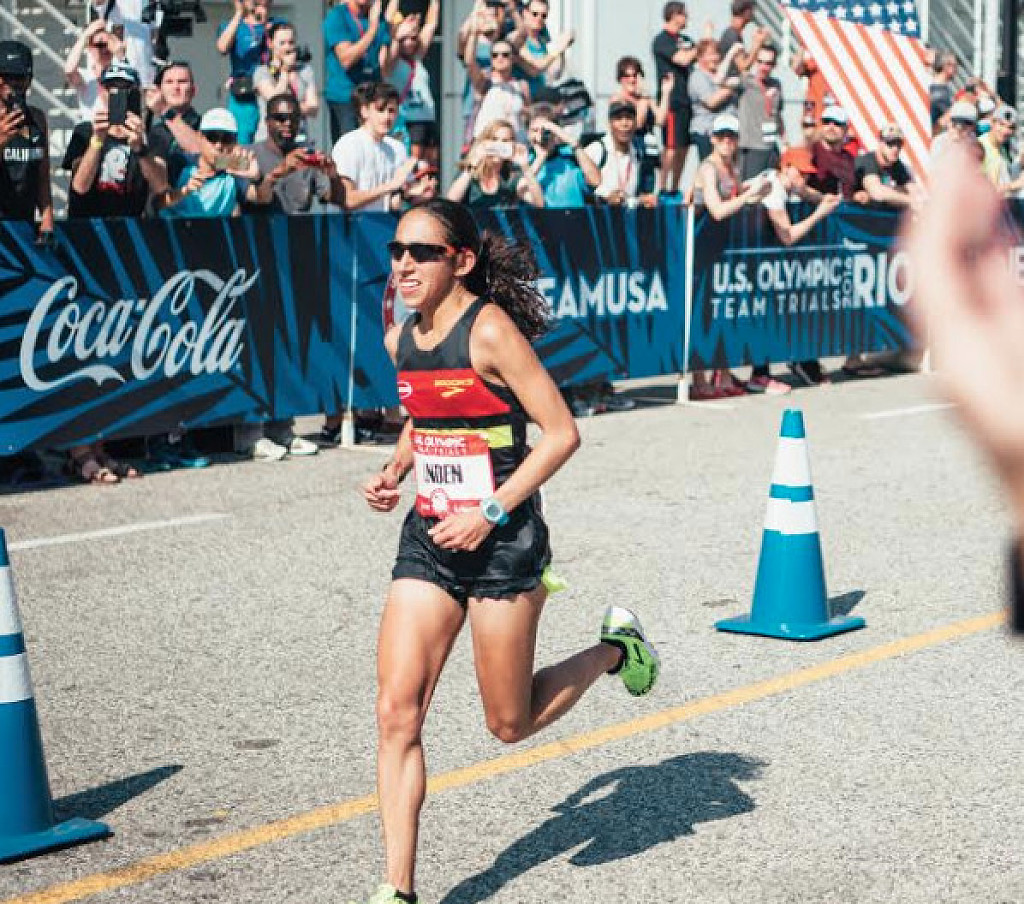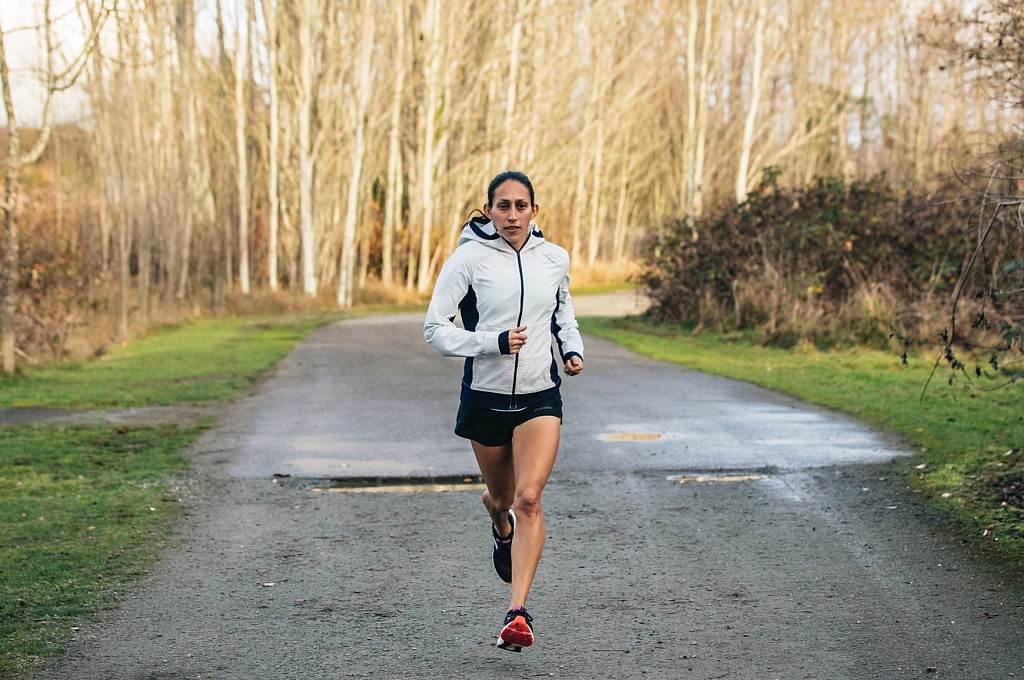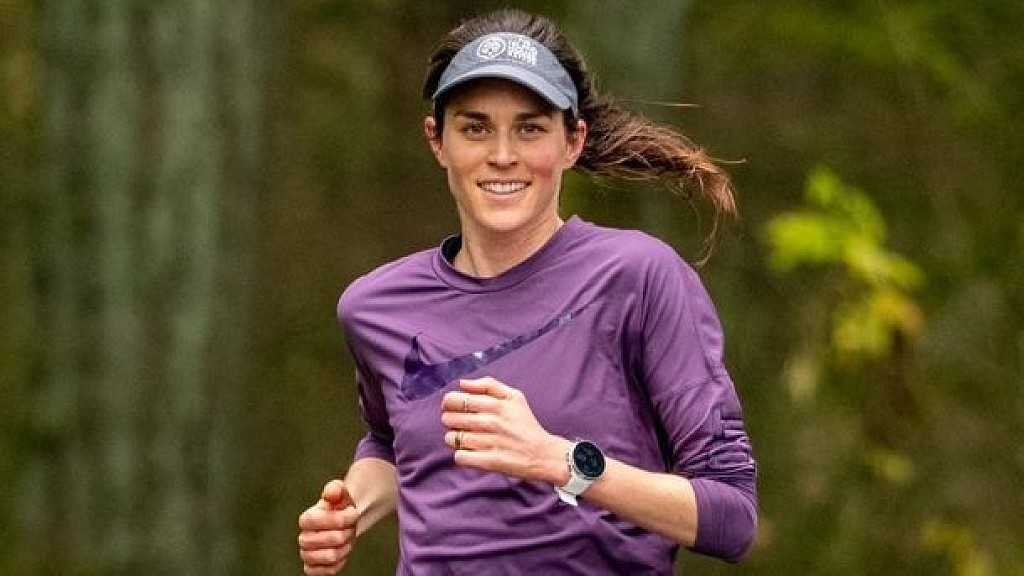Running News Daily
Running News Daily is edited by Bob Anderson. Send your news items to bob@mybestruns.com Advertising opportunities available. Train the Kenyan Way at KATA Kenya and Portugal owned and operated by Bob Anderson. Be sure to catch our movie A Long Run the movie KATA Running Camps and KATA Potato Farms - 31 now open in Kenya! https://kata.ke/
Index to Daily Posts · Sign Up For Updates · Run The World Feed
Articles tagged #Shalane Flanagan
Today's Running News
Gate River Run 2025 Returns to PRRO Circuit with Elite Competition and a Scenic Challenge
The Gate River Run is back for its 48th edition on Saturday, March 1, 2025, in Jacksonville, Florida, bringing together elite athletes, competitive runners, and thousands of participants for one of the most exciting road races in the country.
This year marks a historic moment as the race rejoins the Professional Road Running Organization (PRRO) Circuit for the first time since 1993, elevating its status on the international stage. With a challenging 15K course, a prize purse of $62,000, and the famous climb over the Hart Bridge, the Gate River Run is set to deliver another thrilling race in one of Florida’s most vibrant cities.
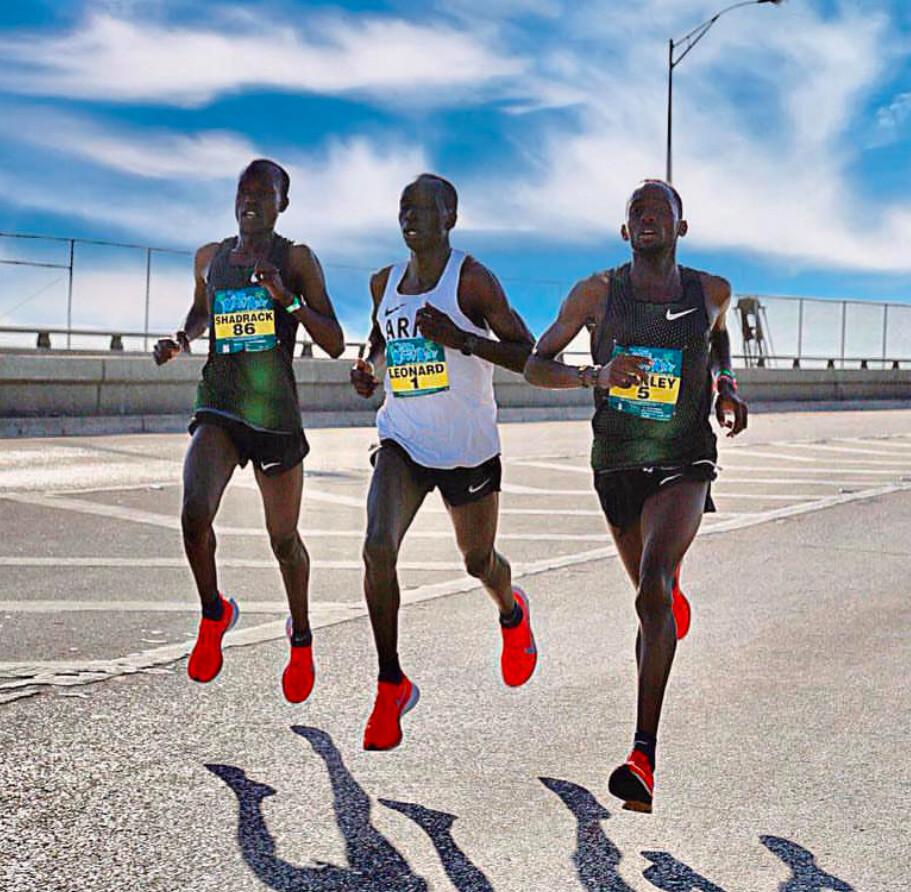
The event will once again serve as the USA 15K Championship, a title it has held since 1994, ensuring a strong field of American contenders alongside international competition. More than 18,000 runners are expected to take part, making this the largest 15K race in the country.
Elite field and prize structure
The 2025 Gate River Run is expected to feature a deep and competitive field, with elite athletes competing for national titles and significant prize money. As part of the PRRO Circuit, the race will draw top talent from both the U.S. and abroad.
The total prize purse for 2025 is $62,000, distributed as follows:
Open division: $20,500 each for men and women, awarded to the top ten finishers
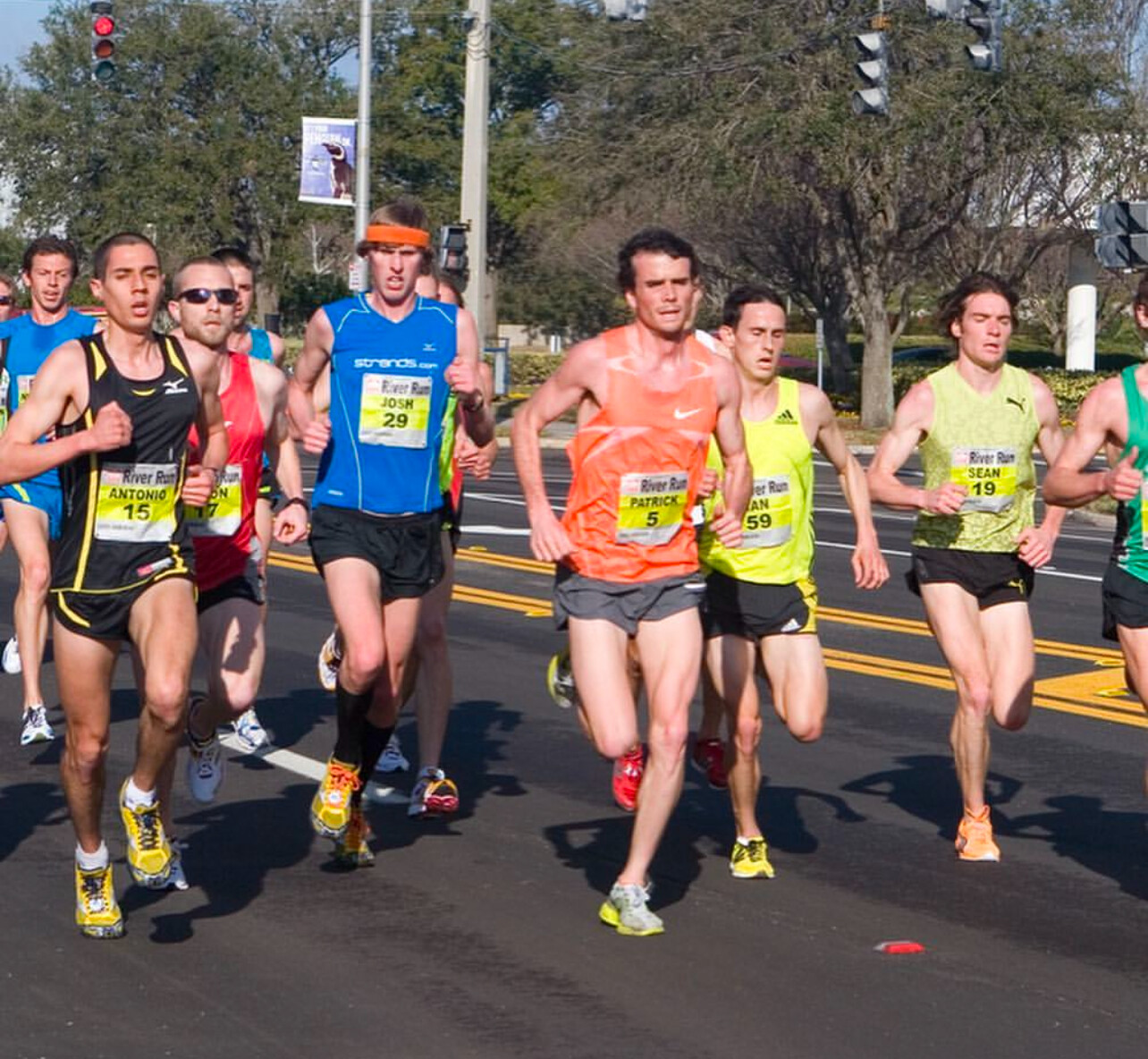
American Cup: $8,000 each for the top five U.S. male and female athletes
Equalizer bonus: $5,000 to the first athlete, male or female, to cross the finish line
Additional bonuses are available for record-breaking performances:
World record: $10,000
American record: $5,000
Course record: $3,000
The current course records belong to Todd Williams, who ran 42:22 in 1995, and Shalane Flanagan, who set the women’s mark of 47:00 in 2014.
Course details
The 15K (9.3-mile) course showcases some of Jacksonville’s most scenic and historic neighborhoods, including Downtown, San Marco, and St. Nicholas, with sweeping views of the St. Johns River. The early miles feature fast and flat stretches, allowing runners to settle into their rhythm before tackling the city’s signature challenge—the Hart Bridge.
Known as the “Green Monster,” the Hart Bridge presents a daunting climb in the final two miles, rising 141 feet above the river. The demanding half-mile ascent has tested even the strongest runners, making it one of the most memorable features of the race. After cresting the bridge, runners experience a thrilling downhill stretch toward the finish line at Metropolitan Park.
Event schedule
Elite women start at 7:55 am
Elite men and wave one start at 8:00 am
Subsequent waves begin shortly after, accommodating runners of varying paces
Jacksonville’s running heritage
Jacksonville has long been a city that embraces running. Home to one of the largest urban park systems in the U.S., its scenic riverfront, historic districts, and expansive green spaces have made it a favorite for runners of all levels. The Gate River Run, founded in 1978 by JTC Running, has played a major role in shaping the city’s running culture.
Over the years, the race has hosted some of the biggest names in distance running, including Olympic medalists Deena Kastor, Shalane Flanagan, and Meb Keflezighi. With its return to the PRRO Circuit, the event reaffirms its place as one of the premier road races in the country.
by Boris Baron
Login to leave a comment
Gate River Run
The Gate River Run (GRR) was first held in 1978, formerly known as the Jacksonville River Run, is an annual 15-kilometer road running event in Jacksonville, Fla., that attracts both competitive and recreational runners -- in huge numbers! One of the great running events in America, it has been the US National 15K Championship since 1994, and in 2007...
more...Shalane Flanagan Finds Her Sweet Spot With College Coaching
She’s juggling the University of Oregon women’s distance runners, the Bowerman Track Club, and a young family.
Before she gives a new workout to her University of Oregon athletes, Shalane Flanagan will try it out herself.
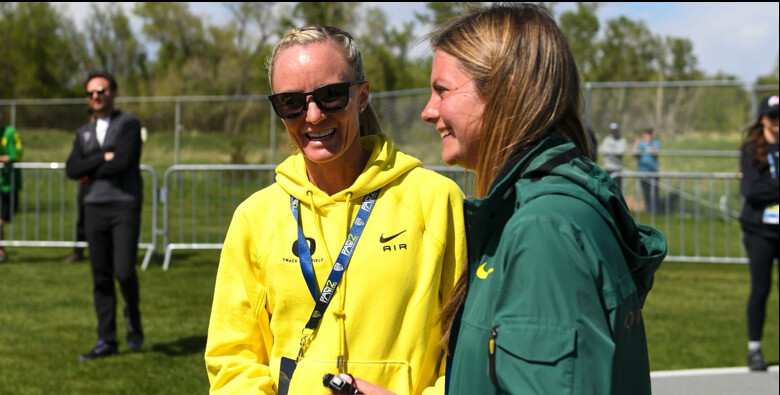
During cross-country season, it was a 5-mile tempo loop. Was it too hilly? Were the turns too sharp? In April, she was “messing around at the track one day,” as she described it, when she attempted a descending ladder of mile-800-600-400 at 10K-5K-3K-1500 pace with a short jog recovery.
“Yeah, that’s really hard,” she thought to herself. “But I think if they did that twice, it would make 10K runners feel really prepared.” Her goal with the experimentation is to make sure a workout is “feasible, but not outlandish” before her runners do it.
Few distance coaches in the NCAA are doing what she does, testing hard workouts, although Flanagan, 42, is quick to say that she does not hit the same splits her athletes do. Her boss, Oregon head coach Jerry Schumacher, is not so sure. “I see her out running every now and then, holy cow, she’s flying,” he told Runner’s World, quipping that it’s too bad she’s used up her NCAA eligibility.
Fewer still have the credentials that Flanagan, a four-time Olympian, has. She was the Olympic silver medalist in the 10,000 meters in 2008 and the 2017 New York City Marathon champion. Since she retired in 2019, she stayed on as an assistant coach with the Bowerman Track Club, a Nike pro group also coached by Schumacher that she ran for in the latter stages of her career.
That experience gives her credibility with her runners. So when she tells her athletes that they’re ready to handle a workout or race a certain time, they believe her.
“I don’t like to refer back to myself a lot,” she said in an interview at her home, a large 1920s colonial about a half mile from Hayward Field. “But I’ll say, ‘Hey, I’ve had experience with this,’ and I think they know, when I’m giving them advice, it’s not a hypothetical. I’m not projecting or guessing.
“They know it’s coming from a genuine place, because I’ve lived it,” she added. “I think that can be helpful with their confidence.”
Multiple full-time jobs
Flanagan had been living near Portland, Oregon, with her husband, Steve Edwards, and toddler son, Jack, when Schumacher was hired as the head coach of Oregon in Eugene, two hours south, in the summer of 2022. He brought Flanagan on as an assistant coach, while both kept their responsibilities with the Bowerman team, which also moved to Eugene. It was a lot.
Those early days for Flanagan—getting to know 11 female distance runners on the team, developing their training, learning the ever-changing NCAA rules, recruiting—were exhausting. And that was before they adopted a second child, Grace, as a newborn, in January 2023. They had only hours notice before Grace’s arrival.
Flanagan gets childcare help for Jack, almost 4, and Grace, 1, from a variety of babysitters and her parents. Her father, Steve Flanagan, and her stepmother visit often. One time, Flanagan had some team members’ parents visiting, and she turned around to see her dad showing them her Olympic medal. “What are you doing?” she asked him. “Put that away, that’s embarrassing.”
About three months in, when Schumacher asked her how she was handling the workload, she told him she was overwhelmed. “I’m really tired,” she said, “but this is the most fun I’ve ever had professionally. Like, I really love this job. I really love college athletics.”
Schumacher gave her full autonomy to write the training for Oregon’s women. And unlike with the Bowerman program, which former runners have said did not have much variation depending on the athlete, Flanagan has personalized training at Oregon for each individual. Some athletes on her team run as little as 25 miles per week, others go as high as 75.
One cornerstone of her training is the weekly long run on Sundays, and most weeks it has some structure to it, with tempo portions or a fartlek. For most of the team, the distance ranges from 12 to 16 miles, depending on the person.
When she first arrived in Eugene, she wrote the training with ranges in mileage. Easy days, for instance, she’d have her runners do 6 to 8 miles, depending on how they felt. They didn’t like that. They wanted an exact number. Getting them to trust themselves, listen to their bodies, and know the difference between muscle soreness and a potential injury has been one of her biggest challenges.
“I have tried to instill in them that they need to learn their body,” she said. “Like, I’m not in their body—they need to take stock and learn how to read their body. It’s one of the greatest skills and assets I felt like I had [as a runner].”
Flanagan tries to run with various groups at least one day per week on their easy runs. “It’s fun to run with the coach,” said Klaudia Kazimierska, who was fourth in the 1500 meters at the NCAA outdoor championships in 2023. “She’s a great inspiration, and she was a great athlete. She tries to give us a lot of information—and she tries to show us that running is so fun.”
Flanagan finds it easier to learn about her athletes when they’re on the run instead of sitting down and looking at one another. She’ll pick up vibes about what’s going on with them and urge them to limit their social media, especially when it comes to training.
“They devour information about what everyone else is doing,” Flanagan said. “I tell them, ‘You’ve got to be careful what goes in your head.’ I don’t follow any other kids from any other programs or any other coaches. I think it would undermine my intuitiveness. I don’t want to know.”
At the same time, she finds her college athletes much more professional than she was as an undergraduate at the University of North Carolina, when she worked hard, but also focused on her classes and other parts of college life. Not these women. “If anything, I’m like, ‘Yo, you’ve got to chill out. You’ve got to dial this back,’” she said. “They’re really into their running and I don’t have to nudge or push. They are really on top of it. It’s kind of freaky.”
Mixed results
Flanagan’s approach has yielded immediate results, but some athletes have had setbacks as well.
Last year, four qualified for the NCAA outdoor championships in the distance events, from 800 to 10,000, including three who made the final in the 1500.
Early in the 2024 outdoor season, the Ducks seemed destined to have more in this year’s championship meet, which started June 5 at Hayward Field.
At the end of March, Maddy Elmore set a school record in the 5,000 meters, running 15:15.79. Two weeks later, Şilan Ayyildiz, a transfer from the University of South Carolina who had been at Oregon for only about three months, ran 15:15.84.
Ayyildiz lines up at the NCAA championships this weekend, along with Kazimierska and Mia Barnett in the 1500 meters, and a freshman steeplechaser, Katie Clute. But Elmore sustained an injury to her soleus in late April and was unable to run in the qualifying meet for NCAAs. Flanagan’s total is again four athletes at NCAAs. She had hoped to have at least one qualifier in every event distance event.
In her short tenure, she has seen how college students have to grapple with stress, classes, finals, and in some cases, anxiety. They pick up illnesses. The big result doesn’t always come at the right time—if it comes at all. “I see these things and I see how they move and handle the work, but sometimes in this season, I may not get the performance in a race,” she said. The coach is still learning.
A busy summer
Elmore might be back in time to race the Olympic Trials, which begin on June 21. Kazimierska will go home to Poland and hope to make the Polish Olympic team in the 1500 meters. As soon as the season is over, Flanagan will turn more of her attention to the Bowerman team, which currently has three women: Karissa Schweizer, Christina Aragon, and Kaylee Mitchell. The club had several departures from the men’s and women’s side after Shelby Houlihan’s doping ban in 2021 and the move to Eugene in 2022.
It’s been difficult for Flanagan to watch the turnover, especially as some of the athletes she’d trained alongside for years, like steeplechaser Courtney Frerichs, left. They’re friends.
At the same time, Flanagan understands it. She changed coaches a few times herself during her career. It would be selfish for her to expect them to stay.
“Especially at the end of a career, to eke out those last big performances, sometimes you need a change of scenery,” she said. “I actually think it’s healthy to get different training, a different stimulus. Sometimes you can fall into this monotony and it feels stale especially if you’ve been doing it for a while.”
When she heard from athletes that they were thinking of leaving Bowerman, Flanagan jumped in with suggestions.
Her coaching brain took over to help.
“At the end of the day, I want them to be successful and happy,” she said. “So when they expressed maybe needing a change, I’m like, ‘Okay, let’s work through this. What are your plans? I don’t want you to leave and aimlessly not have a plan. What does that look like, what do you want to do?’ It’s a natural evolution.”
by Runner’s World
Login to leave a comment
U.S. Olympic Marathoners Will Race the Bolder Boulder 10K as a Pre-Paris Tune-Up
Conner Mantz, Clayton Young, and Leonard Korir will run in the International Pro Team Challenge on May 27.
Memorial Day is always an exceptional celebration for runners in Boulder, Colorado, but this year, it will have some extra special Olympic flair.
On Monday, May 27, more than 40,000 runners will run through the city that’s known for the iconic Flatirons rock formations, the Pearl Street pedestrian mall, and an exceptionally active population in the annual Bolder Boulder 10K. Now in its 44th year, it’s been one of the top road running races in the U.S. since its inception, and this year will serve as one of the final tune-ups for the men’s U.S. Olympic marathon squad before racing in the Paris Olympics later this summer.

Conner Mantz, Clayton Young, and Leonard Korir, the top three finishers in the 2024 U.S. Olympic Trials who will be racing the marathon in the Paris Olympics on August 10, will be competing as Team USA Red in the Bolder Boulder’s International Pro Team Challenge that follows the citizen’s races. (Korir is expected to officially be named to the U.S. team in early May based on final pre-Olympic international rankings.)
The pro race, which has a prize purse of $83,700 before potential bonuses, is one of the things that makes the Bolder Boulder so unique. After all the runners in 98 citizen waves have completed the race, professional men’s and women’s international teams from more than a dozen countries compete on the same course for team and individual titles. The races feature a staggered start, with women beginning 15 minutes before the men so the winners of each race will finish about 10 minutes apart inside the University of Colorado’s Folsom Field football stadium.
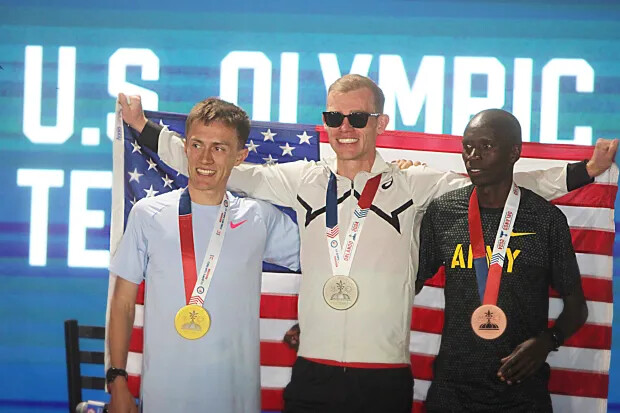
The finishing moments are among the thrilling spectacles in American running. By that point, the stadium is filled with a near-capacity crowd of roaring runners, family, and friends who have been watching the action play out on the massive video screens.
“The finish in the full stadium is like nothing else in the sport,” says Mantz, 27, who won the men’s race last year in 29:08 with a thrilling late-race surge to pass Kenya’s Alex Masai in the final 200 meters before the finish. “It was pretty electric. It took away all the pain you’re feeling mid-race. I was like, ‘Just race as hard as you can.’”
Team USA Red will have plenty of competition, from Team USA White, the secondary American team of Jared Ward, Futsum Zienasellassie, and Sam Chelanga, as well as teams from Kenya, Ethiopia, Mexico, and Rwanda. Teams are scored like a cross country race, with points awarded on the basis of finishing place, which means the team with the lowest combined score for all three runners is the winner. Ties are decided by the positions of the third-place finishers.
The women’s Team USA Red team will be led by defending champion Emily Durgin, along with Sara Hall and Boulder native Nell Rojas. Durgin finished ninth at the U.S. Olympic Trials in February and won the USATF 10 Mile Championships on April 7 in Washington D.C. At last year’s Bolder Boulder, she stormed to victory in 33:24, winning by 24 seconds over Kenya’s Daisy Kimeli.
Hall placed fifth in the U.S. Olympic Trials Marathon on February 3 in a U.S. master’s record (2:26:06) and 15th in the Boston Marathon on April 15. The women’s Team USA White roster will be composed of an all-University of Colorado alumnae squad—Makena Morley, Sara Vaughn, and Carrie Verdon.
“I can’t wait to be back in Boulder for the best day of the year,” says Durgin, 29, who will compete in the U.S. Olympic Trials 10,000 meters on the track in late June with the hopes of making the U.S. Olympic team. “Competing with Nell and Sara will make the experience even better.”
The women’s U.S. Olympic marathon team of Fionna O’Keefe, Emily Sisson, and Dakotah Lindwurm were invited to race in the Bolder Boulder but each runner declined, citing scheduling timing conflicts or a disinterest in racing at Boulder’s lofty altitude (5,430 feet). All of the runners who are racing for the U.S. teams in Boulder live at 4,500 feet or higher.
An Olympic Legacy
Boulder is known as one of the top running meccas in the U.S., in part because elite-level American and international runners have made it their training base since Olympic gold medalist Frank Shorter arrived in the early 1970s. Emma Coburn, Jenny Simpson, Yared Nuguse, Joe Klecker, Jake Riley, Hellen Obiri, and Edna Kiplagat are among the many top-level runners who are currently training in Boulder. Shorter, the 1972 marathon gold medalist, was a co-founder of Bolder Boulder 10K in 1979, and helped it grow into one of the country’s largest races.
Since then, numerous U.S. Olympians have raced in the Bolder Boulder, including Deena Kastor (a three-time women’s champion), Aliphine Tuliamuk (the 2022 women’s winner), Alan Culpepper, Elva Dyer, Ryan Hall, Abdi Abdirahman, Jorge Torres, Shalane Flanagan, Amy Cragg, Magdalena Boulet, and Libby Hickman, as well as Korir (who won it in 2022), and Ward (who was fourth in 2022).
Thanks to Boulder’s robust running community and the prestige of the race, the Bolder Boulder has also always featured fast sub-elite runners competing in the early citizen waves. Yet, the race has also celebrated dedicated middle-of-the-pack runners, as well as the first-time runners and walkers in the later waves. It was one of the first races to have bands playing along the course (as well as belly dancers and other entertainers), runners dressed up in costumes, elite wheelchair races, and in recent years, it has been known for a mid-race slip-and-slide and unofficial bacon aid station.
For the past 25 years, the Bolder Boulder has organized a special Memorial Day tribute—one of the largest in the country—that honors military veterans and new cadets.
The U.S. men’s Olympic marathon team competing in this year’s Bolder Boulder will be a legacy moment for the race, says Bolder Boulder race director Cliff Bosley.
“Having the three men that will represent our country in the marathon at this summer’s Paris Olympic Games is something we are extremely proud of,” Bosley says. “All three ran here last year, and to have them back is just incredible for the race, the city of Boulder, and the sport of running.”
by Brian Metzler
Login to leave a comment
Paul Chelimo is set to make marathon debut at Olympic Trials
Paul Chelimo, an Olympic 5000m silver and bronze medalist, will make his marathon debut at the U.S. Olympic Trials on Feb. 3 in Orlando.
“Ever since I was a kid, I dreamed of running a marathon… The day has come- this is it!” was posted on his social media Friday.
Chelimo, 33, qualified for the marathon trials by running a 1:02:22 half marathon last April 2, safely quicker than the 1:03:00 minimum to get into the field.
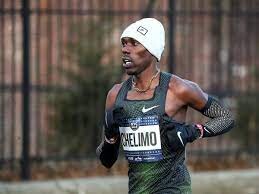
He didn’t publicly commit to racing the marathon trials until now. He could still contest the track trials in June.
“Let’s start by Orlando... then we will see!” Chelimo’s agent wrote in an email when asked about track trials.
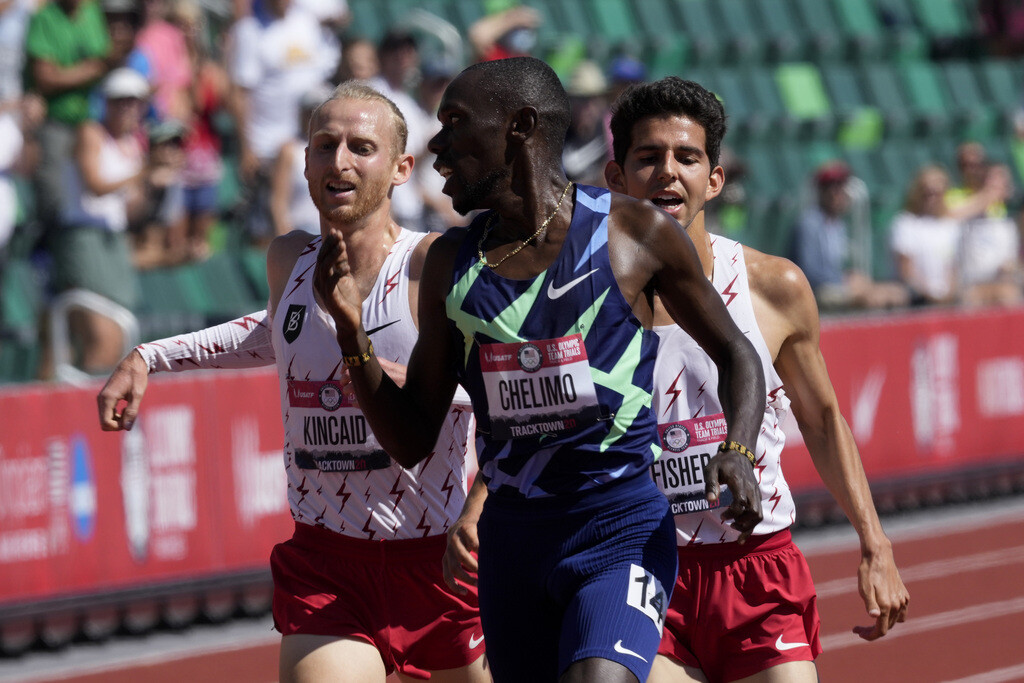
At marathon trials, the top three finishers on Feb. 3 are likely to make up the team for Paris. Since Chelimo has never raced a marathon, he also must run 2:11:30 or faster to hit a minimum qualifying time for Olympic eligibility.
Chelimo made five of the last six Olympic or world outdoor championships teams on the track in the 5000m. He won Olympic silver in 2016 and bronze in 2021, the latter being the lone U.S. men’s distance medal at the Tokyo Games.
Now, he joins a recent list of American global track medalists to move up to the marathon after Kara Goucher (2007 World 10,000m silver), Shalane Flanagan (2008 Olympic 10,000m silver), Galen Rupp (2012 Olympic 10,000m silver) and Bernard Lagat (world 5000m medals in 2007, 2009 and 2011).
Jenny Simpson, a world champion and Olympic bronze medalist at 1500m, also plans to make her marathon debut at the Feb. 3 trials.
Rupp made the 2016 Olympic marathon team in his debut at the distance at those trials. Molly Seidel did the same for the Tokyo Games. Each won a bronze medal in their first Olympic marathon.
Rupp, eyeing a fifth Olympics, headlines the men’s trials field along with Conner Mantz, the fastest American marathoner in 2022 and 2023 going for his first Games.
by Olympic Talk
Login to leave a comment
2028 US Olympic Trials Marathon
Most countries around the world use a selection committee to choose their Olympic Team Members, but not the USA. Prior to 1968, a series of races were used to select the USA Olympic Marathon team, but beginning in 1968 the format was changed to a single race on a single day with the top three finishers selected to be part...
more...Molly Seidel Stunned the World (and Herself) with Olympic Bronze in Tokyo. Then Life Went Sideways.
She stunned the world (and herself) with Olympic bronze in Tokyo. Then life went sideways. How America’s unexpected marathon phenom is getting her body—and brain—back on track.
On a clear December night in 2019, Molly Seidel was at a rooftop holiday party in Boston, wearing a black velvet dress, doing what a lot of 25-year-olds do: passing a joint between friends, wondering what she was doing with her life.
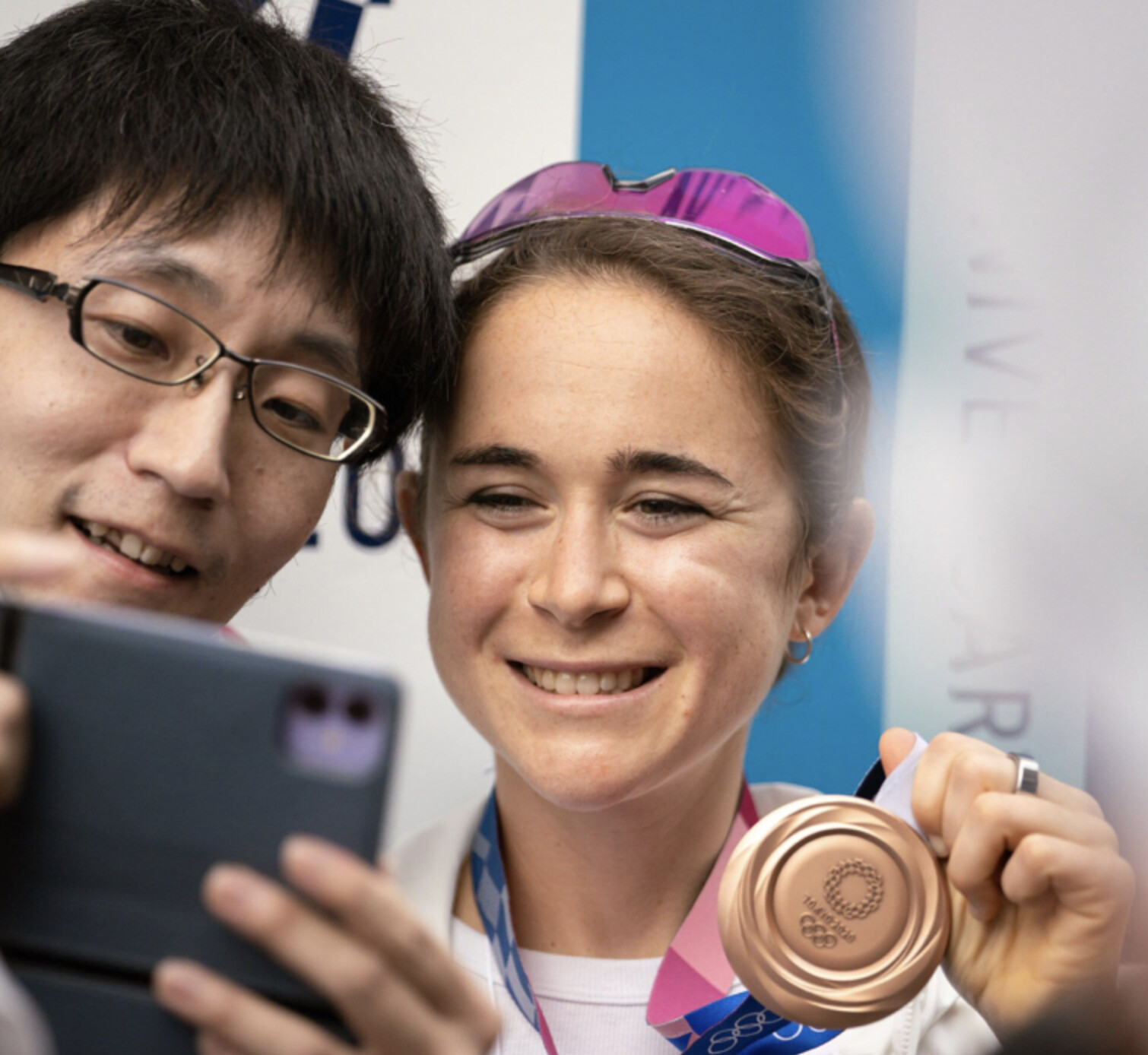
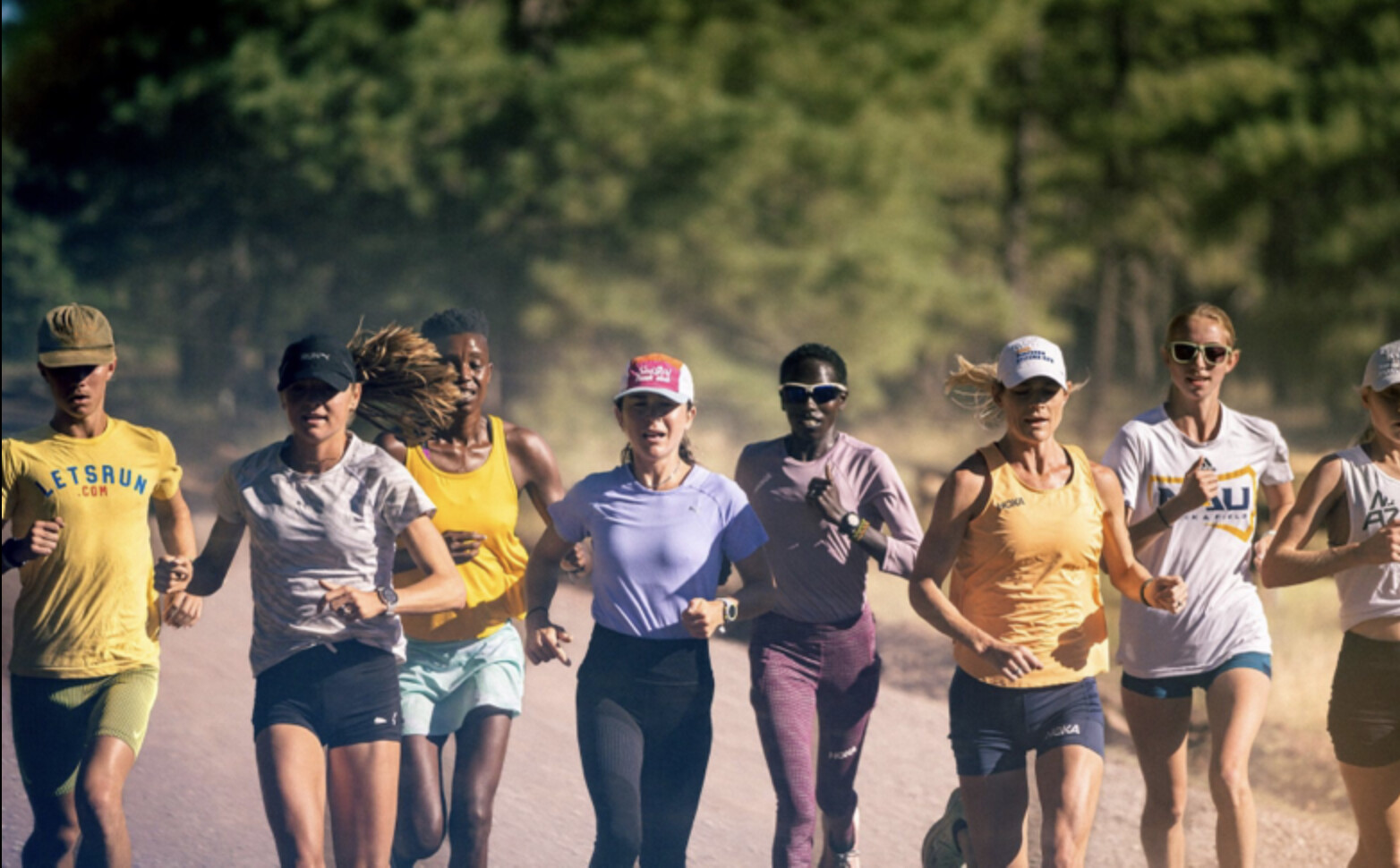
“You should run the Olympic Trials,” her sister, Izzy, said, as smoke swirled in the chilly air atop The Trackhouse, a retail shop and community hub on Newbury Street operated by the running brand Tracksmith. “That would be hilarious if you did that as your first marathon.”
Molly, an elite 10K racer who’d spent much of 2019 injured, looked out at the city lights, and laughed. Why the hell not? She’d just qualified for the trials, winning the San Antonio Half with a time of 1:10:27. (“The shock of the century,” as she’d put it.) True, 13.1 miles wasn’t 26.2—but running a marathon was something to do. If only because she never had before.
A four-time NCAA track and cross-country champion at The University of Notre Dame in Indiana, Molly had moved to Boston in 2017, where she’d worked three jobs to supplement her fourth: running for Saucony’s Freedom Track Club. The $34,000 a year that Saucony paid her (pre-tax, sans medical) didn’t go far in one of America’s most expensive cities. Chasing kids around as a babysitter, driving around as an Instacart shopper, and standing around eight hours a day as a barista—when you’re running 20 miles a day—wasn’t ideal. But whatever, she had compression socks. And she was downing free coffee and paying rent, flying to Flagstaff, Arizona, every so often for altitude camps, and having a good time. Doing what she loved. The only thing she’s ever wanted to do since she was a freckly fifth-grader in small-town Wisconsin clocking a six-minute mile in gym class.
“I was hustling, and I loved it. It was such a fun, cool time of my life,” she says, summarizing her 20s. Staring into Molly’s steely brown eyes, listening to her speak with such clarity and conviction about her struggles since, it’s easy to forget: She is still only 29.
After Molly had hip surgery on her birthday in July 2018, her doctors gave her a 50/50 chance of running professionally again. By summer 2019, she’d parted ways with FTC, which left her sobbing on the banks of the Charles River, getting eaten alive by mosquitoes and uncertainty. Her biggest achievement lately had been being named #2 Top Instacart Shopper (in Flagstaff; Boston was big-time).
The day after that rooftop party, Molly asked her friend and former FTC teammate Jon Green, who she’d newly anointed as her coach: “Think I should run the marathon trials?” Sure, he shrugged. Nothing to lose. Maybe it’d help her train for the 10K, her best shot—they both thought—at making a U.S. Olympic team.
“I’m going to get my ass kicked six ways to Sunday!” she told the host of the podcast Running On Om six weeks before the trials in Atlanta.
Instead, on February 29, 2020, she kicked some herself. Pushing past 448 of the fastest, most-experienced women marathoners in the country, coming in second with a 2:27:31, earning more in prize money ($60,000) than she had in two years of racing—and a spot on the U.S. trio for the 2020 Tokyo Olympics, along with Kenyan-born superstars Aliphine Tuliamuk and Sally Kipyego. “I don’t know what’s happening right now!” Molly kept saying into TV cameras, wrapped in an American flag, as stunned as a lottery winner.
Saucony who? Puma came calling. Along with something Molly hadn’t anticipated: the spotlight. An onslaught of social media followers. And two weeks later, a global pandemic and lockdown—and all the anxiety and isolation that came with it. She was drowning, and she hadn’t even landed in Tokyo yet.
The 2020 Olympics, as we all know, were postponed to 2021. An emotional burden but a physical boon for Molly, in that it allowed her to get in a second marathon. In London, she finished two minutes faster than her debut. When the Olympics finally rolled around, she was ready.
Before the race, Molly says, “I was thinking: ‘Once I cross the starting line, I get to call myself an Olympian and that’s a win for the day.’”
But then she crossed the finish line—with a finger-kiss to the sky and a guttural Yesss!—in third place with a 2:27:46, just 26 seconds behind first (Kenya’s Peres Jepchirchir). And realized: She gets to call herself an Olympic medalist forever. Only the third American woman to ever earn one in the marathon.
Lots of kids have fleeting hopes of making it to the Olympics. I remember thinking I could be Mary Lou Retton. Maybe FloJo, with shorter fingernails. Then I decided I’d rather be Madonna or president of the United States and promptly forgot about it. But Molly held tight to her Olympic aspirations. She still has a poster she made in 2004, with stickers and a snapshot of her smiley 10-year-old self, to prove it. “I wish I will make it into the Olympics and win a gold medal,” she wrote, and signed it: Molly Seidel, the “y” looping back to underline her name. In case there was any doubt as to who, specifically, would be winning the medal.
Molly grew up in Nashotah, Wisconsin, and is the eldest of three. Her sister and brother, younger by not quite two years, are twins. Izzy is a running influencer and corporate content creator for companies like Peloton; and Fritz favors Formula 1 racing and weightlifting and works for the family’s leather-tanning business. The family was active, sporty. Dad, Fritz Sr., was a ski racer in college; Mom, Anne, a cheerleader. You can tell. Watching clips of Molly’s mom and dad watching the Olympic race from their backyard patio, jumping up and down, tears streaming, is the kind of life-affirming moment you wish you could bottle. “I’m in shock. I’m in disbelief,” Molly says into the mic, beaming. “I just wanted to come out today and I don’t know…stick my nose where it didn’t belong and see what I could come away with. And I guess that’s a medal.” When the interviewer holds up her family on FaceTime, Molly breaks down. “We did it,” she says into the screen between sobs and smiles. “Please drink a beer for me.
Molly hasn’t always been unabashedly herself, even when everyone thought she was. A compartmentalizer to the core, she spent most of her life hiding a huge part of it: anorexia, bulimia, anxiety, obsessive-compulsive disorder, debilitating depression.
It started around age 11, when she learned to disguise OCD tendencies, like compulsively knocking on wood, silently reciting prayers “to avoid God getting mad at me,” she says. “It was a whole thing.” She says her parents were aware of the behaviors, but saw them more as odd little habits. “They had no reason to suspect anything. I was very high-functioning,” she says. “They didn’t realize that it was literally taking over my life.”
She wasn’t officially diagnosed with OCD until her freshman year of college, when she saw a therapist for the first time. At Notre Dame, disordered eating took hold, quietly yet visibly, as it does for up to 62 percent of female college athletes, according to the National Eating Disorders Association. As recently as the Tokyo Olympics, she was making herself throw up in the airport bathroom, mere days before taking the podium. Molly hesitates to share that detail; she fears a girl might read this and interpret it as behavior to model. “Having been in that place as a younger athlete, I know I would have,” she says. But she also understands: Most people just don’t get how unrelenting eating disorders can be.
In February 2022, she finally received a diagnosis of the root cause for all of it: ADHD. About being diagnosed, she says, “It made me feel really good, like [I don’t have] a million different disorders. I have a disorder that manifests itself in a lot of different symptoms.”
She waited to try Adderall until after the Boston Marathon in April, only to drop out at mile 16 due to a hip impingement. Initially, the meds made her feel fantastic. Focused. Free. Until she realized Adderall hurt more than it helped. She couldn’t sleep, couldn’t eat, lost too much weight. Within weeks, she devolved. “The eating disorder came roaring back,” she says, referring to it, as she often does, as its own entity, something that exists outside of herself. That ruthlessly takes control over her very need for control. “I almost think of it as an alter ego,” she explains. “Adderall was just bubblegum in the dam,” as she puts it. She ditched the drug, and her life—professionally, physically—unraveled.
In July 2022, heading into the World Championships, she bombed the mental health screening, answering the questions with brutal honesty. She’d been texting Keira D’Amato weeks prior. “Yo girl, things are pretty bad right now. Get ready…” Sobbing on the sidewalk in Eugene, Oregon, she texted D’Amato again. And the USATF made it official: D’Amato would take her spot on the team. Then Molly did what she’d been “putting off and putting off”— checked herself into eating disorder treatment for the second time since 2016, an outpatient program in Salt Lake City, where her new boyfriend was living at the time.
Somehow (see: expert compartmentalizer) mid-meltdown, in February 2022, she had met an amateur ultrarunner named Matt, on Hinge. A quiet, lanky photographer, he didn’t totally get what she did. “I didn’t understand the gravity of it,” he tells me. “I was like, Oh she’s a pro runner, that’s cool. I didn’t realize she was, like, the pro runner!”
Going back to treatment “was pretty terrible,” she says. At least she could stay with Matt. Hardly a honeymoon phase, but the new relationship held promise. “I laid it all out there,” says Molly. “And he was still here for it, for all the messiness. It was really meaningful.” And a mental shift. “He doesn’t see me as just Molly the Runner.”
Almost a year later, on a freezing April evening in Flagstaff, Molly is racing around Whole Foods, palming a head of cabbage, grabbing a thing of hummus, hunting for deals even though she doesn’t need to anymore.
“It’s all about speed, efficiency, and quality,” she says, explaining the secret to her earlier Instacart success. She checks the expiration date on a container of goat cheese and beelines for the butcher counter, scans it faster than an Epson DS3000, though not without calculation, and requests two tomato-and-mozzarella-stuffed chicken breasts. Then she darts over to the beverage aisle in her marshmallow-y Puma slip-ons that Matt custom-painted with orange poppies. She grabs a case of La Croix (tangerine), then zips to the checkout. We’re in and out in under 15 minutes and 50 bucks, nothing bruised or broken.
Other than her body. Let’s just say: If Molly were an avocado or a carton of eggs, she probably wouldn’t pass her own sniff test. The week we meet, she is just coming off a month of no running. Not a single mile. She’s used to running twice a day, 130 miles a week. No wonder she’s spraying her kitchen counter with Mrs. Meyer’s and scrubbing the stovetop within minutes of welcoming me into her new home.
The place, which she shares with Matt and his Australian border collie, Rye, has a post-college flophouse feel: a deep L-shaped couch draped in Pendleton blankets, a bar cluttered with bottles of discount wine, a floor lamp leaning like the Tower of Pisa next to a chew toy in the shape of a ranch dressing bottle. Scattered about, though, are reminders that an elite runner sleeps here. Or at least tries to. (“Pro runner by day, mild insomniac by night” reads the bio on her rarely used account on what used to be Twitter.) There’s a stick of Chafe Safe on the coffee table. Shalane Flanagan’s cookbooks on the counter. And framed in glass, propped on the office floor: Molly’s Olympic kit—blue racing briefs with the Nike Swoosh, a USA singlet, her once-sweat-drenched American flag, folded in a triangle. “I’m not sure where to hang it,” she says. “It seems a little ostentatious to have it in the living room.”
With long brown curls and a round, freckly face, Molly has an aw-shucks look so innocent that it’s hard, at first, to perceive her struggles. Flat-out ask her, though—How are you even functioning?—and she’ll tell you: “I’m an absolute wreck. There’s no worse feeling than being a pro runner who can’t run. You just feel fucking useless.” Tidying a stack of newspapers, she adds, “Don’t worry, I’ve had therapy today.”
She’s watched every show. (Save Ted Lasso, “too sickly sweet.”) Listened to every podcast. (Armchair Expert is a favorite.) She’s got nothing else to do but PT and go easy on the ElliptiGo in the garage, onto which she’s rigged a wooden bookstand, currently clipped with A History of God: The 4,000 Year Quest of Judaism, Christianity and Islam. “I don’t read running books,” she says. “I need something different.”
Like most runners—even the most amateur among us—running, moving, is what keeps her sane. “What about swimming? Can you at least swim?” I ask, projecting my own desperation if I were in her size 8.5 shoes. “I fucking hate swimming,” says Molly. Walking? “Oh, yeah, I can go on walks. Another. Long. Walk.”
The only thing she has on her schedule this week is pumping up a local middle school track team before their big meet. The invitation boosted her spirits. “Should I just memorize Miracle on Ice?” she says, laughing. “No, I know, I’ll do Independence Day.”
Injuries are nothing new for Molly. Par for the course for any professional athlete. But especially for women, like her, who lack bone density—and have since high school, when, according to a study in the Orthopedic Journal of Sports Medicine, nearly half of female runners experience period loss. Osteoporosis and its precursor, osteopenia, are rampant in female runners, leading to ongoing issues that threaten not just their college and professional running careers, but their lives.
Still, Molly admits, laughing: She’s especially accident-prone. I ask her to list every scratch she’s ever had, which takes her 10 minutes, and goes all the way back to babyhood, when she banged her head against the bathtub spout. There was a cracked spine from a sledding incident in 8th grade, a broken collarbone from a ski race in high school, shredded knee cartilage in college when a driver hit her while she was riding a bike. “Ribs are constantly breaking,” she says. In 2021, two snapped, and refused to heal in time for the New York City Marathon. No biggie. She ran through the pain with a 2:24:42, besting Deena Kastor’s 2008 time by more than a minute and setting the American course record.
Molly’s latest injury? Glute tear. “Literally a gigantic pain in the ass,” she posted on Instagram in March. Inside, Molly was devastated. Pulling out of the Nagoya Marathon—the night before her 6:45 a.m. flight to Japan, no less—was not in the plan. The plan, according to Coach Green, had been simple. It always is. If the two of them even have one. “Just to have fun and be consistent.” And get a marathon or two in before the Olympic Trials in February 2024.
She’d been finally—finally—fit on all fronts; ready to race, ready to return. She needed Nagoya. And then, nothing. “It feels like I’m back at the bottom of the well,” says Molly, driving home from Whole Foods in her Toyota 4Runner. “This last year-and-a-half has been so difficult. It’s just been a lot of doubt. How do I approach this, as someone who has now won a medal? Like, man, am I even relevant in this sport anymore?” She pops a piece of gum in her mouth. I wait for her to offer me some, because that’s what you do with gum, but she doesn’t. She’s so in her head. “It’s hard when you’re in the thick of it, you know, to figure out: Why the fuck do I keep doing this? When it just breaks my heart over and over and over again?”
We pull into her driveway. “I was prepared for the low period after Tokyo,” she says. “But this has been much longer and lower than I expected.”
The curse of making it to the Olympics, let alone coming back with a medal: expectations. Molly’s own were high. “I think I thought, after the Olympics, if I win a medal, then I will be fixed, it will fix everything.” Instead, in a way, it made everything worse.
That’s the problem that has plagued Molly for most of her running career: Her triumphs and troubles intermingle, like thunder and lightning. Which, by the way, she has been struck by. (A minor backyard-grill, summer-thunderstorm incident. She was fine.)
The next morning in Flagstaff, Molly’s feeling like she can run a mile, maybe two. It’s snowing, though, and she doesn’t want to risk the slippery track, so we meet at Campbell Mesa Trails. She loops a band around the back of her truck to stretch and sends me off into the trees to run alone while she does a couple of laps on the street.
Molly leaves for an acupuncture appointment, and we reunite later at Single Speed Coffee (“the best coffee in Flagstaff,” promises the ex-barista who drinks up to three cups a day). We curl up on a couch like it’s her living room, and she talks as freely—and as loudly—as if it was. Does she realize everyone can hear her? She doesn’t care. I guess that’s what happens when you’ve grown so comfortable sharing—in therapy, on podcasts, in a three-part video series on ADHD for WebMD—you just…share. Loud and proud.
Mental illness is so insidious, says Molly. “It’s not always this Sylvia Plath stick-my-head-in-a-fucking-oven thing, where you’re sad all the time,” she says. “High-functioning depressed people live normal successful lives. I can be having the happiest moment, and three days later I’m in a total downward spiral.” It’s something you never recover from, she says, but you learn to manage.
“I’m this incredibly flawed person who struggles so much. I think: How could I have won this thing when I’m so flawed? I look at all the people around me, all these accomplished people who have their shit together, and I’m like, ‘one of these things is not like the other,’” she says, taking a sip of her flat white. “I was literally in the Olympic Village thinking: Everybody is probably looking at me wondering: Why the hell is she here?”
They weren’t. They don’t. She knows that.
And yet her mind races as fast as she does. It takes up So. Much. Space. When she’s running, though, the noise disappears. She’s not Olympic Molly or Eating Disorder Molly, she’s not even, really, Runner Molly. “When I’m running,” she says, “I’m the most authentic version of myself.”
Talking helps, too. Molly first shared her mental health history a few years ago, “before she was famous,” as she puts it. After the Olympics, though, she kept talking and hasn’t stopped. The Tokyo Games were a turning point, she says. Suddenly the most revered athletes in the world were opening up about their mental health. Molly credits Simone Biles’s bravery for her own. If Biles, and Michael Phelps and Naomi Osaka, could come clean... then maybe a nerdy, niche-y, unlikely medaling marathoner could, too.
“Those guys got a lot more shit for it than I did,” says Molly. “I got off easy. I’m not a household name,” she laughs. She knows she can be candid and off the cuff—and chat freely in a not-empty café—in a way Biles never could. “I’m a nobody!” she laughs.
Still, a nobody with 232,000 Instagram followers whom she has touched in very IRL ways—becoming an unintentional poster woman for normalizing mental health challenges among athletes. “You are such an incredible inspiration,” @1percentpeterson posts, one comment of a zillion similar. “It’s ok to not be ok!” says another. Along with all the online love is, of course, online hate. Molly rattles off a few lowlights: “She’s an attention-seeking whore,” “Her bones are so brittle she’ll never race again,” “She’s running so badly and posting a lot she should really focus on her running more.” Molly finds it curious. “I’m like, ‘If you hate me, you don’t need to follow me, sir.’”
It’s Molly’s nobody-ness—what Outside writer Martin Fritz Huber called her “runner-next-door” persona, and I’ll just call “genuine personality”—that has made her somebody in running’s otherwise reserved circles.
Somebody who (gasp!) high-fives her sister in the middle of a major race, as she did at mile 18 of the 2021 New York City Marathon. “They shat on me in the broadcast for it,” she says. “They were like, ‘She’s not taking this seriously.’” (Except, uh, then she set the American course record, so…)
Somebody who, obviously, swears like a sailor and dances awkwardly on Instagram, who dresses up like a turkey, and viral-tweets about getting mansplained on an airplane. (“He starts telling me how I need to train high mileage & pulls up an analysis he’d made of a pro runner’s training on his phone. The pro runner was me. It was my training. Didn’t have the heart to tell him.”)
Somebody who makes every middle-aged mom-runner I know swoon like a Swiftie and say: “OMG! YOU HUNG OUT WITH MOLLY SEIDEL!!?” Middle-aged dad-runners, too. “I saw her once in Golden Gate Park!” my friend Dan fanboyed when he heard. “I waved!” Did she wave back? “She smiled,” he says, “while casually laying down 5:25s.”
And somebody who was as outraged as I was that I bought a $16 tube of French toothpaste from my hip Flagstaff motel. (It was 10 p.m.! It was all they had!) “For that price it better contain top-shelf cocaine,” she texted. Lest LetsRun commenters take that tidbit out of context: It’s a joke. It’s, in part, what makes Molly America’s most relatable pro runner: She’s not afraid to make jokes. (While we’re at it… Don’t knock her for smoking a little legal weed, either. That’s so 2009. Per the World Anti-Doping Agency: Cannabis is prohibited during competition, not at a Christmas party two months before it. Per Molly: “People would be shocked to know how many pro runners smoke weed.”)
I can’t believe I never asked to see it. Molly’s medal. A real, live Olympic medal. Maybe because it was tucked into a credenza along with Matt’s menorah and her maneki-neko cat figurines from Japan. But I think it was because hanging out with Molly felt so…normal, I almost forgot she’d won one.
People think elite distance runners have to be one-dimensional, she says. That they have to be sculpted, single-minded, running-only robots. “Because that’s what the sport has been,” she says.
Molly falls for it, too, she says. She scrolls the feeds, sees her fellow pros living seemingly perfect lives. She wants everyone to know: She’s not. So much so that she requested we not print the photos originally commissioned for this story, which were taken when she was at the lowest of lows. (“It’s been...refreshing...to be pretty open and real with Rachel [about] the challenges of the last year,” she wrote in an email to Runner’s World editors. “But the photos [were taken at] a time when I was really struggling and actively trying to hide how bad my eating disorder had become.”)
Molly finds the NYC Marathon high-five thing comical but indicative of a more serious issue in elite running: It takes itself too seriously. It’s too…elitist. Too stilted. “Running a marathon is a pretty freaking cool experience!” If you’re not having fun, she asks rhetorically, what’s the point? Still, she admits, she isn’t always having fun. Though you wouldn’t know it from her Instagram. “Oh, I’m very good at making it seem like I am,” she says.
She used to enjoy social media when it was just her friends. Before she gained 50,000 followers in a single day after the trials, and some 70,000 on Strava. Before the pandemic, before the Olympics. Keeping up with content became a toxic chore. “You feel like you’re just feeding this beast and it’s never going to stop,” she says. She’s taken to deleting the app off her phone, reloading it only to fulfill contractual agreements and post for her sponsors, then deleting it again.
As much as she hates having to post, she enjoys plugging products the only way that feels natural: through parody. As does Izzy, her influencer sister, who, like Molly, prefers to skewer rather than shill (à la their idea behind their joint Insta account: @sadgirltrackclub). “The classic influencer tropes make me want to throw up,” she says (perverse pun as a recovering bulimic not intended). “New Gear Drop!’ or ‘This is my Outfit of the Day!’ Cringe. “Hot Girl Instagram is not how I identify,” she says.
Nor is TikTok. “Sponsors tell me all the time: You should TikTok! I’m like, ‘I am not doing TikTok.’ I know how my brain works. They’ll say, ‘We’ll pay you less if you don’t’—and I’m, like, I don’t care.”
And to those sponsors who ghosted her after she returned to eating disorder treatment, good riddance. “Michelob dropped me like a bad habit,” she says. “Whatever. You have watery-ass beer anyway.”
To those who have stood by her, though, she’s utterly devoted. Pissed she couldn’t wear the Puma panther head to toe in Tokyo, Molly took off her Puma Deviate Elites and tied them over her shoulder, obscuring the Nike logo on her Olympic singlet for all the world to see. Or not see. “Nike isn’t paying my fucking bills.”
The love is mutual, says Erin Longin, a general manager at Puma. After decades backing legends like Usain Bolt, Puma was relaunching road running and wanted Molly as their guinea pig. “She’s a serious athlete and competitor, but she also has fun with it,” says Longin. “Running should be fun. Molly embodies that.” At their first meeting, in January 2020, Molly made them laugh and nerded out over their new shoes. “We all left there, fingers crossed she’d sign with us,” says Longin.
Come February, they all flipped out. Longin was watching the trials, not expecting much. And then: “We were all messaging, “OMG!!” Then Molly killed in London. Medaled in Tokyo. “What she did for us in that first year…” says Longin. “We couldn’t have planned it!”
Then came the second year, and the third, and throughout it all—injuries, eating disorder treatment, missed races, missed opportunities—Puma hasn’t flinched. “It’s easy for a company to do the right thing when everything is going great,” Molly posted in April, heartbroken from her couch instead of Heartbreak Hill. “But it’s when the sh*t hits the fan and they’re still right there with you….” She received 35,000 hearts—and a call from Longin: “You make me feel so proud.”
Does it matter to Puma if Molly never places—never races—again? “Nope,” Longin says.
My last afternoon in Flagstaff, it’s cloudy skies, still freezing. I find Molly on the high school track wearing neoprene gloves, black puffy coat, another pair of Pumas. Her breath is white, her cheeks red. Her legs churning in even, elegant strides. Upright, alone, at peace, backed by snow-dusted peaks. Running itself is what matters, not racing, she tells me. “I honestly don’t give a shit about winning,” she says. All she wants—really wants, she says—is to be healthy enough to run until she’s old and gray.
Molly’s favorite runner is one who didn’t get to grow old. Who made his mark decades before she was born: Steve Prefontaine. “Pre raced in such a genuine way. He made people feel something,” she says. “The sports performances you truly remember,” she adds, “are the ones where you see the struggle, the work, the realness.”
Sounds familiar. “I hate conversations like, ‘Who’s the GOAT?’” Molly continues. “Who fucking cares? Who’s got the story that’s going to get people excited? That’s going to make some kid want to go out and do it?”
I know one of those kids: My best friend’s daughter, Quinn, a rising track phenom in Oregon, who has dealt with anxiety and OCD tendencies. She has a picture of Molly Seidel, and her times, taped to her bedroom wall. This past May, Quinn joined Nike’s Bowerman Club. She was named Oregon Female Athlete of the Year Under 12 by USATF. She wants to run for Notre Dame.
“Quinn loves running more than anything,” her mom tells me, texting photos of her elated 11-year-old atop the podium. “But I don’t know…” She’s unsure about setting her daughter on this path. How could she not, though? It’s all Quinn wants to do. Maybe what Quinn, too, feels born to do.
It’ll be okay, I tell her, I hope. Quinn has something Molly never had: She has a Molly.
Molly and I catch up via phone in June. A team of doctors in Germany has overhauled her biomechanics. She’s been running 110 miles a week, feeling healthy, hopeful. Happy. A month later, severe anemia (and accompanying iron infusions) interrupts her summer racing schedule. She cancels the couple of 10Ks she had planned and entertains herself by popping into the UTMB Speedgoat Mountain Race: a 28K trail run through Utah’s Little Cottonwood Canyon—coming in second with a 3:49:58. Molly’s focus is on the Chicago Marathon, October 8th; her first major race in almost two years.
Does it matter how she does? Does it matter if she slays the Olympic Trials in February? If she makes it to Paris 2024? If she fulfills her childhood dream and brings home gold?
Nah. Not if—like Matt, like Puma, like, finally, even Molly herself—you see Molly the Runner for who she really is: Molly the Mere Mortal. She’s the imperfect one who puts it perfectly: What matters isn’t her time or place, how she performs on the pavement. Or social media posts. What matters—as a professional athlete, as a person—is how she makes people feel: human.
She’d been finally—finally—fit on all fronts; ready to race, ready to return. She needed Nagoya. And then, nothing. “It feels like I’m back at the bottom of the well,” says Molly, driving home from Whole Foods in her Toyota 4Runner. “This last year-and-a-half has been so difficult. It’s just been a lot of doubt. How do I approach this, as someone who has now won a medal? Like, man, am I even relevant in this sport anymore?” She pops a piece of gum in her mouth. I wait for her to offer me some, because that’s what you do with gum, but she doesn’t. She’s so in her head. “It’s hard when you’re in the thick of it, you know, to figure out: Why the fuck do I keep doing this? When it just breaks my heart over and over and over again?”
by Runner’s World
Login to leave a comment
2024 U.S. Olympic Marathon Trials to start at 12 noon
USA Track and Field (USATF) caused a stir on social media on Tuesday after announcing in an email addressed to athletes that the 2024 Olympic Marathon Trials would begin at 12 noon, due to broadcasting rights. The marathon trials are scheduled to take place in Orlando, Fla., on Feb. 3, 2024.
The late start time has already caused worry for many coaches and athletes due to the potential for high temperatures. In February, the average temperatures in Orlando range from a low of 13 C to a high of 23 C, but in recent years, it has not been uncommon for temperatures to soar to 30 C–which would be detrimental to performance and potentially unsafe for elite marathoners.
According to Runners World, the email sent to athletes mentions that the Local Organizing Committee (LOC) in Orlando has extensive experience in planning and executing high-level events and has contingencies in place for any potential challenges, including weather-related ones.
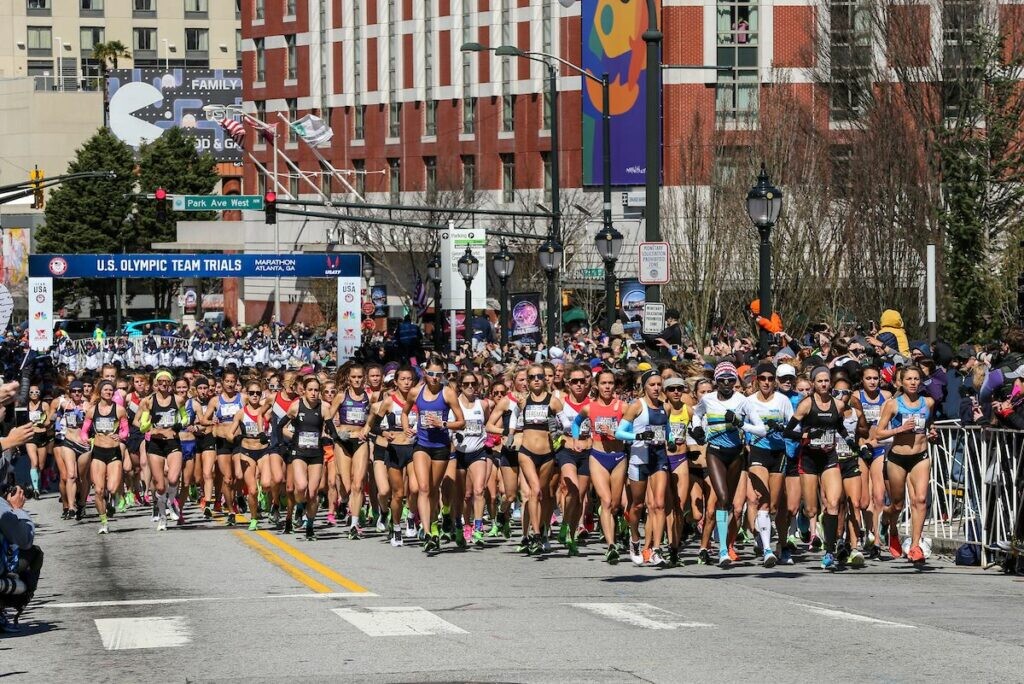
The decision to set the start time at noon is believed to be influenced by executives at NBC, the network broadcasting the event. The email highlights that the race will be televised live on NBC for three hours, providing coverage of the men’s and women’s runners and races.
The Paris Olympic marathon, which is also expected to be warm, is scheduled for Aug. 10–the middle of summer in the French capital. But both the men’s and women’s races are set to begin at 8 a.m. local time. This disparity in start times has added to the concerns raised by the late start for the U.S. Trials in Orlando.
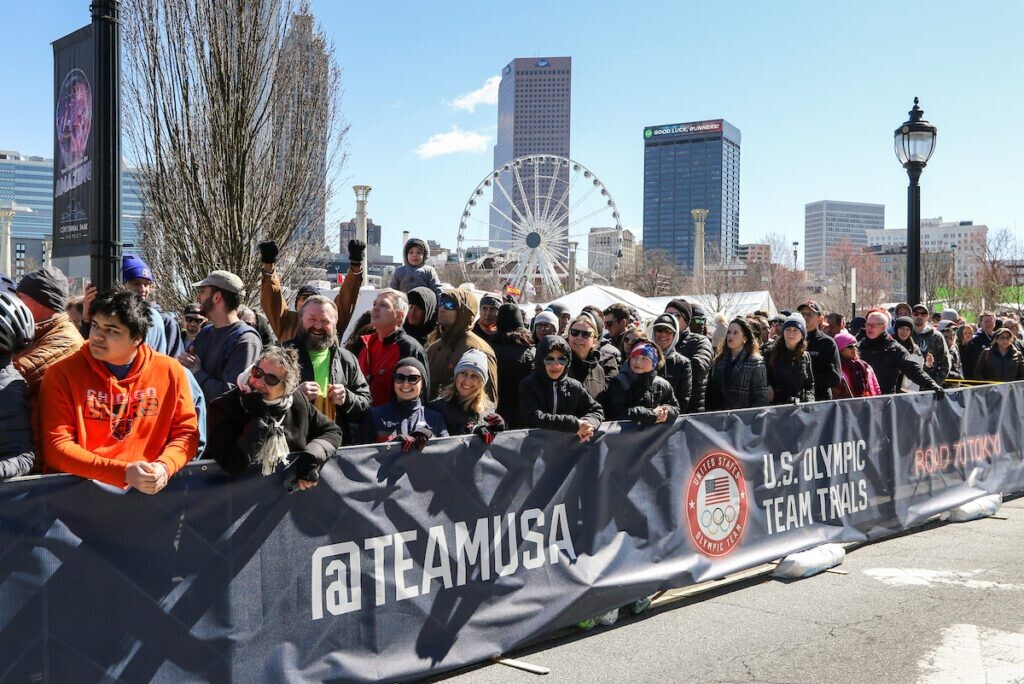
The U.S. Olympic Marathon Trials serves as the selection race for the men’s and women’s Olympic teams that will compete at the Summer Games in Paris. The top three finishers who also meet World Athletics’ qualifying standards will go on to represent Team USA at the Olympics.
Some athletes and coaches have expressed concern, while others seem to be looking forward to it. 2018 Boston Marathon champion Des Linden tweeted: “Warmer temps should slightly minimize the pace of super shoes and reward smarter racing. Count me in!”
U.S. ultrarunner Camille Herron said “We are seven months out from the Olympic Marathon Trials. No excuses to not be prepared for a potentially hot day in Florida.”
Renowned U.S. marathon coach Kevin Hanson, who currently has 13 athletes (eight women and five men) qualified for the U.S. Trials, stressed his disappointment that athletes’ health is not taken into consideration. “There is no amount of TV coverage that is worth the health of our athletes,” Hanson tweeted.
This isn’t the first time USATF has faced criticism for its handling of extreme heat during events. At the 2021 Olympic Track and Field Trials in Eugene, Ore., where temperatures were forecasted to reach highs of 40 C, several events were rescheduled for safety. However, the heptathlon was not, and athlete Taliyah Brooks collapsed on the track due to the heat and later filed a lawsuit against USATF.
In the 2016 Olympic Marathon Trials in Los Angeles, which began at 9 a.m., some athletes struggled on an unusually warm day, with temperatures reaching the mid-70s Fahrenheit. Shalane Flanagan, who placed third in 2:29:19, collapsed at the finish line, and the organizing committee and USATF later faced criticism for not providing adequate water on the course for the athletes.
by Marley Dickinson
Login to leave a comment
2028 US Olympic Trials Marathon
Most countries around the world use a selection committee to choose their Olympic Team Members, but not the USA. Prior to 1968, a series of races were used to select the USA Olympic Marathon team, but beginning in 1968 the format was changed to a single race on a single day with the top three finishers selected to be part...
more...When Will Eliud Kipchoge Slow Down?
What we can learn from the world’s greatest distance runner of all-time while he’s still in his prime
Eliud Kipchoge has expanded the universe of what’s humanly possible in the marathon, and he will forever remain a legend in the sport of long-distance running.
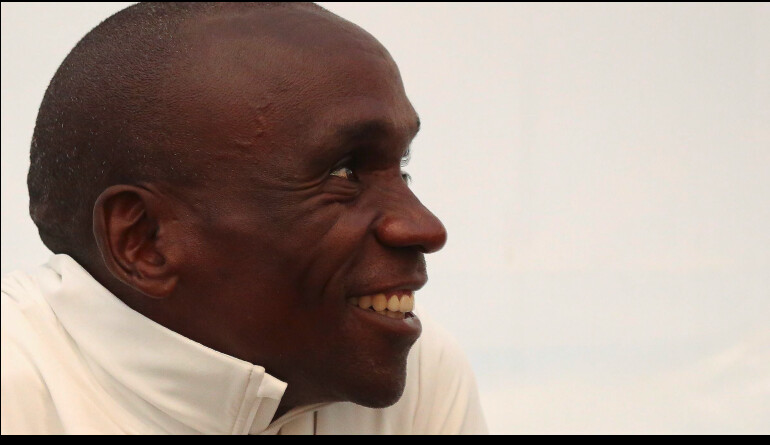
Not only for himself, but especially for those who have come after him. That includes everyone, both elite and recreational runners, who are preparing a marathon this fall or some distant point in the future. His current 2:01:09 world record and his barrier-breaking 1:59:40 time-trial effort in 2019 are legendary feats, both for the current generation of runners and for all time.
The 38-year-old Kenyan marathoner is a once-in-a-lifetime athlete, but time waits for no one, and especially not a long-distance runner. Like all elite athletes, his time at the top is limited, but fortunately, there is still time to immerse in the inspirational examples he’s providing.
Kipchoge recently announced he’ll return to the Berlin Marathon on September 24, where, last year, he won the race for the fourth time and lowered the world record for the second time. It is most likely what will be the beginning of a grand denouement as he goes for another gold medal at the 2024 Olympics next summer in Paris.
Given that he won his first global medal in the City of Light—when, at the age of 18, he outran Moroccan legend Hicham El Guerrouj and Ethiopian legend-in-the-making Kenenisa Bekele to win the 5,000-meter run at the 2003 world championships—it would certainly be one of the greatest stories ever told if he could win the Olympic marathon there next year when he’s nearly 40.
Certainly he’ll run a few more races after the Olympics—and maybe through the 2028 Olympics in Los Angeles—but, realistically, it is the start of a farewell tour for a runner who will never be forgotten.
Don’t get me wrong: I’m not at all writing Kipchoge off. In fact, I am excited to see him run in Berlin and can’t wait to watch next year’s Olympic marathon unfold. But just as we’ve watched Michael Jordan, Tiger Woods, Serena Williams, Shalane Flanagan, Usain Bolt, Allyson Felix, and other elite athletes succumb to the sunsetting of their peak performance level, so too will Kipchoge eventually suffer the same fate.
What I’m saying here is that we still have time to watch and appreciate Kipchoge eloquently working his magic and continue to be inspired in our own running and other pursuits in life. Remember how we marveled at Michael Jordan’s greatest in “The Last Dance” more than 20 years after his heyday? This is the start of the last dance for Kipchoge, who, like Jordan, is much, much more than a generational talent; he’s an all-time great whose legacy will transcend time.
Running has seen many extraordinary stars in the past 50 years who have become iconic figures— Frank Shorter, Joan Benoit Samuelson, Ted Corbitt, Carl Lewis, Steve Jones, Paul Tergat, Catherine Ndereba, Paula Radcliffe, Haile Gebrselassie, Kenenisa Bekele, Mary Keitany, Brigid Kosgei, and Kilian Jornet, to name a few—but none have come close to the body of work and global influence of Kipchoge.
Not only is Kipchoge one of the first African athletes to become a household name and truly command a global audience, but he’s done more than other running champions because of he’s been able to take advantage of this advanced age of digital media to deliberately push positive messages and inspiring content to anyone who is willing to receive it.
Kipchoge has won two Olympic gold medals, set two world records, and won 17 of the 19 marathons he entered, but he’s so much less about the stats and bling and more sharing—to runners and non-runners alike—that “no human is limited” and also that, despite our differences, we’re all human beings faced with a lot of the same challenges in life and, ultimately, hard work and kindness are what put us on the path to success.
How can an average runner who works a nine-to-five job and juggles dozens of other things in daily life be inspired by an elite aerobic machine like Kipchoge?
He is supremely talented, no doubt, but many elite runners have a similar aerobic capacity to allow them to compete on the world stage. What Kipchoge uniquely possesses—and why he’s become the greatest of all-time—is the awareness and ability to be relentless in his pursuit of excellence, and the presence and good will of how beneficial it is to share it.
If you haven’t been following Kipchoge or heard him speak at press conferences or sponsor events, he’s full of genuine wisdom and encouragement that can inspire you in your own running or challenging situation in life. His words come across much more powerfully than most other elite athletes or run-of-the-mill social media influencers, not only because he’s achieved at a higher level than anyone ever has, but because of his genuine interest in sharing the notion that it’s the simplest values—discipline, hard work, consistency, and selflessness—that make the difference in any endeavor.
This is not a suggestion to idolize Kipchoge, but instead to apply his wisdom and determination into the things that challenge you.
“If you want to break through, your mind should be able to control your body. Your mind should be a part of your fitness.”
“Only the disciplined ones in life are free. If you are undisciplined, you are a slave to your moods and your passions.”
“If you believe in something and put it in your mind and heart, it can be realized.”
“The best time to plant a tree was 25 years ago. The second-best time to plant a tree is today.”
Those are among the many simple messages that Kipchoge has lived by, but he also openly professess to giving himself grace to take time for mental and physical rest and recovery. It’s a simple recipe to follow, if you’re chasing your first or fastest marathon, or any tall task in life.
Kipchoge seems to defy age, but his sixth-place finish in the Boston Marathon in April proved he’s human. As much as it was painful to watch him falter, it was oddly refreshing and relatable to see him be something less than exceptional, and especially now that he’s tuning up for Berlin. He has nothing left to prove—to himself, to runners, to the world—but he’s bound to keep doing so just by following the same simple, undaunted regimen he always has.
There will be other young runners who will rise and run faster than Kipchoge and probably very soon. Fellow Kenyan Kelvin Kiptum—who has run 2:01:53 (Valencia) and 2:01:25 (London) in his first two marathons since December—seems to be next in line for Kipchoge’s throne of the world’s greatest runner. But even after that happens, Kipchoge’s name will go down in history alongside the likes of Paavo Nurmi, Abebe Bikila, Emil Zátopek, Grete Waitz, Shorter and Samuelson because of how he changed running and how he gave us a lens to view running without limits.
Berlin is definitely not the end of Kipchoge’s amazing career as the world’s greatest long-distance runner. I fully expect him to win again in an unfathomable time. But the sunset is imminent and, no matter if you are or have ever been an aspiring elite athlete at any level, a committed recreational runner, or just an occasional jogger trying to reap the fruits of consistent exercise, his example is still very tangible and something to behold.
by Outside Online
Login to leave a comment
Shalane Flanagan’s Thai Quinoa Salad is a summer must-make
Shalane Flanagan has mastered the art of fueling on the fly. Flanagan, a four-time Olympian (twice in the marathon) and the 2017 New York City Marathon champion may be retired from professional competition, but she’s still a busy coach for Bowerman Track Club, a mom and co-author of three cookbooks with her friend and former teammate, Elyse Kopecki.
Flanagan has decades of experience in cooking and planning meals that both help her run fast and keep her healthy and energized. This recipe is easy to throw together or prep in advance. I love making a double batch of the dressing and freezing it for next time. While it’s perfect as-is, feel free to add whatever veggies or protein your family enjoys–throwing in a can of chickpeas and/or some chicken gives our household a protein boost when we make this one.

Shalane’s Thai Quinoa Salad
Ingredients
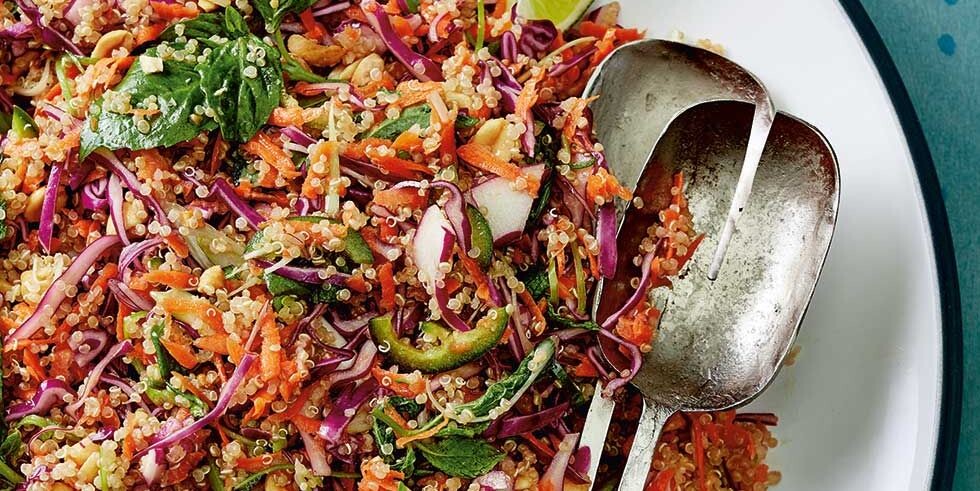
1 cup quinoa, rinsed and drained
2 cups grated carrots (about 2 large)
2 cups thinly sliced purple cabbage
3 green onions, white and green parts sliced
1 cup packed mint or cilantro leaves, chopped
1 cup packed basil leaves, chopped
1 jalapeño pepper, seeds removed and minced (optional)
1/2 cup chopped roasted peanuts
Dressing
1/4 cup extra-virgin olive oil
1/3 cup fresh lime juice
2 Tbsp honey or maple syrup
2 Tbsp soy sauce (tamari works as well)
1 Tbsp fish sauce (optional, remove to make the recipe vegan)
Directions
Cook your quinoa perfectly with Flanagan’s foolproof method: in a medium saucepan over high heat, bring 1 1/2 cups water to a boil with the quinoa. Reduce the heat to low and simmer, covered, for roughly 15 minutes or until all the water is absorbed. Fluff with a fork and transfer to a large salad bowl to cool.
Put the olive oil, lime juice, soy sauce or tamari, honey, and fish sauce in a glass jar and shake or stir until combined.
When the quinoa has cooled, add carrots, cabbage, onion, mint, basil, and pepper to the bowl, toss to combine. Add dressing and mix together. Top with the peanuts, and chill in the fridge for at least an hour before serving.
by Running Magazine
Login to leave a comment
World class racing returns to Boston on Sunday with the BAA 10K
The BAA 10K is this Sunday in Boston. The elites—as well as a mass field of nearly 10,000 runners—will race through the streets of the Back Bay neighborhood.
Emily Sisson has her eyes on another American record; she’s been on a tear the past year on the roads. In October, at the 2022 Chicago Marathon, she took 43 seconds off Keira D’Amato’s American record, running 2:18:29 for second place. Three months later, at the Houston Half Marathon, she broke her own American record, crossing the line in 1:06:52. She’s setting her sights on Shalane Flanagan’s 10K record of 30:52, which Flanagan set at the 2016 edition of the BAA 10K.
Also toeing the line is Molly Seidel, who’s been running some shorter races to prepare for a fall marathon. In February, she finished eighth at the U.S. Half Marathon Championships in 1:13:08.
A slew of former Boston Marathon champions are also competing on Sunday. Hellen Obiri, who won April’s race, will line up next to two-time champion Edna Kiplagat and 2015 winner Caroline Rotich. The course record of 30:36 could be up for grabs.
The men’s field is highlighted by 2021 Boston Marathon champion Benson Kipruto, who won the BAA 10K in 2018. American Leonard Korir returns as the race’s reigning champion, taking last year’s win in 28:00—12 seconds off the American record of 27:48 that has stood since 1985. Gabriel Geay, Geoffrey Koech, and Tsegay Kidanu should also be in contention.
Those in the Boston area can catch coverage of the race on WCVB. The BAA Racing App will also provide live updates and results, but there is no stream of the race. The elites are scheduled to start at 8 a.m. ET.
by Runner's World
Login to leave a comment
B.A.A. 10K
The 6.2-mile course is a scenic tour through Boston's Back Bay. Notable neighborhoods and attractions include the legendary Bull and Finch Pub, after which the television series "Cheers" was developed, the campus of Boston University, and trendy Kenmore Square. ...
more...Kara Goucher’s Book Offers Rare Insight Into Elite Athlete Contracts
Confidentiality clauses usually stop runners from talking about their endorsement deals.Kara Goucher’s memoir about her career in professional running, The Longest Race, alleges shocking behavior by her longtime coach, Alberto Salazar, and how she overcame it. But a subplot throughout the book is how much money she was earning in the sport along the way.
Goucher is open about her contract with Nike and appearance fees at races, including the New York City Marathon, the Boston Marathon, and the Great North Run in the U.K. (Nike did not respond to an email from Runner’s World seeking comment.) Even though the deals are from 10 to 20 years ago, they provide an interesting look at the business side of professional running. It’s a rare peek, too, because sponsor contracts are bound by confidentiality clauses and, in many cases, those clauses extend beyond the term of the contract.
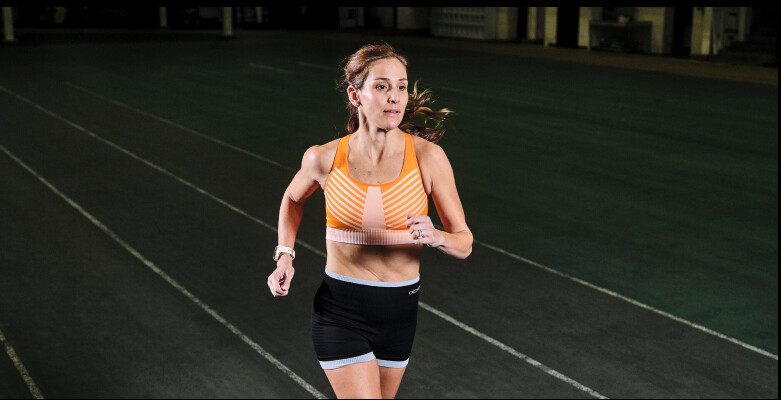
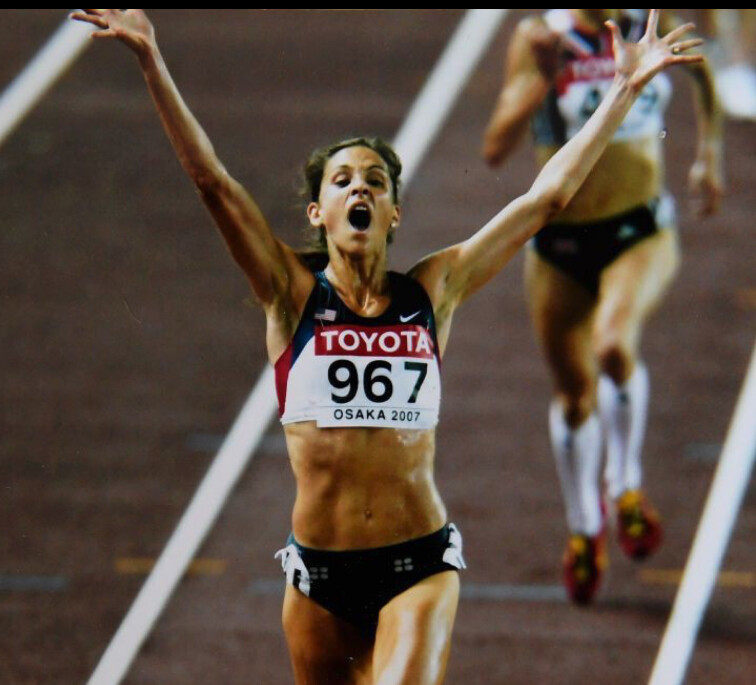
Goucher’s did, but she decided to reveal the information anyway—to be helpful to other athletes. “I just felt like it was very important to have those numbers in there,” she said in a phone call with Runner’s World. “How do you know what to ask for if you have no idea what anyone else is getting paid?” Here’s what we learned about Goucher’s pay and that of her husband, Adam Goucher, from the book:
In 2000, Adam Goucher was making a base payment of $50,000 from Fila, his first sponsor. In his first year, he ran so well that he earned $185,000 with bonuses. Goucher writes that the pay was a “welcome windfall that helped him pay off student loans.”
In 2001, Kara Goucher signed a four-year deal with Nike for $35,000 per year. This was her first professional contract after she graduated from the University of Colorado.
In 2003, Adam Goucher signed with Nike with a base pay of $90,000 per year. The Longest Race: Inside the Secret World of Abuse, Doping, and Deception on Nike's Elite Running TeamIn the fall of 2007, she ran the Great North Run, a half marathon in Newcastle, England. The race director paid her an appearance fee of $13,000 and made a deal with Goucher’s agent at the time, Peter Stubbs, to pay her $30,000 if she won. The money was “not far off the annual salary I had lived on for years,” Goucher wrote. She won the race.
In February 2008, Goucher signed a new Nike deal that paid her $325,000 per year for four years, with an option for Nike to extend to a fifth year. The contract included performance bonuses ranging from $10,000 to $500,000 for an Olympic gold medal. There were also reductions, which could cut her pay. She had to race 10 USATF-sanctioned events per year, and if she ended the year ranked lower than third in her event in the U.S. or out of the top 10 in the world, Nike could dock her pay.
Goucher told Runner’s World that, for her second shoe deal, she asked her agent to accept a commission of 8 percent for each year of the deal. The industry standard is 15 percent. He agreed. She continued to pay him 15 percent on her appearance fees and prize money. She also made sure that she was paid directly by Nike and then she paid her agent. (In most cases these days, the shoe company pays the agent, who then pays the athletes, because it’s less paperwork for the shoe company, having to deal with individual athletes.)
In November 2008, Goucher made her marathon debut at the New York City Marathon. She earned an appearance fee of $175,000. Nike also paid her bonuses paid on based on her place and time, but Goucher didn’t disclose those. She wrote, “One good marathon and I could easily walk away with more than my yearly contract salary.” In April 2009, Goucher ran the Boston Marathon, which, at the time, traditionally paid less in appearance fees to athletes than New York. (It is also the only major marathon in the U.S. in the spring.) Her appearance fee was $80,000, but when she learned another American, a male runner, was making $85,000, she asked the BAA to match that. Race organizers agreed.
In early 2010, Goucher learned she was pregnant with her son, Colt. Salazar confirmed with Nike executive John Capriotti on Goucher’s behalf that Goucher wouldn’t suffer a reduction in her pay as long as she remained “relevant,” she wrote. Her first of four quarterly payments from Nike arrived on time in January, as did her second in April. But in July, her accountant told her that her payment hadn’t arrived. Nor did her October payment.
This set off a lengthy battle between Goucher and Nike over money during her pregnancy. Ultimately, Nike docked her pay for six months and extended her contract to the end of 2013.
At the end of 2010, Adam Goucher’s contract with Nike ended.
In 2011, USA Track & Field (USATF) said it would be dropping the Gouchers’ health insurance, because her marathon ranking had dropped while she was pregnant. She appealed the decision, and the U.S. Olympic Committee stepped in and reinstated the health insurance. This rule has subsequently been changed—pregnant athletes can keep their health insurance—and today’s runners laud that change.
At the end of September 2011, Goucher left the Nike Oregon Project. She remained under contract with Nike and stayed in Portland, Oregon. Jerry Schumacher coached her, and she trained with Shalane Flanagan.
At the end of 2013, Goucher scrambled to race 10 times so Nike wouldn’t suspend her pay again. She ran a turkey trot to fulfill her obligations (and won a pie). Her contract with Nike ended at the end of the year, and she and Adam sold their house in Portland and moved to Boulder, Colorado.
In 2014, Goucher entertained contract offers from other companies, although Nike still had the option to match any offers. Saucony offered her $1 million total over 5 years, with bonuses and no reductions. Ultimately, she chose to sign with women’s clothing brand Oiselle for $20,000 per year, and a 2 percent stake in the company. She signed a separate deal for footwear with Skechers.
Today, Goucher encourages athletes to speak up and not be afraid to rock the boat, especially those who are lower-paid. She faults the secrecy around pay in track and field with creating difficult situations. It’s required to agree to the confidentiality clause in contracts in order to secure the deal, she said, and in some cases, that gives cover to companies that underpay talented athletes. The confidentiality clause “only harms the athlete and protects the brand,” she said. “Because then they can continue to pay you the least amount possible.”
Agent Hawi Keflezighi, who has never worked with Goucher, agreed with her assessment. “I think there are a lot of very bad contracts out there that footwear brands would probably be embarrassed to admit to,” he said. “There are some really bad deals out there that would probably create a backlash.”
by Runner’s World
Login to leave a comment
The Boston Marathon has never been easy, that’s why Des Linden keeps coming back
The conditions were wretched when Des Linden first toed the starting line in Hopkinton in 2007. An amped-up nor’easter brought rain, a 30-mile-per-hour headwind, and soggy, chilly misery for the runners.
“I was one probably of the few people who felt, that was one of the best things I’ve ever done,” Linden recalled years later. “I’m going to do this forever. I loved it.”
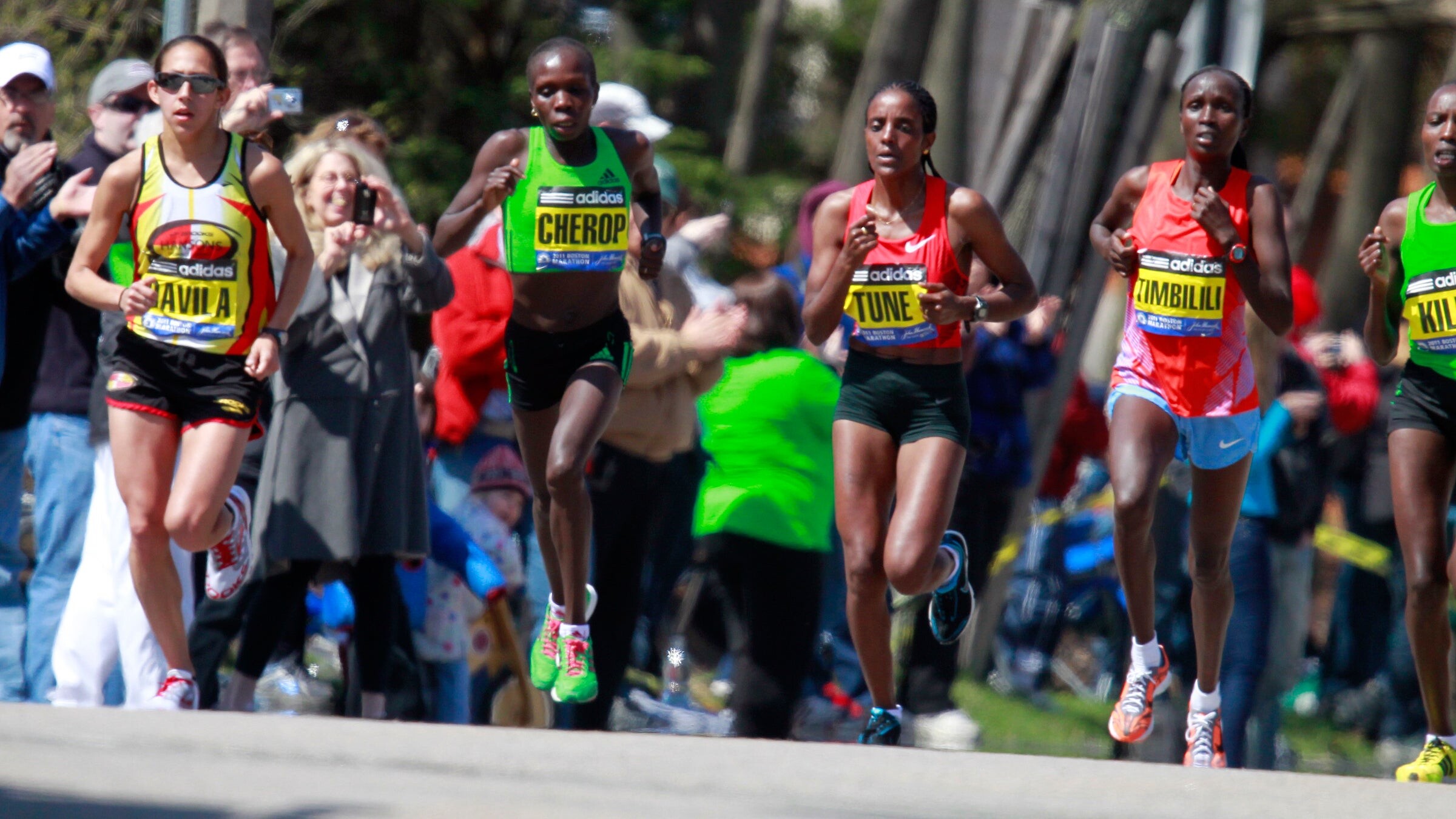
On Patriots Day Linden will lace up for her 10th Boston Marathon. During the 16 years since her first appearance here, which also was her 26-mile debut, Linden has won the laurel wreath (”storybook stuff”), lost by two seconds on a sprint down Boylston Street, finished fourth twice, and 17th in a “total suffer-fest.”
Every trip here is a homecoming, said the California native and Michigan resident who has a dog named Boston. What brings Linden back is the race’s incomparable history, the feeling of family that she gets from the Boston Athletic Association, the exuberant crowds along the course, “the greatest finish line in our sport,” and the unchanging challenge from the lumpy layout and mercurial weather.
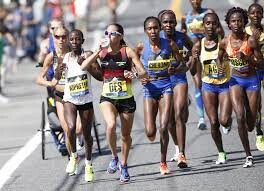
“We’re in this era where we want the marathon to be easier than ever before,” said Linden. “We want it faster, we want it flatter, we want wind blockers, we want shoes that bounce you forward, we want better gels. You name it, we’re trying to dumb this thing down. Boston is already not going to manage well with a lot of those things, then you throw in the weather conditions. I’ll take the tough one every time.”
Boston never has been easy. For decades there were no mile markers or water on the course. There was no prize money until 1986 — the reward was a medal and a bowl of canned beef stew. The starter fired the gun and sent you off. If you ended up sitting on the curb, cramped and blistered, the “meat wagon” picked you up.
Linden loves the purity of a race that always has the same course but rarely the same conditions. “A lot of people get surprised by it,” she said. “Well, it’s Boston in the spring.”
Boston is the recurring theme of “Choosing To Run,” Linden’s new memoir written with Bonnie D. Ford. Chapters recounting her 2018 triumph, the first by an American woman here in 33 years, are interspersed with a narrative of her evolution from a track racer to a marathoner.
Linden, who’ll officially become a master when she turns 40 in late July, is in the final stretch of her elite career, which she hopes will include a third Olympic team next year in Paris. Maybe she’ll run a fall marathon to prep for the Orlando trials in February. “Or maybe I just spin the legs and do some fast stuff,” she mused.
At this stage of her career it’s all about being smart and patient. “It’s a challenge letting go of your prime years, but there’s also a reality to it,” Linden said. “It’s recalibrating and readjusting what the goal is. I’m learning.”
One significant concession is her weekly mileage, which Linden has reduced from 120 to between 95 and 105. “I have this mentality that I’m being lazy if I’m not doing 115-120-mile weeks,” she said. “ ‘You’re not being lazy,’ my coach [Walt Drenth] said. ‘It’s just not practical.’ ”
At her age, maintaining speed and power are more important than training volume. “So work on what’s going away,” Linden said, “and rely on what you’ve done in the past as far as the volume goes.”
The lighter workload paid dividends at the recent New York City Half Marathon, where she placed fifth in 1 hour, 12 minutes, 21 seconds, the top American finisher. “It was the first time in a while that I got good momentum from a race,” she said.
Up against a stacked Boston field that includes Gotytom Gebreslase and Lonah Salpeter, the world gold and bronze medalists; two-time Boston victor Edna Kiplagat; returning medalists Ababel Yeshaneh and Mary Ngugi; two-time Olympic track medalist Hellen Obiri; and Amane Beriso, a sub-2:15er, Linden is realistic about her chances.
“Top 10 is a great goal at times and particularly this year — the field’s incredible,” said Linden, who was 13th last year. “Just mixing it up and racing is fun for me.”
At this point in her career Linden has little left to chase. She was seventh in the 2016 Olympics, cracked the top 10 at the 2009 world championships, and has posted top-five efforts in New York, Chicago, and Berlin.
But her crowning achievement came in Boston five years ago when she slogged her way through punishing wind and chilly rain to win a race that she didn’t plan on finishing. “It’s not gonna be my day,” Linden told Shalane Flanagan after 6 miles. “I think I’m going to drop out soon.”
But she pushed on, thinking more about survival than victory. “I was running in fear for most of the race,” Linden said. “Even halfway through Boylston I was thinking, if someone comes up on my shoulder I know I can respond.”
She won by more than four minutes, to her astonishment. Linden’s jacket and headband were added to the BAA memorabilia collection, whose artifacts date from the 19th century. “The same museum I had once viewed as an unattainable sanctum,” she wrote in “Choosing To Run.”
Gloria Ratti, the BAA’s longtime first lady, had given Linden the tour before her 2007 debut. That, she said, “made me fall in love with 26.2.”
“Everyone talks about Boston’s special history,” Linden said. “You can feel it on the course, you can see it on race day. But to have that collection of the very first medals and the shoes that were being worn … ”
by John Powers
Login to leave a comment
Boston Marathon
Among the nation’s oldest athletic clubs, the B.A.A. was established in 1887, and, in 1896, more than half of the U.S. Olympic Team at the first modern games was composed of B.A.A. club members. The Olympic Games provided the inspiration for the first Boston Marathon, which culminated the B.A.A. Games on April 19, 1897. John J. McDermott emerged from a...
more...Plant-based runners: speedy grab-and-go meal ideas
Interested in eating plant-based but struggling to find simple, quick meals that are full of nutrition while still easy on the budget? The authors of Plant-Based Sports Nutrition have some tips and tricks for you.
Both registered dietitians, authors Dr. Enette Larson-Meyer and Matt Ruscigno suggest planning in advance as key to maintaining high-performance plant-based nutrition. Reading labels is important–with the many new plant-based alternatives to meat and cheese, it can be tempting to purchase whatever looks appealing. Check iron, protein, fat and calcium content, and look for options that have the equivalent nutritional composition of the products they’re replacing.

Larson-Meyer and Ruscigno also suggest adding a salad to any meal, with fresh and dried fruit tossed in to add both a diverse array of nutrients (calcium, vitamin C, vitamin E, iron, zinc, etc.) as well as carbohydrates. Adding nuts, beans or cheese (provided you’re not strictly vegan) can boost healthy fat and protein, as well.
It can be challenging enough to squeeze in a run alongside all the other things you may do in a day. Eliminate some of the stress by trying some of these quick make-and-take breakfast and lunch options.

Grab-and-go breakfasts
Have some fresh or dried fruit in reusable containers on hand, and grab one of the following to make your morning ridiculously simple.
Homemade muffins made with grapeseed or canola oil and whole grains (try Shalane Flanagan’s recipe here)
Whole-grain toasted English muffin with low-trans-fat margarine or nut butter and jam
Dairy or soy yogurt, fruit and granola parfait (made the night before in a to-go container)
Breakfast cookies (make your favourite oatmeal cookies with half the sugar, orange juice as the liquid, and add dried fruit, nuts and ground flaxseed)
Quick portable lunches
Pack fresh fruit or veggies and/or whole-grain crackers or whole-wheat pretzels along with one of these easy-to-throw-together lunches and some healthy cookies.
Tomato, avocado, and sprouts on a whole-grain bagel
Black beans, lettuce, avocado and salsa in a spinach or whole-wheat roll-up
Black-eyed-peas spread (1 can beans, 1/2 cup parsley, 2 Tbsp olive oil, 2 Tbsp lemon juice, 1/2 tsp tarragon, garlic and pepper to taste) on flatbread or in a whole-wheat wrap
Dark leafy greens in a pita with chickpeas, kidney beans or white beans, and dressing of choice
Peanut butter, sliced banana, raisins and walnuts on whole-wheat bread
Red-pepper bean spread (1 cup white beans, 2 tsp finely chopped roasted sweet peppers, 1 tsp finely chopped scallions) on foccacia or flatbread
If you decide to maintain a plant-based diet for the long haul, keep your menu exciting by trying new foods and learning about nutrition. Once you nail the basics, planning nutritionally-balanced meals will become as much a part of your routine as training, and can be an enjoyable, easy part of your day.
by Keeley Milne
Login to leave a comment
Shalane Flanagan’s stir-fry recipe: a ‘choose your own adventure’ meal
Every household should have an easy, quick stir-fry to whip up on busy days, and Shalane Flanagan‘s recipe, packed with veggies of your choice, is versatile and easy to match the tastes you’re cooking for.
Flanagan, a four-time Olympian (twice in the marathon) and the 2017 New York City Marathon champion, may be retired from professional competition, but she’s still a busy coach for Bowerman Track Club, a mom, and co-author of three cookbooks with her former teammate and friend, Elyse Kopecki.

Flanagan says her family counts on a weekly stir-fry to use up what they have at home and suggests: “choose your own adventure, but aim for a range of colors to max out nutrition potential.”
Shalane and Elyse’s Eat the Rainbow Stir-Fry

Ingredients (marinade)
8 ounces skinless chicken, chopped
2 Tbsp soy sauce
1 Tbsp lime juice
2 Tbsp honey
1 Tbsp minced garlic and/or ginger
Veggies
2 Tbsp high-heat oil (like sesame, avocado or safflower oil)
1/2 large or 1 small onion, sliced
2 heaping cups chopped hard vegetables (broccoli, carrots, celery)
1 heaping cup sliced soft vegetables (snap peas, bell pepper, cabbage, box choy, mushrooms)
Directions
Place the chicken, soy sauce, lime juice and honey in a quart-size zipper bag and shake to combine. Leave out for 20 minutes to allow meat to marinate and come up to room temperature (for even more meat flavour, marinate overnight in the fridge).
Heat a wok or high-sided sauté pan over high heat. Add the oil, onion and hard vegetables. Cook, stirring frequently until the veggies begin to brown–about five minutes.
Turn the heat down to medium-high, add the soft vegetables, and sauté for about two minutes. Add the chicken with the marinade and sauté, stirring occasionally, until the chicken is cooked through, about five minutes.
Use a clean spoon to serve on top of brown rice or quinoa (or noodles) and drizzle with your favourite sauce, like sriracha or peanut sauce.
Flanagan’s tips: Prep all the veggies before frying, and chop veggies to similar sizes so that they cook evenly. Cook hard vegetables first, and moisture-rick ingredients last, and make sure your pan is really hot (and keep it hot). Don’t walk away: stir-frying means quick cooking over high heat with frequent stirring.
by Running Magazine
Login to leave a comment
Questions Arise About Selection of 2024 Olympic Marathon Trials Site
The USATF national office overrode a recommendation from its board of directors that Chattanooga host the Trials.
Despite a recommendation from the USA Track & Field (USATF) board of directors that Chattanooga be named the host city for the 2024 Olympic Marathon Trials, the city will not host the event. Instead, Orlando, the only other city to bid on the Trials, was named as the host city.
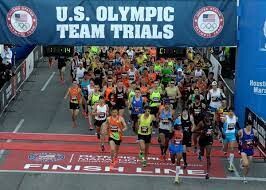
According to minutes from the October 9 USATF board meeting held in Miami Beach, recently posted to USATF’s website, the board issued “an advisory vote of approval for the 2024 USATF U.S. Olympic Trials - Marathon bid to be awarded to Chattanooga, Tennessee. Final approval still remains with the USATF National Office.”
The vote was unanimously carried with one abstention. But the national office announced on November 8 that Orlando would be getting the nod.
Runner’s World asked USATF spokesperson Natalie Uhl and CEO Max Siegel for clarification on why the national office overrode the board of directors. Uhl referred questions on the matter to Mike Conley, the chairman of the board of directors.
Conley wrote in an email to Runner’s World, “The [United States Olympic & Paralympic Committee] is looking into the matter and until I hear back from them I have no comment.”
The USOPC was unable to provide comment to Runner’s World immediately, but a spokesman said he would do so at a later time.
Multiple sources told Runner’s World both Orlando and Chattanooga performed well at site visits. But late in the selection process, after the board vote, Chattanooga’s bid was disqualified.
Neither USATF nor Conley would confirm that Chattanooga was disqualified nor explain why.
A board member, Jim Estes, had been involved as an advisor on Chattanooga’s bid. Estes had disclosed the relationship from the beginning—board members and other volunteers with USATF are required to file conflict of interest forms and keep them up to date—and Estes recused himself from voting on anything related to the Olympic Marathon Trials. His recusal is noted in the meeting minutes.
According to his LinkedIn profile, Estes previously worked in the USATF national office in Indianapolis for almost 12 years, from 2005 to 2016. For the last four, he was the director of events. He is now a consultant for events in the running industry.
Estes declined to comment to Runner’s World. The chief sports officer at the Chattanooga Sports Commission, Tim Morgan, was directing Chattanooga’s bid for the Trials. He did not return multiple calls and messages requesting comment.
The board bases its vote on recommendations from members of the men’s and women’s long distance running committees, volunteers who visit potential sites and evaluate the bids for what will help produce the strongest Olympic team and be best for the athletes.
At a November virtual meeting of USATF’s board of directors, the topic of the bid for the Olympic Marathon Trials came up again. But the discussion was held in executive session, meaning that what was discussed remains private. The executive session lasted for 15 minutes. Again, Estes recused himself from the session.
A similar disagreement marred the selection of the 2016 Olympic Marathon Trials. For that event, the men’s and women’s long distance running committees recommended that the Trials return to Houston, which had staged a successful Trials in 2012. Siegel overrode that decision and decided the Trials should be in Los Angeles, a larger media market.
That race in Los Angeles went off in warm conditions. February temperatures reached into the mid-70s, and several athletes struggled in the heat, with many claiming inadequate fluids on the course. For the men, Galen Rupp, Meb Keflezighi, and Jared Ward made the team. On the women’s side, Amy Cragg and Des Linden finished first and second, and Shalane Flanagan collapsed at the finish line in third place.
USATF is facing scrutiny about other administrative matters. In November, when the nonprofit organization’s most recent tax forms were made public, it showed Siegel had a total compensation package of $3.8 million in 2021. The chief operating officer, Renee Washington, made more than $1.6 million. Together, those two salaries represented more than 16 percent of the organization’s revenues.
Earlier this month, heptathlete Taliyah Brooks filed a lawsuit against USATF for failing to reschedule the heptathlon during extreme heat at the 2021 Olympic Track and Field Trials.
by Runner’s World
Login to leave a comment
Who Wore Which Shoes at the New York City Marathon?
The running shoe hype train was high in New York City with a few fast yet-to-be-released shoes in the men’s and women’s elite fields.
For a few miles early in the New York City Marathon, Desi Linden surged into the lead of the women’s elite field. The two-time Olympian and 2018 Boston Marathon champion didn’t think she’d run away and win the race that way, but she was just trying to keep the pace honest.

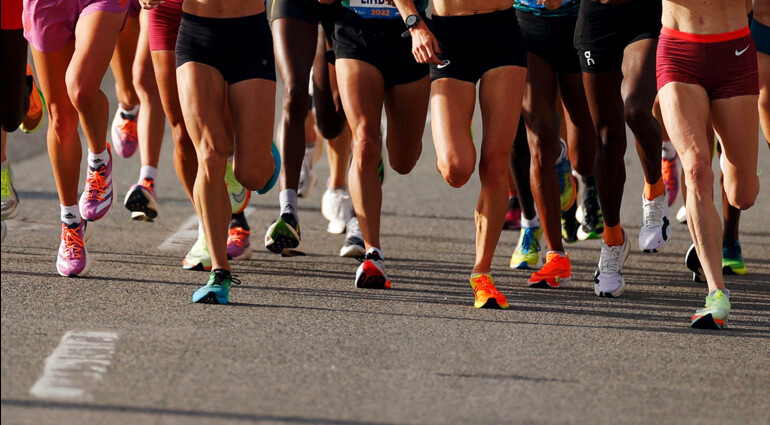
However, hiding in plain sight on her feet as she was off the front of the pack was a yet-to-be-released pair of orange, white and black Brooks prototype racing shoes. A day later, no one is willing to give up any details of the shoe, except that, like all of the other top-tier racing shoes in both the men’s and women’s elite fields, it features a carbon plate embedded in a hyper-responsive foam midsole. And although it’s all in accordance with World Athletics regulations, it won’t be released in Spring 2024 … so we’ll all have to wait a bit to see what that shoe is all about.
Linden’s shoes weren’t the only speedy outliers among the top 25 men’s and women’s finishers. While Nike, Adidas and ASICS shoes were the most prevalent brands among elite runners, there were several shoes that aren’t yet available to the public.
For example, the first runner to cross the finish line of this year’s New York City Marathon, women’s winner Sharon Lokedi, was wearing a pair of Under Armour Velociti Elite shoes. That’s notable for several reasons—because it was Lokedi’s first marathon, because the shoe won’t become available until early 2023 and because it’s the first podium finish at a major international marathon for a runner wearing Under Armour shoes.
There were also three pairs of yet-to-be-released Hoka Rocket X 2 shoes on the feet of three Hoka NAZ Elite runners — two of whom set new personal best times, Aliphine Tuliamuk (7th, 2:26:18) Matthew Baxter (12th, 2:17:15). Those fluorescent yellow shoes with orange, white and blue accents and blue laces were on the feet of Hoka pros at the Boston Marathon in April and Ironman World Championships in Hawaii in October, but they won’t be released to the public until late February or early March.
Meanwhile, the winner of the men’s race, Evans Chebet, was wearing a pair of Adidas Adizero Adios Pro 3, a shoe worn by four other runners in the top 25 of the men’s race and six among the women’s top 25, making it the second most prevalent model among the elites. Oddly, that was the same shoe worn by Brazil’s Daniel do Nascimento, who went out at record-setting sub-2:03 pace on his own, only to crumple to the ground at mile 21 after succumbing to fatigue and cramping.
The most common shoe among the top finishers was the Nike ZoomX Vaporfly Next% 2, which was on the feet of 11 of the 50 runners among the women’s and men’s top 25 finishers. There were eight runners wearing either the first or second version of the ASICS MetaSpeed Sky.
Six runners wore Nike Air Zoom Alphafly Flyknit shoes, three wore Nike Air Zoom Alphalfy NEXT% 2. There were two pairs of On Cloudboom Echo 3 in the field, including those worn by Hellen Obiri who finished sixth while running a 2:25:49 in her marathon debut, while three runners wore Puma Fast R Nitro Elite.
And what about actor Ashton Kutcher? He wore a pair of purple Nike Air Zoom Alphafly NEXT% Flyknit shoes and finished in a very respectable 3:54:01.
Matt James, the former lead of the Bachelor, finished in 3:46:45 with Shalane Flanagan as his guide wearing a pair of New Balance FuelCell Comp Trainer shoes. Flanagan wore Nike Air Zoom Alphafly Next% Flyknit shoes, as did Meghan Duggan, an Olympic gold medalist hockey player who ran a solid 3:52:03. Lauren Ridloff, actress from “The Walking Dead,” ran in a pair of Brooks Glycerin 20 and finished in 4:05:48, while Chelsea Clinton, daughter of Bill and Hillary Clinton finished in 4:20:34 wearing a pair of Brooks Ghost 14 and Tommy Rivers Puzey (aka “Tommy Rivs,” a former elite runner who survived a deadly bout of cancer in 2020, wore a pair of Craft CTM Ultra Carbon Race Rebel and finished in 6:13:54.
Here’s a rundown of what was on the feet of the top 25 women’s and men’s finishers in the Big Apple.
1. Sharon Lokedi (Kenya) 2:23:23 — Under Armour Velociti Elite
2. Lonah Salpeter (Israel) 2:23:30 — Nike ZoomX Vaporfly Next% 2
3. Gotytom Gebreslase (Ethiopia) 2:23:39 – Nike ZoomX Vaporfly Next% 2
4. Edna Kiplagat (Kenya) 2:24:16 — Nike ZoomX Vaporfly Next% 2
5. Viola Cheptoo (Kenya) 2:25:34 — Adidas Adizero Adios Pro 3
6. Hellen Obiri (Kenya) 2:25:49 — On Cloudboom Echo 3
7. Aliphine Tuliamuk (USA) 2:26:18 — Hoka Rocket X 2
8. Emma Bates (USA) 2:26:53 — ASICS MetaSpeed Sky+
9. Jessica Stenson (Australia) 2:27:27 – ASICS MetaSpeed Sky
10. Nell Rojas (USA) 2:28:32 — Nike Air Zoom Alphafly Flyknit
11. Lindsay Flanagan (USA) 2:29:28 – ASICS MetaSpeed Sky
12. Gerda Steyn (South Africa) 2:30:22 — Adidas Adizero Adios Pro 3
13. Stephanie Bruce (USA) 2:30:34 — Hoka Rocket X 2
14. Caroline Rotich (Kenya) 2:30:59 — ASICS MetaSpeed Sky+
15. Keira D’Amato (USA) 2:31:31 — Nike Air Zoom Alphafly Flyknit
16. Des Linden (USA) 2:32:37 — Brooks Prototype
17. Mao Uesugi (Japan) 2:32:56 — Adidas Adizero Adios Pro 3
18. Eloise Wellings (Australia) 2:34:50 — Adidas Adizero Adios Pro 3
19. Sarah Pagano (USA) 2:35:03 — Adidas Adizero Adios Pro 3
20. Grace Kahura (Kenya) 2:35:32 — Nike ZoomX Vaporfly Next% 2
21. Annie Frisbie (USA) 2:35:35 — Puma Fast R Nitro Elite
22. Molly Grabill (USA) 2:39:45 — Nike Air Zoom Alphafly NEXT% Flyknit
23. Kayla Lampe (USA) 2:40:42 — ASICS MetaSpeed Sky+
24. Maegan Krifchin (USA) 2:40:52 — Adidas Adizero Adios Pro 3
25. Roberta Groner (USA) 2:43:06 — Nike Air Zoom Alphafly NEXT% 2
1. Evans Chebet (Kenya) 2:08:41 — Adidas Adizero Adios Pro 3
2. Shura Kitata (Ethiopia) 2:08:54 — Nike ZoomX Vaporfly Next% 2
3. Abdi Nageeye (Netherlands) 2:10:31 — Nike ZoomX Vaporfly Next% 2
4. Mohamed El Aaraby (Morocco) 2:11:00 — ASICS MetaSpeed Sky+
5. Suguru Osako (Japan) 2:11:31 — Nike ZoomX Vaporfly Next% 2
6. Tetsuya Yoroizaka (Japan) 2:12:12 — Nike ZoomX Vaporfly Next% 2
7. Albert Korir (Kenya) 2:13:27 — Adidas Adizero Adios Pro 3
8. Daniele Meucci (Italy) 2:13:29 — ASICS MetaSpeed Sky+
9. Scott Fauble (USA) 2:13:35 — Nike Air Zoom Alphafly NEXT% 2
10. Reed Fischer (USA) 2:15:23 — Adidas Adizero Adios Pro 3
11. Jared Ward (USA) 2:17:09 — Saucony Endorphin Pro 3
12. Matthew Baxter (New Zealand) 2:17:15 — Hoka Rocket X 2
13. Leonard Korir (USA) 2:17:29 — Nike ZoomX Vaporfly Next% 2
14. Matthew Llano (USA) 2:20:04 — Under Armour Velociti Elite
15. Olivier Irabaruta (Burundi) 2:20:14 — On Cloudboom Echo 3
16. Hendrik Pfeiffer (Germany) 2:22:31 — Puma Fast R Nitro Elite
17. Jonas Hampton (USA) 2:22:58 — Adidas Adizero Adios Pro 3
18. Alberto Mena (USA) 2:23:10 — Nike ZoomX Vaporfly Next% 2
19. Jacob Shiohira (USA) 2:23:33 — Nike Air Zoom Alphafly Flyknit
20. Edward Mulder (USA) 2:23:42 — Nike Air Zoom Alphafly Flyknit
21. Jordan Daniel (USA) 2:24:27 — Nike ZoomX Vaporfly Next% 2
22. Nathan Martin (USA) 2:25:27 — ASICS MetaSpeed Sky+
23. Jeff Thies (USA) 2:25:45 — Nike Air Zoom Alphafly NEXT% 2
24. Shadrack Kipchirchir (USA) 2:28:15 — Puma Fast R Nitro Elite
25. Abi Joseph (USA) 2:29:16 — Nike Air Zoom Alphafly Flyknit
by Outside
Login to leave a comment
Shalane Flanagan's peanut sauce is the perfect topping for pretty much everything
American two-time Olympic marathoner and coach Shalane Flanagan just ran the 2022 New York City Marathon, and we’re guessing she doubled down on a batch of her own peanut sauce post-race.
This recipe, from Flanagan and former teammate Elyse Kopecki’s cookbook Run Fast Eat Slow, is so delicious that I always make at least triple batch (you can freeze leftovers). We use it to top rice and veggies, as a dressing for a big salad, or to dip carrots and broccoli in. Some household members have even, ahem, eaten spoonfuls of it.

Shalane Flanagan’s Runner’s High Peanut Sauce
Ingredients

1 Tbsp coconut oil or extra-virgin olive oil
1 yellow onion, diced
1/2 teaspoon fine sea salt
3 cloves garlic, minced
1 can (13 1/2 ounces) unsweetened coconut milk (preferably full-fat)
1/2 cup unsalted creamy peanut butter
1 Tbsp soy sauce
1 Tbsp coconut sugar (other granulated sugar is fine)
1/2 to 1 tsp red pepper flakes, depending on spice preference
1 Tbsp lime juice
1/4 cup chopped peanuts
Directions
In a medium saucepan over medium-high heat, warm the oil. Add the onion and salt and cook, stirring occasionally, until soft but not brown, about 5 minutes. Add the garlic and cook, stirring frequently, for one minute.
Add coconut milk, peanut butter, soy sauce, sugar, and pepper flakes. Bring to a simmer and whisk until the peanut butter melts. Reduce the heat to low and simmer, uncovered, stirring occasionally, until the sauce thickens and the flavours meld, about 10 minutes. Remove pan from heat and stir in the lime juice.
Using an immersion (stick) blender, if you have one, blend the sauce until smooth. Alternatively, transfer the sauce to a blender and process until the sauce is smooth. (In my household we have cut out the blending step entirely on occasion and the sauce still tastes like bliss).
To serve, fill a bowl with soba noodles or cooked brown rice, add your favourite sautéed veggies, top generously with the sauce, and garnish with the peanuts.
by Keeley Milne
Login to leave a comment
Ashton Kutcher ran well in his New York City Marathon debut
The 2022 NYC Marathon champion, Kenya’s Sharon Lokedi, wasn’t the only runner who had a successful marathon debut in New York City; Hollywood actor Ashton Kutcher led the way for celebrities, smashing his goal of sub-four while raising over a million dollars for his charity, Team Thorn.
The That 70s Show actor, 44, joined 50,000 other athletes to run in the prestigious marathon through the streets of the Big Apple, finishing in 3:54:01. He mentioned to the media before the race that his A goal was to finish and raise one million dollars for Thorn, and his B goal was to break the four-hour barrier.
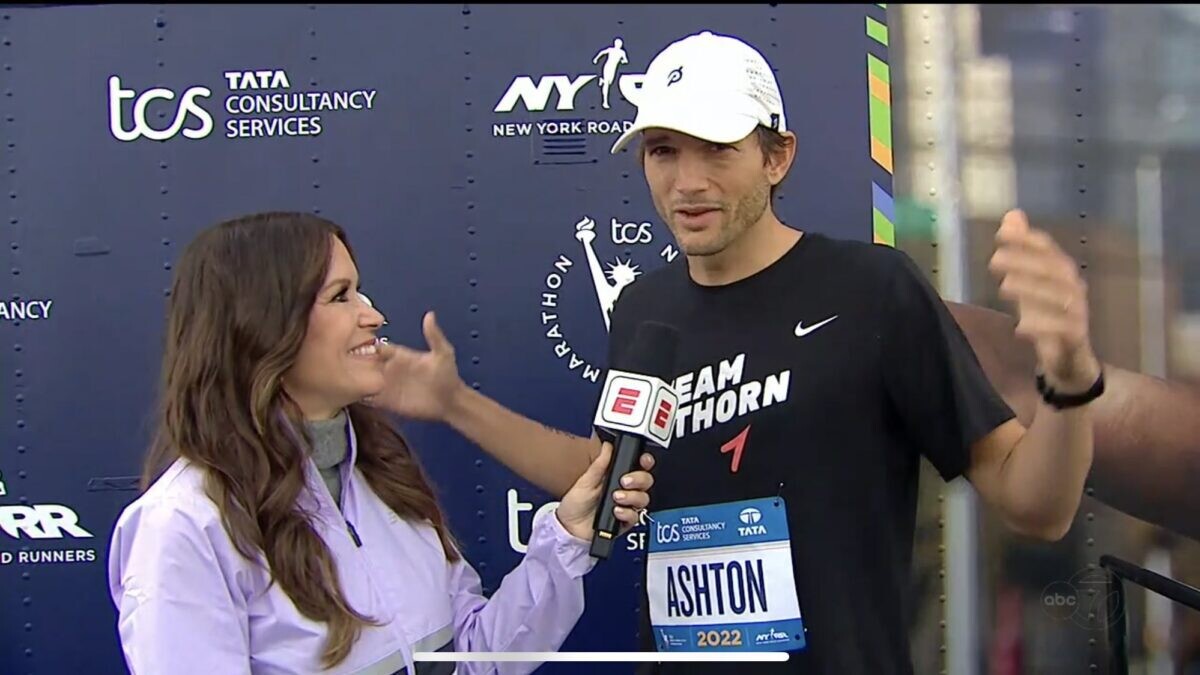
His charity, Thorn, is a non-profit tech company that helps prevent the sexual exploitation of children online.
Kutcher reached the halfway mark in 1:51:19, and in rookie fashion, positively split the second half in 2:02:42. He also relied on some stylish purple and pink Nike Alphafly’s to help his performance.
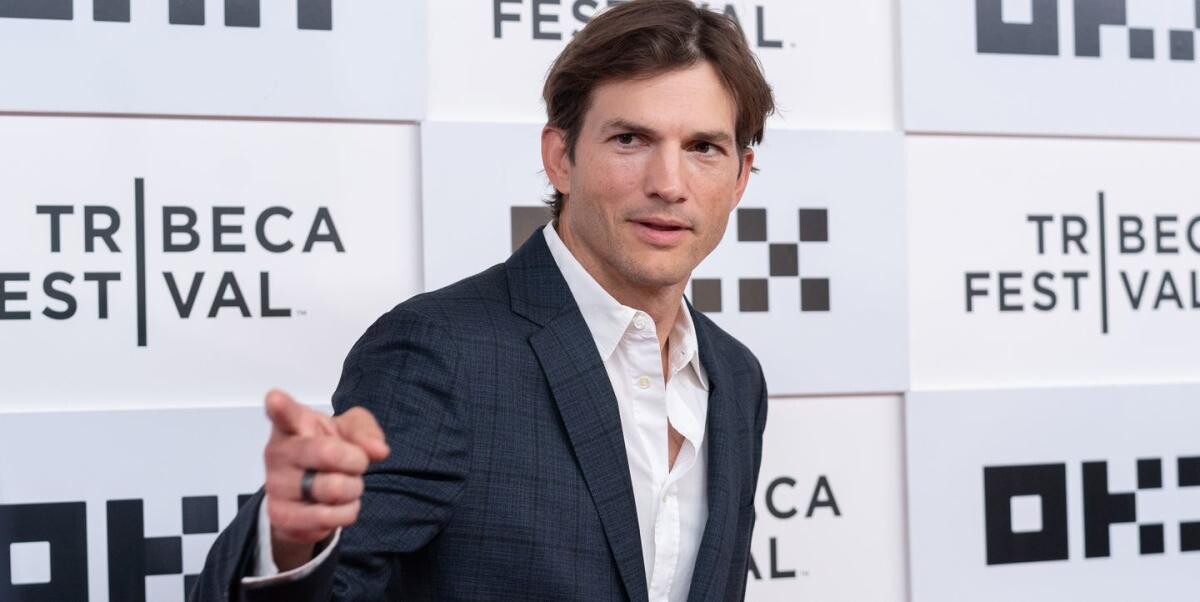
The former star of The Bachelor, Matt James, was the top celebrity finisher in 3:46:45, smashing his previous personal best. James was paced by 2017 NYC champion Shalane Flanagan as the pair went through the halfway mark in 1:29-high and rode the pain train over the final 13 miles.
Meghan Duggan was the only other celebrity to break the four-hour barrier, crossing the finish line in 3:52:06. Duggan is an Olympian who played hockey for Team USA at the 2010, 2014 and 2018 winter Olympics, winning two silvers and a gold. Duggan is currently the director of player development for the New Jersey Devils.
The former first daughter, Chelsea Clinton, returned to the NYC Marathon after making her debut in 2021. Clinton finished the race 20 minutes shy of her previous time, in 4:20:34. Her parents, President Bill Clinton and former Secretary of State Hillary Clinton, were on hand at the finish line to cheer her on as she finished. She ran the race on behalf of a food non-profit charity called City Harvest, which helps the city of New York with food insecurity.
New York Giants former running back Tiki Barber, 47, continued his streak, running his eighth consecutive New York City Marathon. He finished in 5:26:51.
by Marley Dickinson
Login to leave a comment
TCS New York City Marathon
The first New York City Marathon, organized in 1970 by Fred Lebow and Vince Chiappetta, was held entirely in Central Park. Of 127 entrants, only 55 men finished; the sole female entrant dropped out due to illness. Winners were given inexpensive wristwatches and recycled baseball and bowling trophies. The entry fee was $1 and the total event budget...
more...Kenyan Mary Keitany to be inducted into New York Marathon Hall of Fame
Women's only World marathon record holder Mary Keitany will be inducted into the 2022 New York Road Races Hall of Fame in USA on November 4.
The ceremony will come two days before this year's New York Marathon which will take place on November 6.
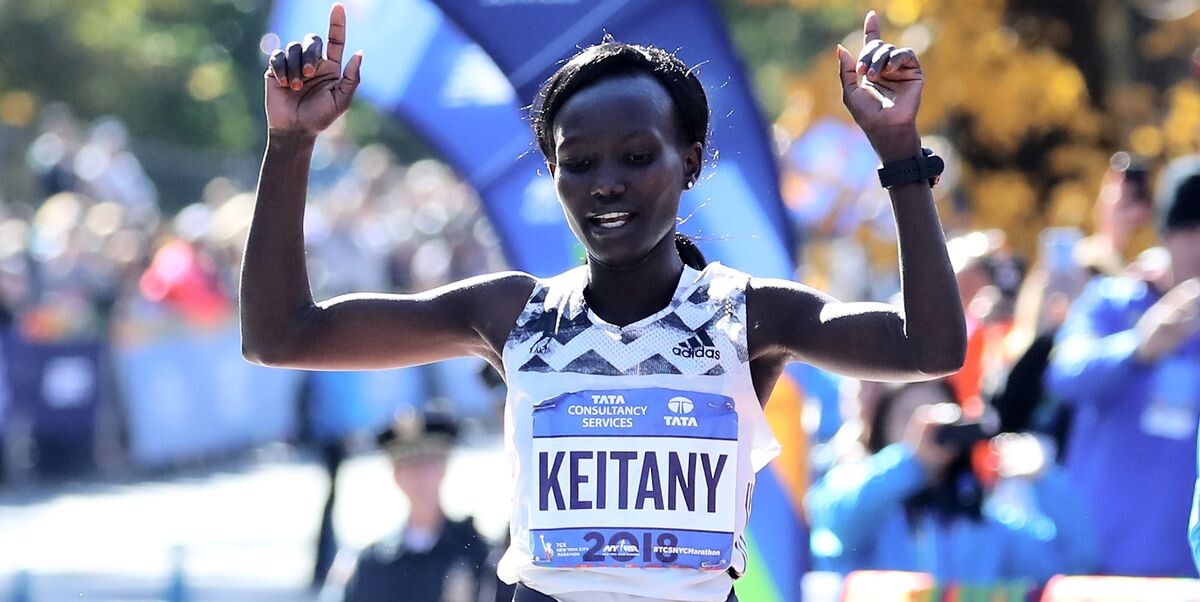
Keitany told Nation Sport that it is a big honour for her to be inducted into the Hall of Fame in New York.
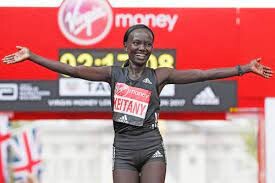
The legendary long distance runner thanked her fans in New York who cheered her on during the races.
“I’m glad I have been listed for the induction into the Hall of Fame. I started my marathon career in New York and after retirement, I’m happy I will be going back to be honoured,” said Keitany.
In her first race in New York in 2010, Keitany was in third place after clocking 2:29:01. She finished third again the following year, but improved her time to 2:23:38.
Keitany went back to New York Marathon in 2014 where won in 2:25:07 before defending her title in the 2015 and 2016 editions.
She finished second in 2017, then reclaimed her title in 2018 before announcing her retirement from road racing after her second place finish the following year.
"My first experience in major races was London Marathon when I was tasked to pace Lorna Kiplagat, Gete Wami and the rest of the team, I remember I had been asked by the race organiser and the management to pace the normal 21km but I exceeded to 26km just to test my body which was responding well at that time," said Keitany.
That would be the turning point for Keitany, who was by then a half marathon specialist. When she returned to training in 2009 after one-year maternity leave, her eyes were fixed on the full marathon.
She won the London Marathon in 2011.
Kenya's Ibrahim Hussein was inducted into the Hall of Fame last year with the Class of 21 which included Americans Gary Muhrcke and Shalane Flanagan, Scotswoman Liz McColgan and Australian Kurt Fearnley.
by Bernard Rotich
Login to leave a comment
TCS New York City Marathon
The first New York City Marathon, organized in 1970 by Fred Lebow and Vince Chiappetta, was held entirely in Central Park. Of 127 entrants, only 55 men finished; the sole female entrant dropped out due to illness. Winners were given inexpensive wristwatches and recycled baseball and bowling trophies. The entry fee was $1 and the total event budget...
more...Shalane Flanagan’s favorite post-run fall meal
The seasons are changing and long runs are getting chillier. U.S. Olympian Shalane Flanagan‘s superfood soup is packed with all the nutrition you want post-run, but with a taste that is full-on comfort food. You’ll want to make an extra batch to freeze and have on hand for busy nights.
Flanagan, a four-time Olympian (twice in the marathon) and the 2017 New York City Marathon champion, may be retired from professional competition, but she’s still a busy coach for Bowerman track club, a mom, and co-author of three cookbooks with her former teammate and friend, Elyse Kopecki.
To make this soup even more quickly, I use spinach instead of kale to add some greens; we top our individual bowls with baby spinach and stir it in (it cooks quickly in the hot soup). Chop everything up the night before, and you’ll have a warm, filling meal simmering in minutes.

Shalane’s superfood soup
Ingredients
2 Tbsp extra-virgin olive oil2 carrots, peeled and diced
2 celery stalks, diced

1 yellow onion, diced
1 sweet potato (yam), unpeeled, diced into 1/2 inch pieces
1 can (13.5 oz) unsweetened coconut milk
1 can (14.5 oz) diced tomatoes
2 tsp fine sea salt
2 Tbsp curry powder
1 cup chopped kale, stems removed (I used baby spinach)
1 can (15 oz) chickpeas (garbanzo beans)juice of 1 lime
Directions
Heat the oil in a large pot over medium-high heat. Add the carrots, celery, onion, and salt and cook, stirring occasionally, until softened but not brown–about five minutes. Add the curry powder and cook, stirring continuously, for 30 seconds, being careful not to let the spices brown.
Add five cups of water, sweet potato, coconut milk, tomatoes, and chickpeas to the pot. Bring to a boil, then reduce the heat, and simmer covered, stirring occasionally, until the sweet potatoes are soft (about 20 minutes). Be careful not to overcook.
Stir in the kale and simmer just until wilted. Turn off the heat and stir in 1 Tbsp of the lime juice. Taste and add more lime juice and salt, if needed.
by Keeley Milne
Login to leave a comment
An Olympian, a burrito, a failed drug test: Former ASU runner Shelby Houlihan looks to rebound after doping ban
On a cloudy, characteristically cool December night in Beaverton, Oregon, Shelby Houlihan, the American record holder in the 1,500 and 5,000 meters, accompanied Courtney Frerichs, the Olympic silver medalist in the steeplechase, and Frerichs’ sister, Lindsey, to an authentic Mexican food truck near her home.
The three ordered carne asada burritos and returned to Houlihan’s house to eat and watch “The Bachelorette.”
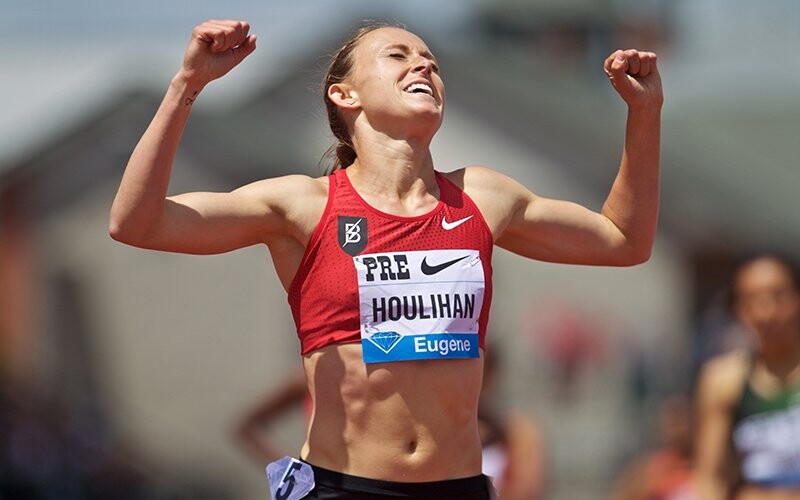
The next morning, on Dec. 15, 2020, the former Arizona State standout was given a random drug test. Weeks later, in mid-January, Houlihan was notified in an email from the Athletics Integrity Unit (AIU) that her urine sample revealed the presence of 19-norandrosterone (19-NA), a metabolite produced by the substance nandrolone – an anabolic steroid prohibited by the World Anti-Doping Agency (WADA).
She was issued a provisional suspension, which set off a cascade of events that led to a four-year ban, knocked her out of the U.S. Olympic Trials leading up to the Tokyo Olympics and will bar her from competing until January 2025 when she will be almost 32.
It is, Houlihan said, “an athlete’s worst nightmare.”
Houlihan, 29, has lost the financial support of Nike. She also saw former teammate Gabriela DeBues-Stafford leave the club rather than risk sanctions because of the Bowerman Track Club continued relationship with Houlihan.
Houlihan said her initial response to the positive test was “shock and disbelief.” She wondered, “How am I going to explain (the presence of a banned substance) when I don’t even know where it came from myself?”

Houlihan was at a high-altitude training camp in Flagstaff when she received the email.
“I opened up my phone to an email that was urgent, confidential and … it was this lab report of scientific words that I could not read,” Houlihan told Cronkite News.
The Sioux City, Iowa, native said she read the email over about 10 times and had to Google which substance triggered the positive test, because she had never heard of nandrolone.
Then she called Jerry Schumacher, her coach at BTC, the professional Nike club that Houlihan had trained with since graduating from ASU in 2015.
“I’m just sobbing and trying to tell him what’s going on, but crying too hard,” Houlihan said.
The long road
Today, Houlihan lives alone in Portland and said she has relied on her former BTC teammates, her boyfriend and her family for support. She does odd jobs, including food delivery, and continues to train with the hope of returning to competition at an elite level.
It is not a situation she envisioned growing up in Sioux City, Iowa, surrounded by runners, including her mother, Connie, and her uncle, Bob Prince, who competed in college.
After winning several state titles at Sioux City East High School, Houlihan continued her success at Arizona State, where she won the NCAA 1,500 meters in 2014 and finished as a 12-time All-American, the second-most in program history.
She holds five school records: the outdoor 800 and 1,500 meters, and the indoor 800, mile and 3,000.
That success set the stage for 2016 Summer Olympics, where she finished 11th in the 5,000 meters and was the highest-placing U.S. runner in the race.
She also finished fourth in the 1,500 meters and set the American record at the 2019 World Outdoor Championships.
More Olympic success felt inevitable.
Shock and disbelief
Elise Cranny, a close friend and former Bowerman teammate of Houlihan’s, remembers that news of the positive test “didn’t really sink in” at first.
“I came back to the house, and I was like, ‘Man, something is very off … something is not right,’” said Cranny, who was living with Houlihan during the camp. “I think the initial reaction from everyone was disbelief, and like, ‘Oh, this is something that’s going to get figured out’ because it’s seriously wrong.”
Schumacher and Houlihan called attorney Paul Greene to “just try to figure out a game plan” and investigate further what could have happened.
The first step was a pregnancy test because nandrolone can be found in pregnant women. After she determined she wasn’t pregnant, Houlihan compiled a log of everything she ate the week before the test. She scoured text messages, bank statements, food receipts and iPhone locations to determine everything she had consumed.
“I was able to piece it together pretty well,” Houlihan said. “And then, ultimately, we just felt like the food truck the night before had to be the most likely source.”
Houlihan wouldn’t name the establishment that served her the burrito because she doesn’t “want to mess with any lawsuit.” However, she isn’t blaming the food truck.
“I don’t think they did anything wrong,” Houlihan said. “I think it just kind of happened.”
While Houlihan and her BTC teammates frequently ate at that food truck, she recalls that she received her order more quickly than usual, and the foil-wrapped burrito was unlabeled.
Houlihan believes she may have been mistakenly given a burrito containing offal (pig organ meat), which can contain nandrolone.
She remembers the meat in the burrito being finely chopped and that grease pooled in the foil. She said it seemed more rich than the burritos she had eaten there before, so much so that she was unable to finish it despite being very hungry after eating little else that day.
“We knew (nandrolone) can be found in pig offal, and we knew that I ate at a food truck that served pig offal 10 hours before (the test),” she said. “And we knew that when you ingest it, it can be at its highest levels 10 hours after ingestion, and that’s the exact kind of time frame that I had eaten that.
“And so as unlikely as all of those things were, it just seemed like the only thing that we could say, ‘All right, this makes some sense,’ and that’s really the only thing that we had to go on.”
Houlihan was the only one among the three who ate at the food truck who was tested.
A search for answers
She provided a hair sample that was examined by a toxicologist and it showed no trace of nandrolone. She also passed a polygraph examination that concluded she was not lying when asked if, at any time, she knowingly or intentionally ingested nandrolone.
Houlihan’s urine tests taken Nov. 22, 2020, Jan. 23, 2021, and Feb. 4, 2021– before and after the positive test – all were negative. She also had her vitamins and supplements analyzed by a lab.
The previous urine tests and the lab report convinced Houlihan that it’s unlikely the positive result was triggered by a supplement or vitamin she was taking. She is still being randomly tested and all of her ensuing tests have come back clean.
She believes that given “the information that we have right now, (the burrito) is the only thing that kind of makes any type of logical sense.”
Houlihan hired a private investigator to trace its sources of meat, but the effort was unsuccessful.
The private investigator found that the food truck owner purchased 30 pounds of pork stomach in a frozen batch from Iowa Beef Processors in September of 2020. However, the owner had no box or label from the meat used in December that could be traced to its processing plant.
And the investigator couldn’t determine whether the owner used pork from a castrated or uncastrated boar. Houlihan’s attorney argued it must have been uncastrated boar meat that triggered her positive test.
When the AIU officially charged Houlihan four months later, the U.S. Olympic Trials, scheduled for June 18-27, were fast approaching. Houlihan decided to go straight to the Swiss-based Court of Arbitration for Sport (CAS) to avoid missing the trials.
The CAS rejected Houlihan’s explanation of what happened and banned her from the sport for four years on June 11, 2021.
Houlihan’s ban lasts until Jan. 13, 2025. She missed last summer’s Tokyo Olympics, the 2022 World Athletics Championships in Oregon, and she’ll miss next year’s World Athletics Championships in Budapest and the 2024 Paris Olympics.
The CAS’s three-member panel found that Houlihan’s “explanation that the 19-NA in her sample resulted from her consumption of the meat of an uncastrated boar simply cannot be accepted. The explanation presupposes a cascade of factual and scientific improbabilities, which means that its composite probability is (very) close to zero.”
Lacking evidence
The panel said that Houlihan failed to prove that the burrito she ate contained boar offal.
“First, the athlete would have had to have been served pork at the food truck despite ordering beef,” the court said. “Second, the pork consumed would not have been ‘normal’ pork product ordered by the food truck, but uncastrated boar. Third, uncastrated boar enters the food chain through completely different channels than pork.”
The panel said that the polygraph result and Houlihan’s hair sample were not “sufficient for the Athlete to rebut the presumption that the ADRV (anti-doping rule violation) was intentional.”
The court also said the concentration of nandrolone in Houlihan’s urine was “2-3 times higher than the highest values reported in the scientific literature after the ingestion of much more significant quantities of meat of mature (uncastrated) boar.”
On June 14, 2021, Houlihan publicly announced she tested positive for nandrolone and would not be competing at the upcoming Olympic Trials. Because Houlihan hadn’t been racing, many thought she was battling injuries instead of serving a provisional suspension.
“And at the end of the day, the panel didn’t think it was probable enough, which is unfortunate,” Houlihan said. “But yeah, I mean, that’s the only thing that we really have as an explanation. I hope at some point, maybe some more information pops up, and maybe it’s something else entirely. I don’t know. But it would be great to have an answer at some point.”
In May, Houlihan appealed the suspension to the Swiss Federal Tribunal.
She lost. It was her last opportunity.
The hardest part to watch, Crany said, “is her getting renewed hope through the appeal process or through different things, and then seeing her kind of have that life back in her eyes again, just for it to come crashing down.”
At one point, Houlihan was offered a reduced sentence – a three-year ban instead of four years – if she admitted guilt.
She refused.
“I never even considered that to be an option, because I knew I didn’t take (nandrolone) intentionally,” Houlihan said. “And I wasn’t going to admit to something that I didn’t do. At least I fought for myself and tried to do the right thing. But taking accountability for something that I didn’t do, it’s definitely not on the table for me.”
Houlihan thinks the system is flawed because the doping agency never had to prove she took a banned substance.
“There was obviously something in my system and I understand that I have a responsibility for what’s in my body,” Houlihan said. “But I think knowing that I never intentionally put it there and (I’m) still having to serve a four-year ban is definitely a flaw in the system. I don’t feel like they did their due diligence in trying to figure out what the truth was. It was just at the end of the day I couldn’t, beyond a reasonable doubt, prove where it came from.”
Houlihan said she believes the burden of proof should be shifted and “split 50-50 between the doping agency and the athlete.” While she believes that she should have to prove what triggered the positive test, she also believes the doping agency should have to prove that she intentionally cheated.
“Just even the playing field a little bit,” Houlihan said. “If you’ve ingested something, it’s almost impossible to try to figure out where that is. Because you’re getting notified a month or two later, I don’t have the source anymore. So it’s just a really impossible task to try to figure out. And I think it’s pretty flawed that if you can’t figure it out, it’s just an automatic four-year ban, and you’re treated like a doper.”
A new normal
Houlihan’s life today includes strong family and friend support.
Cranny said she had a lot of conversations with BTC teammates to make sure Houlihan felt supported.
“What you initially think of is her mental health and someone’s life being completely ripped out from under them and not being able to do what you love to do and what she feels like she’s been born and made to do,” Cranny said. “In the beginning, you worry about her being by herself, and making sure that she has people around her and she feels supported.”
Shelby’s mother, Connie Houlihan, who lives in Phoenix, said she is worried about the mental toll on her daughter.
“You’re afraid of suicide,” Connie Houlihan said. “You know, everything’s a possibility … with depression and with something that critical that they took away from her. You don’t know. Of course, you’re scared to death.”
Connie said a couple of Shelby’s sisters went to be with Shelby right away because they didn’t want her alone. Shelby wouldn’t let her parents come visit, however, because, Connie said, “she was so overcome.”
“I think, if we would have flown there right away, she would have … this is the way she explained it to me, ‘That it would have made it all too real.’
“She was really struggling dealing with it,” Connie said. “She was crying all the time. But I think that was the hardest part for us that we couldn’t just jump on a plane and go and be with her because we respected her decision.”
Chloe Houlihan, one of Shelby’s five sisters, said her sister remained “very resilient through everything.” She said she has tried to be someone Shelby “can talk to when she’s kind of struggling.”
Shelby no longer trains with her BTC teammates, something which Chloe said has been difficult and “a little bit isolating” for her sister.
Until May, Houlihan was paying Schumacher to coach her as an independent athlete, but she confirmed she’s now training entirely by herself – using six years of past training logs as a reference.
“We just felt it was best to maybe cut ties for a little bit,” Houlihan said. “I think there was just a lot of publicity going on around me and him still working together. There was just a lot of scrutiny, I think.”
Some of that publicity and scrutiny was fueled by DeBues-Stafford’s decision to leave BTC because of Houlihan.
A two-time Canadian Olympian who placed fifth in the 1,500 at the Tokyo Olympics, DeBues-Stafford announced in April she left BTC due to Houlihan’s continued ban involvement with BTC at the time.
“Fundamentally, I left the Bowerman Track Club because, despite my best efforts, I was unable to verify that the club was not in violation of World Athletics anti-doping regulations,” DeBues-Stafford said in an interview conducted via email.
DeBues-Stafford was concerned that Houlihan was working out “under the guidance of” the three BTC coaches (Schumacher, Shalane Flanagan and Pascal Dobert) at the same location and times that other BTC athletes were working out while under the supervision of the same coaches.
“While we never did a rep together, there was still what felt to me like an unnecessarily risky proximity between both men’s and women’s teams and an athlete serving a ban,” DeBues-Stafford said.
According to DeBues-Stafford, Houlihan would also use the private gym – built at Schumacher’s residence for BTC athletes to use – at the same time BTC athletes were there under staff supervision.
“Shelby would drive to the Nike campus up to four times a week at the team’s regular time and the starting point for our regular daily runs together so she could run with us,” DeBues-Stafford said. “If she arrived before us, she would wait for BTC athletes at the meeting spot to see if any BTC athletes arrived so she could run with us. These sometimes included long runs. She also ran with the team on a regular basis at altitude camp in Flagstaff.”
Houlihan said she and her attorney inquired about the rules of her ban and were told that she couldn’t go to any practices or work out with anyone on the team, but if she happened to bump into them and they were running at the same place, then she could run with them.
“My attempts to discuss my concerns with team staff were rebuffed, as were the earlier and more sustained efforts of other teammates,” DeBues-Stafford said.
BTC did not receive independent legal advice on the issue, DeBues-Stafford said. She also said Houlihan shared accommodations with a full-time member of BTC staff during the Flagstaff camp, and those accommodations were used for organized BTC athlete support activities.
“When I asked if Shelby’s lawyer had explicitly asked the AIU about her using the same gym as BTC and about how to handle the altitude trip, I did not get a clear response,” DeBues-Stafford said.
DeBues-Stafford said she “independently sought answers,” and reached out to an anti-doping organization to verify that BTC’s collective behavior was within the rules and that there was no liability on anyone other than Houlihan.
According to DeBues-Stafford, “the anti-doping organization could not guarantee that the actions of BTC and Shelby did not constitute a violation, and could not guarantee that other athletes and support staff couldn’t face repercussions either.”
She said the anti-doping agency cited two rules in the World Anti-Doping code and advised her to leave BTC and submit an official anonymous tip to the AIU.
A trying time
While Schumacher and some of Houlihan’s other teammates knew about her positive test in January of 2021, DeBues-Stafford did not learn about Houlihan’s positive test until a couple of days before the team publicly announced the ban about six months later.
“Learning this news in mid-June almost derailed my Olympics,” DeBues-Stafford wrote in an Instagram post in April. “It was a small miracle that I showed up in Tokyo in shape to run sub-four (minutes) twice in 48 hours and place fifth.”
Houlihan said she was “surprised” and felt “blindsided and hurt and confused” by DeBues-Stafford’s social media posts because DeBues-Stafford had not told her about her concerns.
“I never knew that that was a problem for her,” Houlihan said. “And I’m not sure why she didn’t reach out to me. I reached out to her after I read her posts.”
Houlihan said she apologized to DeBues-Stafford for being affected by her situation.
“I think she just felt like she didn’t want to add to what I was going through by bringing it to me, which I don’t agree with, personally,” Houlihan said. “I felt like I would have rather had that conversation with her and I would have been more than glad to try to help that situation for her in any way, instead of what ended up happening. I think that was a lot worse – what ended up happening – than her just coming and talking to me about it.”
DeBues-Stafford has since moved to Victoria, B.C. and is now coached by Trent and Hilary Stellingwerff.
“When I told Jerry (Schumacher) I was leaving BTC due to the lack of separation between Shelby and the group, he asked if I really wanted to leave, given he was thinking of possibly no longer coaching Shelby if she lost her appeal at the Swiss Federal Tribunal,” Debues-Stafford said.
Debues-Stafford said Houlihan was still driving to the Nike campus and running with BTC when Debues-Stafford left Portland on March 31.
“Growing fear over the team potentially breaking rules, coupled with frustration at the lack of action by the team left me in an awful and unsustainable headspace,” DeBues-Stafford said. “I left altitude camp early at the end of February to get some breathing space and made my decision to leave the team.”
A powerful influence
Cranny said she misses running with Houlihan and credits her for pushing her to succeed.
“I think of her all the time when I’m racing now,” Cranny said. “She’s a huge reason why I feel like I am where I am right now in my own running. She just really opened my eyes to the importance of not limiting yourself and putting yourself in it.”
Although BTC could look a lot different, Houlihan would still like to eventually come back to the group once her ban is up.
“I definitely would like to rejoin Bowerman,” Houlihan said. “That’s like my family, basically. I’ve been a part of that group since I went pro in 2015 and I know those athletes so well. And I know that that training environment is great for me.”
Cranny also wants Houlihan to rejoin BTC and said she can’t picture her former teammate anywhere else
“It feels like this is her family,” Cranny said. “I feel like everyone here is really supportive of her, really close friends with her. So I hope (she rejoins BTC). That’s something that we’ve definitely talked about as a team is wanting to work out with her again once the ban is up.”
When asked if she thinks she can still compete at the elite level once the ban is up, Houlihan said, “I guess that’s one thing that we’re just gonna have to find out.”
Houlihan is no longer a member of BTC nor being paid by Nike. She spent $250,000 in legal fees fighting her ban without any financial support from the Beaverton-based shoe and apparel giant.
“They said that they support me, and they believe in me, but as far as financially, I haven’t really received any support from them in that way,” Houlihan said.
Houlihan lost her six-figure professional contract with Nike and hasn’t had a paycheck in over a year. Her Nike deal also gave her the opportunity to earn performance-based bonuses on top of her base compensation, income that is also gone.
Houlihan’s mom called the entire process “an injustice” and said it wouldn’t make sense for her daughter to jeopardize her Nike contract by doping.
“Why would somebody with a contract that she had and the money that she was making, why would she cheat?” Connie said. “She had a contract (with Nike) through the (Tokyo and Paris) Olympics like, why would you cheat?”
Houlihan said Nike hasn’t offered her a job, either.
“I’ve been doing some food delivery things like DoorDash and stuff, just to try to make a little money on the side, but yeah, just trying to get by.”
Houlihan continues to train but admits it is difficult.“It’s been really challenging, to be honest,” Houlihan said.
As she trains alone, without her former coaches and teammates for support and motivation, Houlihan said she sometimes stops halfway through a workout or doesn’t always finish it at all. She finds it more difficult to hit her targeted times.
“I think it’s easy to do that when I’m having a great time and I’m having fun, and I’m finding joy in running,” Houlihan said. “But a lot of the things that make it fun aren’t really there for me right now.”
by David Veenstra (Cronkite News)
Login to leave a comment
Keira D’Amato Will Attempt to Lower Her American Record at Berlin Marathon
After winning the Falmouth Road Race on Sunday morning, Keira D’Amato confirmed that she will be running the Berlin Marathon on September 25 in an attempt to lower her own American record.
D’Amato set the current record of 2:19:12 in Houston in January, eclipsing Deena Kastor‘s 16-year-old American record of 2:19:36.
“I think I can run faster than I did in Houston, and I’m going to go to try to prove it in Berlin,” D’Amato told Citius Mag after Falmouth, confirming what many insiders expected as she wasn’t listed in the NY or Chicago elite fields and former NY elite athlete coordinator David Monti had previously tweeted out (but then deleted) that D’Amato was headed to Berlin.
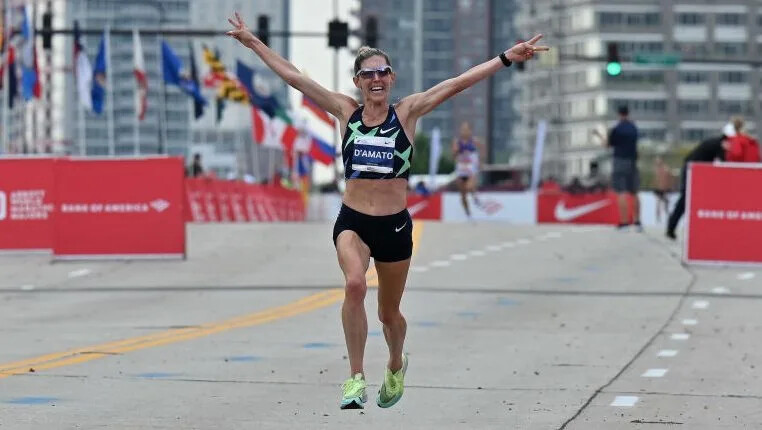
This will be D’Amato’s second Berlin Marathon. In 2019, she finished 17th in 2:34:55 in what was then a PR of more than six minutes. This time around, she will be looking to run more than 35 seconds per mile faster.
As the American record holder, D’Amato would have attracted a hefty appearance fee from either of the two American major marathons this fall, Chicago and New York. She also would have had more time to recover from her last marathon, an eighth-place finish at the World Championships on July 18 (there are 10 weeks between Worlds and Berlin; there are 12 weeks between Worlds and Chicago and 16 between Worlds and NYC).
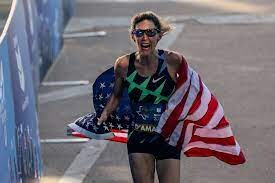
But D’Amato typically bounces back quickly between races — she won Falmouth less than five weeks after Worlds — and did not log a full buildup for Worlds as she was named as a late injury replacement for Molly Seidel barely two weeks before the championships. Additionally, American records result in big endorsement bonuses from shoe sponsors.
Berlin has become the go-to course for world record attempts in recent years, as it has hosted the last seven men’s world records and was also the venue of choice for Shalane Flanagan‘s American record attempt in 2014 (Flanagan fell short of the AR but still ran her lifetime best of 2:21:14). But three of the last four women’s world records have fallen in Chicago, including the current mark of 2:14:04 set by Brigid Kosgei in 2019. Either would have been fine options for an American record attempt; the better option may come down to weather on race day.
by Jonathan Gault
Login to leave a comment
BMW Berlin Marathon
The story of the BERLIN-MARATHON is a story of the development of road running. When the first BERLIN-MARATHON was started on 13th October 1974 on a minor road next to the stadium of the organisers‘ club SC Charlottenburg Berlin 286 athletes had entered. The first winners were runners from Berlin: Günter Hallas (2:44:53), who still runs the BERLIN-MARATHON today, and...
more...Some running quotes to inspire you
It can be hard to maintain your zest for running when the temperatures soar.
We dug up some running wisdom from some great athletes and minds to get you out the door. When your workout motivation wanes in the face of weather or whatever comes your way, read a few lines and consider it your calling to rise up and run.
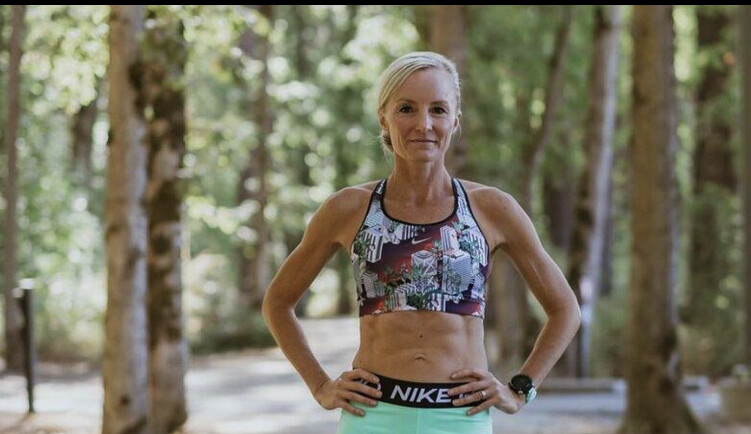
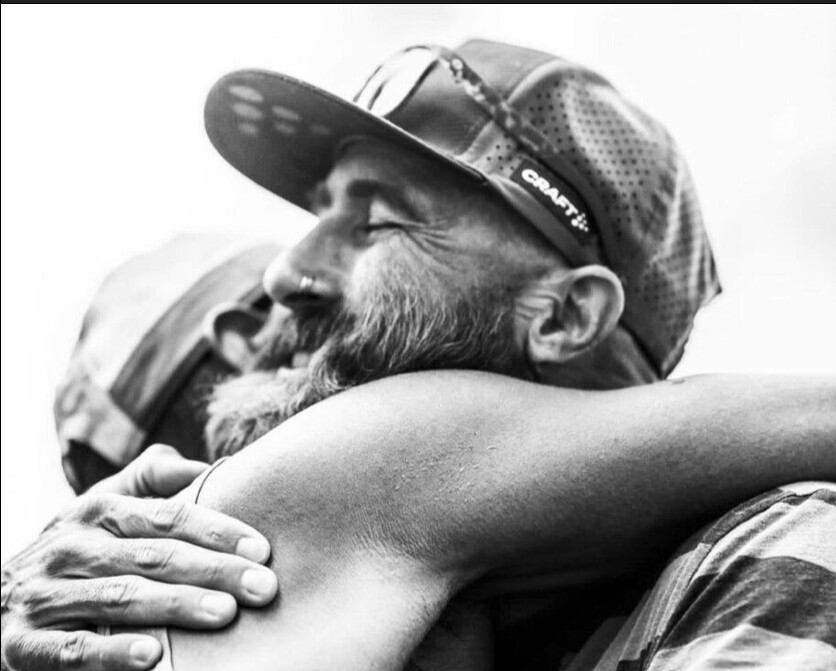
You are a runner, no matter your distance, pace or natural ability
“All runners are tough. Everyone has to have a little fire in them, that even in tough times, can’t be turned off.”
— Shalane Flanagan
“If one could run without getting tired I don’t think one would often want to do anything else.”
– C. S. Lewis
“To give anything less than your best is to sacrifice the gift.”
–Steve Prefontaine
“I just wanted to come out today and, I don’t know, get up in it, stick my nose where it didn’t belong, and just see what I could come away with. I guess that’s a medal.”
–Molly Seidel
“The advice I have for beginners is the same philosophy that I have for runners of all levels of experience and ability: consistency, a sane approach, moderation, and making your running an enjoyable, rather than dreaded, part of your life.”
— Bill Rodgers
Remember why you do it
“Why do we do this? To feel something. To move ourselves, to ensure that we don’t get stuck. And most of all, we do this to be a part of something. To insert our individual effort into a sea of human energy and force out the other side, hopeful that somehow we’ll be different. Changed in some way.”
–Peter Bromka
“Because during every run, for a few seconds or a few minutes, you have a moment where it feels really good. You forget about the discomfort and you find rhythm, maybe some grace, and a feeling of strength and confidence as you move as well as you’ll ever move doing anything. And that’s one of the best reasons to run.”
― Brendan Leonard
“Keep moving. You’re still here. We all are. As long as you’re moving you’re still here.”
–Tommy Rivers Puzey
“…For me there has always been a place to go and a terrible urgency to get there.”
—Joan Benoit Samuelson
“The reason we race isn’t so much to beat each other… but to be with each other.”
–Christopher McDougall
Login to leave a comment
Running motivation: running quotes to inspire you
It can be hard to maintain your zest for running when the temperatures soar.
We dug up some running wisdom from some great athletes and minds to get you out the door. When your workout motivation wanes in the face of weather or whatever comes your way, read a few lines and consider it your calling to rise up and run.
You are a runner, no matter your distance, pace or natural ability
"Love hard. Live hard. Keep moving forward" –Tommy Rivers Puzey
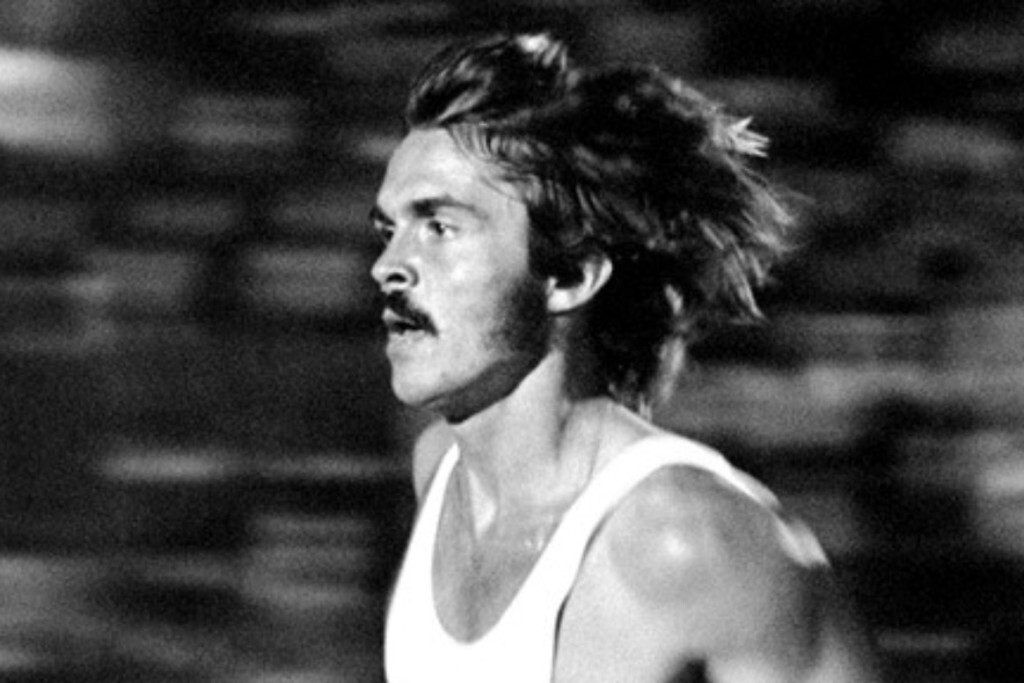
“All runners are tough. Everyone has to have a little fire in them, that even in tough times, can’t be turned off.” — Shalane Flanagan
“If one could run without getting tired I don’t think one would often want to do anything else.” – C. S. Lewis
“To give anything less than your best is to sacrifice the gift.” –Steve Prefontaine
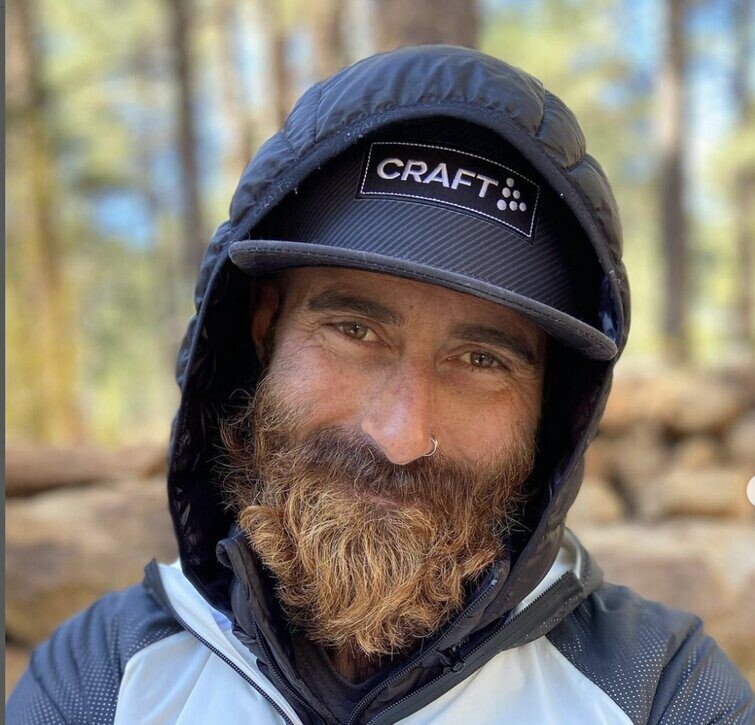
“I just wanted to come out today and, I don’t know, get up in it, stick my nose where it didn’t belong, and just see what I could come away with. I guess that’s a medal.” –Molly Seidel
“The advice I have for beginners is the same philosophy that I have for runners of all levels of experience and ability: consistency, a sane approach, moderation, and making your running an enjoyable, rather than dreaded, part of your life.” — Bill Rodgers
Remember why you do it
“Why do we do this? To feel something. To move ourselves, to ensure that we don’t get stuck. And most of all, we do this to be a part of something. To insert our individual effort into a sea of human energy and force out the other side, hopeful that somehow we’ll be different. Changed in some way.” –Peter Bromka
“Because during every run, for a few seconds or a few minutes, you have a moment where it feels really good. You forget about the discomfort and you find rhythm, maybe some grace, and a feeling of strength and confidence as you move as well as you’ll ever move doing anything. And that’s one of the best reasons to run.” ― Brendan Leonard
“Keep moving. You’re still here. We all are. As long as you’re moving you’re still here.” –Tommy Rivers Puzey
“…For me there has always been a place to go and a terrible urgency to get there.” —Joan Benoit Samuelson
“The reason we race isn’t so much to beat each other… but to be with each other.” –Christopher McDougall
by Keeley Milne
Login to leave a comment
Shalane Flanagan takes coaching role at University of Oregon
U.S. Olympic medallist and 2017 New York City Marathon champion Shalane Flanagan announced on her social media that she’ll be joining the University of Oregon coaching staff as an assistant coach to help lead the team’s distance program.
Since 2019, Flanagan has been an assistant coach for the Nike Bowerman Track Club alongside Jerry Schumacher, who was recently named head coach of Oregon’s track and field program.
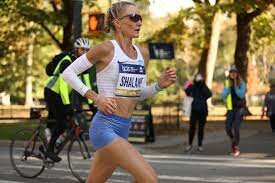
During her career and guidance, Flanagan has been part of the emergence of the Bowerman Track Club, which is considered one of the top running groups in North America.
Flanagan joined Bowerman Track Club in 2009 and made two U.S. Olympic teams in the marathon (2012 and 2016). In 2012, Flanagan finished 10th and in Rio 2016, she finished sixth in 2:25:26.
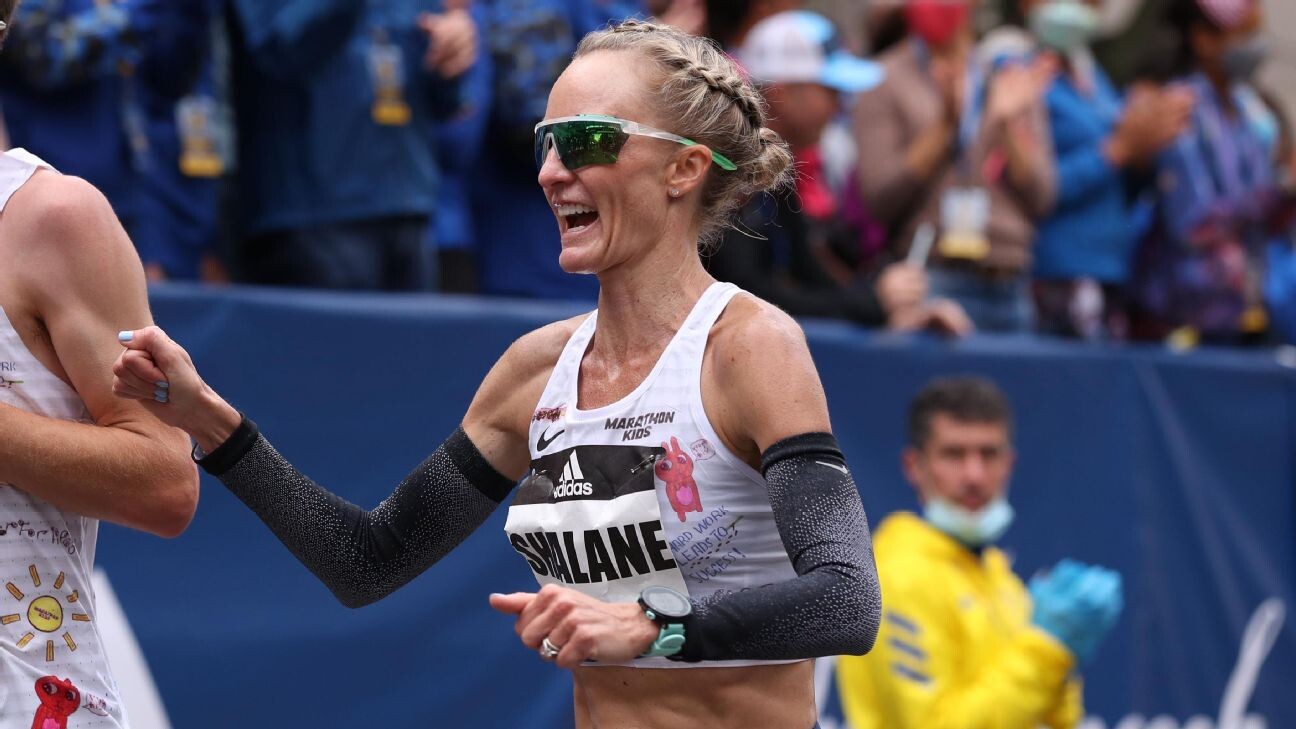
In 2017, Flanagan ended a 40-year winless drought for American women at the New York City Marathon by winning the prestigious event.
Flanagan made her Olympic debut in 2004 when she was 23, and returned in 2008 to win a silver medal in the 10,000m. Flanagan also has a bronze medal to her credit from the 2011 IAAF World Cross Country Championships in Spain.
Flanagan, now 41, is an 18-time U.S. champion with six titles in each discipline (track, road and XC). She won two of her 18 titles at the Historic Hayward Field in Eugene, Ore, which is the training ground for the University of Oregon track and field program.
In 2019, she announced her retirement from running but then paused her retirement in 2021 to complete all six Abbott Marathon Majors in seven weeks. She ended up finishing all six races in under three hours.
by Marley Dickinson
Login to leave a comment
Shalane Flanagan’s strawberry-rhubarb muffins are the ideal summer snack, Grab one of these muffins in the morning and head out for a run
Hot summer days combined with warm-weather running means our household is always striving for the quickest, most simple meal prep possible. We try to keep some of Shalane Flanagan and Elyse Kopecki’s superhero muffins in our freezer at all times: they are an ideal grab-and-run breakfast or snack (or both!).
Four-time Olympic marathoner Flanagan may be retired from professional competition, but she’s still a busy coach for Bowerman track club, a mom, and co-author of three cookbooks with former teammate and friend Kopecki. Their latest, Rise and Run, had me hooked with its tips for creating morning rituals and weekly meal plans, alongside recipes chock-full of nutrients to get your day kick-started. These muffins are easy to make gluten-free (simply use certified gluten-free oats) and vegetarian.
Strawberry-Rhubarb Superhero Muffins

Ingredients
2 cups hazelnut flour*
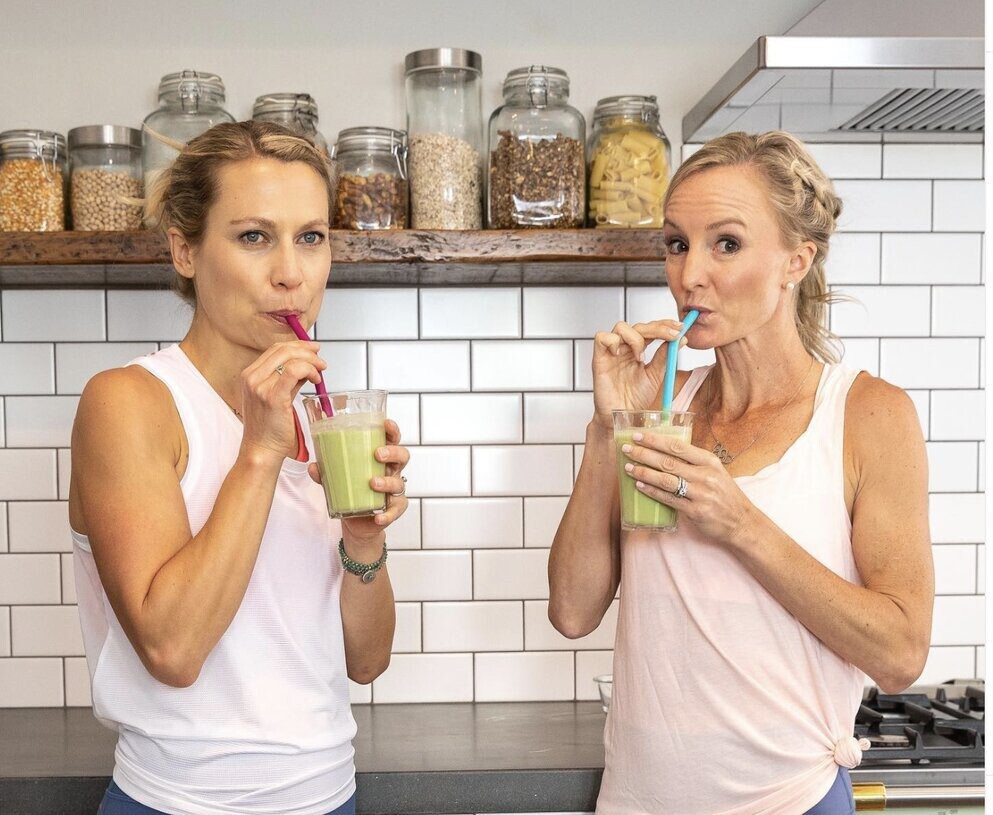
1 1/2 cups rolled oats
1 tsp baking soda
1/2 tsp fine sea salt
3 eggs
1/3 cup maple syrup
4 Tbsp (1/2 stick) unsalted butter or 1/2 cup coconut oil, melted
1 tsp vanilla extract
1 1/2 cups chopped fresh strawberries
1 cup chopped rhubarb (about one stalk)
*you can substitute almond flour or almond meal if you prefer
Directions
Arrange a rack in the center of the oven and preheat the oven to 350°F. Line a 12-cup standard muffin tin with paper muffin cups.
In a large bowl, combine the hazelnut flour, oats, baking soda, salt, and nutmeg.
In a separate bowl, whisk together the eggs, maple syrup, melted butter, and vanilla. Add the wet ingredients to the dry ingredients and mix until just combined. Fold in the strawberries and rhubarb. The batter will be thick.
Spoon the batter into the muffin cups, filling each to the brim. Bake until the muffins are nicely browned on top and a toothpick inserted in the centre of a muffin comes out clean. 30 to 35 minutes for large muffins or 25 minutes for mini muffins.
Store leftover muffins in an airtight container in the fridge for up to one week, or in the freezer for up to three months. Reheat in the oven at 300 F (148 C) for 10 minutes or microwave on low power for 30 seconds.
by Running Magazine
Login to leave a comment
Here’s How the U.S.’s 5,000-Meter World Finalists Handle Excessive Heat on Race Day
Racing in hot weather can be daunting. Utilize these pro tips from Elise Cranny, Karissa Schweizer, and Emily Infeld to better prepare yourself for the next scorcher.
If you’ve ever raced in the summer, then you know how difficult it is to be underneath the beating sun for too long. Heat stroke, sunburn, and dehydration are legitimate dangers from overexposure. But maybe you signed up for a race that starts in the middle of a summer day. Maybe you’re running a destination marathon in a hotter climate. Perhaps you’re even attempting an ultramarathon, like Badwater 135, which takes place in Death Valley. You want to race, but you also want to be safe.
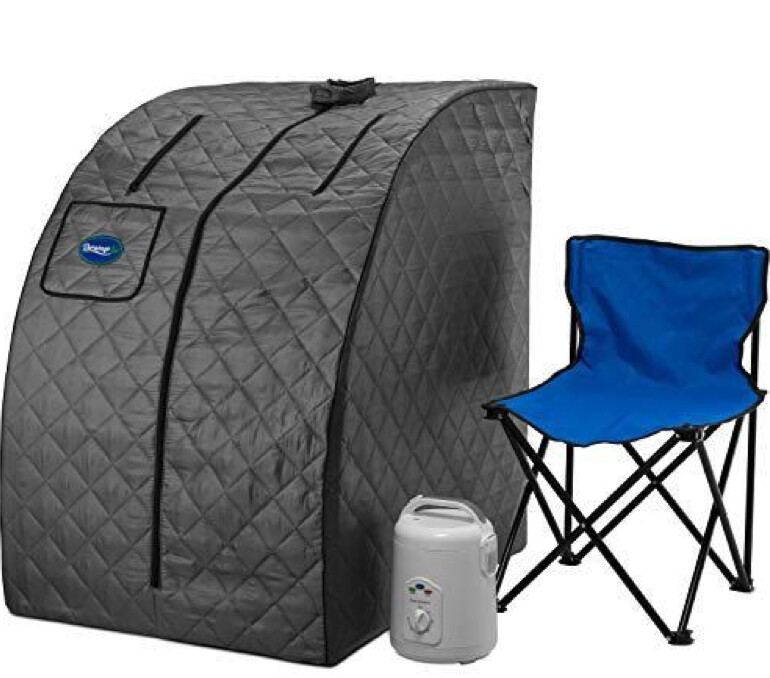
Professional runners sympathize. On July 20 at the World Athletics Championships in Eugene, Oregon, the women’s 5,000 meters took to the track for their preliminary races in searing 90-degree heat.
Yet despite the scalding temperatures, Elise Cranny, Karissa Schweizer, and Emily Infeld of the U.S. all qualified for the 5,000-meter final without any problems from the temperature. Schweizer and Infeld even ran season bests. Here are their tips for handling the heat so next time you’re faced with a race on hot day, you can be prepared.
Gradually adapt to hotter temperatures
Before the prelim, Infeld hadn’t run much in hot weather. She trains part-time in Flagstaff, Arizona, whose average summer high hover around 80 degrees, and has spent the last few months in Eugene, which hadn’t experienced 90-degree days yet.
“We were trying as best we could to go at the hottest part of the day, which is around 4 to 6, to do workouts,” said Infeld. “Some days that was 80 degrees, some days that was 60. So, I was trying to do sauna, and do things that I could to prepare in case it was hot.”
Infeld owns a portable sauna tent that goes up to 140 degrees. She would go for a run, and if it wasn’t hot enough for her body to learn to adapt, she’d hydrate well and sit in the sauna for 20 minutes to simulate heat training. A review published in Frontiers looked at numerous studies that confirmed that passive heat acclimation strategies, such as sauna, have a measurable effect on athletic performance and heat tolerance. If you don’t have access to a sauna, a study from Temperature recommends overdressing to simulate hotter temperatures, though admits this method isn’t as effective.
Infeld’s preparations paid off with a season best time of 15:00.98 and a time qualifier for the 5,000-meter final.
Stay as cool as possible before racing
Schweizer already had one race under her belt before the 5,000-meter prelims —the championship 10,000 when she placed ninth in a personal best of 30:18.05. Because the weather was temperate for the 10,000, Schweizer found the heat during the 5,000 jarring.
Not only does Schweizer train to adapt to the heat—such as working out in the Salt Lake City, Utah sun during altitude camp with the Bowerman Track Club or using a sauna like Infeld—but she also takes precautions before race to stay cool.
She spends much of her pre-race time in the shade, wears an ice vest to warm up, and even stuffs ice in her uniform on the starting line: “It was to the point where I had chills, so I was pretty cold going into the race.”
While utilizing shade and ice may sound like too simple of a solution, it’s actually very effective. The same Temperature study previously mentioned reveals that pre-cooling your body optimizes endurance performance and mitigates the effects of heat strain during extreme temperatures. Some techniques mentioned include ice baths, ice vests, cold towels, and drinking very cold drinks or frozen beverages (called “ice-slurries” in the text) before the race. The study recommends trying out a few techniques to see what works best for you on race day.
Wear sunglasses to prevent extra strain
Cranny credits her races last year at the Olympic Trials and Olympics as practice for racing in the heat, and also has similar pre-race cooling procedures as her teammate, Schweizer. But Cranny also found that wearing sunglasses during races makes a huge difference.
According to Cranny, many of the Bowerman Track Club athletes wear sunglasses in practice. But until the USATF Championships in June, she had never worn them in a race before. Shalane Flanagan, who coaches the club alongside Jerry Schumacher, highly recommended it, telling Cranny that it prevents squinting in direct sunlight, which relaxes the face. By relaxing her face, Cranny felt she prevented other parts of her body from tensing up, such as her shoulders.
Expect to see Cranny, Schweizer, and Infeld all wear sunglasses for Friday’s final like they did in the prelims, in addition to using pre-cooling techniques. They’ll fight for medals against key competitors like double Olympic champion Sifan Hassan, world 10,000-meter champions Letesenbet Gidey, and world 1500-meter silver medalist Gudaf Tsegay on Saturday, July 23.
Schweizer is ready to put herself in the race, no matter the conditions or pace: “I feel like at a U.S. level, I’m pretty good at running with that confidence. But going into a world level, there’s a lot of really big names and a lot of them have run some pretty crazy times. So I think it’s hard sometimes to really trust yourself and trust your fitness but I know I can hang with the best of them.”
Cranny will focus on staying mentally tough, as Schumacher advised her and Schweizer that a 15-minute 5,000 might feel like a 14:30 effort in the heat. “You kind of just have to prepare yourself… If you panic 6 laps in cause it feels horrible, even if you’re not running a PR pace… being prepared for that and talking yourself through it is a big part.”
Infeld caught COVID-19 at the USATF Championships but isn’t letting that or the temperatures hold her back: “I always want to compete against the best and see where that lands me,” she said immediately post-race, before knowing she qualified on time. “Today it was sixth in that heat, but I hope that’s enough to get in the final and mix it up with the women out there.”
by Runner’s World
Login to leave a comment
What Are therapeutic use exemptions and Why Are They Controversial?
Athletes such as Molly Seidel, who was recently diagnosed with ADHD and prescribed Adderall, must receive exemptions from doping agencies in order to use medications that are banned.
Olympic bronze medalist Molly Seidel announced on Instagram on June 8 that she’d be missing the New York Mini 10K last weekend. The reason? She’d been diagnosed with ADHD early in 2022, and after the Boston Marathon, she started taking the prescription drug Adderall.

Adderall is banned by the World Anti-Doping Agency (WADA) for use in competition, because it can be used as a performance enhancer. But Seidel has a legitimate medical need for the drug, so she can apply for a therapeutic use exemption, commonly known as a TUE.
Seidel wrote on Instagram that she applied for a TUE about six weeks ago, and she won’t have an answer on her application until the end of June at the earliest.
Since she started taking Adderall, she had been feeling much better. “I felt like I was able to get the quiet, functioning brain in my day-to-day life that I could previously only achieve with intense physical activity,” she wrote. “It also gave me remission of many eating disorders behaviors that I’ve dealt with consistently since my teens.”
She was disappointed to pull out of the New York Mini 10K. Seidel wrote, especially after she has had a tough few months. (She dropped out of the Boston Marathon in April with a hip impingement at about the 16-mile mark.)
“However, I’m committed to a clean sport and respecting my own mental health needs, so that means following the appropriate procedures of this TUE process,” she wrote. “Mental health takes work, and I want to be transparent about the fact that medication is sometimes a very necessary part of that work.”
Seidel is due to run the World Championships marathon in Eugene on July 18.
Her case illustrates a years-long debate among athletes, coaches, and officials about TUEs. At issue: How can the sport allow its athletes to legally obtain treatment for diagnosed medical conditions while preventing others from abusing the system?
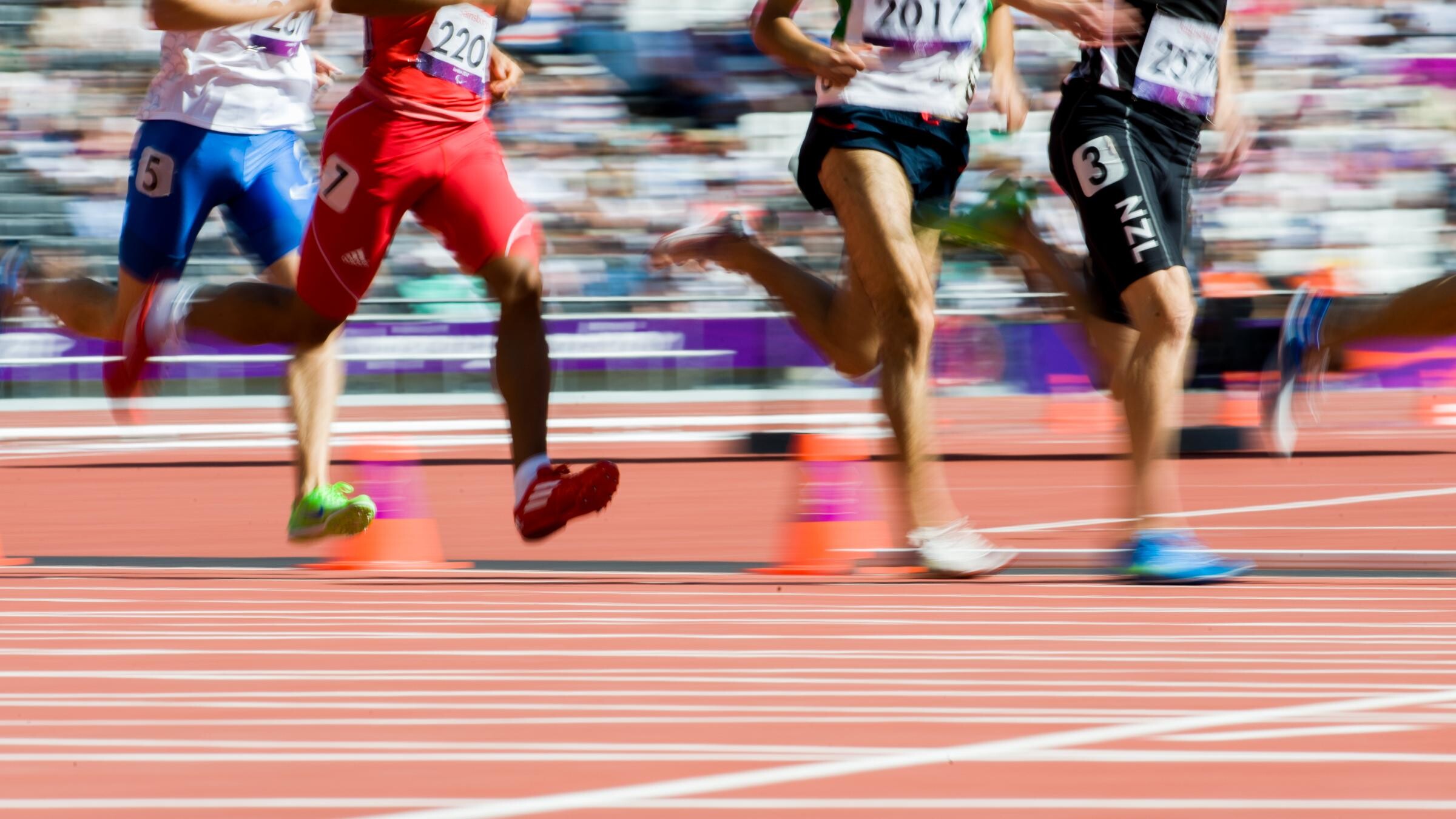
Below, we answer a few common questions about TUEs.
What is a therapeutic use exemption (TUE)?
When an athlete is sick or has a condition that requires treatment with medicine that is listed on WADA’s prohibited substance list, he or she can be granted a TUE to take the drug, according to the U.S. Anti-Doping Agency (USADA).
Some drugs are prohibited when an athlete is competing. Other drugs are also banned for out-of-competition use. If a TUE is approved, it usually has a starting and ending date during which the athlete may take the medication. If the athlete is drug tested during that period and tests positive for an illegal substance for which they are granted an exemption, he or she will not face disciplinary measures.
In an emergency situation, if somebody is treated with a prohibited substance, he or she is allowed to file an emergency TUE afterward, as soon as possible. For example, when Shalane Flanagan received an IV for severe dehydration in February after the 2016 Olympic Marathon Trials, which is otherwise a banned practice, she was granted an exemption because she was in medical need.
“I resisted getting an IV but a lot of the doctors there were insisting that I needed it,” Flanagan said, weeks after the race. “It would have taken a really long time to get those fluids in orally. So the IV really speeded up my recovery. It actually made me realize probably why they are illegal [in competition] under most circumstances—my core temperature immediately went down. If I hadn’t had that, I would have had a much longer process.”
How does an athlete get a TUE?
U.S. athletes apply for a TUE through USADA, though if somebody is also competing at an international event, it may require that person to obtain another exemption through World Athletics, the governing body for track and field.
“The TUE application process is thorough and designed to balance the need to provide athletes access to critical medication while protecting the rights of clean athletes to compete on a level playing field,” according to USADA.
If a pro runner is in need of a TUE, he or she downloads the application and completes it with a doctor. A medical file must accompany the application.
Who decides if the athlete gets a TUE?
The Therapeutic Use Exemption Committee reviews the application, the medical details, the patient history, test results, how the condition has been managed over time, and attempts to treat it with non-prohibited medications and methods. Galen Rupp, for example, has been granted exemptions to take prednisone to treat asthma.
The committee includes doctors and medical experts, according to USADA. They review and either approve or deny the application without knowing the athlete’s name by following WADA’s standards, outlined in an annual 30-page document.
WADA policy states that athlete must prove that the prohibited substance is needed to treat an acute or chronic medical condition, “such that the athlete would experience a significant impairment to health” if it is withheld; that the medication is highly unlikely to produce any enhancement of performance beyond what would be considered “anticipated” by a return to the individual’s normal health; and that there is no reasonable alternative to treat the condition.
What is on the WADA prohibited substance list?
The prohibited list includes more than 300 substances and methods of taking substances (for example, orally, by injection, intravenously). It also includes those that are always prohibited and those that are only prohibited during a competition. The lists are updated by WADA each year, and it’s up to the athletes to be aware of changes of the rules.
Some examples of prohibited substances include steroids, human growth hormone, certain stimulants, diuretics, and masking agents that can interfere with drug tests.
How could an athlete use TUE system or prescription drugs to cheat?
Athletes at the highest level are constantly searching for fractions of percentages in performance gain. Some, of course, seek such gains illegally. Should that athlete have a support team of coaches and doctors who also engage in unethical practices, they can collectively seek exemptions for medications that are not medically needed but could produce a competitive advantage.
In July 2015, Rupp and his coach Alberto Salazar were accused by former members of the Oregon Project of manipulating the TUE system for performance gain and faking symptoms in an effort to be prescribed legal thyroid medications. Those medications could help with a runner’s energy levels, allowing an athlete to train with more intensity and volume. Rupp and Salazar have strongly denied those accusations. Salazar has since received a four-year ban for trafficking performance-enhancing drugs to his athletes and in a separate matter, he has been banned permanently from track by SafeSport.
by Runner’s World
Login to leave a comment
Emily Sisson, Nico Montanez Take 2022 USATF 15-K Titles in Jacksonville
Emily Sisson and Nico Montanez scored convincing wins today at the 45th Gate River Run in Jacksonville, Fla., the traditional home of the USATF 15-K Championships. Sisson, who represents New Balance, successfully defended her 2021 title in 47:28, collecting her fifth national title across all distances and surfaces. Montanez, who trains with the Mammoth Track Club and represents Asics, clocked 43:10 to collect his first national title in any discipline.
While both athletes earned $10,000 in prize money, Sisson won an additional $5,000 for winning the race’s gender challenge. The women were given a six-minute head start and Sisson crossed the finish line one minute and 42 seconds ahead of Montanez.
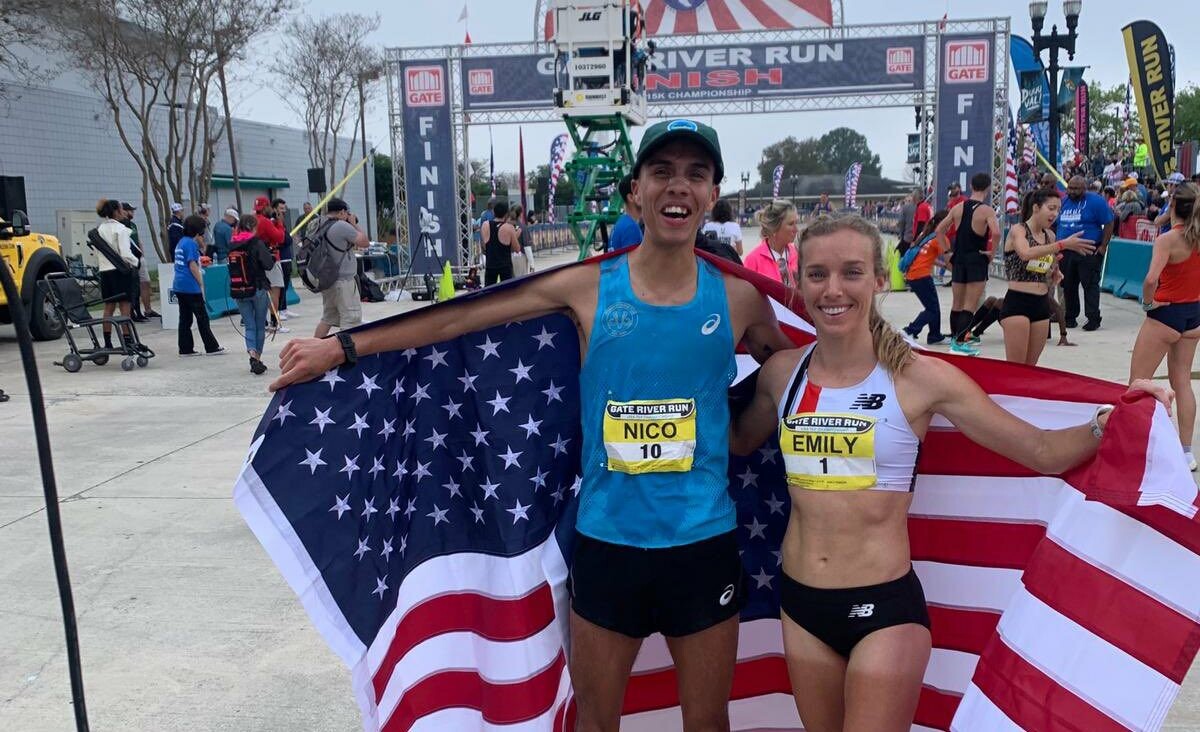
In typically humid Florida conditions, Sisson led the elite women’s race right from the gun. In the early kilometers she had company from both Emily Infeld (Nike) and Emily Durgin (adidas), but by the 5-kilometer mark (15:38) she already had a six-second lead. Running her first race since placing tenth in the 10,000m at the Tokyo Olympics last August, Sisson found herself in the same position as last year: running alone and against the clock.
“It’s my first race back from Tokyo, so it’s just good to push my body that hard,” Sisson told Chris Nickinson of USATF.tv in her post-race broadcast interview. “I haven’t done that in so long now.”
Sisson, 30, who lives in the Phoenix area but has been training recently at high altitude in Flagstaff, Ariz., checked her watch a few times as she clicked off her kilometers in the 3:10 range. Her splits were showing that she had a chance at Shalane Flanagan’s American record of 47:00 set at the same race in 2014. But ascending the 141 foot (43m) high Hart Bridge which begins at about 13 km, Sisson lost too much time and had to settle for the #4 USA performance ever, behind only Flanagan and Olympic bronze medalist Deena Kastor who ran 47:15 in 2003 and 47:20 in 2007.
“It felt good to get out there and hoping this is a good springboard for the rest of the year,” Sisson added.
Emily Durgin was a clear second in 49:17 and Emily Infeld got third in 49:46.
Nico Monatanez Gets 1st National Title
Montanez, 28, who is coached by Andrew and Deena Kastor, stayed tucked-in to the men’s lead pack for nearly the entire race. Two-time Olympic medalist Galen Rupp (Nike) led for more than two thirds of the race, splitting 5-K in 14:27 and 10-K in 28:52 with steeplechaser Hilary Bor (Hoke One One) on his heels. Montanez waited for the incline on Hart Bridge before attacking the field. He quickly opened a big lead. Montanez said that his move wasn’t spontaneous.
“It wasn’t a moment like that where I’m like, oh, I had the lead and time to go,” Montanez said in his post-race broadcast interview. “This thing was planned, it was maneuvered, it was thought out, it was prayed for. This is something that has been on my mind. This is Andrew and Deena Kastor, both of my coaches. This is their recipe.”
Montanez crested the bridge with none of the other men still within striking distance and was able to enjoy the final kilometer to the finish. Behind him, Leonard Korir, a 2016 Olympian, out-sprinted Bor for second place, although both men were given the same time: 43:14. Rupp, who is also running the United Airlines NYC Half on March 20, faded in the last two kilometers and finished seventh in 43:31.
Todd Williams’s championships, race and national record of 42:22, which was set in 1995, stood up yet another year.
The Gate River Run was never cancelled due to the pandemic. It was held on March 7, 2020, just before the initial pandemic shutdown, and race director Doug Alred was able to stage the race in 2021 early in the USA mass-vaccination process by cutting the field size in half to about 6700 finishers and employing social distancing. The event has hosted the USATF Championships since 1994.
The Gate River Run is part of the USATF Running Circuit. The next event is the USATF 1 Mile Road Championships to be held in Des Moines, Iowa, on April 26
Login to leave a comment
Gate River Run
The Gate River Run (GRR) was first held in 1978, formerly known as the Jacksonville River Run, is an annual 15-kilometer road running event in Jacksonville, Fla., that attracts both competitive and recreational runners -- in huge numbers! One of the great running events in America, it has been the US National 15K Championship since 1994, and in 2007...
more...Grant Fisher (12:53.73) DESTROYS US 5,000 Record in Boston, Moh Ahmed (12:56.87) and Marc Scott (12:57.08) Break Canadian and British Records
As the runners were getting ready for the elite section of the men’s 5000 meters at the 2022 Boston University David Hemery Valentine Invitational on Saturday evening, we should have known we were in for a treat. After all, the slow heat had just been won in 13:05.
It’s crazy, when you think of it: Bowerman Track Club coach Jerry Schumacher had decided Woody Kincaid, the reigning US 10,000-meter champion, was not quite ready to mix it up with his BTC teammates in the fast section and Kincaid wound up running 13:05.56, at the time the second-fastest indoor 5,000m ever by an American.
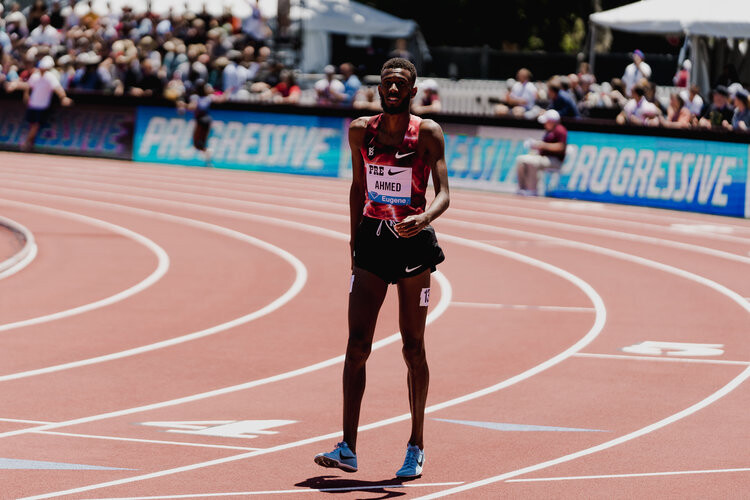
Just as crazy: Schumacher was kind of right. Because what we saw in the fast heat was the deepest 5,000-meter race ever contested on US soil, indoors or out.
Grant Fisher, a former high school phenom who won two Foot Locker titles and broke 4:00 in the mile while balancing soccer with running, delivered on his immense promise and ran 12:53.73 to win the race, smash Galen Rupp’s American indoor record of 13:01.26, and come within a whisker of Bernard Lagat’s American outdoor record of 12:53.60. He is now the fifth-fastest human ever at 5,000 meters indoors, one spot ahead of a guy by the name of Eliud Kipchoge.
Fisher’s Bowerman teammate Moh Ahmed, the Olympic silver medalist last year, was next across, running 12:56.87 to break his own Canadian indoor record of 13:04.60. Marc Scott completed the BTC national record sweep in third, and like Ahmed, Scott lowered his own European indoor record, taking it from 13:08.87 to 12:57.08.
In the process, Scott became the first man born in the United Kingdom – and just the third born in Europe – to break 13:00, indoors or out. The race marked the first time that three men broke 13:00 in the same race indoors (only once before had even two done it in the same race).
The times were so fast up front that would-be historic performances were relegated to also-ran status. Emmanuel Bor ran the second-fastest time in US
indoor history (under Rupp’s previous AR) but was only 4th (13:00.48). Sam Atkin of Great Britain and Jonas Raess of Switzerland both ran faster than the previous European indoor record but had to settle for 5th (Atkin in 13:03.64) and 6th (Raess in 13:07.95).
Florida State’s Adriaan Wildschutt of South Africa ran the second-fastest NCAA time ever indoors and third-fastest under any conditions – 13:09.20 – setting a national indoor record in the process and he was only 5th – in the B heat. Notre Dame’s Dylan Jacobs ran 13:14.04, #4 on the NCAA all-time indoor list and an American indoor collegiate record.
It was sheer madness.
In the main race, the early pacing was good, with 2020 US indoor 1500 champ Josh Thompson and 27:20 man Zouhair Talbi of Morocco taking the field through 3k in 7:53.51, but the real racing didn’t get going until just under a mile to go, when Atkin signaled for Fisher to pass him, knowing he could no longer hold the pace Fisher wanted to run.
From there, Fisher conducted a symphony of pain on the BU track, stretching the field out until Atkin, Scott, Ahmed, and finally Bor had dropped, leaving Fisher all alone for the final 400 as the crowd roared him into the history books. His last four 400m splits: 60.00, 58.95, 59.91, 58.74, good for an otherworldly 3:57.56 final 1600.
Fisher’s performance, just like almost every elite distance performance in the year 2022, must be placed into the context of its era. Earlier in the day on the same track, Notre Dame’s Yared Nuguse, the Olympian and 2019 NCAA 1500 champ, broke Alistair Cragg’s 7:38.59 indoor collegiate record which had stood since 2004. And last night, Gabriela DeBues-Stafford and Elise Cranny set dueling Canadian/American records, Cranny taking 14 seconds off Shalane Flanagan’s 14:47.62 AR.
Fisher and Cranny’s talents have long been known, and they are undoubtedly great runners. Yet between them, they own a grand total of one NCAA and one US title. That they could annihilate national records established by two of the greatest distance runners in American history is yet more evidence that we have entered a new age of distance running ushered in by super shoes, one in which the standards must be (and are being) adjusted.
by Let’s Run
Login to leave a comment
How to make a running mantra, for when you need a little motivational self-talk to get you to the finish line
Running is as much mental as it is physical. When you reach the inevitable part in a workout or race when your body wants to give up, it’s your mind that gets you to the end. Developing mental strength is no easy task, and requires constant work to maintain.
Creating a running mantra can help silence negative thoughts and encourage you to push through tough spots, but not just any random combination of words will do. Not sure how to create a mantra of your own? We’re here to help.
Why do mantras work?
It’s very easy for negative thoughts to creep in when you’re completing a hard workout or running a race. As you start to fatigue, thoughts telling you you’re too tired, you’re not good enough, you won’t reach your goal or that you should quit can get louder and louder to the point where it’s difficult to hear anything else. That’s when a mantra comes to your rescue. Having a mantra ready and waiting for when you need it most requires very little thinking or mental energy, but repeating it can drown out the negative thoughts going on in your head.
In fact, a 2017 study found runners who were completing a 60-mile (95Km) overnight race reported that using a mantra was helpful both in training and racing, and continued to use their mantras even after the study was complete.
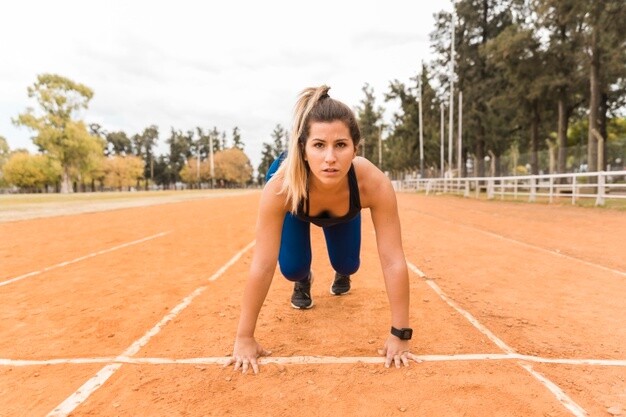
The anatomy of a good mantra
A mantra can be whatever you want it to be, but there are a few things to keep in mind if you want it to be effective. Use these guidelines to create your own personalized motivational mantra:
It should be short. You want your mantra to be easy to remember and easy to repeat, so a long-winded phrase is not a great option here. Usually one or two affirmative words that bolster your confidence is all you need.
Use your struggles as inspiration. Do you lack confidence in yourself in the later stages of a race? Do you get stressed or begin to panic when it starts to get difficult? These are the things you want your mantra to address. If you lack confidence, a simple phrase like “I am strong” or “I can do hard things” can remind you what you’re capable of. If you start to feel stressed during the race, something like “stay calm, stay relaxed” could be exactly what you need to turn those feelings around.
Remind yourself why you’re doing this in the first place. When you get to the hard part of a run, workout or race, you might find yourself asking why you do this at all. In this case, you could use your mantra to remind you why you’re out putting one foot in front of the other. For example, “I’m loving this challenge,” or even simple, “I am a runner,” can remind you that you love the sport, and turn it around in your mind to be a fun experience.
Examples of elite mantras
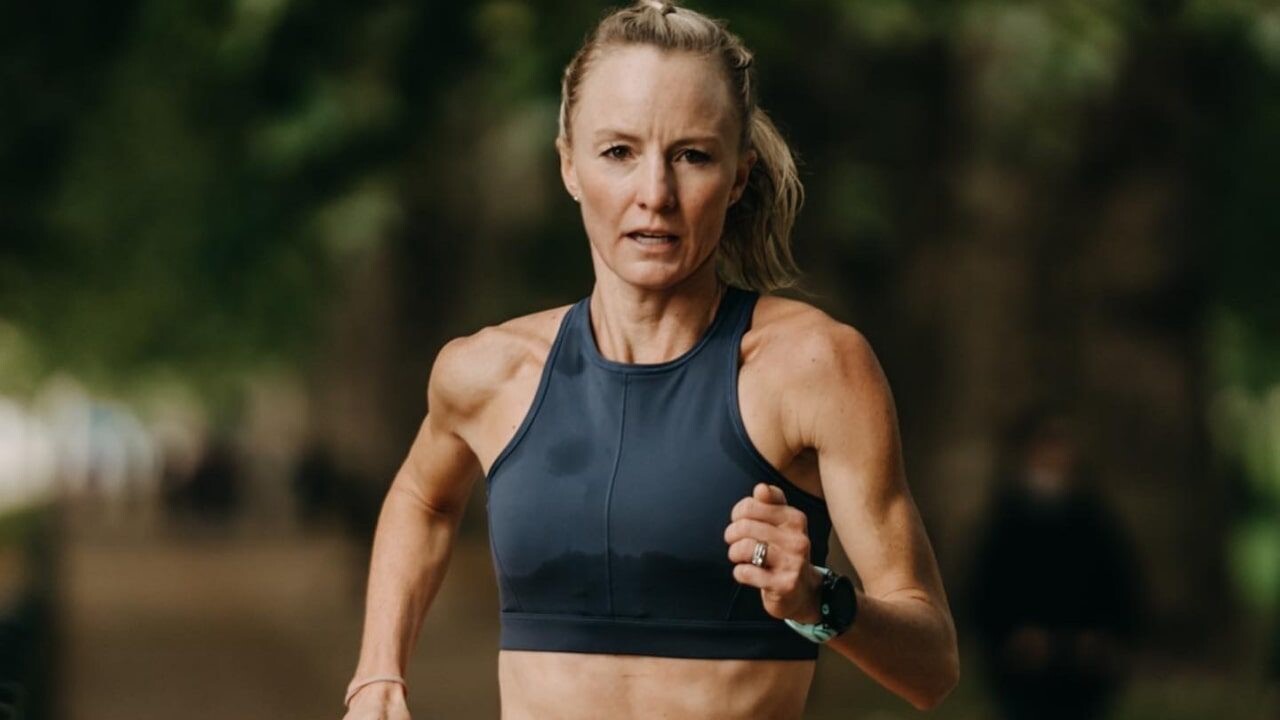
If you’re having trouble figuring out a mantra that resonates with you, take inspiration from one of these elite runners instead:
Shalane Flanagan: Run without any regrets
Kara Goucher: Fighter
Deena Kastor: Go Faster. Push Harder. Today, Define Yourself.
Bill Rodgers: Relentless
It may take some trial and error for you to find a mantra that works for you. Start practicing them in your harder workouts and runs so that by the time race day arrives, you’re armed with the words to get you to the finish line.
by Brittany Hambleton
Login to leave a comment
High school cross-country runner disqualified for swearing
Michigan High School Cross-Country Championships, a runner was disqualified after cussing in disbelief at his second-place finish.
Parchment High School’s Garrett Winter passed a competitor during the final 100 metres of the race and celebrated by yelling “Holy f@#king s^*t, let’s go” as he crossed the line. You can check out the video below. Winter is the second runner to cross the line.
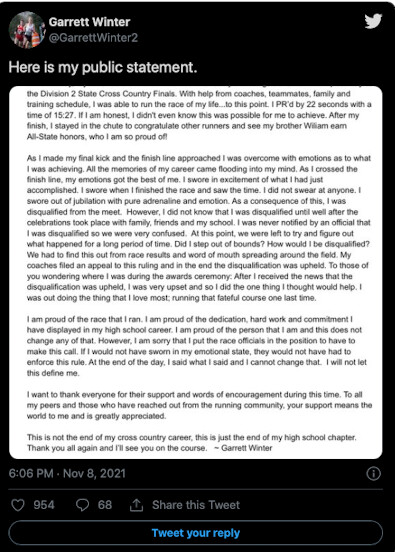
His disqualification has caused a stir online, but according to the National Federation of High School Sport (NFHS), the governing body for U.S. high school sports, states that “Unacceptable conduct by a competitor, failing to follow the meet rules and directions of a meet official, or using profanity that is or isn’t directed at someone will result in disqualification from the event.”
According to his Twitter, his coaches appealed the ruling, but it was upheld. Winter ran a 22-second personal best in the 5K race for a time of 15:27 – a time that he didn’t think was possible. He issued a Twitter apology on Monday night.
Many runners on Twitter are in disbelief over the ruling, as Shalane Flanagan once yelled a similar term after winning the 2017 New York City Marathon and no one batted an eye.
Since Winter’s disqualification, an online petition has gained traction to change Rule 4-6 of the NFHS rule book, to reinstate Winter’s second-place finish. The petition was tweeted out by Canadian marathoner Rob Watson, who recalls saying similar words during his collegiate days at Colorado State University.
by Running Magazine
Login to leave a comment
Shalane Flanagan saved the best for last, finishing the New York City marathon in 2:33:32
It’s not uncommon for elite runners to take as many as six weeks off from running after a grueling marathon.
Then there is Shalane Flanagan, 40, the New York City Marathon champion in 2017, who did the opposite. With all six of the world’s major marathons packed into as many weeks this fall because of the coronavirus pandemic, Flanagan saw an opportunity to do something extraordinary. She decided to run them all — Berlin, London, Chicago, Boston, Tokyo and New York — in under three hours each.

Flanagan, who is retired from professional running, traveled roughly 10,000 miles round-trip with her toddler son for Berlin and London. She ran Chicago and Boston on back-to-back days. Organizers ultimately canceled the Tokyo race, but Flanagan still ran a marathon on her own near her home in Oregon two weeks ago to make up for it. Her slowest time was in Chicago, which she completed in 2 hours 46 minutes 39 seconds. She completed three of the races in under 2:40, including an extremely fast 2:35:04 in London.
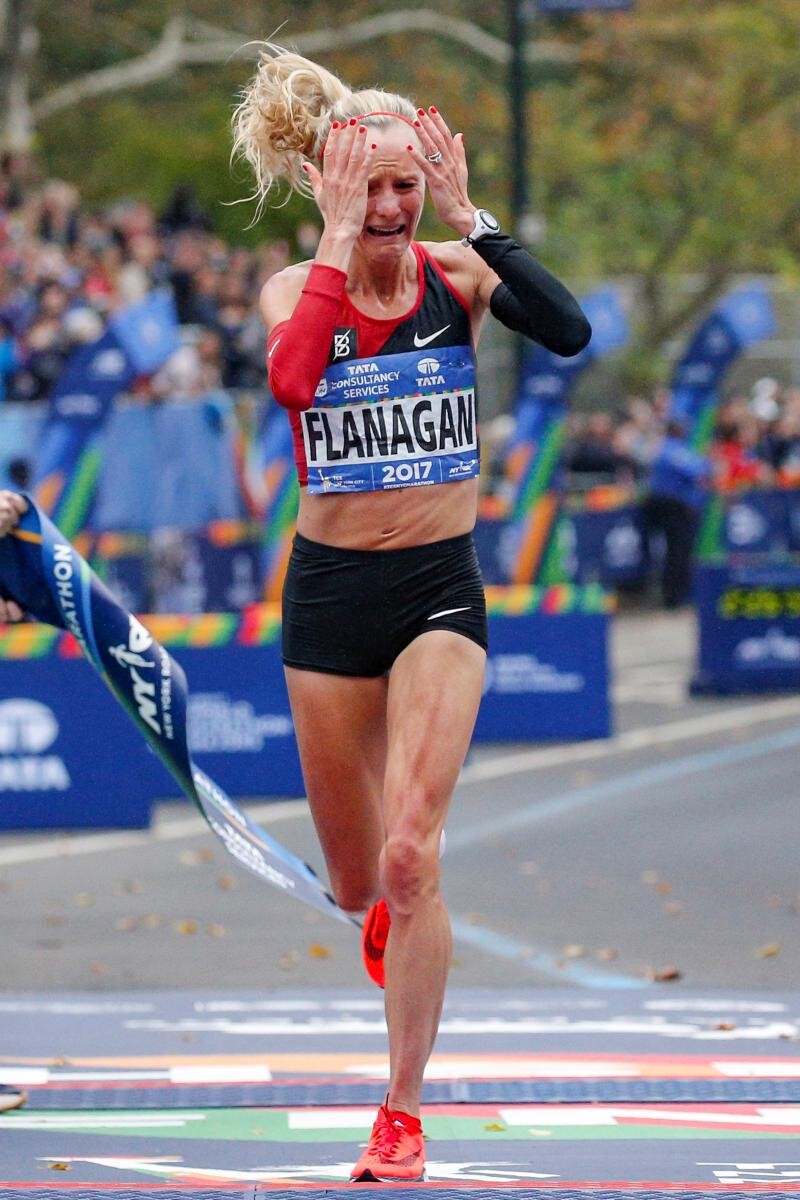
But she saved the best for last, finishing in 2:33:32 in New York.
Login to leave a comment
TCS New York City Marathon
The first New York City Marathon, organized in 1970 by Fred Lebow and Vince Chiappetta, was held entirely in Central Park. Of 127 entrants, only 55 men finished; the sole female entrant dropped out due to illness. Winners were given inexpensive wristwatches and recycled baseball and bowling trophies. The entry fee was $1 and the total event budget...
more...Shalane Flanagan will conclude her six major marathon at New York City Marathon
Sometime before noon in Central Park on Sunday, Shalane Flanagan should cross the finish line of the NYC Marathon. That, alone, will be no small feat for the 40-year-old former Olympic runner.
Now consider this: She will become the first person to ever run the six World Marathon Majors in just six weeks.
Because of the pandemic, the Boston, London and Tokyo Marathons were moved from their traditional spring dates to October, and now all six races are being staged in a 42-day stretch for the first -- and likely only -- time.
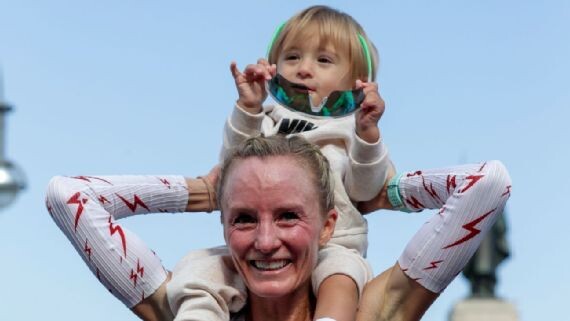
"When I saw how the marathon schedule unfolded, it felt like a once-in-a-lifetime opportunity," said Flanagan. "I coined it an eclipse because it was just so rare this would ever happen. It didn't take long for me to think, 'Why shouldn't I be the one to do it?'"
While Flanagan is no stranger to the marathon distance -- she won the New York Marathon in 2017 -- her mission is all the more improbable as she is technically retired, after announcing her departure from the sport two years ago.
"My retirement coincided with two reconstructive knee surgeries, and I basically couldn't run for a year. Then we hit a pandemic," Flanagan said ahead of Sunday's race (8:30 a.m. ET, ESPN2/ESPN App). "During that time I became a mom and a coach, so there were a lot of life changes, and I realized how much of my mental health is tied into running. I actually really need running. It's not a job for me, it's a passion. I missed having goals. Athletes are so goal-oriented and everyone was goal-less during the pandemic.'"
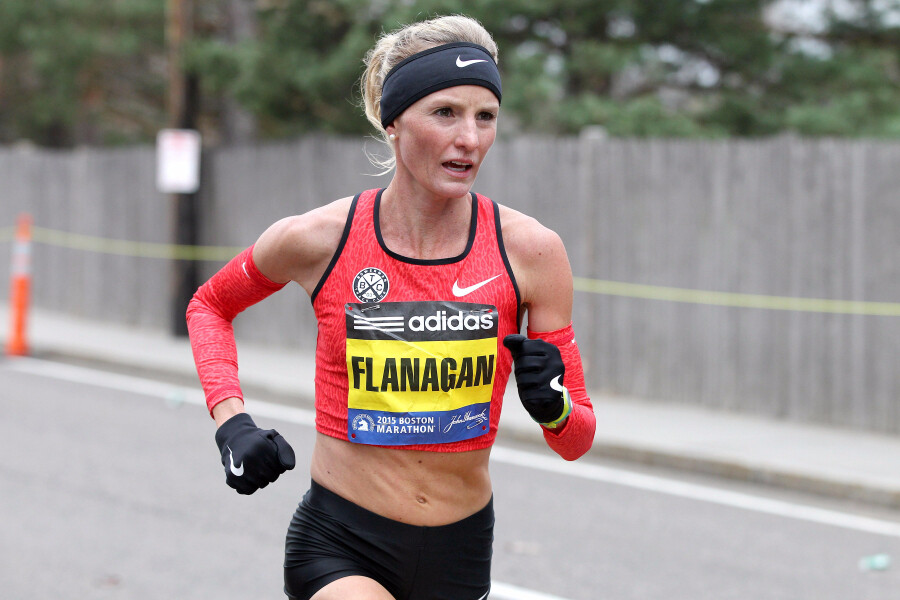
She set a sub-three-hour goal for each of the races and has shattered the mark in each race so far, including a 2:35:04 time in London.
Her current quest has pushed her physically and mentally but she's loved every minute of it. Joined by her 18-month-old son Jack as well as a tight-knit, all-female group that includes her physical therapist, a photographer and a Nike brand manager, Flanagan has awed fans around the world with her globe-trotting journey.
But it's just Shalane being Shalane, according to those who know her best.
"Shalane is always the type to just go after something," said 2020 Olympic steeplechase silver medalist Courtney Frerichs, who trains with Flanagan at Bowerman Track Club in Portland, Oregon. "I remember a few weeks after she won in New York [in 2017], she was back in training with us, fully right back in it, and I could barely keep up with her. That's just who she is.
"I wasn't surprised when she said she was doing this but I have been surprised at just how much fun she's having with it."
For many athletes, the idea of running 157.2 miles of competitive races would hardly be the retirement dream, but most athletes aren't Flanagan, who made a career of the unexpected. She was the first American woman to win in New York in 40 years when she crossed the finish line first in 2017 and is one of just two Americans to medal in the 10,000 meters at the Olympics. Flanagan earned the bronze medal in Beijing in 2008 (and it later was upgraded to silver following a failed doping test by Elvan Abeylegesse). She's always blazed her own trail.
And she didn't venture far away from the sport after officially retiring. She almost immediately began coaching at Bowerman, where she had been based for over a decade. She now worked with many of the younger runners she had been training alongside, including Frerichs.
"She was the driving force in creating a women's team here. She's always been such a leader and has truly always wanted to help others succeed," Frerichs said. "When I look back at this last year, she has played such an instrumental role."
"I basically prepped in six weeks, which is really short in the marathon world," Flanagan said. "But given the context of my lifetime of training, it was appropriate. I wouldn't recommend that though for most people."
After Sunday, she said she has no plans to run for at least a month. But the break likely won't last much longer than that.
"I think at the end I'll be thinking of how much fun we've had. I guess now I've got to dream up another hard challenge."
by D'Arcy Maine
Login to leave a comment
TCS New York City Marathon
The first New York City Marathon, organized in 1970 by Fred Lebow and Vince Chiappetta, was held entirely in Central Park. Of 127 entrants, only 55 men finished; the sole female entrant dropped out due to illness. Winners were given inexpensive wristwatches and recycled baseball and bowling trophies. The entry fee was $1 and the total event budget...
more...5 Marathons Down, One to Go: Takeaways From Shalane Flanagan’s Fall “Eclipse”
The retired 2017 New York City Marathon champion takes inventory of how her attempt to complete six marathons in seven weeks has gone so far (October 18).
Shalane Flanagan has 131 miles worth of World Marathon Majors down since September 26 and 26.2 miles to go on November 7, at the New York City Marathon, to complete all six races this fall. So far? She’s still in one piece and in good spirits, she said.
This fall, Flanagan embarked on what she dubbed “the eclipse,” what we all hope is a once-in-a-lifetime opportunity to run all the major marathons in one season—and, in fact, just seven weeks—due to the rescheduling of big events during the pandemic. On Monday, Flanagan ran her own version of a Tokyo Marathon, the only in-person event that was canceled due to COVID-19, on a 12.4-mile looped flat course near her home in Portland, Oregon. She feared it might be the hardest one, lacking the energy and enthusiasm of the crowds, but she finished in 2:35:14—far from the “slow” time she predicted three days beforehand.
“I think this one is going to be the toughest to really get after it,” she said on Friday. “I’m going to guess that this will be my slowest one, though it will be fun with some friends and family out there.”
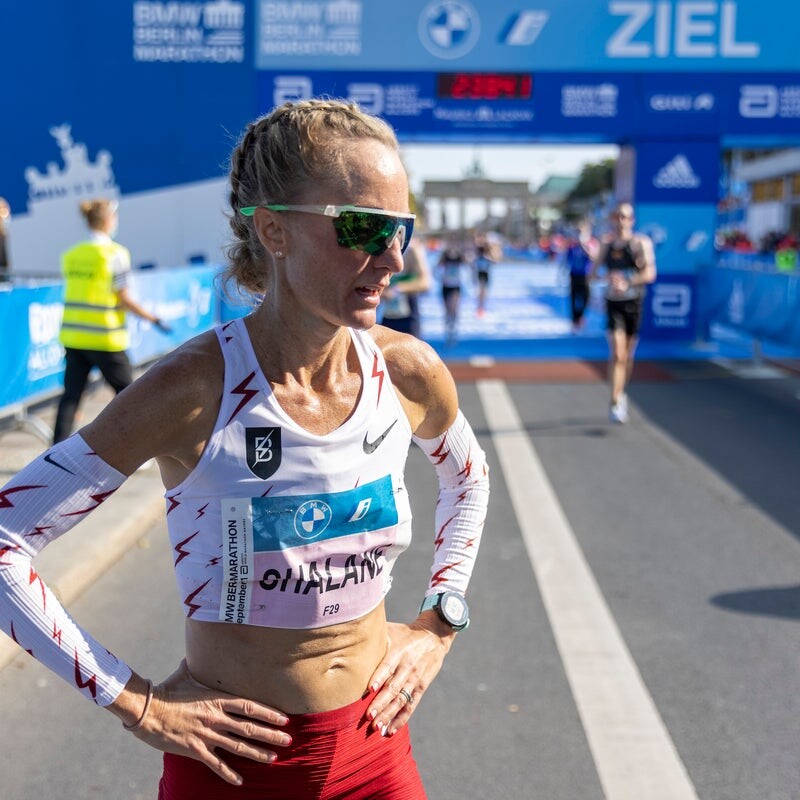
Flanagan, 40, retired from pro running in 2019, but she hasn’t retired from challenging goals, hoping to not just finish the 26.2-mile courses, but clock sub-three-hours on all of them. In addition to her race on Monday, she ran Boston on October 11 in 2:40:34, the day after she had clocked 2:46:39 in Chicago. Prior to that, Flanagan ran 2:35:04 on October 3 at the London Marathon and 2:38:32 on September 26 in Berlin.
Flanagan spoke with Women’s Running on Friday by phone to talk about how she’s measuring her effort, recovering, and learning valuable strategies along the way. Here are a few takeaways before she takes on the grand finale on November 7, at the New York City Marathon, a race she won in 2017.
You can let the pace come to you.
Flanagan has never experienced racing that is solely dictated by how she feels at the starting line. When it was her job to compete, the strategy was not always up to her—it was largely guided by the field.
“It’s fun because we figure out how hard we want to work each day—when you’re an elite, the race and other people are influencing how you run,” she said. “It’s now up to me on the day, how much I want to suffer. It’s a completely different dynamic. It’s like a different sport to me.”
The result? After racing the Boston Marathon five times, 2021 was the most enjoyable one yet. And the recreational athletes running around her are equally thrilled. One even pulled out a phone to FaceTime a friend to show he was racing with Flanagan.
“Normally I never feel in control at Boston. I get to mile 17 and I feel like trash. I never feel full of running, with the exception of maybe my first Boston because it was a kind of slow race. But the other times, the wheels were coming off and I didn’t enjoy it,” Flanagan said. “This was just a completely different experience and it was so fun and refreshing to have that.”
To decide on pace, Flanagan said she’s been looking at the weather, considering if she has a friend to run with that day, and how she feels when she starts. Then she lets the pace reveal itself.
“What feels sustainable, knowing that I’m not going max effort in any one of these?” she said. “Where’s that fine line that I can still recover as fast as possible but still dip my toe into that uncomfortable-ness that I’m craving?”
But even seasoned pros make rookie mistakes.
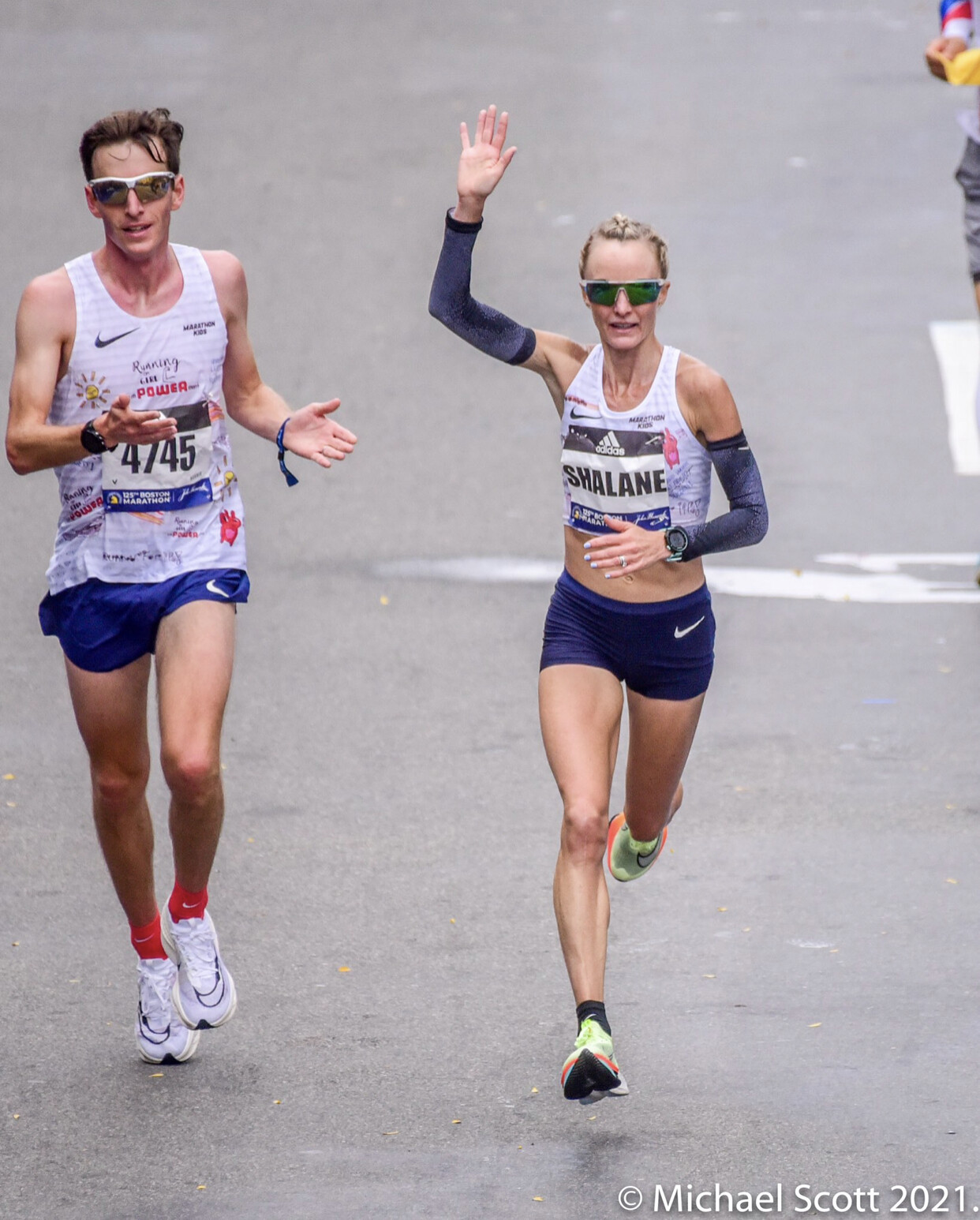
Although London was only her second race, it took a lot out of Flanagan, mostly because she made a mistake all of us can relate to: she went out too fast. She still finished in 2:35:04, but suffered during the second half (she ran 1:15:04 in the first 13.1 miles and 1:20:00 for the second).
“I had a cold and ran way too hard. That was the low so far,” Flanagan said. “I thought I maybe got myself in a pickle, with the [swollen] ankle, the cold, and all the travel, I was a little bit nervous about the whole thing. But now I can sniff the barn. I’ve physically rebounded.”
It was also the one race that she didn’t have a friend to run with, so she started in the wave with the sub-elite men.
“There was this vibe of competitiveness and of course I’m a competitive person so I fed off of it,” she said. “Then I got to 20 miles and I was like, ‘Uh-oh, You shouldn’t have done that.’ It backfired big for me. I learned my lesson on that one. That’s not the point of what I’m doing.”
Recovery is the name of the game.
Between the marathons, Flanagan pulls out all the old recovery tricks she’s learned along the way. Although unconvinced that ice baths make a big difference, she still did one between the back-to-back Chicago and Boston marathons. The travel and the running produce a lot of inflammation. She gets massages and physical therapy work twice a week after having no body work since stepping away from competition.
During her preparation before the attempt began in Berlin, she tried back-to-back long runs, including a 21-miler on a flat course at 6:40 pace followed by a hilly 21-miler at 6:20 pace the next day. When it came to the real-life scenario, she ended up feeling better in Boston than she did the day before in Chicago (“Which is kind of weird and kind of blew my mind,” she said.)
“I did a really good job hydrating, knowing those two were both going to be pretty humid marathons,” she said. “I think that’s why I came back well in Boston, because I did such a good job fueling and hydrating in Chicago, but I’ve been nonstop hungry since then.”
Reconstructed knees can take it, so far.
After retirement from competition in 2019, Flanagan had surgery on both of her knees and a long rehabilitation period afterward. So far, she hasn’t felt any pain and she’s worked with the Nike Sports Research Lab to have scans of her tendons and knees to monitor any damage through her training a racing.
“When I get back from each segment, they scan them to make sure the tissue in my knees is OK,” Flanagan said. “Anecdotally, I feel nothing and we’re actually seeing a strengthening of my quads—there’s no breakdown, which is incredible. My knees actually feel better than they did a year ago.”
The only hiccups so far occurred after the London Marathon, when she caught a cold and had a bit of an ankle flair up. It looked like she rolled the ankle, but she didn’t.
“London by far was the hardest for me. I didn’t pace myself well, so I had to stop and walk,” Flanagan said. “I was really tentative between London and Chicago. I didn’t run very much. The ankle was a low-level irritation. Maybe I tied my shoes too tight and got a tendon irritation? I have no idea what I would have done, but my physical therapist has been taping it to give it more stabilization.”
The super shoes help.
While the runner still needs to power the body over 26.2 miles, it’s no great secret that the newest models of shoes, like the Nike AlphaFly, can help ease the wear and tear on the legs, absorbing more of the shock as we pound the pavement day in and day out. Flanagan believes that the technology is a nice tool to have to reach her audacious goal.
“I think the foam is definitely a game changer in terms of shock absorption,” she said. “It’s been to my benefit to be able to come back. But at the end of the day, if you still aren’t fit enough to keep up with the shoes, you can still walk like I did in London. But typically my quads are sore after Boston. I have some other soreness but the shoe allows a quicker recovery.”
The New York City Marathon finish line will be a special place, once again.
When Flanagan won the 2017 New York City Marathon, it was the victory of her career. She had always believed she had the ability to win a World Marathon Major but as she edged toward the end of her competitive days, she started losing hope that it might be a box she would leave unchecked.
When she approached the finish line that year, with a fist pump and a “f*ck yes!” the stretch of Central Park by Tavern on the Green instantly became sacred ground. But after completing six marathons in seven weeks, will it be doubly so?
“I think any time people set hard goals and achieve them, yeah I think it’ll be a big celebration with my team who’s helped me do this. We’ve had so much fun and I’ll be sad that it’s over, to a degree because I’ve formed a really great team around me to do this and we’ve had a blast,” Flanagan said. “But it’ll be fun to dream up another adventure. There’s great phases in life to have these crazy things going on and then it’ll be nice to get back to some normalcy, not traveling the world running marathons.”
by Erin Strout (Women’s Running)
Login to leave a comment
Nell Rojas was so ready for Boston and ended up sixth setting a PR and finishing first American while Shalane Flanagan finishes her 4th major
The top US woman at the Boston Marathon was Nell Rojas from Boulder, Colo., placing sixth overall in a personal best 2 hours, 27 minutes, 12 seconds. It was her fourth Marathon.
She paced the pack for the first 10 kilometers, which was not part of her plan.
“I was expecting this one to go out fast and to just be able to hang on to the back of the pack,” said Rojas. “I never lead, so that was interesting for me.”
Despite being the top US finisher, Rojas believes she has plenty of room for improvement, citing downhills and staying relaxed in the pack as weaknesses.
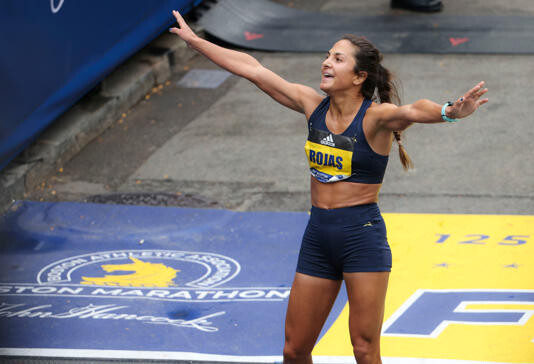
“I learned a lot,” said Rojas. “I think that now that I know the course I can alter my training accordingly and run faster next time.”
Rojas who finished ninth at the 2020 Olympic Trials in 2:30:29, ran for the University of Northern Arizona and spent much of her mid-20s focusing on triathlons before transitioning back to distance running in 2018. Before Monday, her personal best in the marathon was 2:28:06.
Rojas is a coach in Boulder, where she developed a running and strength training program for all ages alongside her father, Ric Rojas.
Nell credits her father with being a role model athletically.
“Just growing up with that inspiration, trying to follow in his footsteps has been super helpful,” she said. “He has been my biggest supporter and cheerleader.”
The second American finisher was Elaina Tabb of Allison Park, Pa., She finished 12th in 2:30:33 in her first major marathon. Much of Tabb’s prior experience came in the half-marathon, where she placed 64th in the 2018 World Championships. She finished 24th at the 2021 Olympic Trials in 10,000 meters.
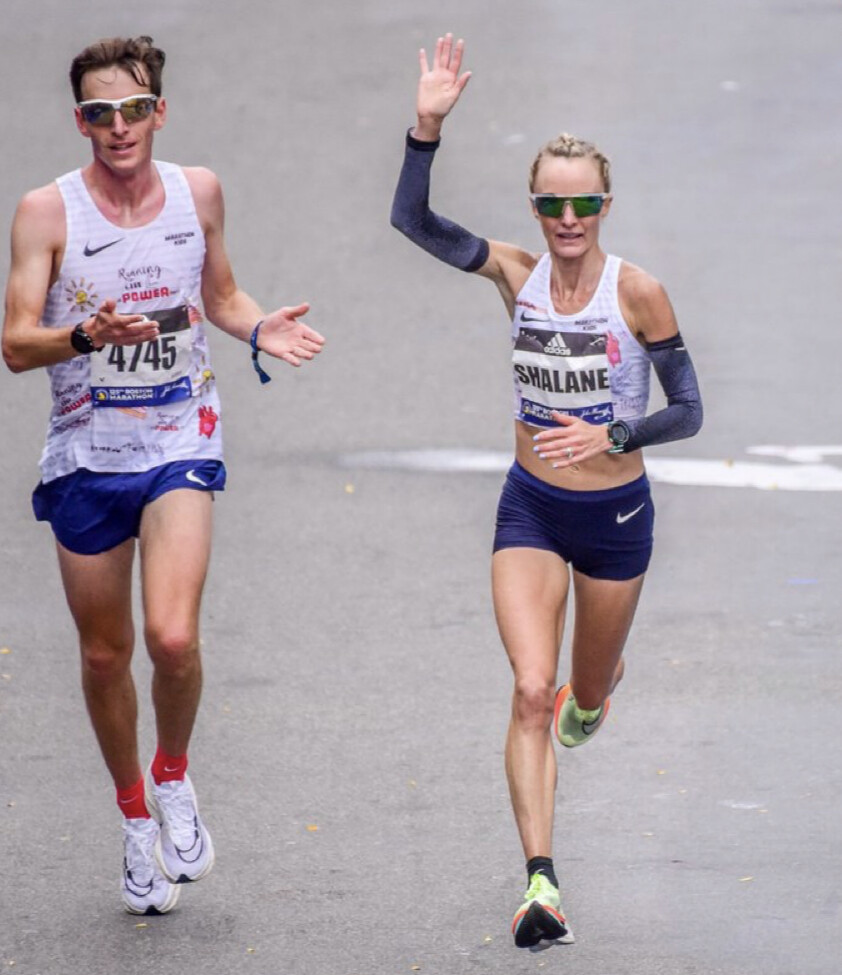
Marblehead native Shalane Flanagan, a former New York City Marathon winner and Olympic 10,000-meter silver medalist, also competed, just one day after running the Chicago Marathon. She placed 33rd on the women’s side in both races, finishing Boston in 2:40:36 and Chicago in 2:46:39. Flanagan retired in 2019 but returned this year in an attempt to run all six majors under three hours. Her average after running four marathons in 16 days is 2:40:13. Her time in Berlin (9/26) was 2:38:32 and London (10/3) 2:35:04.
2018 Boston Marathon champion Desiree Linden placed 16th race with a time of 2:35:25. It wasn’t the performance for Linden hoped for, but she enjoyed the experience on one of her favorite courses.
“I was just excited to get out there,” said Linden. “Yeah, I didn’t have the day that I wanted but it was a pleasure to be back on the course and see the crowds.”
Linden plans to run the New York City Marathon on November 7. Boston was her main focus but is glad to have another race to run.
“It’s nice to have the next one,” said Linden. “To be able to say ‘Hey maybe this one will build and help me get ready for that.’ ”
Login to leave a comment
Boston Marathon
Among the nation’s oldest athletic clubs, the B.A.A. was established in 1887, and, in 1896, more than half of the U.S. Olympic Team at the first modern games was composed of B.A.A. club members. The Olympic Games provided the inspiration for the first Boston Marathon, which culminated the B.A.A. Games on April 19, 1897. John J. McDermott emerged from a...
more...Ruth Chepngetich Marks First US Race With First-Place Finish in Chicago Marathon
Ruth Chepngetich marked her first appearance racing in the U.S. with a huge victory at the 2021 Bank of America Chicago Marathon.
After dropping out of the Olympic Marathon in August due to an injury, Kenya’s Ruth Chepngetich, 27, came to the Chicago Marathon eager for a victory.
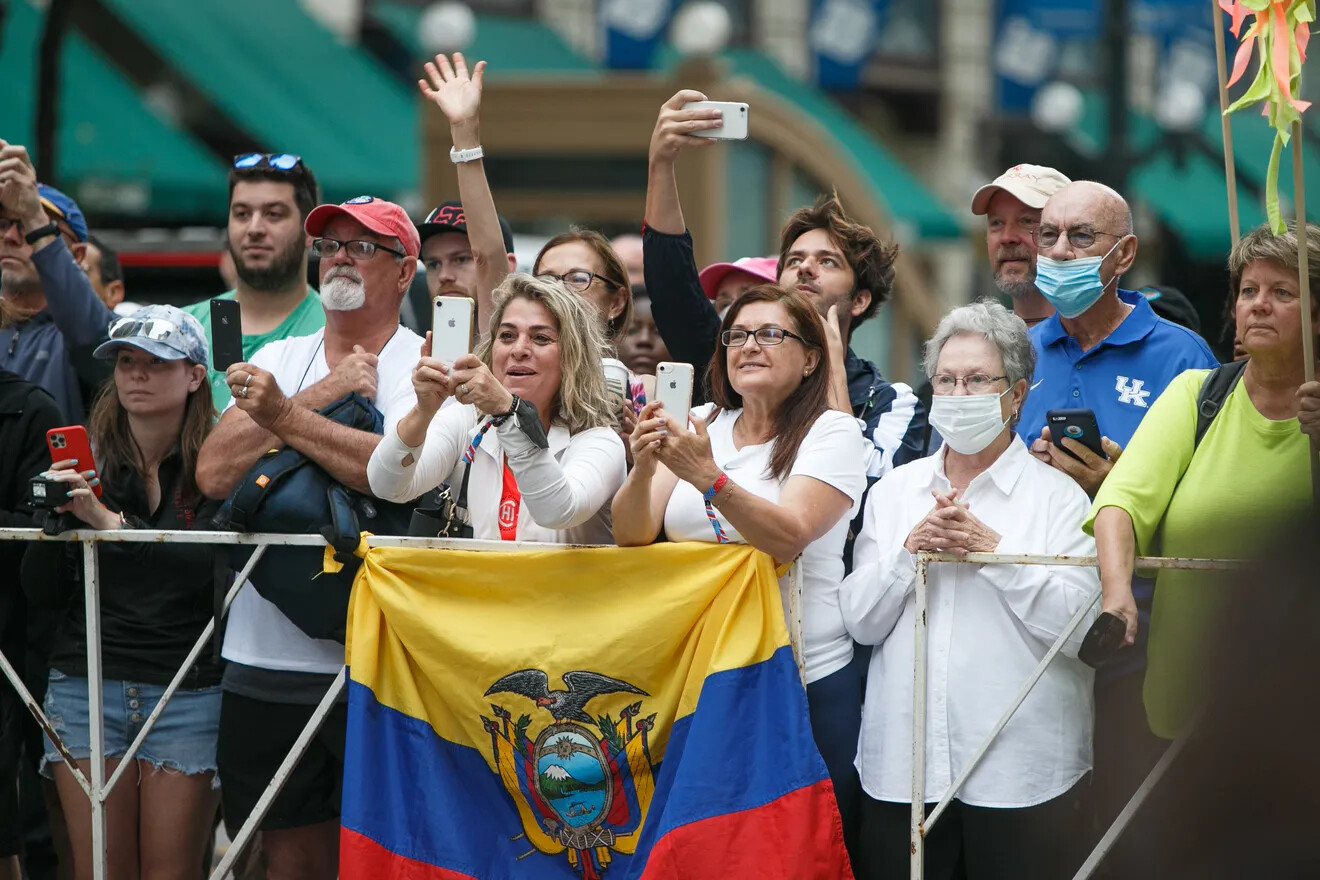
She blasted off at world record pace, running 15:37 for the first 5K and dropping her male pacer, Johnny Rutford, by around mile 8.5. But by mile 10, she'd slowed dramatically. Still—despite running much of the race alone and clocking a 5:53 mile between miles 23 to 24—she’d banked enough of a lead to hang on for the victory, crossing the line in 2:22:31
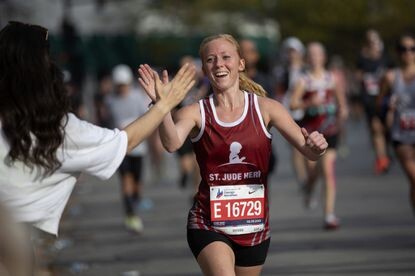
Since the Kenyan sensation made her marathon debut in 2017, she has finished in the top three of every race she has completed and Chicago was no different.
Taking an early lead in the race, Chepngetich beat out American competitors Emma Bates and Sara Hall and crossed the finish line well ahead of the rest of the elite women's field.
Chicago marks just the latest in a series of wins for Chepngetich, who also won in Dubai, Istanbul (twice), and at the 2019 IAAF World Championships. But it also marks a big return after a disappointing performance in the Tokyo Olympics.
While she went into the Olympics as the favorite for gold, she struggled during the race and dropped out around the 30K mark, her first DNF at the marathon distance.
Chepngetich holds a marathon personal best of 2:17:08, making her the fourth fastest woman in history.
“I have never raced in the States and making my debut in such a great race like the Bank of America Chicago Marathon is more than a dream to me,” said Chepngetich. “I will give all myself trying to run as fast as possible. The presence of such a wonderful elite field will boost me.”
Shalane Flanagan finishes 25th in the women's race at the #ChicagoMarathon in 2:46:39. Now she has less than 22 hours to get to the starting line of the #BostonMarathon. Her times so far: Berlin, 9/26, 2:38:32 London, 10/3, 2:35:04 Chicago, 10/10, 2:46:39
Login to leave a comment
Bank of America Chicago
Running the Bank of America Chicago Marathon is the pinnacle of achievement for elite athletes and everyday runners alike. On race day, runners from all 50 states and more than 100 countries will set out to accomplish a personal dream by reaching the finish line in Grant Park. The Bank of America Chicago Marathon is known for its flat and...
more...Shalane Flanagan to run 6 marathons in 42 days
Nearly three years after Shalane Flanagan officially retired from elite racing, she’s toeing the line of her marquee event again — not once, but six times in 42 days. With five of the six World Major marathons coming up in the next few weeks, the 16-time national champion will be aiming to run each of them in less than three hours, and then to run a sixth to make up for the postponed Tokyo Marathon.
Because of delays caused by COVID-19, five of the six World Majors are being crammed into a tightly packed fall schedule. Flanagan’s marathon of marathons will start in Berlin on September 26, the same course where she ran her personal best of 2:21:14 in 2014 and became the fourth-fastest American marathon runner of all time. She’ll have one week of recovery before heading to the U.K. to compete in the London Marathon, and from there she’ll return to North America where she’ll run the Chicago Marathon on October 10 and turn around the very next day to run the Boston Marathon on October 11.
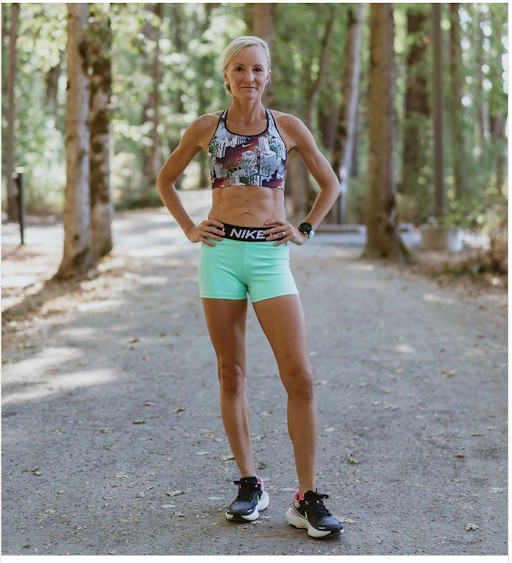
The Tokyo Marathon was to be her next race on October 17, but organizers postponed the race again until March 2022. In its place, Flanagan will travel to Portland, Oregon to run her fifth marathon in four weeks. She’ll then have three weeks of recovery before completing her challenge at the New York City Marathon on November 7. New York will be a special place to end her gruelling series, since it was there that she became the first American woman to win the race in 40 years in 2017.
Flanagan retired from professional running in 2019, and since then has had two reconstructive knee surgeries, become a coach with the Bowerman Track Club and adopted a baby boy. In an interview with Self, she explained that she’s taken on this challenge as a way to “reunite” with running after retirement and knee surgery.
“I felt the need to set some goals again,” she said. “Realizing this was a once in a lifetime opportunity presenting itself, with six major world marathons in 42 days, I feel like I’m doing it for myself, for my son, and for young women to showcase the connection between mental and physical health and how important of a role athletics can play in your life.”
Login to leave a comment
Three years after retirement, Shalane Flanagan will run Berlin, London, Chicago, Boston and one other marathon this fall
Nearly three years after Shalane Flanagan officially retired from elite racing, she’s toeing the line of her marquee event again — not once, but six times in 42 days. With five of the six World Major marathons coming up in the next few weeks, the 16-time national champion will be aiming to run each of them in less than three hours, and then to run a sixth to make up for the postponed Tokyo Marathon.
Because of delays caused by COVID-19, five of the six World Majors are being crammed into a tightly packed fall schedule. Flanagan’s marathon of marathons will start in Berlin on September 26, the same course where she ran her personal best of 2:21:14 in 2014 and became the fourth-fastest American marathon runner of all time.
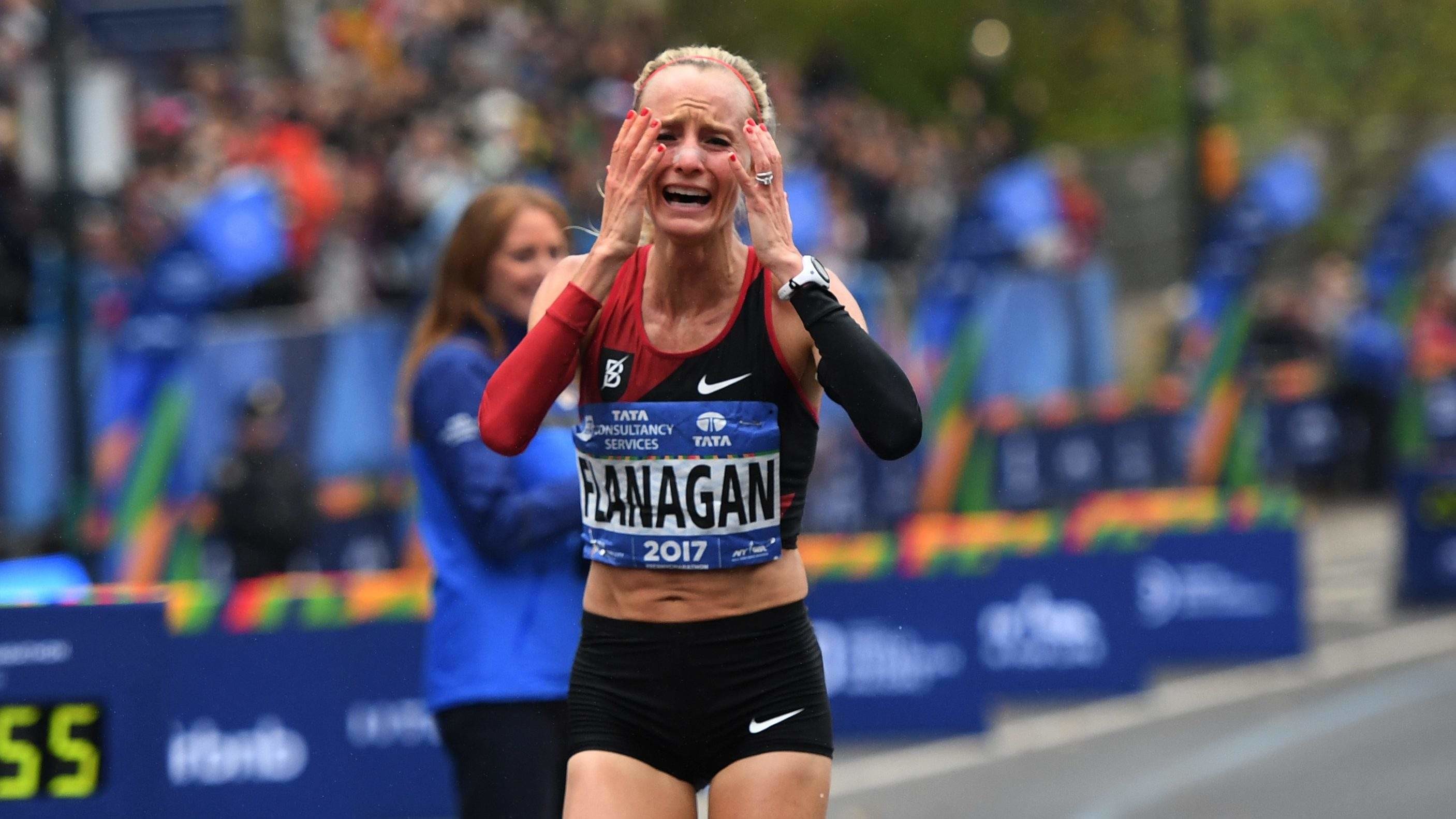
She’ll have one week of recovery before heading to the U.K. to compete in the London Marathon, and from there she’ll return to North America where she’ll run the Chicago Marathon on October 10 and turn around the very next day to run the Boston Marathon on October 11.
The Tokyo Marathon was to be her next race on October 17, but organizers postponed the race again until March 2022. In its place, Flanagan will travel to Portland, Oregon to run her fifth marathon in four weeks.
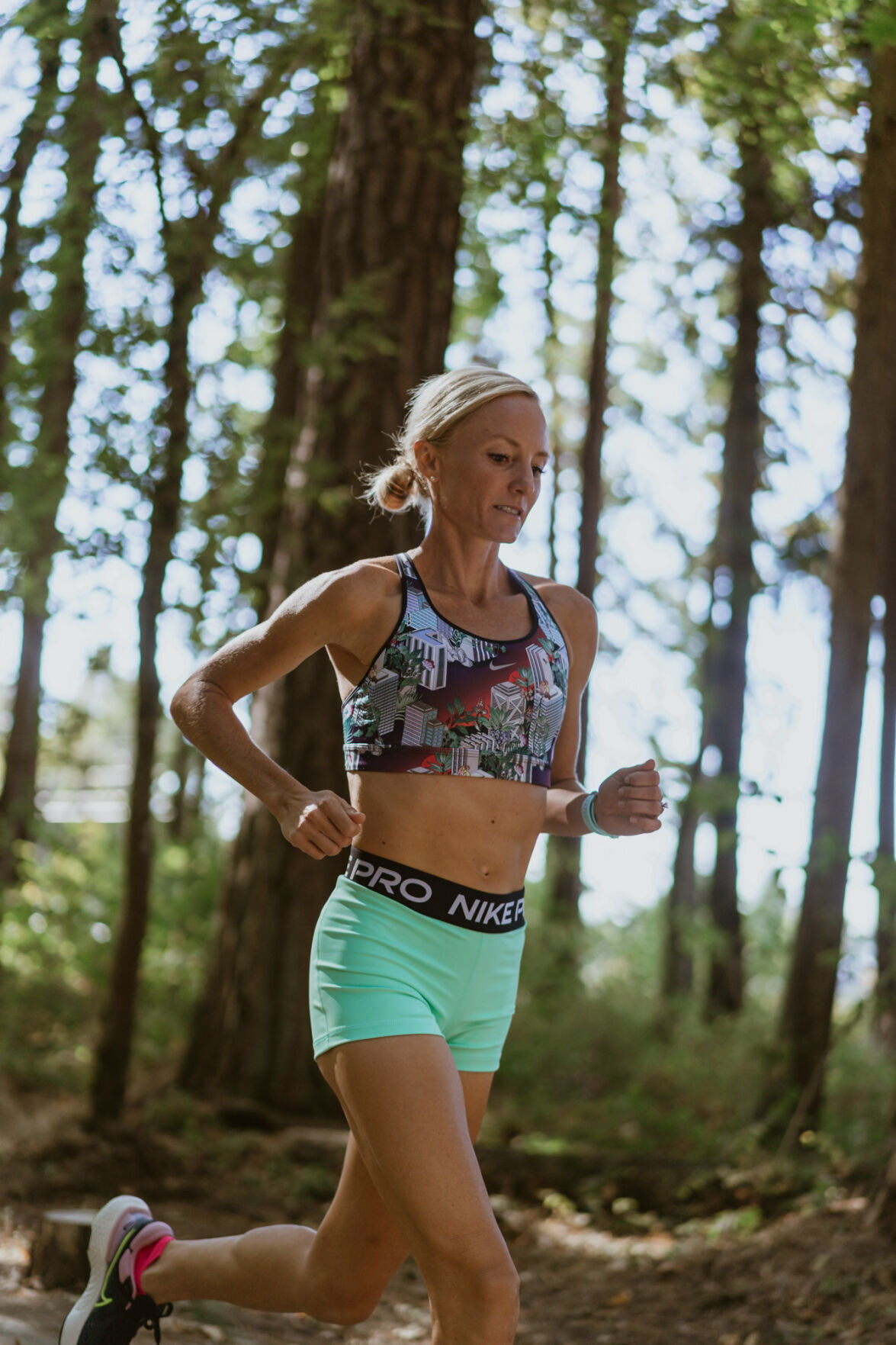
She’ll then have three weeks of recovery before completing her challenge at the New York City Marathon on November 7. New York will be a special place to end her grueling series, since it was there that she became the first American woman to win the race in 40 years in 2017.
Flanagan retired from professional running in 2019, and since then has had two reconstructive knee surgeries, become a coach with the Bowerman Track Club and adopted a baby boy. In an interview with Self, she explained that she’s taken on this challenge as a way to “reunite” with running after retirement and knee surgery.
“I felt the need to set some goals again,” she said. “Realizing this was a once in a lifetime opportunity presenting itself, with six major world marathons in 42 days, I feel like I’m doing it for myself, for my son, and for young women to showcase the connection between mental and physical health and how important of a role athletics can play in your life.”
by Brittany Hambleton
Login to leave a comment
TCS London Marathon
The London Marathon was first run on March 29, 1981 and has been held in the spring of every year since 2010. It is sponsored by Virgin Money and was founded by the former Olympic champion and journalist Chris Brasher and Welsh athlete John Disley. It is organized by Hugh Brasher (son of Chris) as Race Director and Nick Bitel...
more...CAS report on Shelby Houlihan explains reasons for four-year ban
In June, American 1,500m record-holder Shelby Houlihan was given a four-year ban by the Athletics Integrity Unit (AIU) after testing positive for the steroid nandrolone in December 2020. The Bowerman Track Club athlete appealed the ban and attempted to prove her innocence, since the athlete was hoping to race at the U.S. Olympic trials, but the Court of Arbitration for Sport (CAS) upheld her suspension. The AIU has now released the 44-page decision into her case, upholding the ban. Houlihan will not be able to compete until January, 2025.
To recap, the substance found in Houlihan’s sample was nandrolone, specifically 19-norandrosterone (19-NA), a steroid sometimes found in pork offal (pig organ meat). She claimed the positive result was due to having ingested pork offal in burrito from a food truck the night before she was tested, but the CAS did not accept her explanation and upheld the AIU’s charge. Houlihan also submitted a hair test and a lie detector test, both supporting her innocence, but these were found to be inadequate.
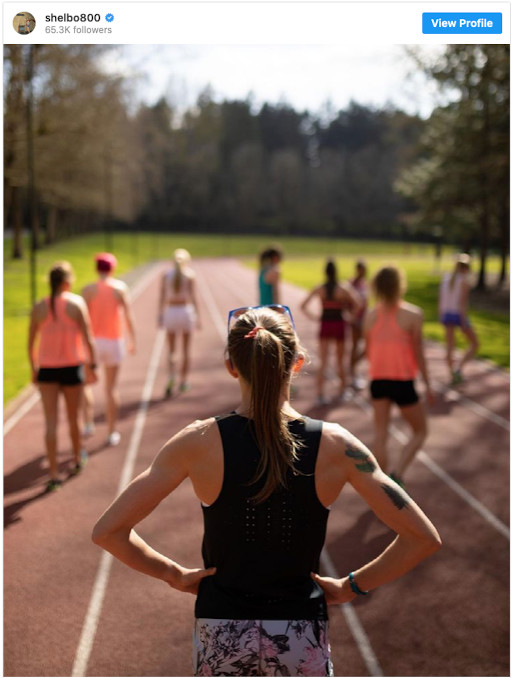
The decision included the following statement regarding the evidence against Houlihan:
“The Athlete’s explanation that the 19-NA in her sample resulted from her consumption of the meat of an uncastrated boar simply cannot be accepted. The explanation presupposes a cascade of factual and scientific improbabilities, which means that its composite probability is (very) close to zero.”
Specifically, the CAS panel found that though it was possible that Houlihan unwittingly ingested the meat of an uncastrated boar, for various reasons it was highly unlikely, and moreover, that even if she had, it would not account for the relatively high levels of nandrolone found in her samples. It found that the nandrolone found in her samples was consistent with that found in products commonly sold on the Internet for the purpose of enhancing athletic performance.
Several of Houlihan’s teammates defended her as a clean athlete, including Courtney Frerichs, who was with her when she ate the burrito (and who ate from the same food truck). Frerich’s sister, Lindsey Frerichs, who also ate with them that night, provided a witness statement, as did Bowerman coach Shalane Flanagan and athletes Matt Centrowitz (whom Houlihan was dating at the time) and Karissa Schweizer.
Despite their testimonies, the court found Houlihan to be guilty, saying she failed to provide a plausible explanation for the presence of nandrolone in her urine sample, and concluded that the anti-doping rule violation she was charged with must have been intentional.
The ban forced Houlihan to miss the U.S. Olympic trials and the Tokyo Olympics, where she was assumed to be a medal favourite, and it will prevent her from competing at the upcoming World Championships and the Paris 2024 Summer Games.
Editor’s update Sept. 3, 2021: According to a story on LetsRun.com, Houlihan plans to appeal her case to the Swiss Federal Tribunal.
Login to leave a comment
SARA HALL RUNS FASTEST HALF MARATHON BY AMERICAN THIS YEAR, MISSES RECORD ATTEMPT
Hall clocks 68:44 in return to Cottage Grove as part of buildup for Chicago Marathon in October, now boasts three career-sub 69 performances
Sara Hall has produced two of the strongest half marathon performances in U.S. history during the past 13 months in Cottage Grove, Ore., but just like last year, Saturday’s effort along the Row River bike path came up short of her pursuit of the American record.
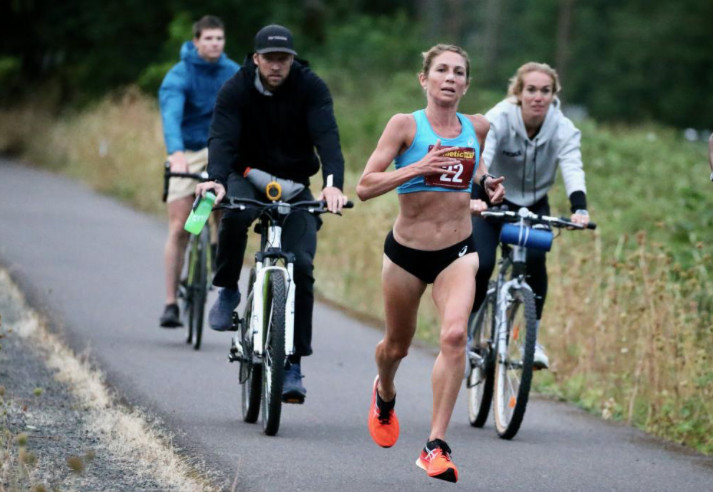
Hall, representing ASICS, clocked 68 minutes, 44 seconds, after she ascended to the No. 6 all-time U.S. competitor last year by running 68:18 along the Harms Park boat ramp parking lot in Cottage Grove.
Hall, who became the fastest American and No. 19 performer in the world this year, now has three career marks under 69 minutes. She also ran 68:58 at the Houston Half Marathon last year.
Molly Huddle still holds the record of 67:25 from the 2018 Houston Half Marathon.
Hall, 38, joined Shalane Flanagan, Jordan Hasay, Emily Sisson and Huddle as the only American women with at least three career sub-69 performances on record-eligible courses.
Hall used Saturday’s opportunity as part of her preparation for the Chicago Marathon, scheduled for Oct. 10.
Hall, who ran the second-fastest performance by a U.S. female with her 2:20:32 effort in December at the Marathon Project in Chandler, Ariz., will be again taking aim at the 2006 American record of 2:19:36 held by Deena Kastor.
Login to leave a comment
American record holder Shelby Houlihan receives four-year ban week before Olympic track trials
Accomplished distance runner Shelby Houlihan was handed a four-year ban exactly one week before the start of U.S. Olympic Track and Field Trials.
Houlihan was considered an Olympic medal contender entering this year. The 2016 Olympian holds American records in both the 1500m and 5000m. In 2018, she became the second woman ever to win both distances at the U.S. outdoor championships.
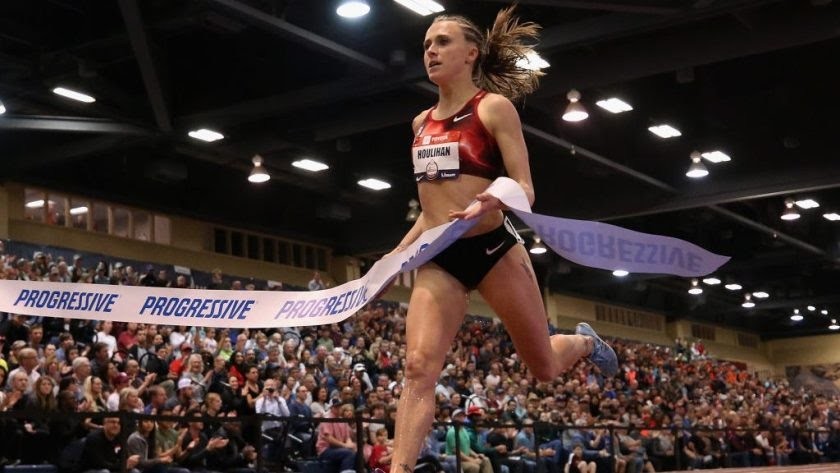
Houlihan placed fourth in the 1500m at the 2019 World Championships.
The 28-year-old had not competed yet this year, which was explained on Monday evening.
Houlihan tested positive for nandrolone in an out-of-competition urine test administered by the World Anti-Doping Agency on Dec. 15, 2020.
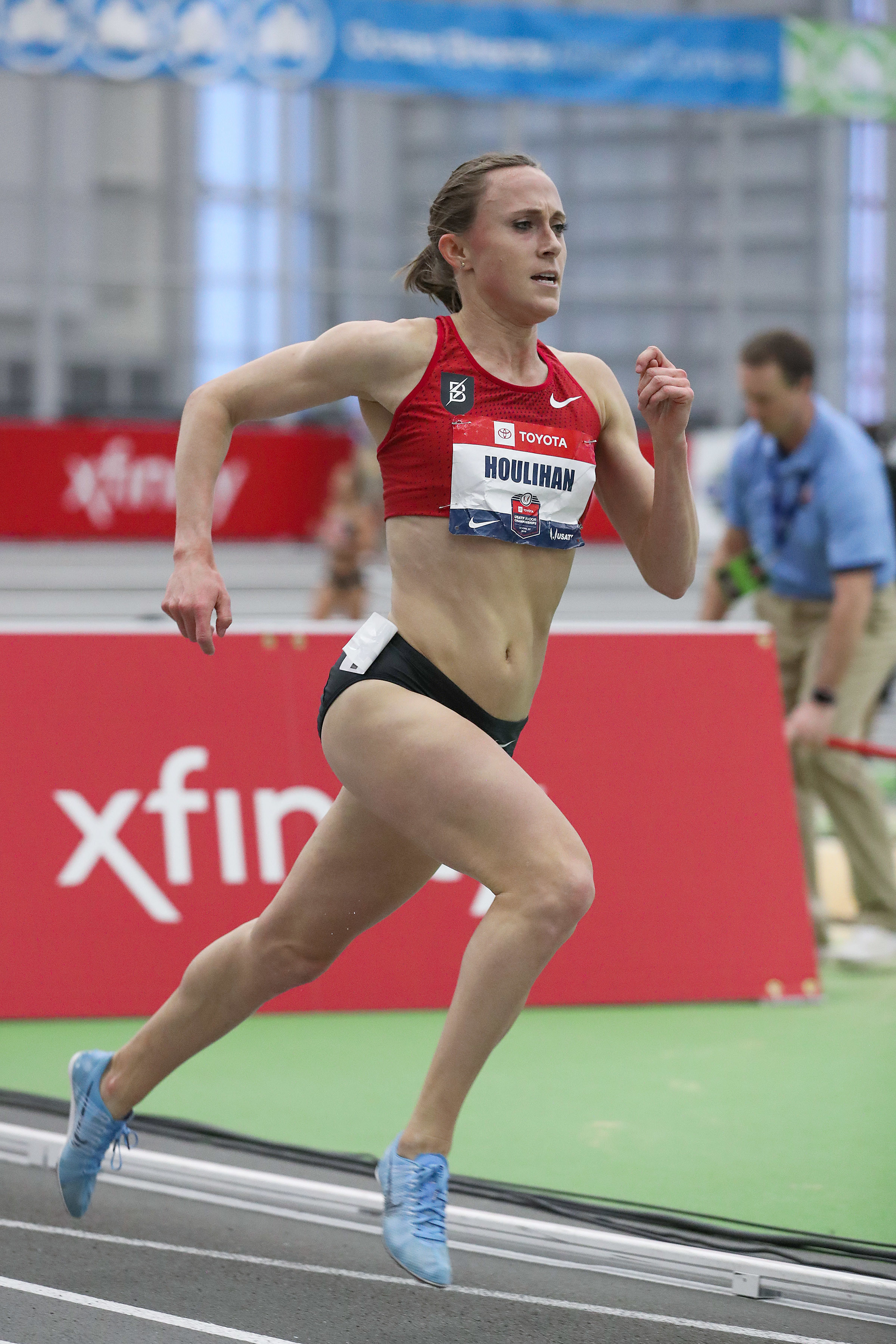
Nandrogen is an androgen and anabolic steroid known to increase muscle mass.
In a virtual press conference, well-known sports attorney and founder of Global Sports Advocates Paul Greene walked reporters through Houlihan’s case, alongside Houlihan and Bowerman Track Club coaches Jerry Schumacher and Shalane Flanagan, an Olympic silver medalist in the 10,000m.
“Shelby is an innocent athlete,” Greene declared. “What happened to her is entirely unjust.”
“I don’t have the words to articulate the depth of sadness I feel for you,” head coach Schumacher said in his statement.
After being notified of the positive test in January, Houlihan created a food log of everything she had consumed the week prior to the test.
Her team believes the result came from a pork burrito Houlihan purchased at a food truck near her home in Beaverton, Oregon, and ate the night before the 6 a.m. test.
It has been noted in WADA documents that consumption of meat, specifically pig offal, can lead to the presence of nandrolone.
Greene explained that Houlihan initially received a provisional suspension of more than three months, which caused them to opt for a single hearing before the Court of Arbitration for Sport.
In the interim, Houlihan had a hair sample tested and passed a polygraph test in an effort to prove her innocence. Greene hired a private investigator and former WADA scientist to help prove their case as well. He pushed for the sample to be tested at a second lab to no avail.
According to Greene, Houlihan has been tested approximately 100 times since 2016 and has never tested positive or missed a test in that time.
The CAS hearing was held the first week of June, with the final ruling of a four-year ban delivered on Friday, June 11. That would take Houlihan out of the running of the Paris 2024 Olympics as well; she said she is currently unsure of what her future holds.
“I feel completely devastated, lost, broken, angry, confused and betrayed by the very sport that I loved and poured myself into just to see how good I was,” Houlihan said as she fought back tears. “I want to be very clear: I’ve never taken any performance-enhancing substances and that includes the one of which I have been accused. … I do this sport because I love it, I have so much fun doing it and it’s always the best part of my day.
“This sport means everything to me. I believe doping and cheating is weak. … I would never disrespect the sport, my competitors, my teammates, my coaches, my family and my fans this way. I love the sport too much. …
“I’ve always wanted to stand at the top of an Olympic podium with a gold medal around my neck, knowing I did that, and now I am not sure that will ever happen.”
Greene is considering an appeal to the Swiss federal tribunal.
Login to leave a comment
Olympian Amy Cragg Officially Retires and Joins the Puma Coaching Staff in North Carolina
She won bronze in the marathon at the 2017 world championships and ran 2:21:42 at the 2018 Tokyo Marathon—her lifetime best.
Amy Cragg, who represented the U.S. at the 2012 and 2016 Olympics, is officially retiring from professional running. She is now coaching the Puma-sponsored training group alongside her husband, Alistair, in Chapel Hill, North Carolina.
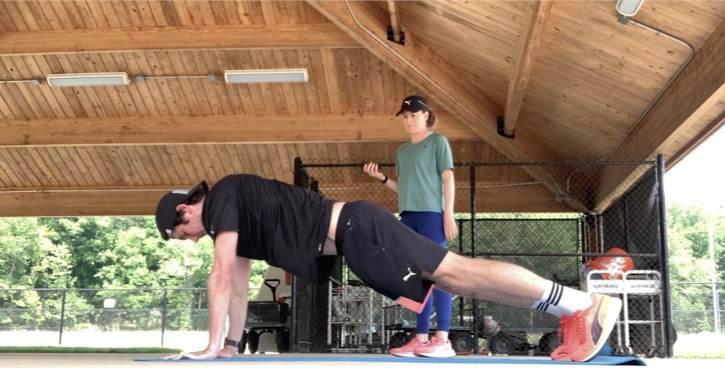
Her career highlights include winning the 2016 Olympic Marathon Trials, finishing third in the marathon at the 2017 world championships, and running a 2:21:42 PR in the 2018 Tokyo Marathon.
Cragg withdrew from the 2020 Olympic Marathon Trials last February, citing illness.
Amy Cragg—who won the 2016 Olympic Marathon Trials, took the bronze medal in the marathon at the 2017 IAAF World Championships, and ran the 2018 Tokyo Marathon in 2:21:42, making her the sixth-fastest American in history at the distance—announced she is retiring from competitive running.
She is now officially a coach with the new Puma-sponsored training group based near Chapel Hill, North Carolina. Her husband, Alistair, is the group’s head coach.
Cragg, 37, said in a phone call with Runner’s World that she took the time she needed to make the decision. “It was definitely time [to retire],” she said. “It’s been great. I’m definitely enjoying life on the other side.”
She had suffered from persistent fatigue over the past couple of years, which kept her from competing at the 2020 Olympic Marathon Trials. Now, she says, she’s feeling well again and running between two and four miles, several times a week, “just to get out there and enjoy it.”
In the summer of 2020, Cragg and her husband drove across the country from their home in Portland, Oregon, where she had trained with Bowerman Track Club for years. They looked at various locations along the way, trying to figure out where to establish Puma’s new training base.
Although they considered different spots at altitude, they ultimately decided the Research Triangle area of North Carolina was ideal for its weather, ease of travel to European track meets and American road races, and the 22-mile, crushed gravel American Tobacco Trail, which has every quarter mile marked. (The Craggs took a wheel out to measure 10 miles of the trail, and the quarters were spot on.)
They also considered medical support in the area, affordability, and job prospects for runners’ significant others.
“I’ve lived in places where people didn’t have a social life or their significant other didn’t have a social life or couldn’t work, and they were depressed,” Cragg said, “and that doesn’t lead to longevity in the sport. We want to create an environment that leads to longevity in the sport. For a lot of people, it takes them a little longer to get there. However long it takes you, we want it to be a good place for that.”
The team currently has Taylor Werner and Fiona O’Keeffe, both of whom are qualified for next month’s U.S. Olympic Track and Field Trials; Steven Fahy, a steeplechaser who currently is nursing a foot injury; and Emmanuel Roudolff-Levisse, a French marathoner. The Craggs—believers in the powers of group training—expect their numbers to grow, albeit slowly.
“We aren’t in a rush to get people,” she said. “We want to get the right people. We’re hoping these are 10-year athletes, not two- or three-year athletes.”
Cragg’s career flourished when she was in her 30s, and she was involved in some of the more memorable moments in Trials history. In 2012, she narrowly missed making the team in the marathon, finishing fourth at the Trials in Houston behind Shalane Flanagan, Desiree Linden (then Davila), and Kara Goucher.
But Cragg (then Hastings) turned her attention back to the track and won the 10,000 meters at the 2012 track trials to earn her first trip to the Games. At the Olympics in London, she finished 11th in 31:10.69, her personal best.
Four years later, at the 2016 Olympic Marathon Trials in Los Angeles, Cragg and training partner Flanagan ran stride for stride together, breaking the race open before the halfway point. But by the 23rd mile, Flanagan was struggling in the heat. Cragg slowed to stay with her, urging her onto the finish. With less than two miles to go, and Linden lurking in the background, Cragg finally left Flanagan and won the race in 2:28:20, waving her visor as she broke the tape.
Linden was second, in 2:28:54, and Flanagan willed herself across the line in third in 2:29:19, where she collapsed and was carried off the course. In Rio, their finishing order was reversed: Flanagan was sixth, Linden seventh, and Cragg ninth, the best collective performance by any country’s three athletes in the event. (The 2016 gold and silver medalists are currently serving suspensions for anti-doping violations.)
Training at times up to 130 miles per week with the Bowerman Track Club in Portland, Cragg qualified for the world championships in 2017 in London. At the race, she moved into third place with 400 meters and sprinted to a bronze medal.
Cragg said that was her top moment as a professional runner. “It kind of just made my entire career worthwhile,” she said.
Seven months later, in Tokyo, she ran her lifetime PR, 2:21:42, taking nearly six minutes off her previous best and putting her among the country’s top runners in history.
Cragg’s world championships bronze marked a renaissance of sorts for American women’s distance running. In Chicago in 2017, Jordan Hasay ran 2:20:57, Flanagan won the New York City Marathon in 2017, and Linden won Boston in 2018.
But after Tokyo, Cragg experienced a series of health setbacks and never was able to regain her top form for a marathon. She ran 15:54 5K in New York in November 2018 and finished third at the U.S. 5K championships, but she raced only twice in 2019. Both races—a 10K and a half marathon—were far from her best. She had planned to run the Chicago Marathon, but pulled out in the summer.
In an interview with Runner’s World at the time, Cragg talked about the fatigue she felt. “I think we just went too hard for too long,” she said. “I ‘cooked myself’ is what I’ll say. Took some time off when we realized it wasn’t coming around for Chicago. Now I’m feeling a lot better and ready to go.”
But citing illness, she withdrew from the 2020 Olympic Marathon Trials in February in Atlanta.
Her only race results from 2020 were pandemic-era intrasquad meets put on by her Bowerman Track Club at a high school track in Portland. Cragg ran a few 400s and 800s at slow paces—seen as fulfilling contractual obligations.
Her peers had nothing but praise for her.
“I’m thrilled for Amy. She’s had a tremendous career,” Linden, who first met Cragg when they were undergraduates at Arizona State University, told Runner’s World in a text message. “If people could have eavesdropped on our long run conversations during our ASU days, they would have laughed at how audacious our goals were. It’s been incredible to watch her check them all off one by one and then accomplish even more. I’m grateful that while being in a hyper-competitive career, Amy’s been able to remain a friend, and I know we’ll have many more conversations about her future goals.”
Shalane Flanagan wrote in a text, “I’m so happy for her. She was a wonderful teammate and one of the toughest athletes I got to train alongside. I treasure all the time spent together chasing big goals and dreams.” 

by Runner’s World
Login to leave a comment
Molly Seidel Racing A Special Edition Of The Atlanta Half-Marathon On The Atlanta Motor Speedway February 28
Gripping the steering wheel of her Audi Allroad while driving on an Arizona highway three days ago, Molly Seidel spoke breezily on her cell phone about what it’s like to go fast. Seidel, whose stunning second place finish at the USA Olympic Team Trials nearly a year ago in Atlanta catapulted her into the national spotlight, enjoys both running and driving fast.
“This thing goes fast,” she said of her car. “I’m a bit of a leadfoot.”
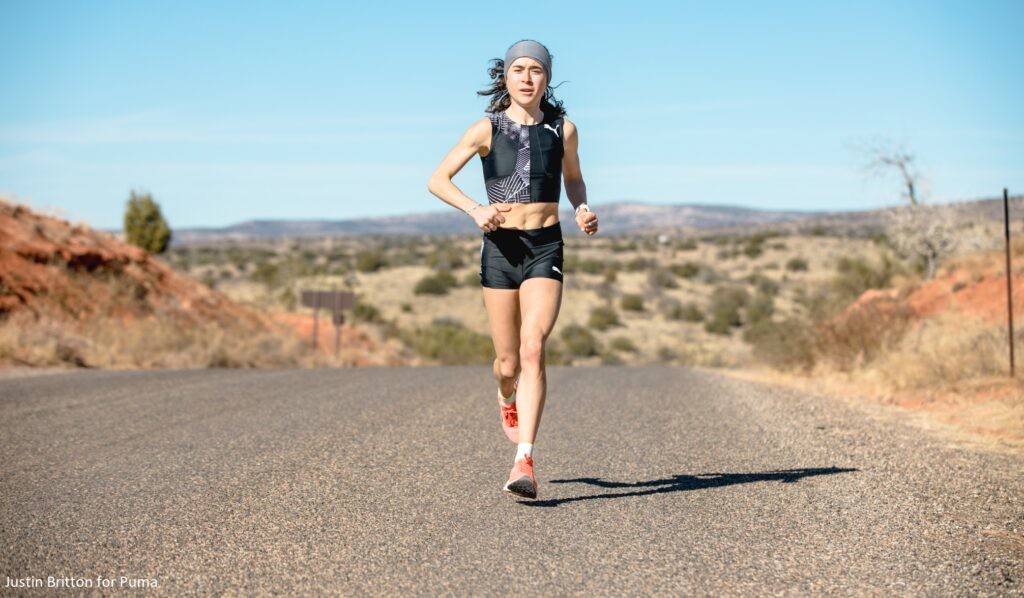
Seidel, 26, will be returning to Atlanta on February 28, where she will run a special edition of the Atlanta Half-Marathon which will be held at the sprawling Atlanta Motor Speedway, partly on the facility’s 1.5-mile race track. The race, part of Atlanta’s Marathon Weekend organized by the Atlanta Track Club, was moved from the streets of the city a year ago to the racetrack grounds in order to offer athletes of all abilities a COVID-safe, in-person running competition. Seidel said she’s never actually run on a racetrack, but she’s very excited by the concept.
“When the race opportunity came up in Atlanta we immediately jumped on that,” Seidel told Race Results Weekly. She added: “I’ve had a lot of exposure to race tracks because my dad and my brother race cars semi-professionally. It’s super cool to watch. I love it.”
Speed is what Seidel will be after in Atlanta. She’ll be using this event as part of her build-up to the Olympic Marathon in Sapporo on August 7, and thinks it fits perfectly into the training plan she and coach Jon Green have devised. She is trying to use as productively as possible the extra year of preparation time she’s been given by the pandemic in advance of the Tokyo Olympics.
“Basically being in kind of a unique position of having already secured the spot several months out we, my coach Jon and I, got to plan backwards a little bit,” Seidel said. “A big part of that is try to, like, get in a combination of strength and speed that I need for Sapporo. For me I really wanted to be able to focus on the half-marathon a little bit more just because… doing stuff on the roads gets me a little bit more excited than doing stuff on the track. The half-marathon is a distance that I haven’t been able to deeply explore yet. It’s been fun getting to learn that distance a little bit better.”
It’s hard to believe that Seidel only ran her first half-marathon on October 26, 2019, at the low-key Cape Cod Half-Marathon in Massachusetts. Facing no competition, she clocked 1:14:10 and finished ahead of the next woman finisher by more than eight and a half minutes. Some five weeks later, she ran her first serious half off of full training, winning the Humana Rock ‘n’ Roll San Antonio & Half-Marathon in a very elite 1:10:27, bettering Shalane Flanagan’s course record by 22 seconds. That performance was pivotal because it qualified her for the Olympic Trials where she made her marathon debut.
Since then, Seidel has lowered her half-marathon best to 1:09:20, a mark she set in a “micro race” outside of Las Vegas last month which only had 37 finishers. For that event, called the Las Vegas Gold Half-Marathon, Seidel said that she went into it with no set goals and just tried to have fun.
“It felt great,” she said of the race which was only for elite athletes. “Really my coach just told me, don’t look at the watch. Just go out, hop between groups of guys as they come back to you, but have fun with it. That’s really what it was. It was just a chance to bust a run, trying to get back into the swing of things, try out the new shoes. Yeah, it was a good day.”
The “new shoes” were her Puma racing shoes, the first time she wore them in competition after announcing she had switched sponsors from Saucony to Puma last month. She’s excited by that transition, and got very comfortable with her new competition footwear by wearing them extensively in training.
“Everybody at Puma, from the first time I went in to meet with them to now when I’m working with them in an official capacity, has been just awesome,” said Seidel whose cell phone signal cut out a few times as she drove through a forest. “That was one of the reasons I wanted to go with them, like, really game for some awesome ideas. It’s really a lot of innovation going on and a really cool attitude. It’s been very fun. It’s been a really good transition. I’ve been enjoying it immensely. Even more so getting to wear, frankly, a really great pair of racing shoes, not only training in them but racing in them, exploring new things that I can do.”
As good as her performance was in the Las Vegas race, Seidel was quick to point out that it did not represent a full effort off of dedicated preparation. The Atlanta race will be different. She wants to see what she can do after putting everything into it, like a race car driver bringing out a new car with a newly tuned engine.
“The Vegas one we just kind of trained through that,” she explained. “We just used that as a workout. This one we’ll go into it with a full-on race mentality, taper a little bit that week.”
While Seidel wouldn’t offer a specific time goal, the Atlanta Track Club has recruited two male pace makers to shepherd her through the two-loop, record-eligible course at a sub-1:09 pace. Depending on how she feels, it is always possible that the American record could enter her mind. The USA record is 1:07:25 by Molly Huddle set in Houston in 2018. Only four American women have run sub-1:08 on a record-quality course: Huddle, Emily Sisson (1:07:30), Deena Kastor (1:07:34), and Jordan Hasay (1:07:55). (Kara Goucher also ran 1:06:57 at the slightly downhill Great North Run in England in 2007).
“Road racing is just exciting to me in a way that track racing is not,” Seidel admitted. “Not that track racing isn’t exciting, but it’s just a different style of running. It’s much more similar to cross country in college, rather than that exacting nature of hitting your exact paces every lap on the track. I think I love the competition and… the fact that it will be different every time. I personally find that road racing lights my soul on fire more.”
Of the other 16 elite women entered in the race at least two, Eilish McColgan of Scotland and Natosha Rogers of Rochester Hills, Mich., could challenge Seidel. McColgan, the 2018 European Championships silver medalist at 5000m, will be making her half-marathon debut. She has covered the distance before, unofficially, working as a pacemaker at the 2020 Virgin Money London Marathon last October where she went through halfway in 1:12:26. She was supposed to run the super-fast RAK Half-Marathon in Ras Al Khaimah in the United Arab Emirates, but that race was recently cancelled due to the pandemic. Rogers, now part of the Hansons-Brooks Original Distance Project, was the USA half-marathon champion in 2017 where she set a personal best of 1:10:45. Seven women in the field have run sub-1:14.
Motor racing may excite Seidel, but she won’t be driving her father’s race car any time soon. She’s 5′-4″ (163cm), and the driver’s seat is permanently set for his six-foot height.
“I’d love to but, frankly, I’m not tall enough,” she said with a laugh. “It’s very set for their specific heights. So, I’d need to wear stilted shoes, or something. I do enjoy driving very much. I’m definitely not the fastest in my family, though.”
by Let’s Run
Login to leave a comment
2016 Olympic steeplechaser Colleen Quigley announced that she was leaving Bowerman Track Club, and has finally revealed that she will be training under former FSU coach, Josh Seitz
In a turn of events that surprised many in the running community, American Olympian Colleen Quigley announced on February 4 that she is leaving the Bowerman Track Club, where she’s trained for the last five years.
The 28-year-old, who competed in the 3,000m steeplechase at the 2016 Olympics in Rio, will now be coached by Josh Seitz, who worked with her when she attended Florida State University (FSU).
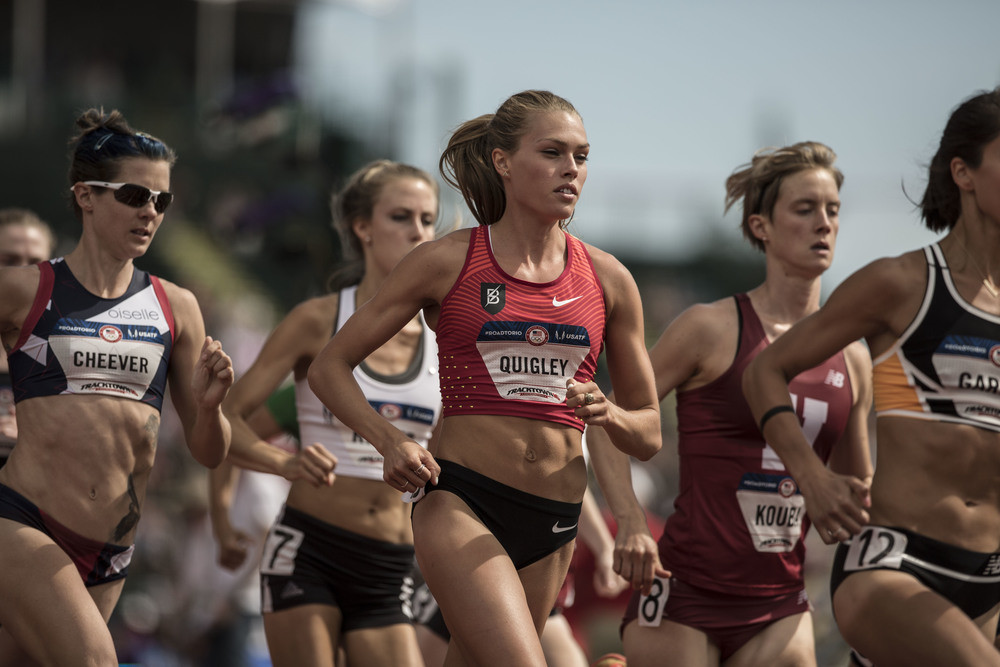
She announced that she would be leaving the BTC on her Instagram page. In a heartfelt post, she spoke about helping her coach, Jerry Schumacher, recruit more women to the team, which, at the time Quigley joined, consisted only of three other women, including Shalane Flanagan, Emily Infeld and Sammy Silva. Since then, the BTC women’s squad (affectionately named the ‘Bowerman Babes’) has grown into one of the most dominant groups of female distance runners in the country.
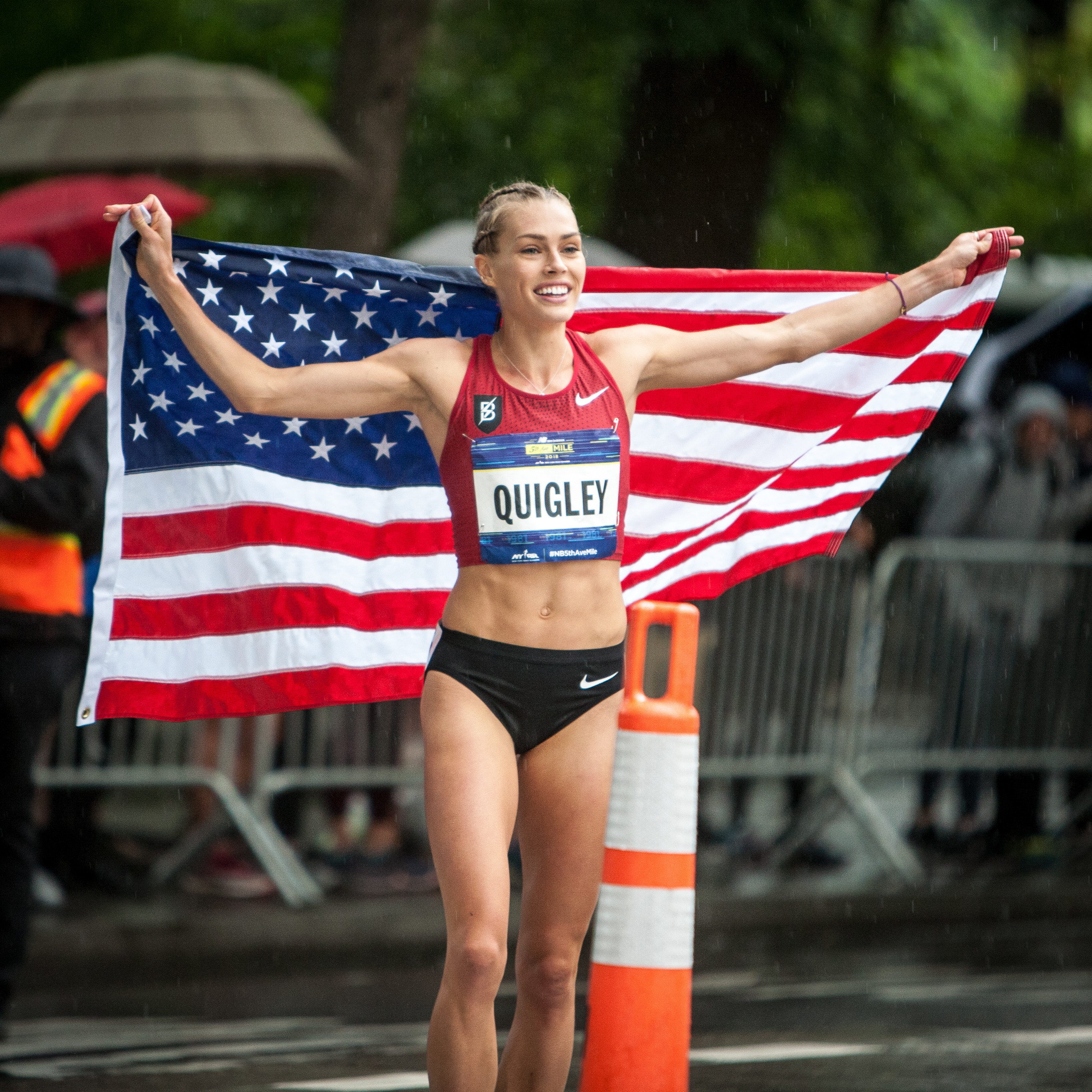
Quigley also wrote an ‘Open Letter to the BTC’ on her website, in which she described what the team has meant to her over the last several years, and gave special shout-outs to many of her teammates and coaches.
"BTC, you were the perfect place for a young athlete fresh out of college to land,” she wrote. “If going pro had meant training alone at age 22, I don’t think I ever would have made it. You gave me teammates and coaches who supported me and my goals.”
In an Instagram Live on Thursday, Quigley finally announced that her new coach would be Seitz, who is currently the assistant cross country and distance coach at Portland State University, where he has been coaching since 2017. According to his Portland State profile, in his four years on staff, he has helped a few steeplechase athletes set school records, and has led one steeplechaser to two podium finishes at the Big Sky Outdoor Championships.
Quigley´s teammate Kate Grace also announced that she would be leaving the BTC and will be heading to Colorado to train with Emma Coburn on Team Bosshard. There have been several changes to the Bowerman Track Club over the last year, with Gabriela Debues-Stafford, Sinclaire Johnson and Amos Bartelsmeyer joining the squad, and Ryan Hill, Andrew Bumbalough, Grace and Quigley leaving. Quigley has not yet announced any new sponsorship deals.
by Brittany Hambleton
Login to leave a comment
Shalane Flanagan’s Favorite Marathon Training Meal
This recipe from Elyse Kopecky is a nutritional powerhouse.
When Shalane Flanagan traveled to Bend, Oregon, to kick off recipe testing for Run Fast. Cook Fast. Eat Slow. with me, this Thai Quinoa Salad was the very first recipe to come out of the kitchen.

It was love at first bite. We continued to tweak the recipe, not because it needed much work, but because we secretly wanted an excuse to make it time and again. This is the salad Shalane made on a near weekly basis while training for the 2017 NYC Marathon and 2018 Boston Marathon.
We highly recommend the use of fish sauce (a store-bought condiment) to give the salad a true Thai-inspired umami kick, but if you’re vegan or vegetarian, the salad is crown-worthy made with just soy sauce.
Make this salad on a Sunday night for work lunches all week long or serve as a side dish with a juicy, grilled steak for a dinner set to impress.
Thai Quinoa Salad
SERVES: 5
Ingredients
1 cup quinoa, rinsed and drained
2 cups thinly sliced purple cabbage
3 green onions, white and green parts sliced
1 cup packed mint leaves, chopped (cilantro works too)
1 cup packed basil leaves, chopped
1 jalapeño or serrano pepper, seeds removed, minced (optional)
½ cup roasted peanuts, chopped
Dressing
¼ cup extra-virgin olive oil
â…“ cup fresh lime juice (2 to 3 limes)
2 tablespoons soy sauce or tamari
2 tablespoons honey (or maple syrup)
1 tablespoon fish sauce (such as Red Boat)
DIRECTIONS
STEP 1
Here is a foolproof method to cook quinoa: In a medium saucepan over high heat, bring to a boil 1½ cups water and the quinoa. Reduce the heat to low and simmer, covered, for 15 minutes or until all the water has been absorbed. Transfer to a large salad bowl, fluff with a fork, and set aside to cool.
STEP 2
Meanwhile, put the olive oil, lime juice, soy sauce or tamari, honey, and fish sauce (if using) in a glass jar or bowl and stir to combine.
STEP 3
Once the quinoa is cool, add the carrots, cabbage, onion, mint, basil, and pepper (if using) to the bowl and toss to combine. Add the dressing and toss again. Taste and, if needed, add more fish sauce or soy sauce.
STEP 4
Top with the peanuts. Chill in the fridge for at least 1 hour or until ready to serve.
This salad will stay fresh in airtight glass containers in the fridge for up to 5 days.
by Women’s Running
Login to leave a comment
Shannon Rowbury just might make her fourth US Olympic Team post-pregnancy
Shannon Rowbury proved she can run elite times post-pregnancy. Next year, she hopes to be the latest example that an Olympic career doesn’t end with motherhood.
“Having a child isn’t a death sentence,” she told fellow Olympic runner and mom Alysia Montaño in a recent On Her Turf interview. “You can come back even better.”
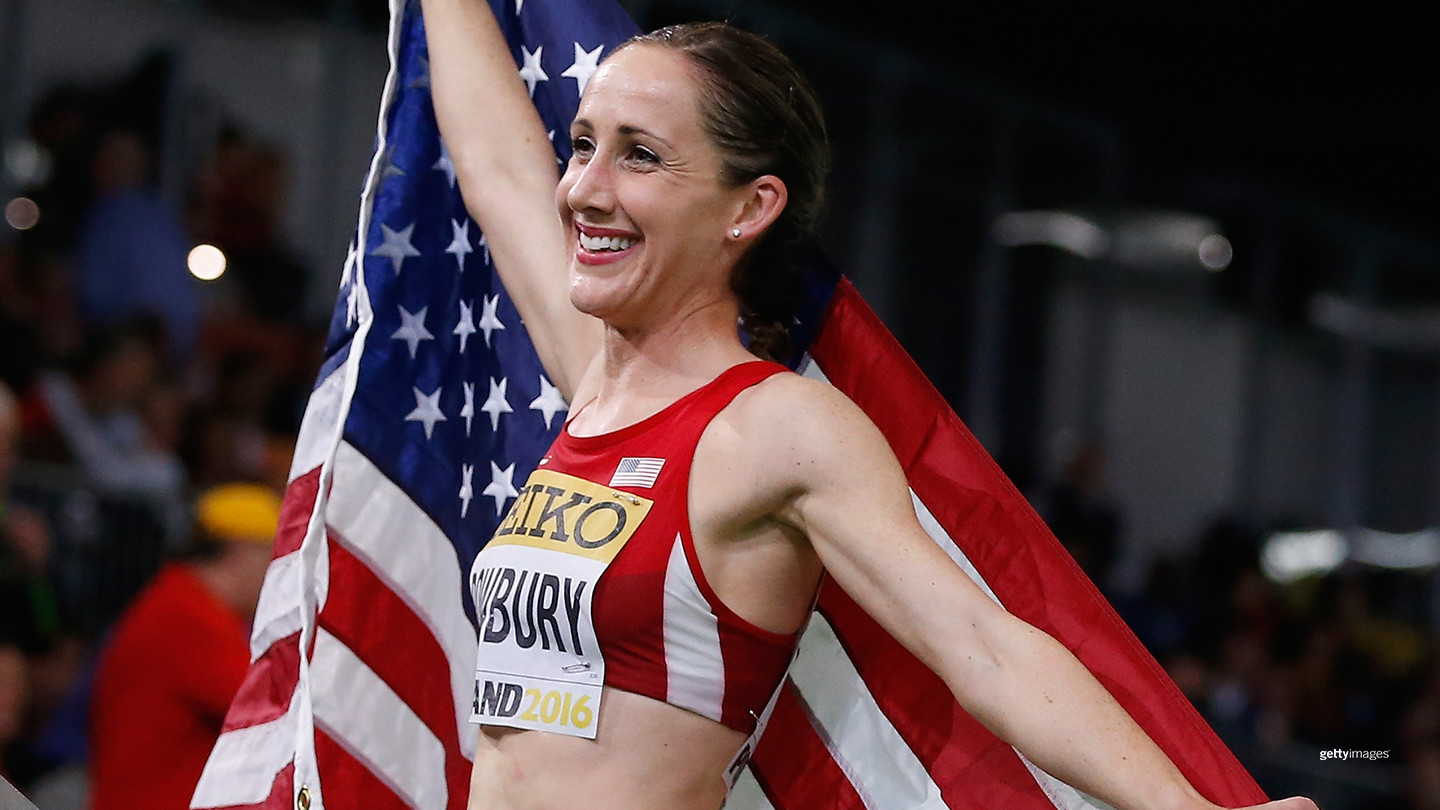
Rowbury, a 35-year-old, three-time Olympian, raced this month on the Diamond League circuit for the first time in three years and since having daughter Sienna in June 2018.
It went pretty well. She clocked her second-fastest 5000m ever, a 14:45.11 to place fifth in Monaco.
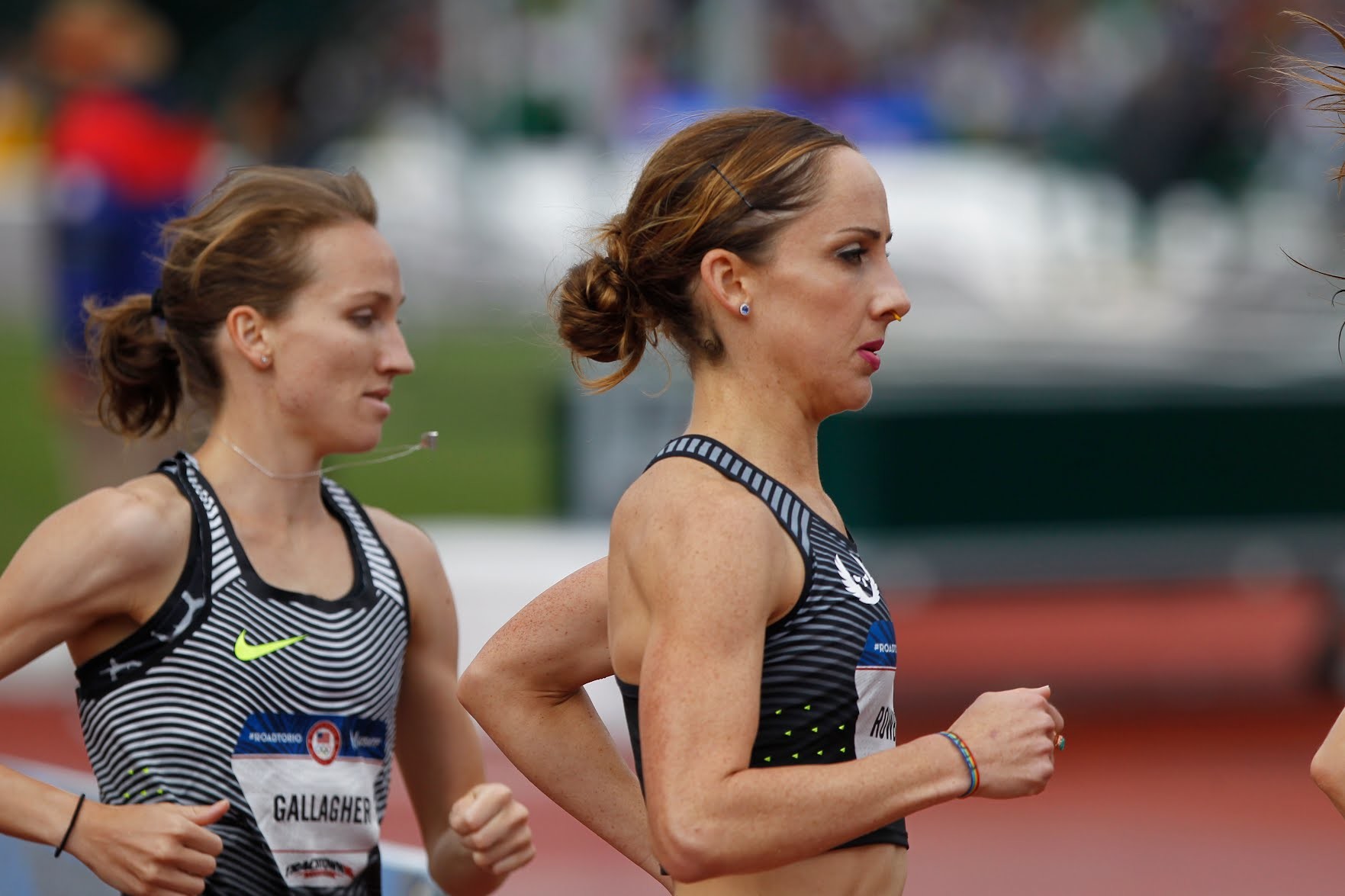
Only four other Americans have ever gone faster. One is retired (Shalane Flanagan). It’s very possible that two of the others could focus on other distances next summer (Shelby Houlihan and Molly Huddle).
Rowbury is right in the mix to make a fourth straight Olympics, given three U.S. women qualify per event. She can become the oldest U.S. woman to race on an Olympic track since Gail Devers in 2004, and one of the few moms to do so.
Rowbury is the former American record holder at 1500m and 5000m with a pair of fourth-place finishes from racing the former at the last three Olympics.
In 2018, she returned to training eight weeks after having Sienna. Ramping up too quickly led to a stress fracture in early 2019. She felt fatigued from sleep deprivation and breastfeeding and struggled with her identity.
Will I ever be the same? How much do I have left? Who am I without sport?
“I love my daughter,” she said last year, “but I loved my life before as well.”
She kept running. Rowbury placed sixth in the 5000m at the 2019 USATF Outdoor Championships, racing on a lack of training due to the injury. She missed an Olympic or world championships team for the first time since 2007, when she graduated from Duke.
Then in November, she won the U.S. 5km title on the roads in New York City. Rowbury raced for the first time this year in July and is still in Europe, torn while spending three weeks away from Sienna and husband Pablo Solares, a former middle-distance runner from Mexico.
“I felt very strongly that I would never prioritize my career over my family and over my daughter,” she said. “My performance right now is testament to the fact that you can have a healthy, natural weaning process, and you can still compete at a very high level.”
Rowbury partly dismissed motherhood earlier in her career because she was afraid of potential consequences. In more recent years, runners including Rowbury, Montaño and Allyson Felix fought for maternity protection in the sport, such as with health insurance through USA Track and Field and in sponsor contracts.
“I don’t think that any woman should be told she needs to do something in order to compete as an athlete or to pursue her dreams,” Rowbury said.
by Yahoo Sports OlympicTalk
Login to leave a comment
Tokyo 2020 Olympic Games
Fifty-six years after having organized the Olympic Games, the Japanese capital will be hosting a Summer edition for the second time, originally scheduled from July 24 to August 9, 2020, the games were postponed due to coronavirus outbreak, the postponed Tokyo Olympics will be held from July 23 to August 8 in 2021, according to the International Olympic Committee decision. ...
more...Des Linden is considering a move to the trails
Linden says UTMB and Comrades are bucket-list races
The 2018 Boston Marathon champion and one of America’s most beloved distance runners is eyeing up some of the world’s most competitive trail races. While it’s far from a done deal, as she’s still got some unfinished business on the road, Des Linden wants to conquer both UTMB and the Comrades Marathon before her running days are over.
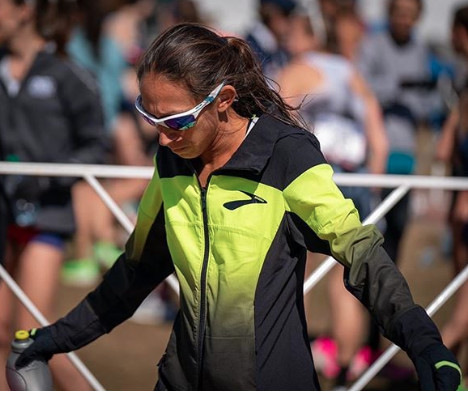
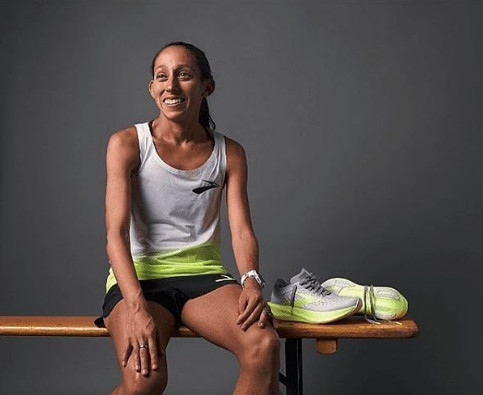
Linden told slowtwitch.com that ultra racing, specifically Comrades and UTMB are bucket list items for her. “I don’t spend too much time on the trails, to be honest, I think that’s why there’s so much intrigue. Exploring Chamonix and the Mont-Blanc region on foot and in a race atmosphere just looks pretty incredible.”
UTMB and the Comrades Marathon are two of the most competitive ultra races in the world. UTMB lasts several days and covers 171K, Comrades is a little shorter running either 87 and 90K depending on the year. Trail running is gaining popularity and as it does, more road runners will move from the marathon to even longer distances. (Side note: American distance legend Shalane Flanagan has also been seen doing some trail runs lately). It’ll be interesting to see, as more elite roadies make the move, if they can catch the best in the trail running business.
Jim Walmsley is a great example of a runner who has been successful at every running discipline – but his dominance lies on the trails. Walmsley made his road marathon debut at the 2020 U.S. Olympic Marathon Trails. His run there was hyped as one of the most exciting storylines, with some going so far as to claim he had an outside shot at the Olympic team. Walmsley ran extremely well (a 2:15 on the insanely hilly Atlanta course is no small feat) to finish 22nd – a far cry from an Olympic berth, but an impressive debut nonetheless.
While Linden is looking to one day attempt a reverse-Walmsley, and it’ll be interested to watch her trajectory. She could help runners answer the age-old question of: do road results translate to the trails?
by Running Magazine
Login to leave a comment
Shalane Flanagan Adopts a newborn Baby Boy Jack Dean Edwards
She’s a four-time Olympian for Team USA, and now Shalane Flanagan is a mom.
The former track and field and marathon star announced she and husband Steve Edwards became parents after adopting a newborn son this week.
“By far, the greatest gift we have ever been given. Jack Dean Edwards,” she captioned an Instagram slideshow of the swaddled baby. “On April 28th, Steven and I welcomed Jack with full hearts and open arms into our family through adoption.
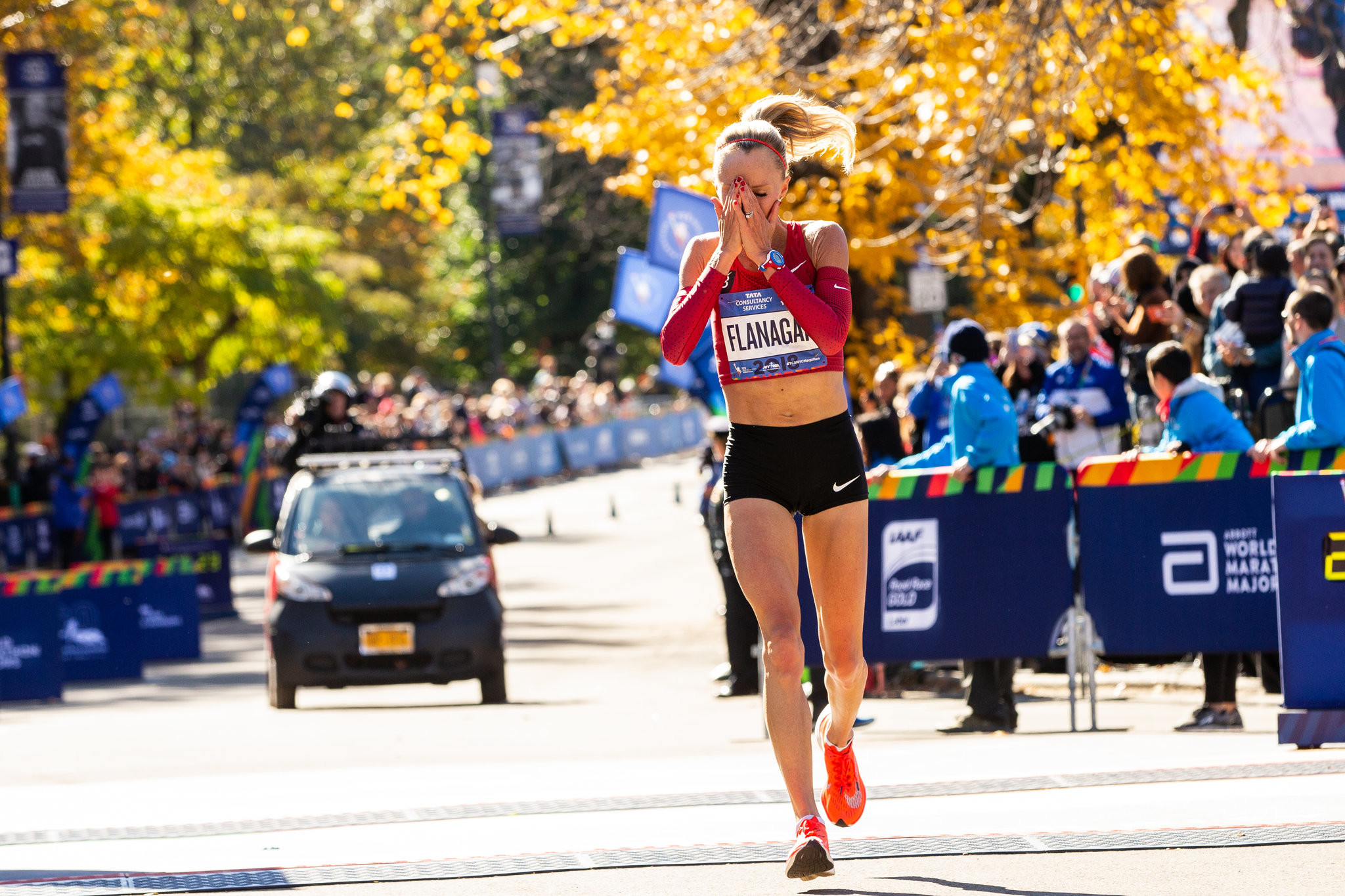
“I was not prepared for a love like this."
Jack arrived Thursday at 8:56 a.m., weighing 6 pounds 10 ounces, Flanagan wrote.
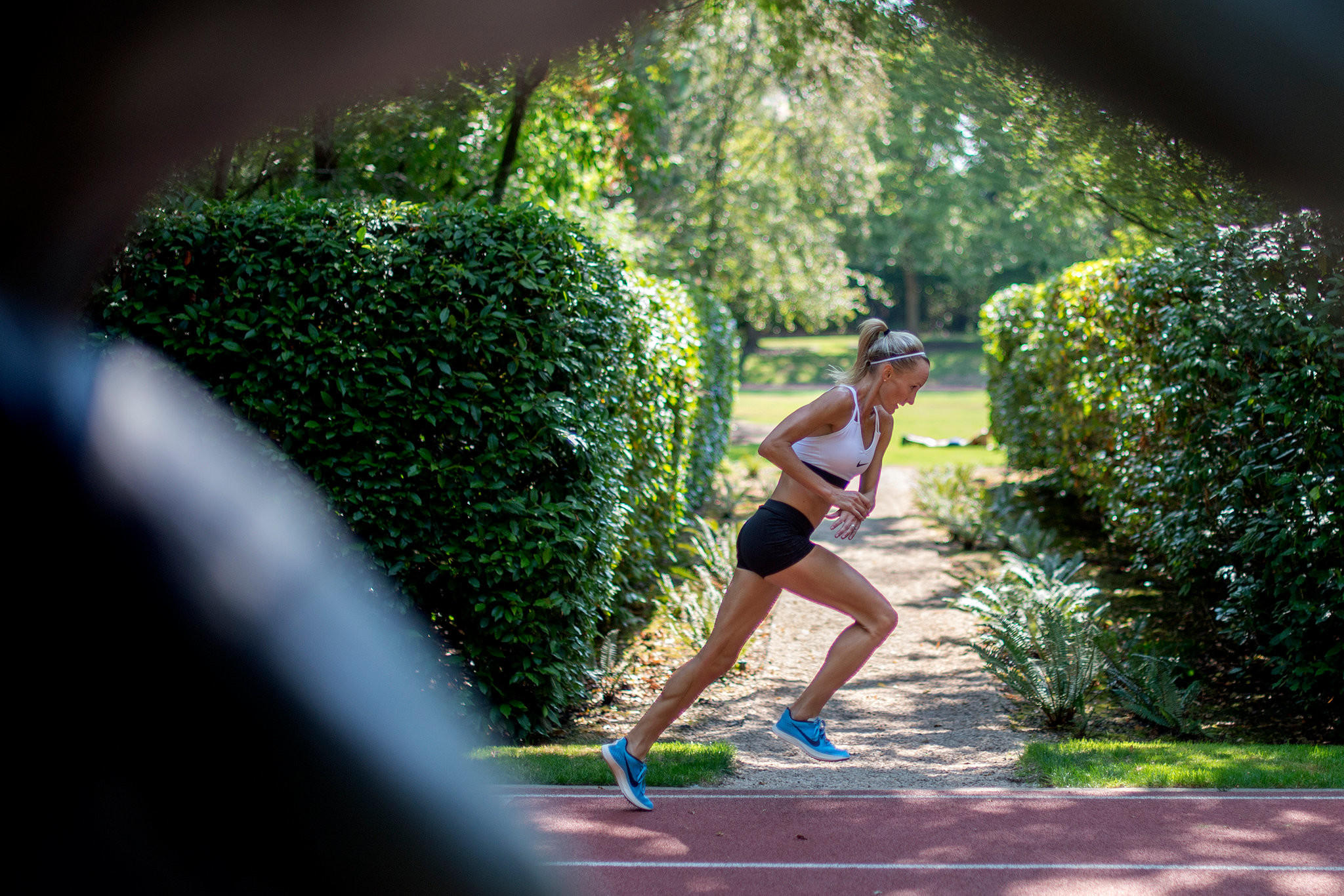
The couple previously fostered teenage sisters, and soon after began looking into adoption. Flanagan opened up about the process in a March 2019 article with Women’s Running, saying they had applied for an infant adoption but were also exploring foster adoption.
“There’s such a need and my heart goes out to these kids,” she said. “I feel like Steve and I are in such a fortunate position to be able to give kids care and a home. …
“We may adopt an infant. We may adopt toddlers. We don’t know, but we’re putting ourselves in a position for whatever kids are in need. It’s scary but exciting. It’s a totally different life, but it’ll be fun.”
Flanagan, a native of Marblehead, Massachusetts, who now lives in Portland, Oregon, made her Olympic debut in 2004 on the track, and four years later won a bronze medal that was later upgraded to silver in the 10,000-meter in Beijing. She switched to marathon after that, finishing 10th in London and sixth in Rio.
Along with Des Linden and Kara Goucher, Flanagan helped usher in a new generation of U.S. women’s marathoners, and in 2017 her win at the New York City Marathon ended a four-decade drought for U.S. women’s runners.
She retired from elite racing in October 2019 to pursue a career as a coach. NBC also hired her as an analyst.
Several fellow Team USA stars were quick to congratulate Flanagan on Instagram, including Goucher and Allyson Felix, both of whom are also mothers.
“Congrats Shalane!” Felix wrote. “So happy for you"
by Chros McDougall
Login to leave a comment
Des Linden will race the U.S. Olympic Trials and the Boston Marathon in 2020
Des Linden was undecided whether to race the Feb. 29 U.S. Olympic Marathon Trials as recently as a month ago. But now Linden, the 2018 Boston Marathon winner, is not only committed to trials but also the April 20 Boston Marathon.
It would be, at 51 days, by far her shortest break between marathons, which has so far included 19 marathons dating to 2007. She’s 36 years old, and it may be her last Olympic cycle.
“I only have so many more chances at Boston. I love being there. Obviously, the Olympics [window] is closing down as well,” she said. “I like the trials and the competitive way we pick our team. I can’t imagine, at this point, watching either of those races and feeling like I had no effect on either outcome.”
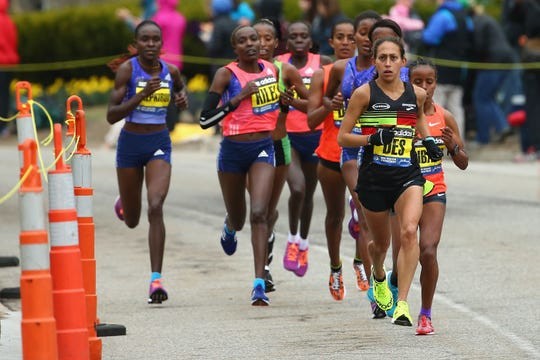
If Linden does make the Olympic marathon team — by placing top three at trials in Atlanta — she would be in line to race four marathons over a little more than nine months when including last month’s New York City Marathon.
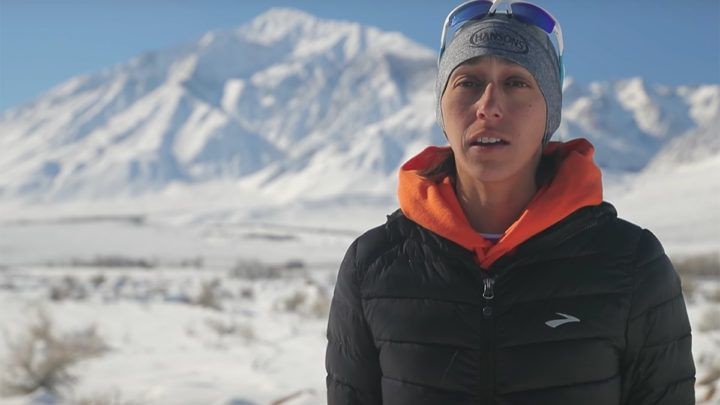
Ethiopian Lelisa Desisa and American Sara Hall ran the New York City Marathon on Nov. 3, 29 days and 35 days, respectively, after racing the world championships and Berlin Marathon. Neither finished New York, however.
This past August, when Linden committed to the New York City Marathon, she added that she might not race the trials. After her performance in New York — the top U.S. woman in sixth place — she decided she was ready for the trials-Boston double, which she had been considering since placing fifth at this past April’s Boston Marathon.
As far as how it will impact her trials build-up, Linden said her team will re-evaluate the process weekly. She hasn’t committed to a pre-trials half marathon.
“We’re obviously aware of what’s down the line, so we’re trying to get as much quality as we can without going too deep into the well,” she said. “It’s certainly going to be out there, but we’re trying to run well at both and not say, ‘This isn’t going well,’ and just train through it.”
Linden has been treating every marathon as if it could be her last. She has been incredibly consistent, placing no worse than eighth in her last 11 marathon starts dating to 2013.
Neither of Linden’s previous Olympic experiences was especially memorable. She dropped out of her first one in 2012 with a stress fracture in her femur. She was seventh in Rio, missing a medal by less than two minutes. The Kenyan-born gold and silver medalists were later busted for EPO and are serving lengthy doping bans.
“I don’t feel like I have anything to prove and anything unfinished,” at the Olympics, Linden said in August. “Quite frankly, the last experience is a hard sell to get back out there to try to compete for medals when you’re not even really sure what the field is all about. It’s a little bit difficult to be excited about that with the way we are about the [World Marathon] Majors. People investing in anti-doping have really been solving that problem [at the majors]. It’s a little tricky [at the Olympics], but certainly representing your country is special.”
Linden is the most experienced of a deep group of U.S. Olympic marathon hopefuls after the recent retirement of four-time Olympian Shalane Flanagan.
Login to leave a comment
2028 US Olympic Trials Marathon
Most countries around the world use a selection committee to choose their Olympic Team Members, but not the USA. Prior to 1968, a series of races were used to select the USA Olympic Marathon team, but beginning in 1968 the format was changed to a single race on a single day with the top three finishers selected to be part...
more...Gwen Jorgensen announces move to track for 2020
The 2020 US. Olympic Marathon Trials on Feb. 29 were marked on Gwen Jorgensen’s calendar since her Nov. 2017 announcement that she was leaving the triathlon to pursue running full time in hopes of winning the 2020 Olympic gold medal in the marathon.
But now, less than three months out from the event, Jorgensen announced that she will not run the U.S. Olympic Marathon Trials and instead focus on making the U.S. team for the Summer Games on the track in the 10,000 meters.
“It’s a multitude of emotions,” Jorgensen, 33, says. “I’m disappointed. At the same time, I’m also excited. I’m at a point where I’m running 70 miles per week and training is going well. I just know that if I went to the trials, running 70 miles per week, I’d be hoping that I made a team. That’s not what I want to do at an Olympic Trials.
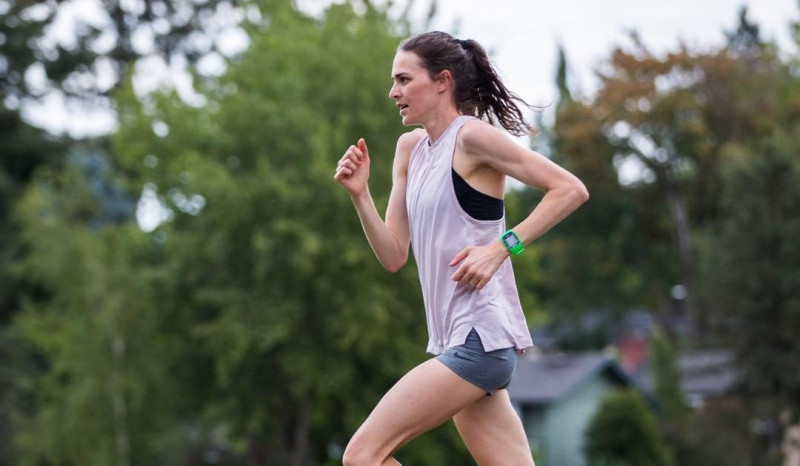
I want to go in confident and knowing that I have the ability to make a team. My goals in the marathon aren’t changing. My timeline is.”
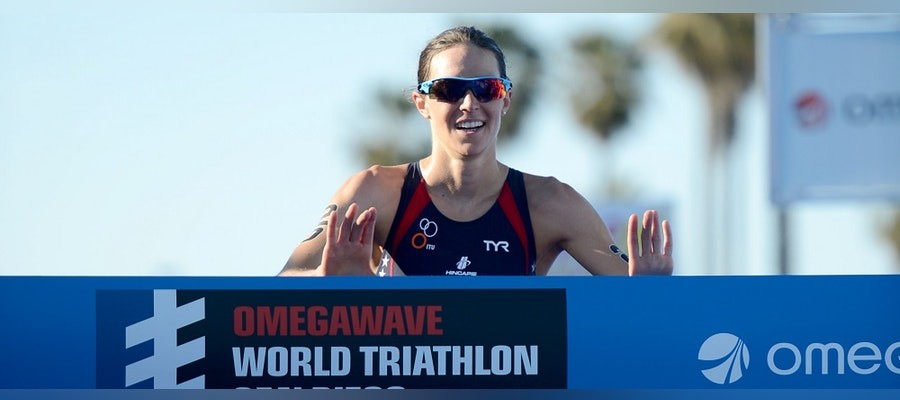
Heel surgery forced Jorgensen, who converted to distance running after winning the Rio Olympic triathlon, to pass up the Feb. 29 U.S. Olympic Marathon Trials and focus on the track and field trials in June in the 10,000m and, probably, the 5000m.
She made the decision after recent talks with her coach, Jerry Schumacher, following a difficult recovery from late May surgery to correct Haglund’s deformity.
“I could get bent out of shape and sad about it, but at the end of the day, I’m excited because I know this path that I’m on will not only be a successful route, but I also think it will lead to success long term in the marathon," she says. "I’m confident in my abilities on the track."
Jorgensen’s goal was a lofty one from the onset. No American woman has won gold in the marathon at the Olympics since Joan Benoit Samuelson’s victory in the 1984 inaugural running. The 2020 trials, where the top three finishers qualify for Tokyo, are shaping up to be one of the most competitive races of the year, as American women’s distance running is at its highest level with recent World Marathon Major victories by Shalane Flanagan at the 2017 New York City Marathon and Desiree Linden at the 2018 Boston Marathon.
Even after giving birth to her son Stanley in Aug. 2017, Jorgensen could have returned to the triathlon and arguably been a contender to become the first woman to win back-to-back Olympic gold medals. But she and her family decided to move to Portland, Ore., and once settled there, Jorgensen signed a professional running contract with Nike and joined the Bowerman Track Club.
Jorgensen worked her way to the marathon by racing on the track in the spring of 2018 and ran a few U.S.A. Track and Field road race championships. She says her training went well, nailing all but one workout in 12 weeks. But in the three days before she was set to compete in the Chicago Marathon, Jorgesen battled a fever and underestimated the effects of running while sick. She finished in a disappointing 2:36:23 in her professional marathon debut.
Now fully healed, healthy and recovered, Jorgensen is working her way back to train with her Bowerman teammates. Her day sometimes includes a hill sprints, a track workout, pelvic floor therapist treatment, physical therapy exercises for her achilles and then an evening workout before returning to her family.
“I think it’s important not to be afraid when you need to admit that your goal needs to change,” Jorgensen says. “I’m not going to say that I’m failing because I still want to have my marathon goals, but the timeline has changed. It’s still important to have big goals and to share those goals. It holds everyone accountable.”
by Chris Cahvez
Login to leave a comment
2028 US Olympic Trials Marathon
Most countries around the world use a selection committee to choose their Olympic Team Members, but not the USA. Prior to 1968, a series of races were used to select the USA Olympic Marathon team, but beginning in 1968 the format was changed to a single race on a single day with the top three finishers selected to be part...
more...

